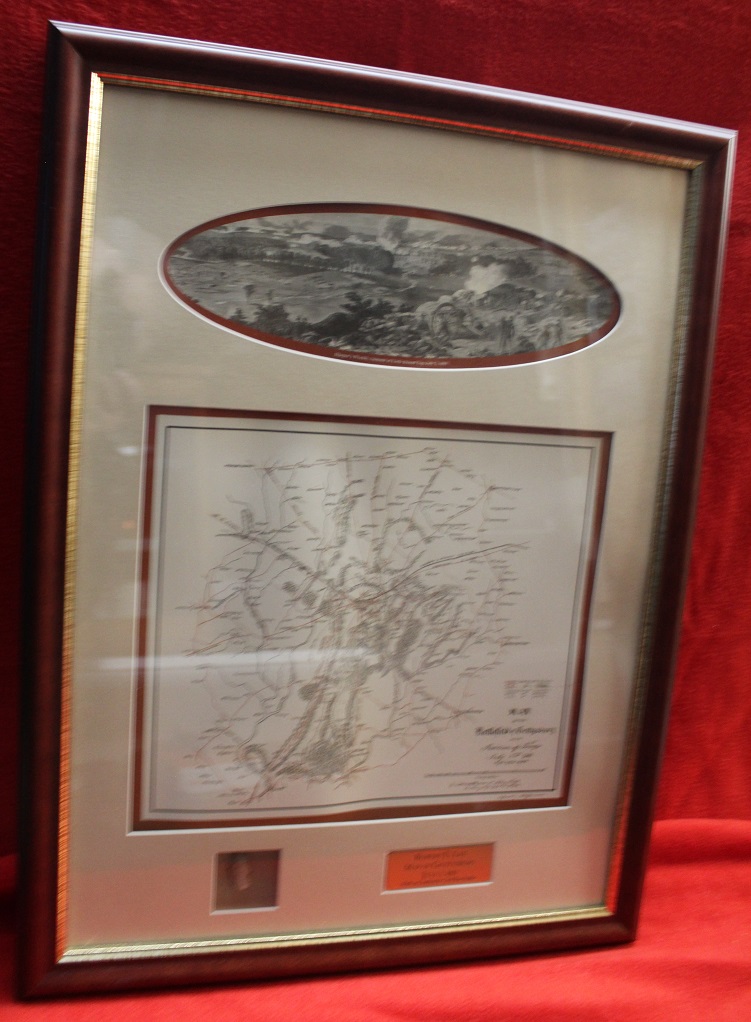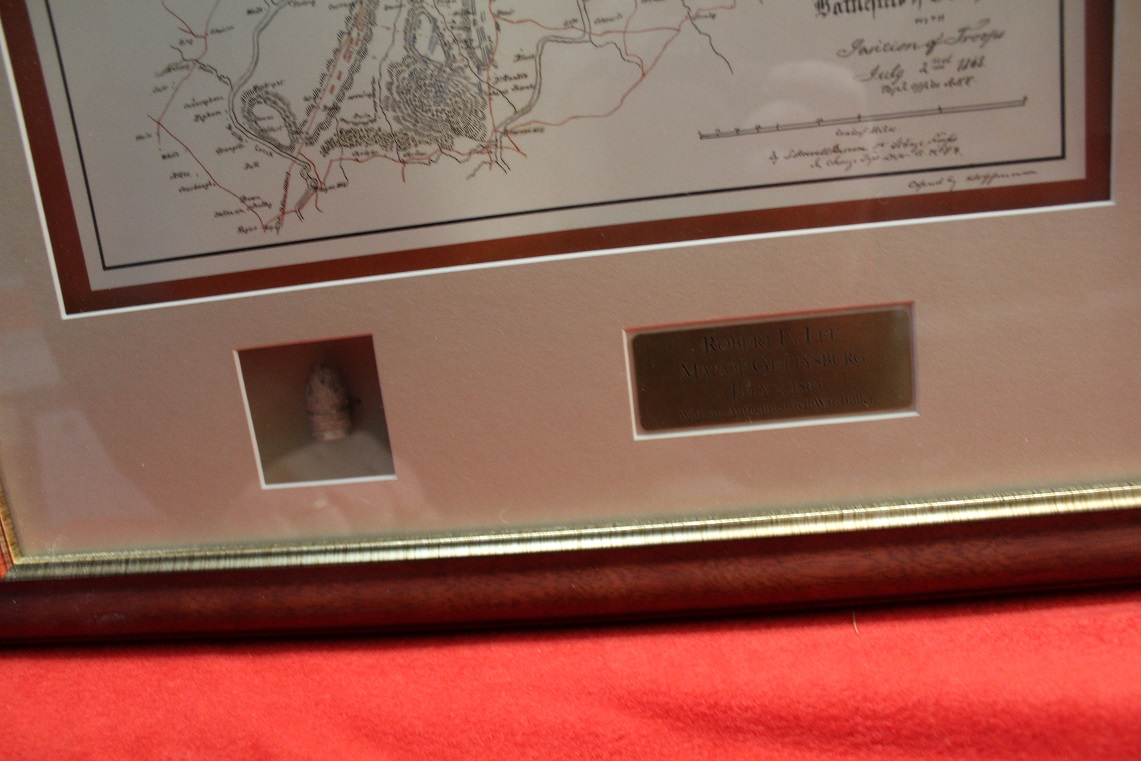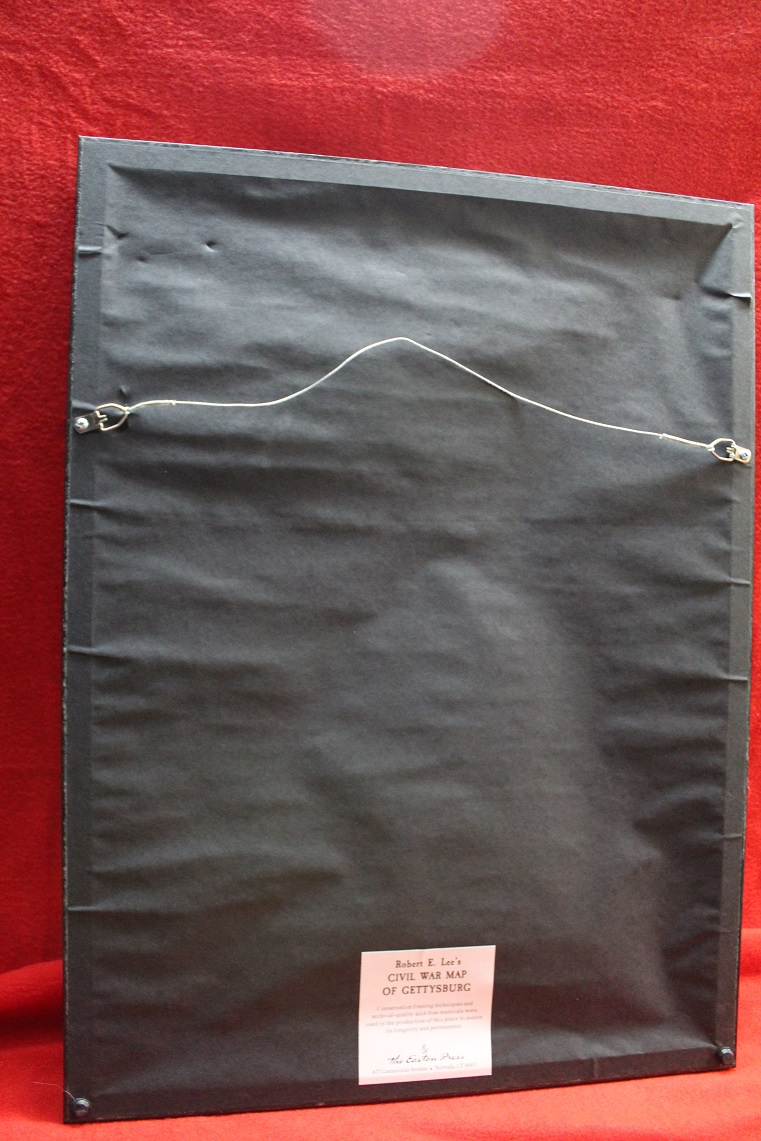

---
Remember 911!! God Bless!!
WE ACCEPT PAYPAL ON EVERYTHING EXCEPT FIREARMS (THEIR RULES)
***NOTE:***
We certainly do appreciate your business!
Remember 911 and God Bless!!!
Thanks! Ted
Paper items, Daguerrotypes, Ambrotypes, Tintypes, CDV's, Albumins, Cabinet Cards and Miscellaneous-Just listed 1865 original prints! See below!! __________________________________________________________________________________________
We will have several pieces of empherma on the papers page that are not meant to be retained or preserved. The word "empherma" derives from the Greek ephemeros, meaning "lasting only one day, short-lived". Some collectible ephemera are advertising, trade cards, airsickness bags, bookmarks, catalogues, coasters, greeting cards, letters, pamphlets, postcards, posters, prospectuses, defunct stock certificates or tickets, and zines.
Well there you have it! Have fun browsing!
__________________________________________________________________________________________
Image 131
Here we have an exceptional CDV of what I believe is a Confederate Soldier in either a civilian Frock coat or a captured Union great coat. You can clearly see his gray shell Jacket that he is wearing and gray Kepi on his knee. He has a very troubled look on his face so he's already "seen the elephant" or he is a prisoner of war. There is no backmark on this early CDV. No History accompanies this piece but it was found in Indiana. From Camp Morton? Who knows. For this fine image $450.00
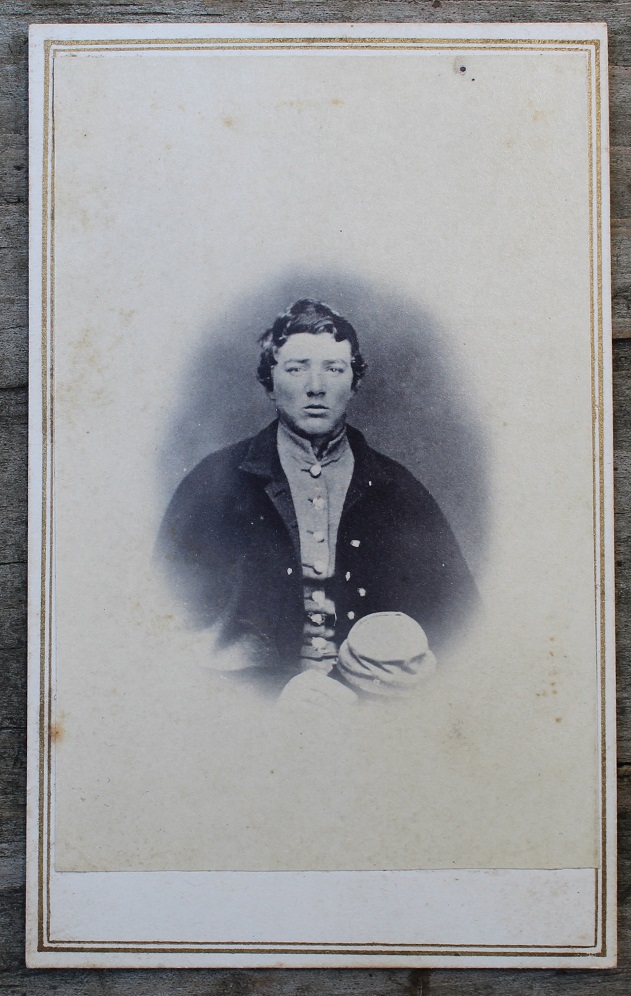
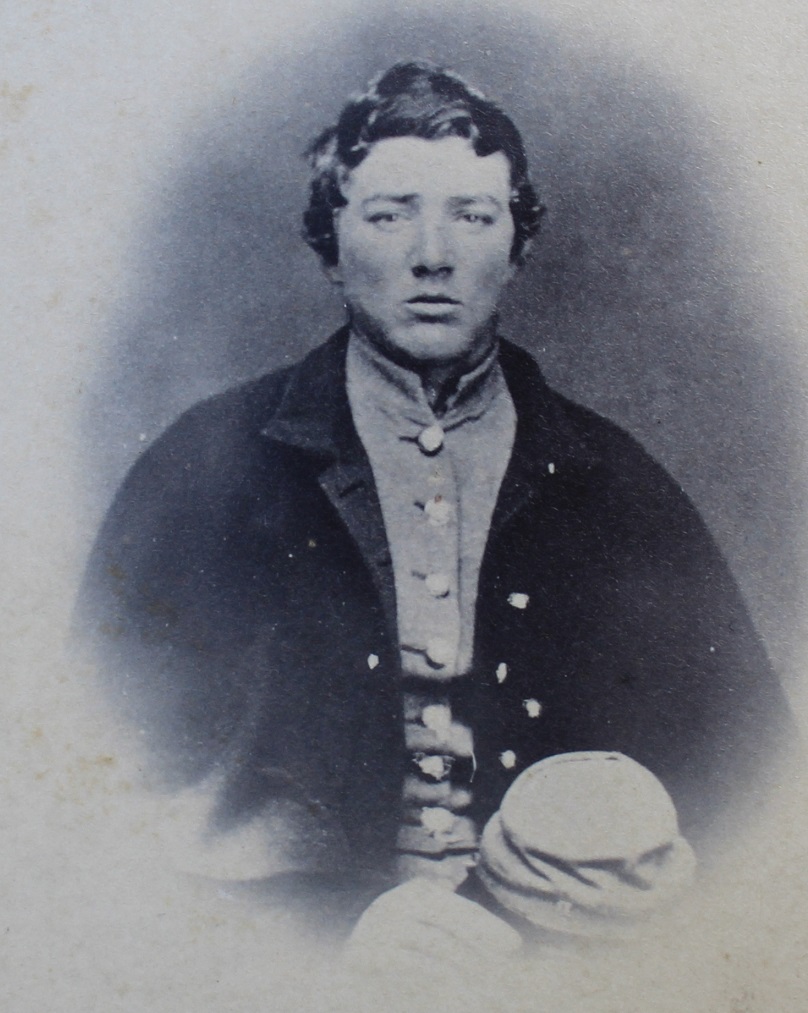
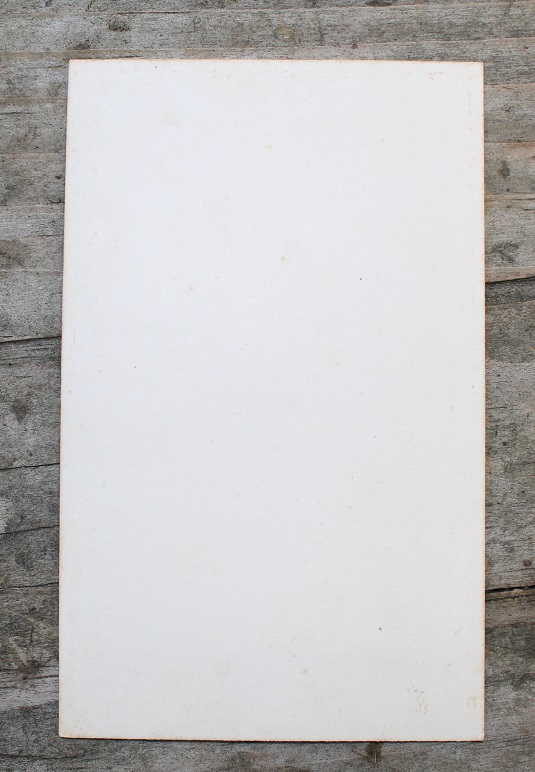
Image 130
Here we have CDV's of General Grant (Later President Grant) and his Vice President Schuyler Colfax Jr. We'll start with Vice President Colfax.
Here we have a CDV of Schuyler Colfax.
Schuyler Colfax Jr. ( March 23, 1823 – January 13, 1885) was an American journalist, businessman, and politician from Indiana. He served as a United States Representative (1855–69), Speaker of the House of Representatives (1863–69), and the 17th Vice President of the United States (1869–73). To date, he is one of only two Americans (John Nance Garner is the other) to have served as both House speaker and vice president. Colfax was known for his opposition to slavery while serving in Congress, and was a founder of the Republican Party. In January 1865, as Speaker of the House, Colfax made the unusual choice to cast a vote for passage of the Thirteenth Amendment. (Speakers can vote on House motions but, by convention, rarely do so.) After winning the presidential election of 1868, Ulysses S. Grant and Colfax, at ages 46 and 45, were the youngest Presidential ticket elected in the 19th Century. Believing Grant would only serve one term, in 1870 Colfax attempted unsuccessfully to garner support for the 1872 presidential nomination by telling friends and supporters he would not seek a second vice presidential term. Grant ran again, and Colfax reversed himself and attempted to win the vice presidential nomination, but was defeated by Henry Wilson. In January 1871, Colfax encouraged a unified Italy to adopt a republican government that protected religious freedom and civil rights of its citizens. An 1873 Congressional investigation into the Crédit Mobilier scandal named Colfax as one of the members of Congress (mostly Republicans) who in 1868 were offered (and possibly took) payments of cash and discounted stock from the Union Pacific Railroad in exchange for favorable action during the construction of the First Transcontinental Railroad. Colfax left the vice presidency at the end of his term in 1873 and never again ran for office. Afterwards he worked as a business executive and became a popular lecturer and speech maker. Colfax died in Mankato, Minnesota, on January 13, 1885, while changing trains as he was en route to Rock Rapids, Iowa, to give a speech
This CDV of Vice President Colfax is a tad light but easily seen with his iconic smile! The CDV is in great shape overall and is backmarked from Logansport, Indiana. Nice piece! $65.00
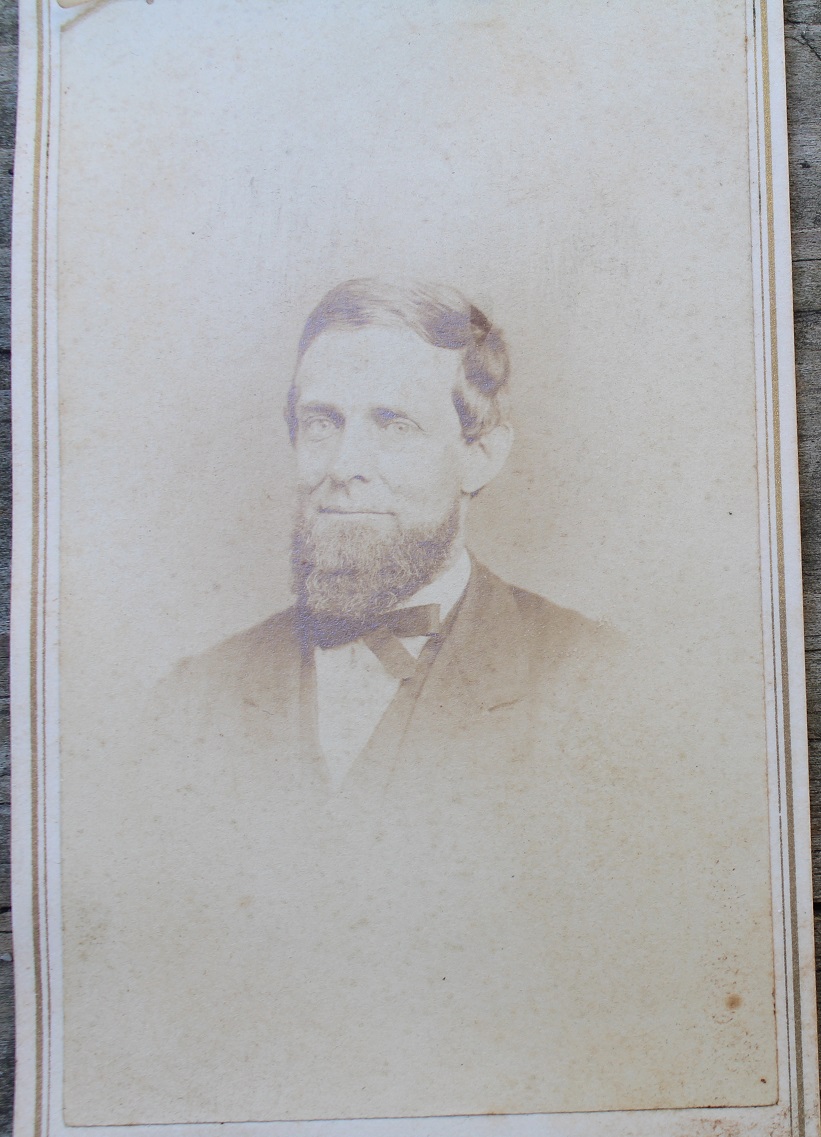
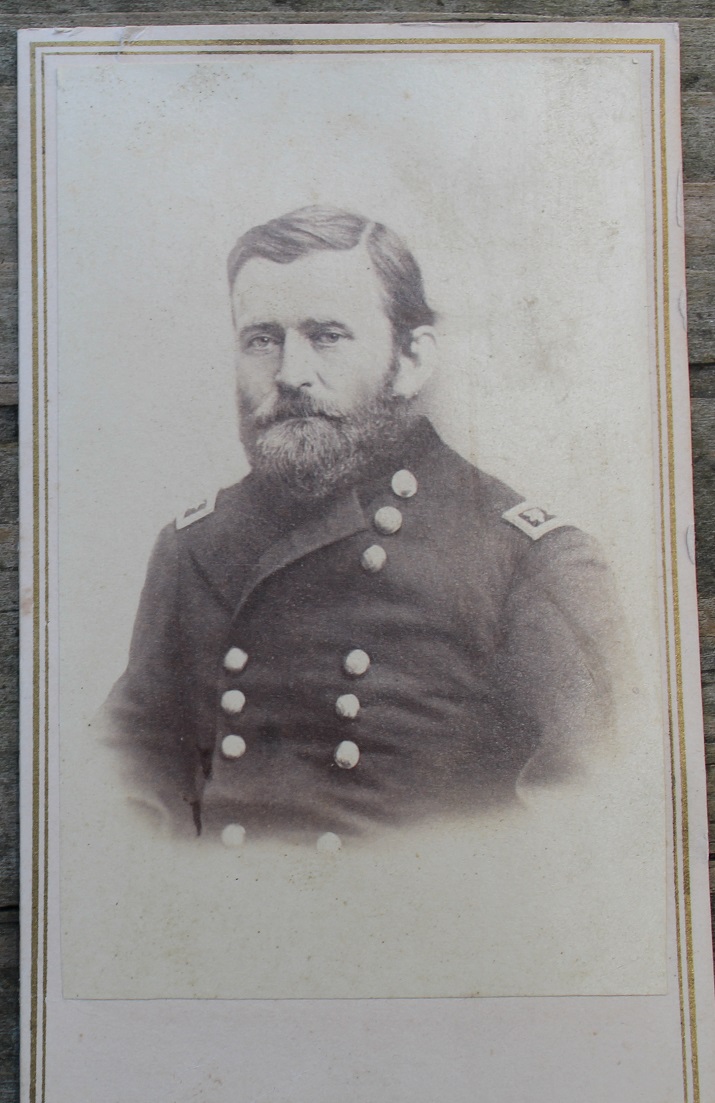
Image 129
Here we have a CDV from life of General Ulysses S. Grant, later President Grant. This one is in very nice condition with the backmark of Anthony and Brady. Ulysses Simpson Grant (born Hiram Ulysses Grant;[a] April 27, 1822 – July 23, 1885) was an American soldier and statesman who served as Commanding General of the Army and President of the United States, the highest positions in the military and the government of the United States. A prominent United States Army general during the American Civil War, Grant led the Union Army to victory over the Confederacy with the supervision of Abraham Lincoln. As the 18th President of the United States (1869–77) Grant led the Republicans in their efforts to remove the vestiges of Confederate nationalism and slavery during Reconstruction. Grant was born and raised in Ohio by Methodist parents whose lineage in the new world went back several generations. As a youth he often worked in his father's tannery and showed an early talent for riding, taming and managing horses. After graduating from West Point in 1843 Grant served with distinction in the Mexican–American War. Upon his return he married Julia Dent, and together they had four children. Grant retired from the army in 1854 and struggled financially in civilian life. When the Civil War began in 1861 he rejoined the army and quickly rose through the ranks. As a general he took control of Kentucky, most of Tennessee, won major battles at Shiloh and seized Vicksburg, gaining control of the Mississippi River and dividing the Confederacy. These victories, combined with those in the Chattanooga Campaign, persuaded Abraham Lincoln that Grant was the general best suited to lead the combined Union armies. Grant was promoted to Lieutenant General, a rank previously reserved for George Washington, in March 1864. He confronted Robert E. Lee, trapping his army in their defense of Richmond, while coordinating a series of campaigns in other theaters. In April 1865 Lee surrendered to Grant at Appomattox, effectively ending the war. Historians have hailed Grant's military genius, and his strategies are featured in military history textbooks. After Lincoln's assassination, Grant became increasingly disillusioned by President Andrew Johnson's approach to Reconstruction, and drifted toward the "Radical" Republicans. Elected president in 1868, the youngest man in the office to that date, Grant stabilized the post-war national economy, created the Department of Justice, used the military to enforce laws in the former Confederacy and prosecuted the Ku Klux Klan. Grant strengthened the Republican Party in the South and signed three civil rights acts into law. In 1871 he created the first Civil Service Commission. The Democrats and Liberal Republicans united behind Grant's opponent in the presidential election of 1872, but Grant was re-elected by a large margin. Generally regarded as personally honest, he nonetheless faced accusations of corruption within his administration. Grant's Peace Policy with Native Americans was a bold departure for its time. In foreign policy, Grant sought to increase trade and influence while remaining at peace with the world. With Secretary of State Hamilton Fish, he successfully resolved the Alabama claims with Great Britain. Grant and Fish negotiated a peaceful resolution with Spain over the Virginius Affair. Congress rejected Grant's initiative to annex the Dominican Republic, creating a rift among Republicans. In national affairs, Grant's administration implemented a gold standard and sought to strengthen the dollar. Grant's immediate response to the Panic of 1873 failed to halt a severe industrial depression that produced high unemployment, deflation, and bankruptcies. When he left office in 1877, Grant embarked on a two-and-a-half-year world tour that captured favorable global attention for him and the United States. In 1880, Grant was unsuccessful in obtaining the Republican presidential nomination for a third term. Facing severe investment reversals and dying of throat cancer, he wrote his memoirs, which proved to be a major critical and financial success. His death in 1885 prompted an outpouring in support of national unity. Historical assessments of Grant's legacy have varied considerably over the years. Although Grant's presidency has popularly been criticized for its Gilded Age scandals, modern scholarship regards him as an embattled president who performed a difficult job during Reconstruction. Although early rankings of Presidents rated his administration among the worst, modern appreciation for Grant's accomplishments has greatly improved his historical reputation.
This CDV is in very nice condition with E&HT Anthony backmark from Photographic Negative in Brady's National Portrait Gallery. For this CDV $165.00

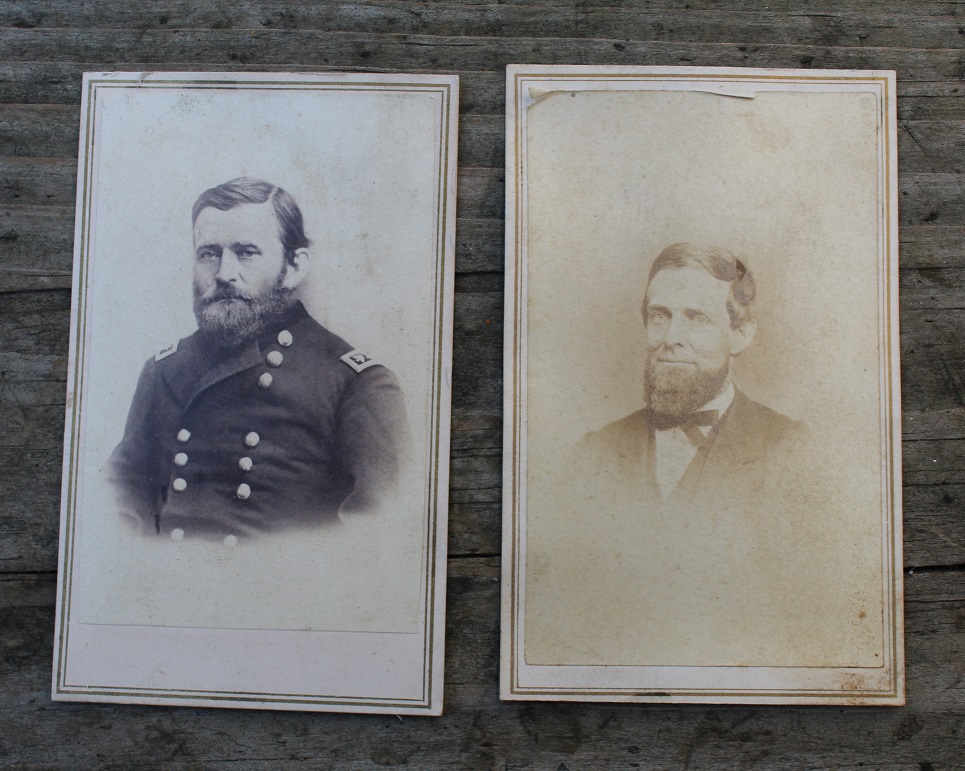
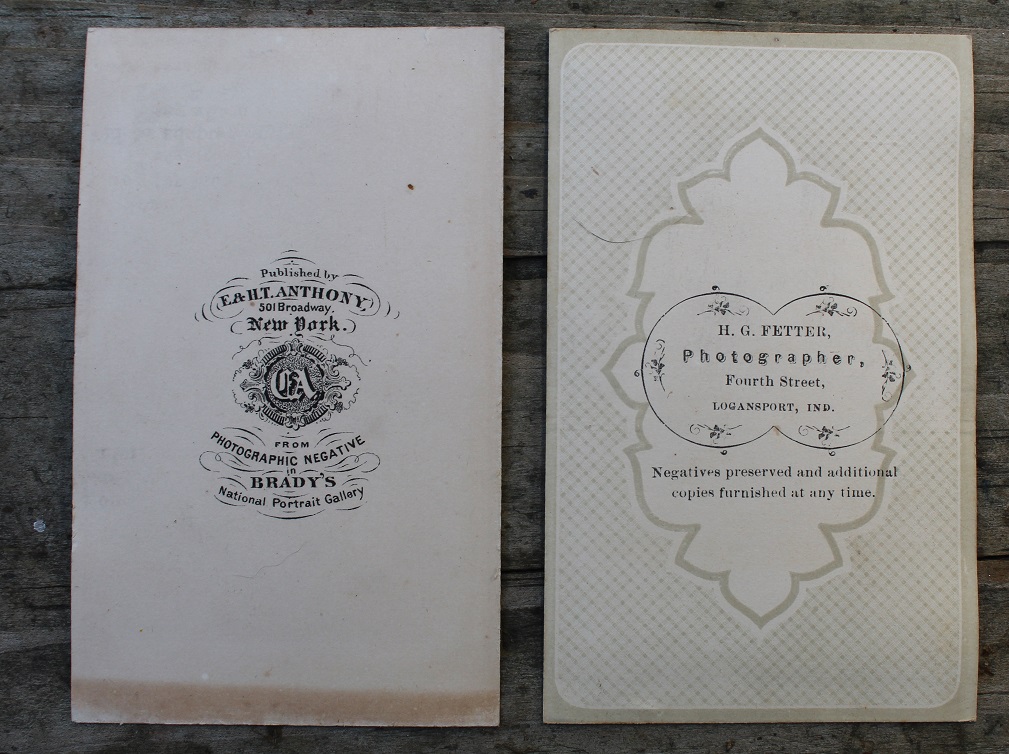
Image 124
T Here is a Civil War Era Picture hanger that was driven into the wall to support a large photograph or picture. You can see these in period photographs from the 1800's with large photographs suspended from them. This one is very ornate being over 3 inches long . This is a nice type of piece you don't run into often. $45.00
Photography 027
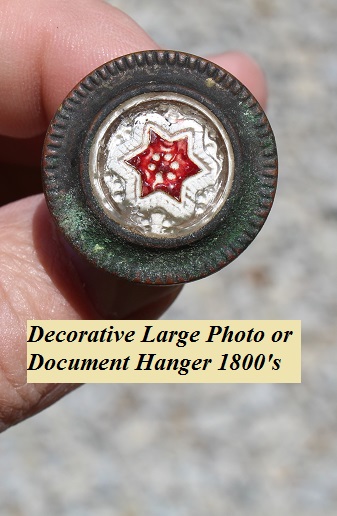
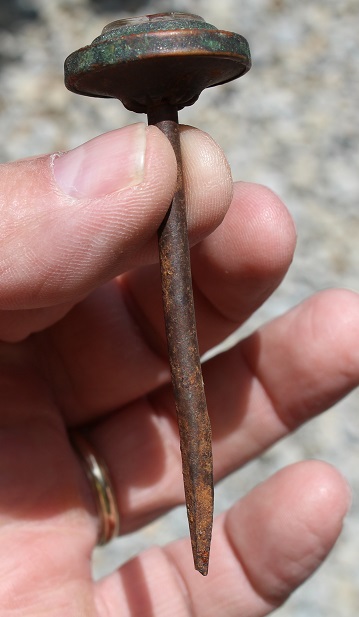
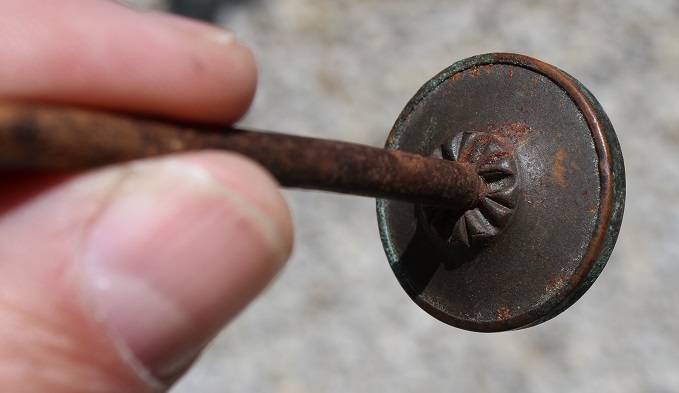
Image 122
Here is the first photo from the Winchester Paper Grouping that I picked up recently. I believe all photos are from the Southwest.
This one is probably a graduating class from the early 1900’s and it shows five of the students dressed in U.S. Military Uniforms of around that era I believe. There also seems to be a couple of Hispanic or Indian boys in the photo. This photo says on the back Public School Las Cruces (New Mexico). (The following photo is taken at the same building.) 4 ¾ X 6 ¾ sized image on an 8 X 10 inch mat. Nice and clear!! $45.00
Photography 024
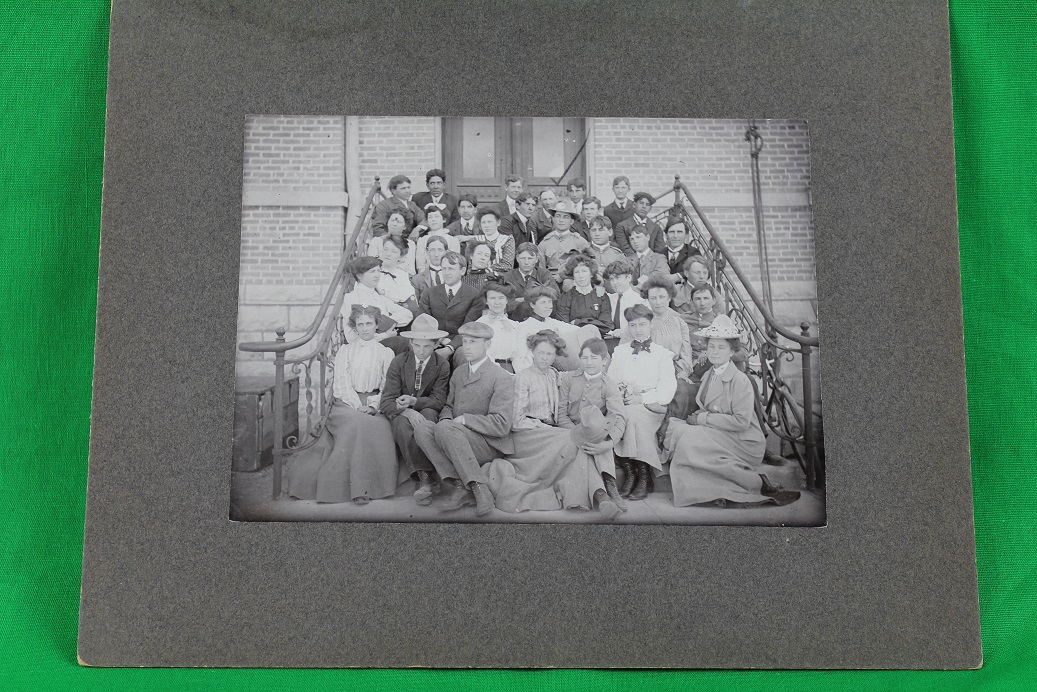
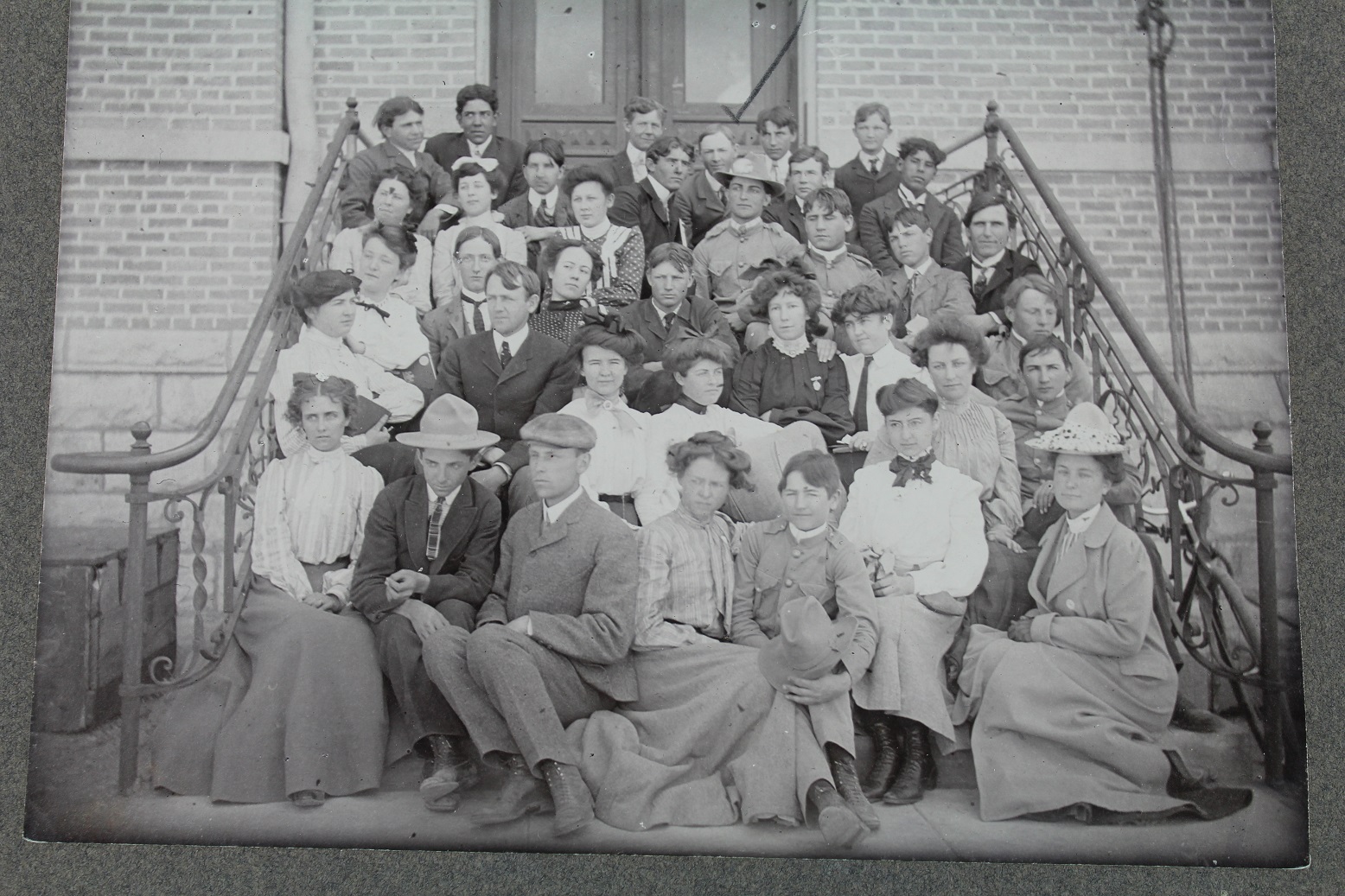
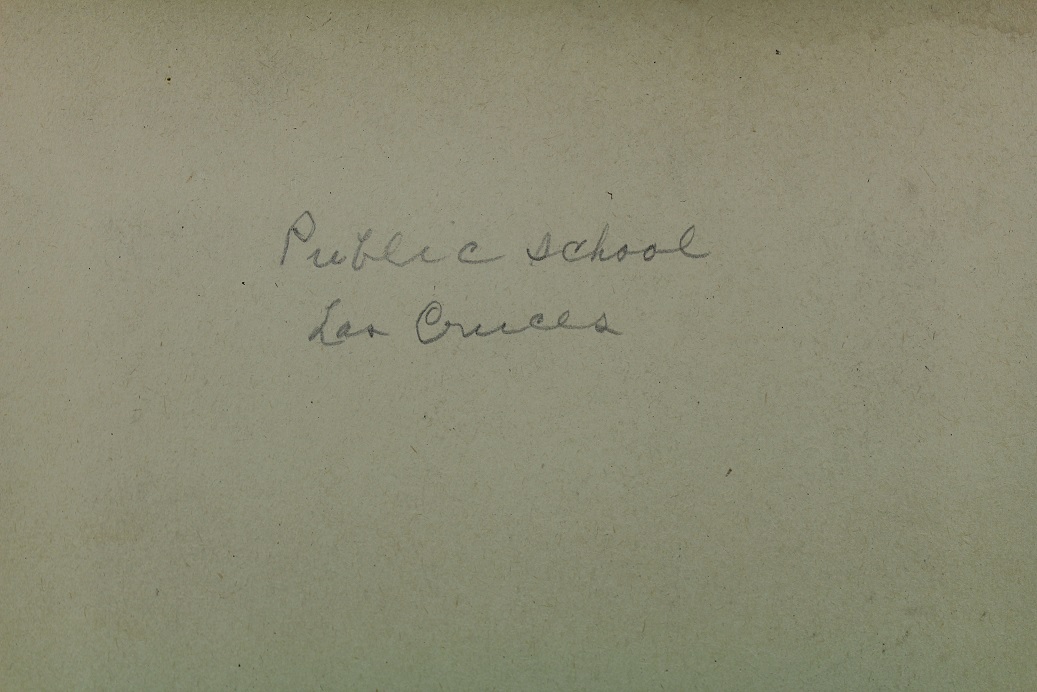
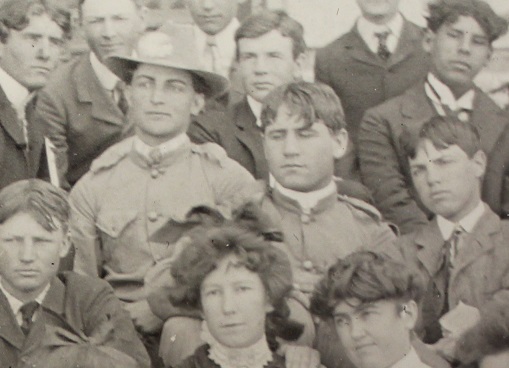
Image 121
This next photograph is on an 8 ¼ inch by 11 mat and the photograph itself measures 9 ¼ X 6 ½ with a little damage to the lower right but does not get into the subject material. The front of the brick building has on it PUBLIC SCHOOL 1882 while in pencil on the back this albumin is dated to 1897.. This is an elementary school photograph with a ton of kids in it. Most seem to be Hispanic with some native americans and Caucasians. There are at least two Nuns in the Photo making it a Catholic School which is typical for the South West. This photo is nice and clear and has a bunch of good looking kids. For this one $45.00
Photography 022
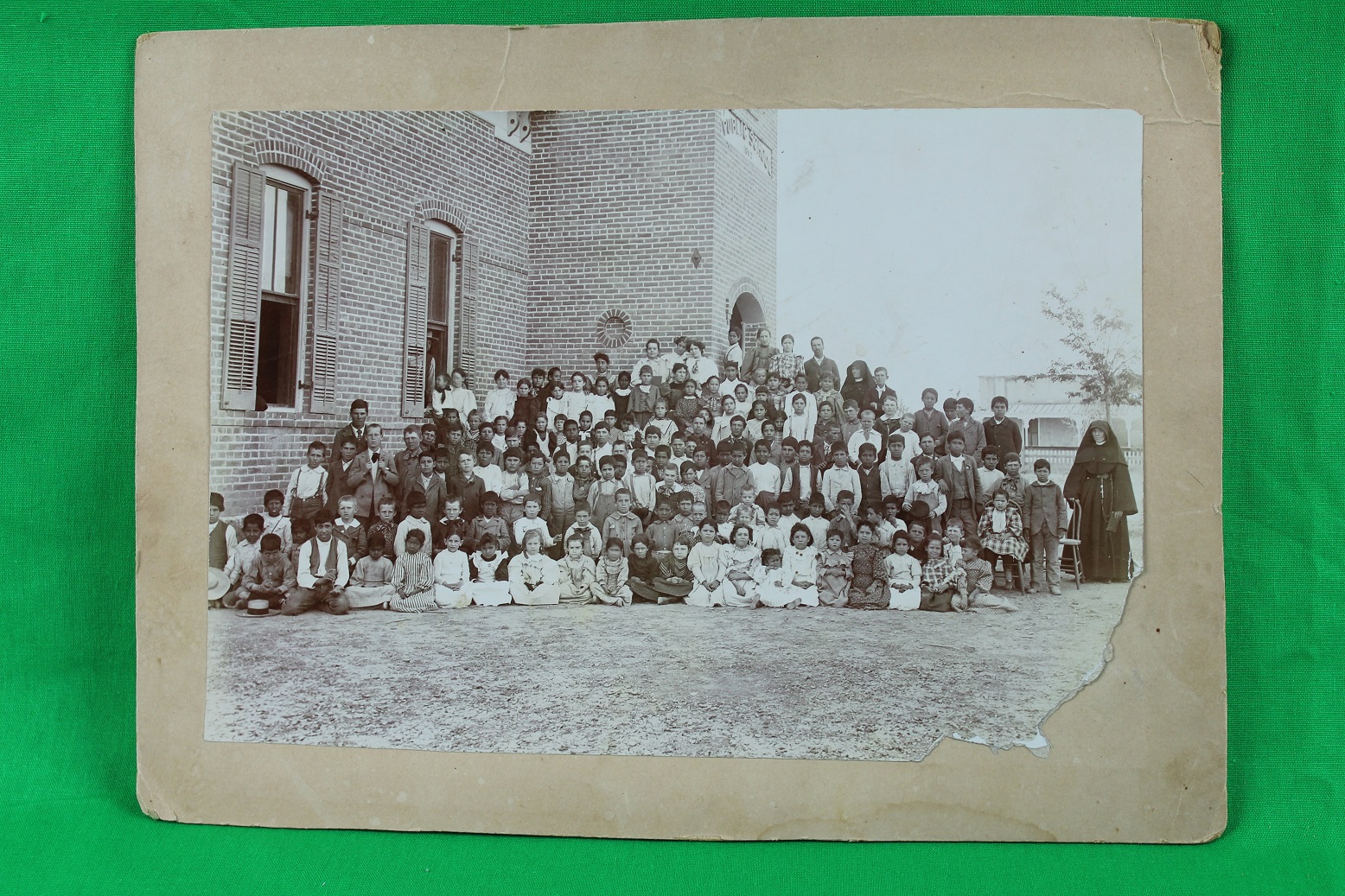
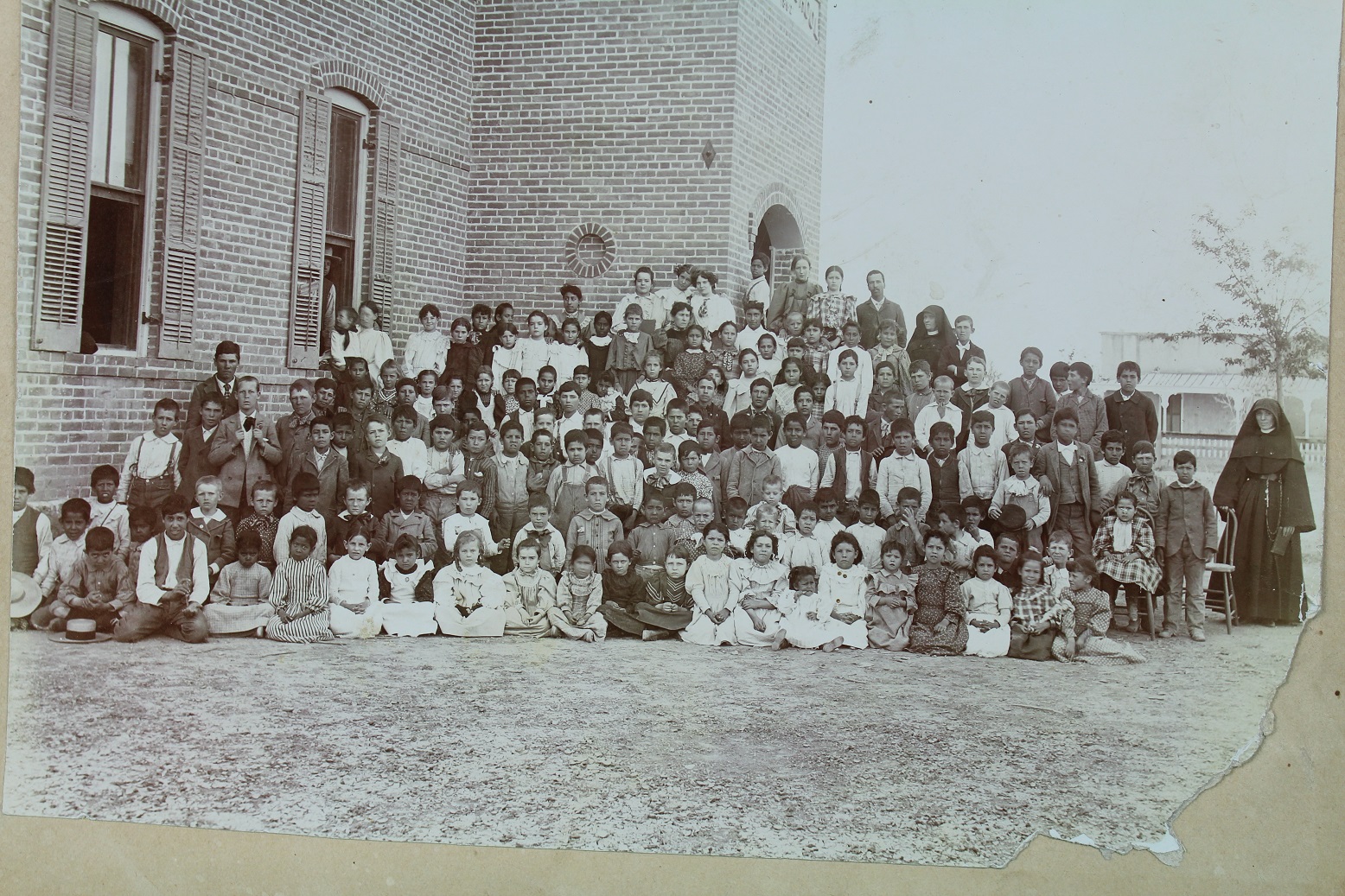
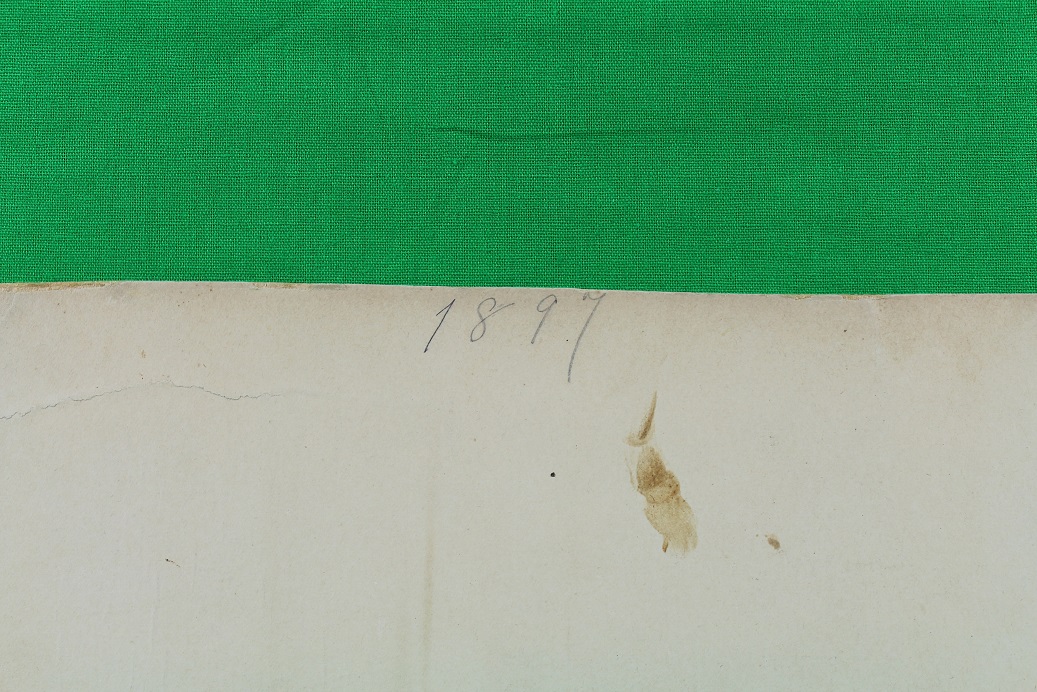
Image 120
This last photo is on a 8 X 10 inch mat with the actual photo being 4 ¾ X 7 showing a large brick building that is id’d on the back as the Rouault Bldg- replaced old store. Might not be a coincidence that our subject Theo Rouault has the same last name as the building. This building houses the FIRST STATE BANK and there are Ringling Bros Circus signs on the building. It looks like work is still being done on the building and it has an unusual pulley arrangement for moving the street light overhead. $45.00
Photography 021
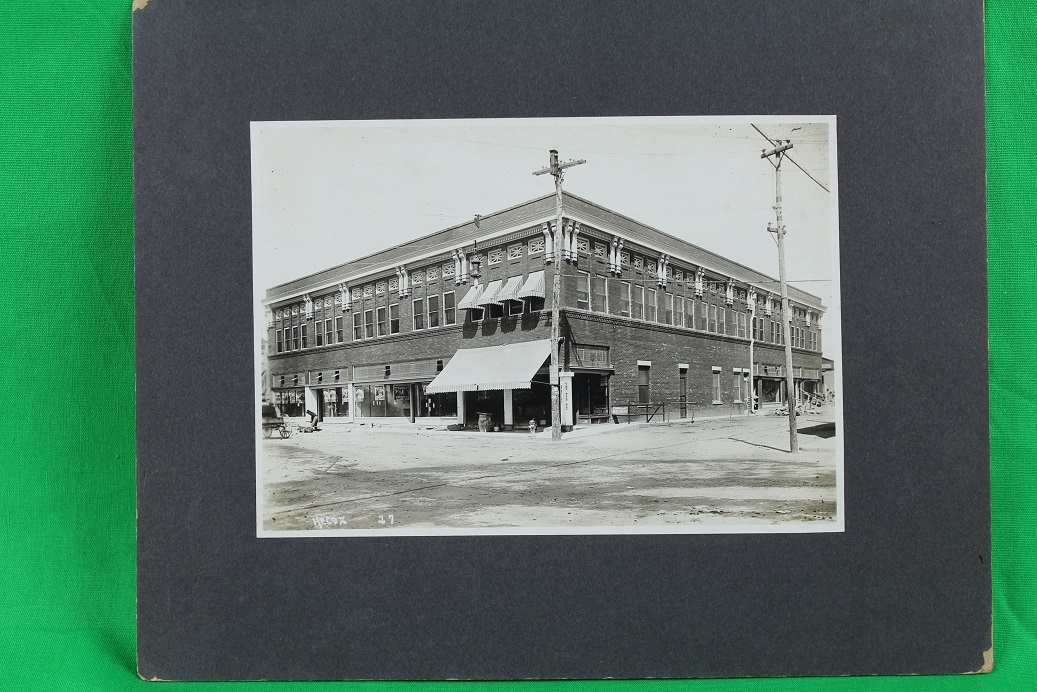
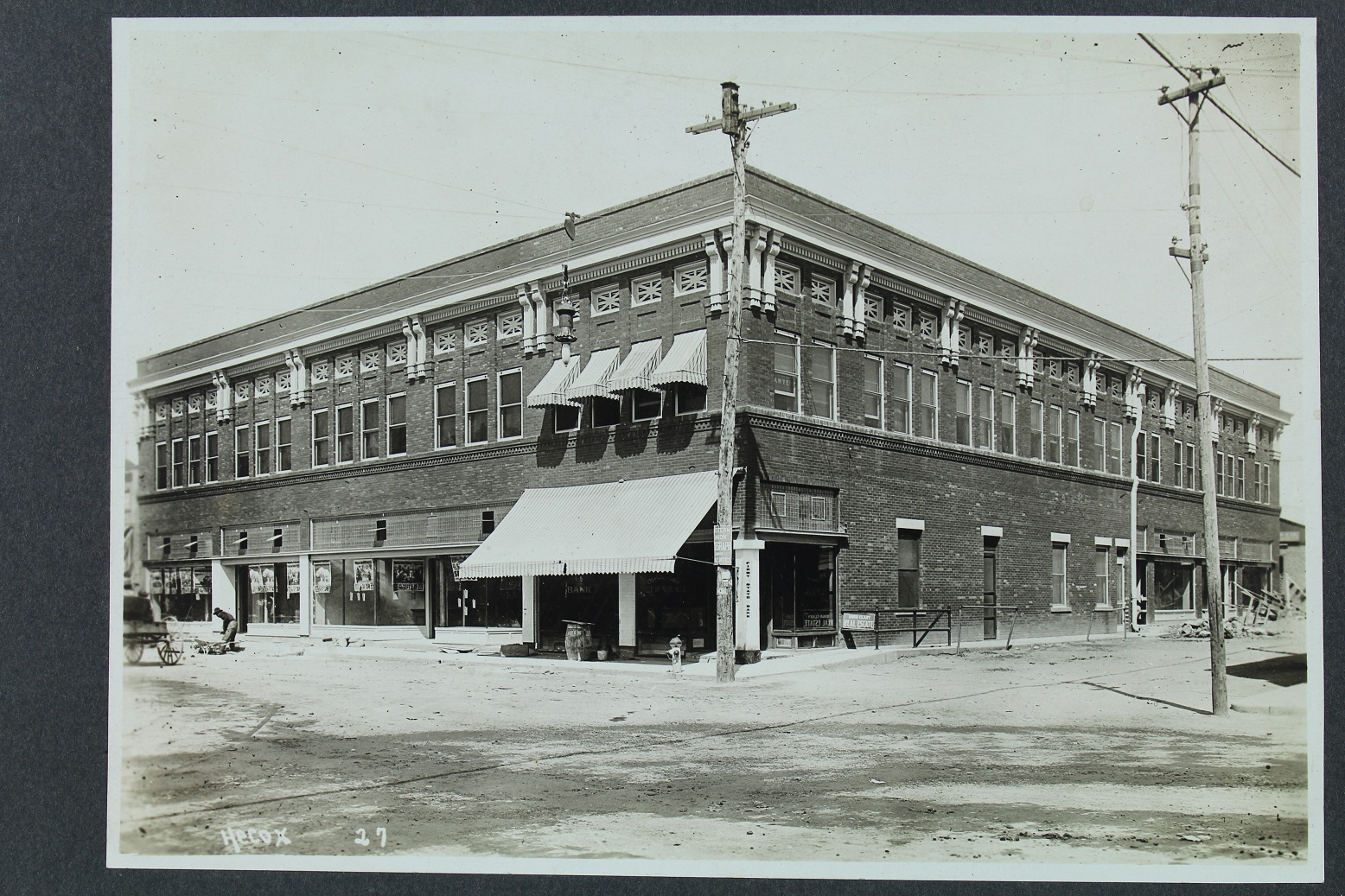
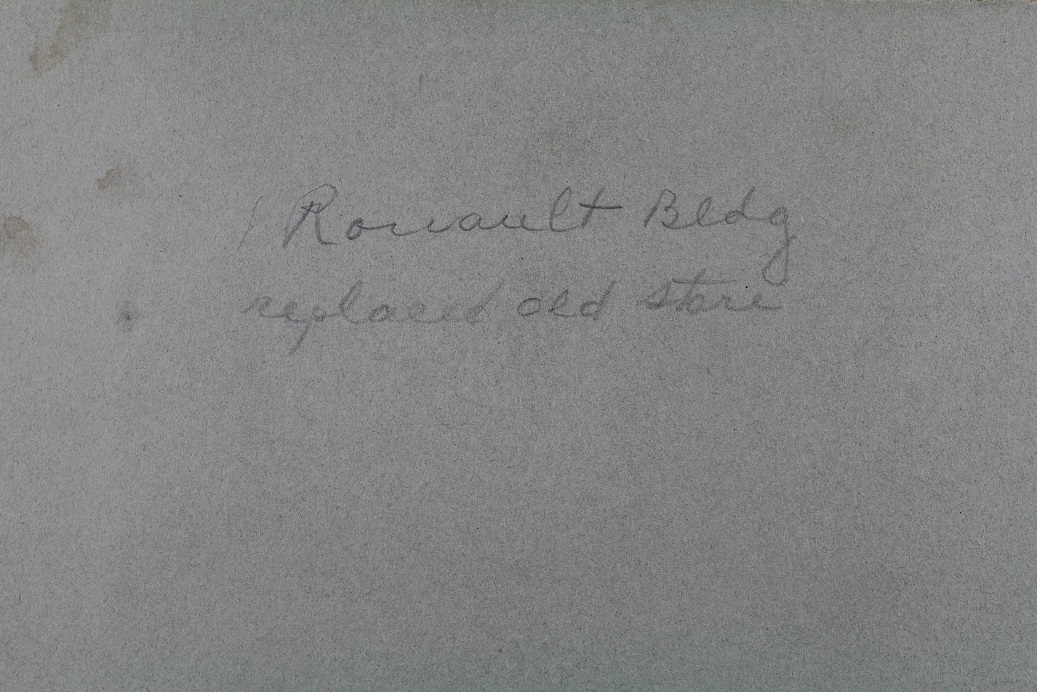
We just picked up some original Civil War Cdv's. Here they are:
Image 119
The first one is a mourning CDV that was made in 1865 following the death of President Lincoln. The maker / artist is S.J.Ferris. The card is approximately 2 3/8ths inches wide by 4 inches long. There is nothing on the reverse. For this historic CDV $65.00
Photography 020
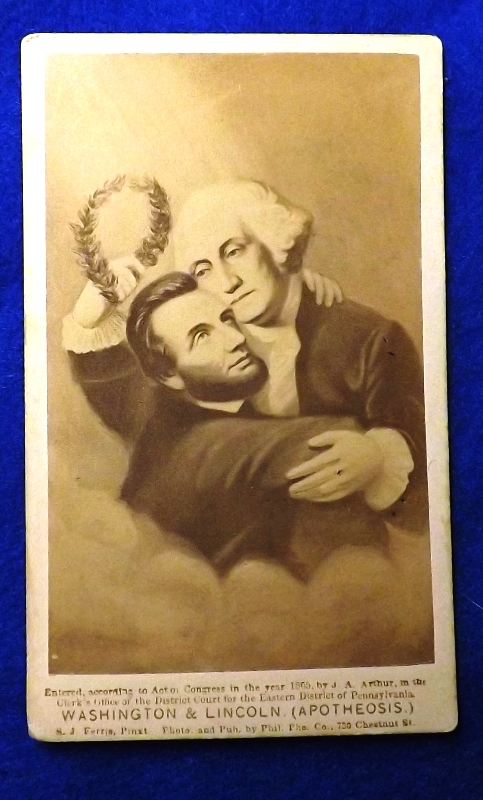

Image 118
Here is an Abraham Lincoln cdv with his name printed on the bottom. This is what's known as a photoengraveur meaning that they used a real photograph of the person but did some engraving to his clothes to finish it. The reverse of the card is blank. 2 3/8ths inches wide by 4 inches long. For this CDV $35.00
Photography 019
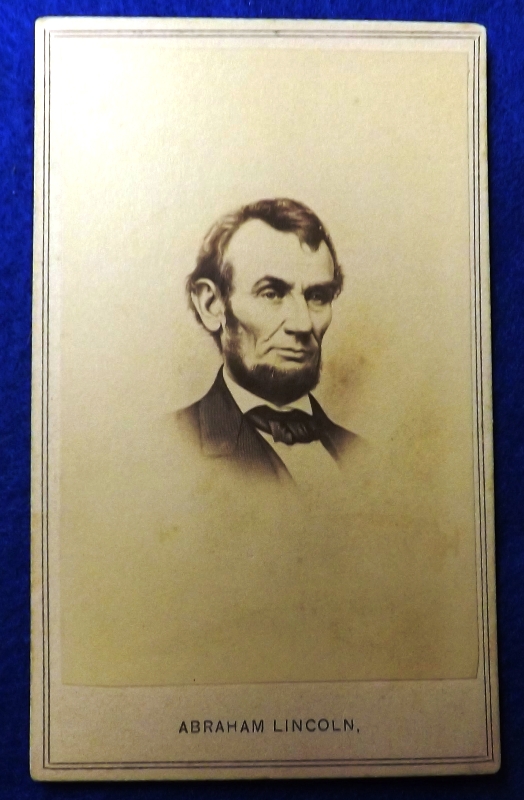
Image 117
Here we have a cdv ofMajor General William Tecumseh Sherman of Sherman's March to the Sea fame with his name printed on the bottom. There is nothing on the reverse. This card is also a photoengraving like the Lincoln image above. Nice one. $65.00
Photography 018
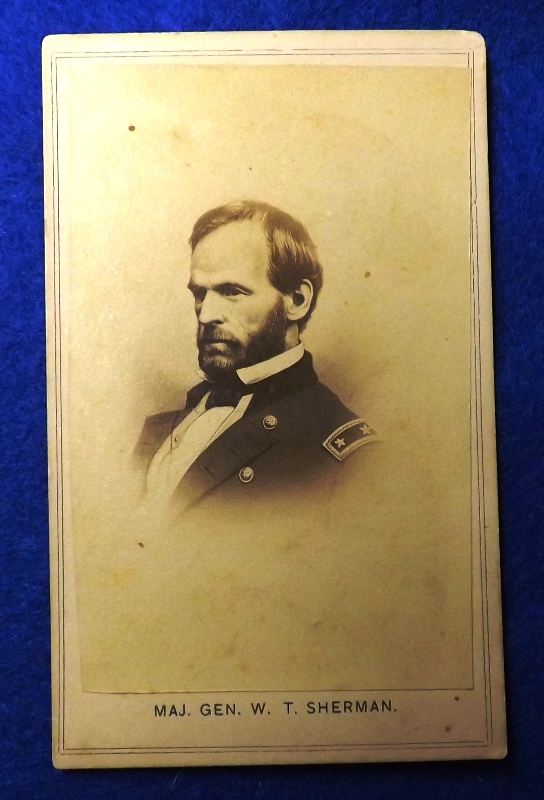
Image 116
Here we have an actual photograph of Major General Philip Henry Sheridan 'Little Phil' sitting with his arms folded wearing his unusual hat. He has a fine moustache but no beard in this one. His name and rank are printed below the image on this CDV. The reverse of the CDV is blank. $125.00
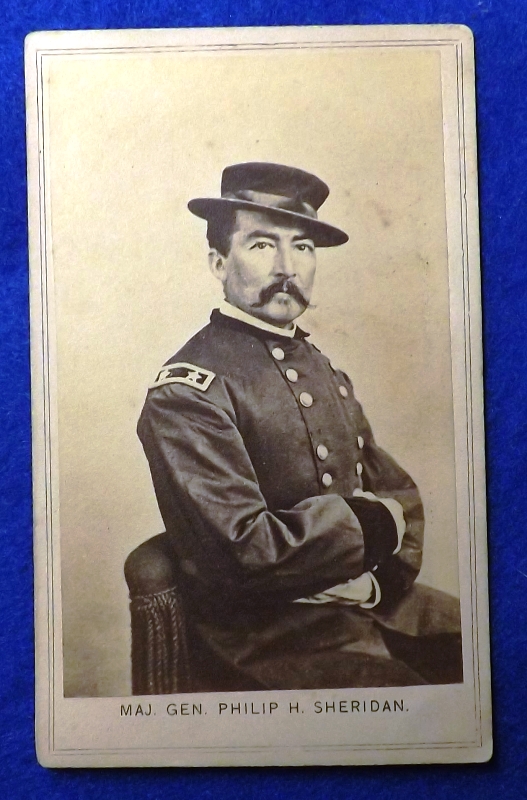
Image 112
Here we have a CDV of a young soldier in short coat and slouch hat. The backmark is from Lafayette, Indiana so it is probably the 17th Indiana Mounted Infantry or more likely, the 72nd Indiana Mounted Infantry. The 17th and the 72nd fought alongside each other but the 17th was mustered in Indianapolis and the 72nd was mustered in Lafayette. These regiments were a part of Wilder's Brigade and carried Spencer Rifles. The 3 cent revenue stamp of the reverse has the date of '65 on it so this would have been when their term of enlistment was up. Here's a capsule history of the 72nd:
72nd Regiment Infantry Organized at Lafayette, Ind. Moved to Indianapolis, Ind.. August 11, and there mustered in August 16, 1862. Left State for Lebanon, Ky., August 17. Attached to 40th Brigade, 12th Division, Army of the Ohio, to November, 1862. 2nd Brigade, 5th Division, Center 14th Army Corps, Army of the Cumberland, to January, 1863. 2nd Brigade, 5th Division, 14th Army Corps, to June, 1863. 1st Brigade, 4th Division, 14th Army Corps, to October, 1863. Wilder's Mounted Infantry Brigade, Cavalry Corps, Army of the Cumberland, to December, 1863. 3rd Brigade, 2nd Cavalry Division, Army of the Cumberland, to January, 1864. 3rd Brigade, Grierson's Cavalry Division, 16th Army Corps, Army of the Tennessee, to March, 1864. 3rd Brigade, 2nd Cavalry Division. Army of the Cumberland, to October, 1864. 1st Brigade, 2nd Division, Wilson's Cavalry Corps, Military Division Mississippi, to June, 1865. SERVICE.--Duty at Lebanon Junction, Ky., September 6-22, 1862. Moved to Louisville September 22, and to Elizabethtown, West Point, September 30-October 5. Pursuit of Bragg and operations against Morgan October 6-20. March to Bowling Green, Ky., October 26-November 3, thence to Scottsboro November 10. To Gallatin November 26 and to Castillian Springs November 28. To Bledsoe Creek December 14. Operations against Morgan December 22, 1862-January 2, 1863. Moved to Cave City, thence to Murfreesboro, Tenn., January 2-8, 1863, and duty there until June. Scout to Woodbury March 3-8. Regiment mounted March 17. Expedition to Carthage, Lebanon and Liberty April 1-8. Expedition to McMinnville April 20-30. Occupation of McMinnville April 22. Woodbury May 24. Liberty June 4. Middle Tennessee or Tullahoma Campaign June 23-July 7. Bay Spring Branch June 24. Hoover's Gap June 24-26. Occupation of Manchester June 27. Raid on Bragg's communications June 28-30. Dechard June 29. Raid to Lynchburg July 16-17. At Dechard July 27-August 16. Passage of the Cumberland Mountains and Tennessee River and Chickamauga (Ga.) Campaign August 16-September 22. Sequatchie River August 19. Wild Cat Trace August 20. Friar's Island August 25 and September 9. Capture of Chattanooga September 9. Lee and Gordon's Mills September 11. Ringgold September 11. Leet's Tan Yard September 12-13. Pea Vine Bridge and Alexander's Bridge September 17. Reed's Bridge and Dyer's Bridge September 18. Battle of Chickamauga September 19-21. Operations against Wheeler and Roddy September 29-October 17. Thompson's Cove, Cumberland Mountains, October 3. Murfreesboro Road, near McMinnville, and McMinnville October 4. Sims' Farm, near Shelbyville, and Farmington October 7. Shelbyville Pike October 7. Expedition from Maysville to Whitesburg and Decatur November 14-17. Moved from Pulaski to Colliersville, Tenn., December 31, 1862-January 14, 1864. Shoal Creek, Ala., January 24 (Detachment). Florence January 24. Athens January 25 (Detachment). Smith's Expedition from Colliersville to Okolona, Miss., February 10-26. Raiford's Plantation near Byhalia February 10. Ivey's Hill near Okolona February 22. Moved to Mooresville March 5-26, thence to Columbia April 3-8. March to Lafayette, Ga., April 30-May 9. Atlanta Campaign May to September, 1864. Battle of Resaca May 14-15. Near Dallas May 24. About Dallas May 25-June 5. Big Shanty June 9. Operations about Marietta and against Kenesaw Mountain June 10-July 2. Noonday Creek and Powder Springs June 19-20. Assault on Kenesaw June 27. On line of Nickajack Creek July 2-5. Rottenwood Creek June 4. Chattahoochie River July 5-17. Garrard's Raid to Covington July 22-24. Garrard's Raid to South River July 27-31. Flat Rock July 28. Siege of Atlanta August 1-25. Operations at Chattahoochie River Bridge August 26-September 2. Operations in Northern Georgia and North Alabama against Hood September 29-November 3. Skirmishes near Lost Mountain October 4-7. New Hope Church October 5. Dallas October 7. Near Rome October 10-11. Narrows October 11. Coosaville Road near Rome October 12-13. Near Summerville October 18. Blue Pond and Little River, Ala., October 21. King's Hill October 23. Ladiga, Terrapin Creek, October 28. Dismounted November 1, and ordered to Nashville, thence to Louisville, Ky., and duty there until December 28. March to Nashville, Tenn., December 28, 1864, to January 8, 1865, thence to Gravelly Springs, Ala.. and duty there until March, 1865. Wilson's Raid from Chickasaw. Ala., to Macon, Ga., March 22-April 24. Plantersville and near Randolph April 1. Selma April 2. Montgomery April 12. Columbia April 16. Capture of Macon April 20. Pursuit of Jeff Davis May 6-10. Moved to Nashville, Tenn., May 23-June 15. Mustered out June 26, 1865. Regiment lost during service 2 Officers and 26 Enlisted men killed and mortally wounded and 2 Officers and 130 Enlisted men by disease. Total 160.
This young soldier has the look of having 'seen the elephant'. He is wearing the short coat of the mounted infantry with sky blue trousers and slouch hat. The image is very nice with a little piece of the lower left corner missing that you can see in the pics. A great unit with a great history! $145.00 photography 09
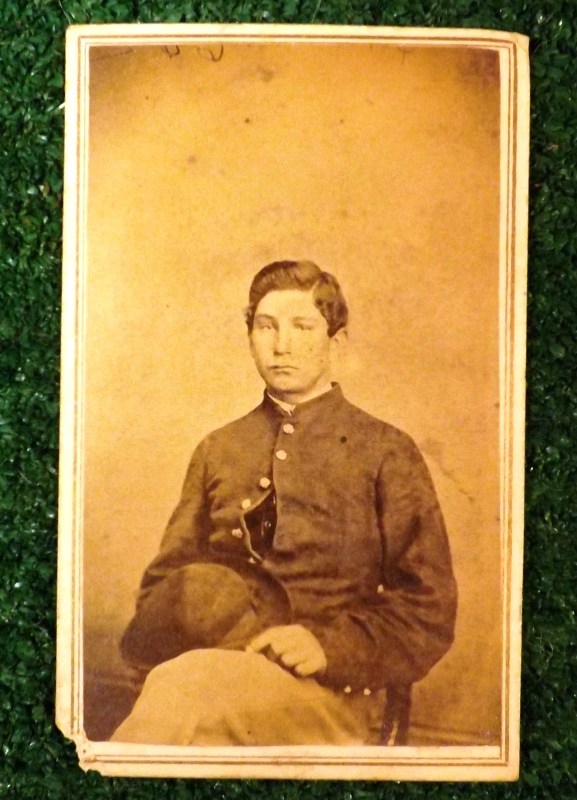
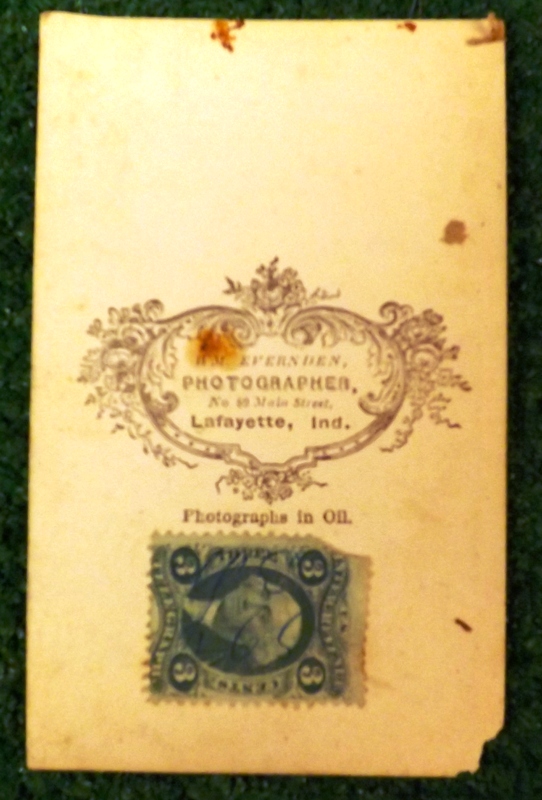
Image 111
Here are two 1800's CDV's of German soldiers. One is backmarked C.G.MARKERT of ALTONA and one is backmarked HEINRICH HIRSCHFELD of BERLIN. They are both in pretty good condition with some foxing. For the pair $35.00 photography 06
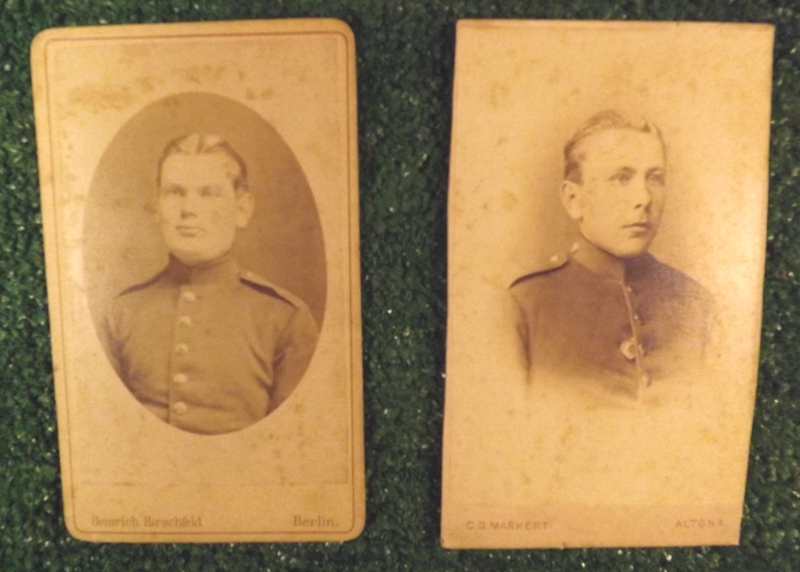
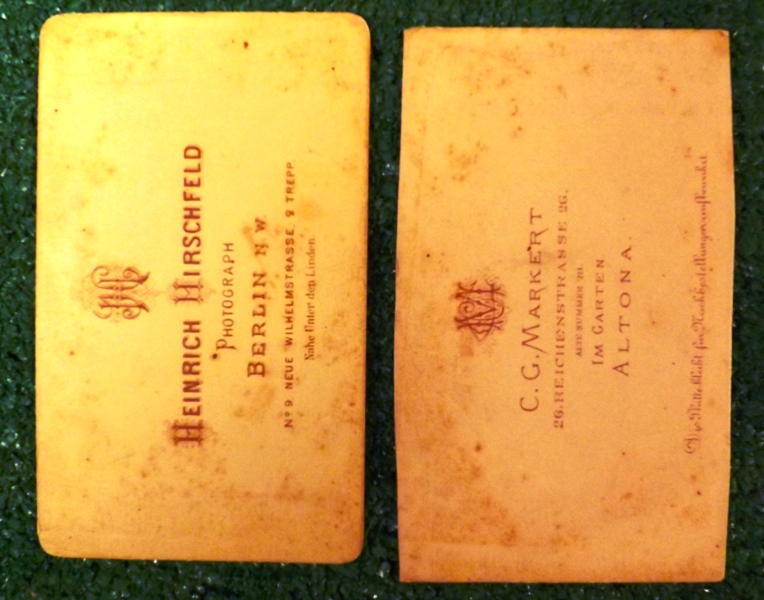
Image 110
Here is an early postcard from the late 1800's or early 1900's. The postcard was invented in Austria in 1869. This one has an albumin print on it of 2 young Cowboys! Both of them are holding lassos but the bigger boy is also holding a revolver and you can see the holster as well. The back of the card says to PLACE ONE CENT STAMP HERE so you know this is very old! There is one small broken corner on it. For this Cowboy postcard $20.00 photography 05
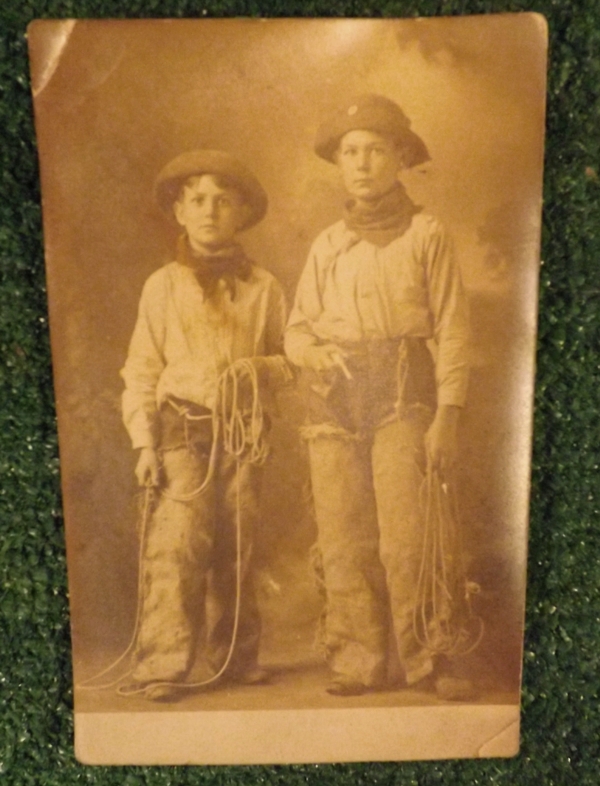
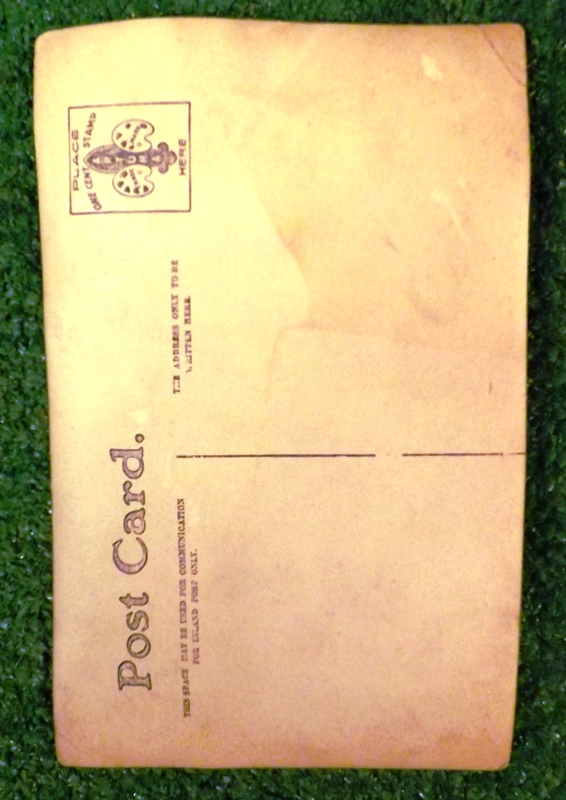
<>
Image 105
Here is an outstanding curved glass Ambrotype of a remarkably beautiful young woman in her 20's. I would date this ambrotype to the 1850's and possibly to the very early 1860's. This is one of the most clear ambros that I have every seen and the detail is awesome! Since the image is on a curved piece of glass it kind of gives the image a 3D quality. The only detractor with this piece is that the case is a marriage. Other than that you can't as for a better image! No Id on this one but she was found in Lafayette, Indiana. $145.00 photography 02
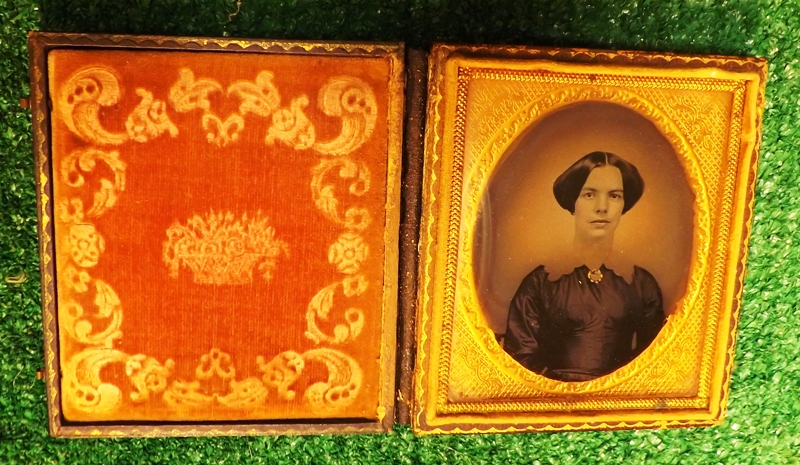
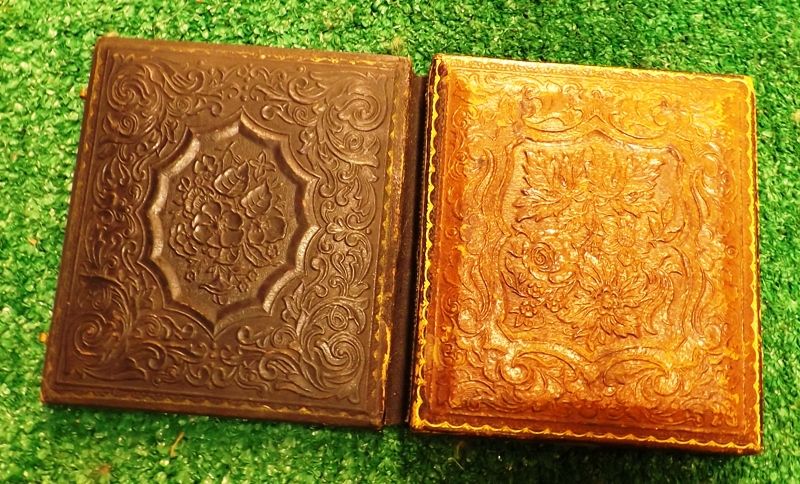
Image 104
Here is an exceedingly rare item! This is a Dietz Portable Dark-room red glass lens Lantern from the 1800's. A reference site dealing with Dietz Lanterns stated that these were rare of the rare and were made before 1901, however, the site didn't state when they were first introduced. The Montgomery Ward 1895 catalog has a drawing of one on page 220 with the price of 50 cents on it and I saw another 1894 publication that had a drawing of one in it. In 1857 Dietz & Company submit the first flat-wick burner for "modern" coal oil for patenting and in 1859 Dietz & Company begin manufacturing coal oil flat-wick burners. This lantern has the flat-wick burner that you can see in the pics. Photographs have to be developed in the dark and using red light is the same as being in the dark. I don't know how early this lantern is but I believe it's very early. The piece stands about 6 1/3 tall including the little chimney at the top. is 2 5/8 inches wide and 1 1/2 inches deep not including the little handle that you use to carry it around with. On the front is the stencil --- RUBY LANTERN. The little lid raises up to expose the red flat glass panel that the lit oil wick shines through. The glass is in excellent condition with no cracks. The little wick and tank are in excellent condition and you can see DIETZ embossed on the bottom. This piece is in excellent condition for it's age with just a little paint loss here and there. I found one other on the internet for an example that was not for sale and it had a cracked lens. I found no others listed after an exhausting search. If you are into early photography then this fine little lantern is for you! RARE! $250.00 item photography 1
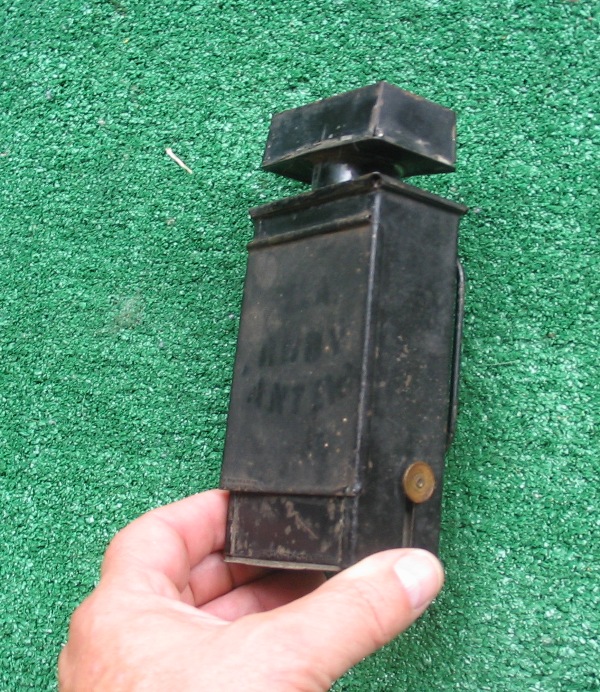
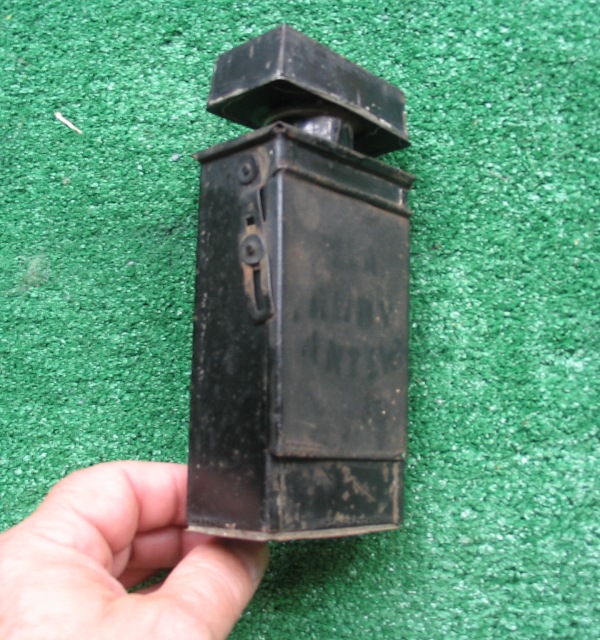
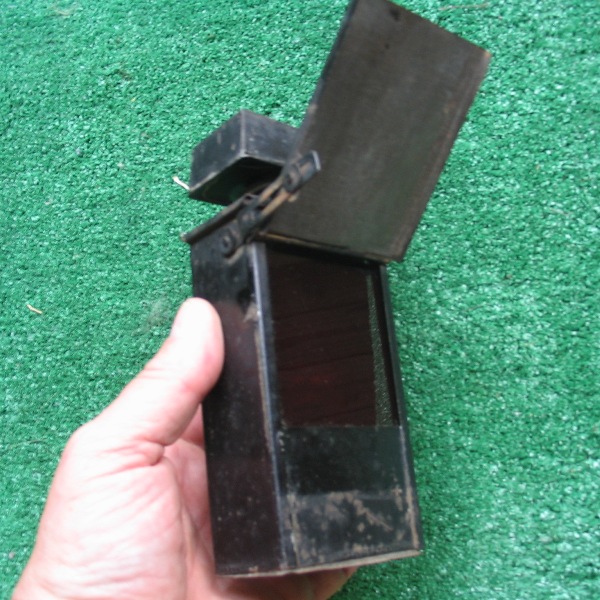
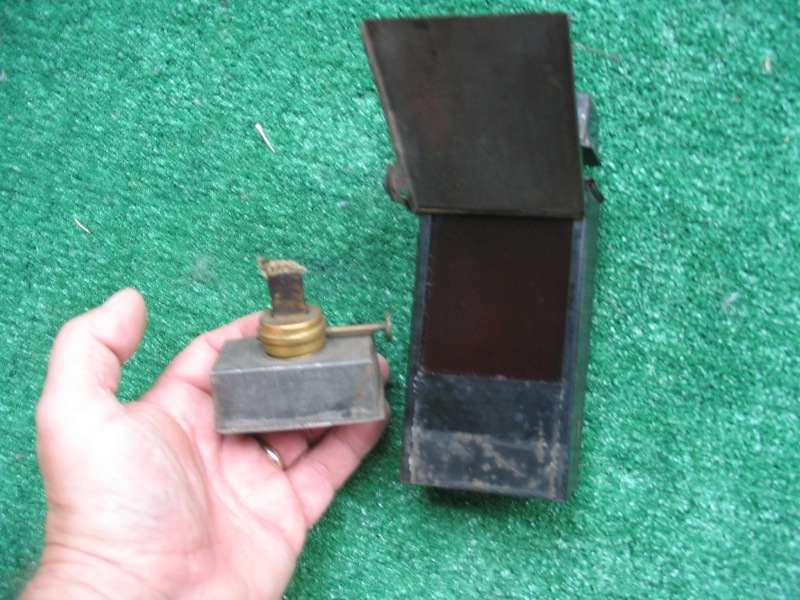
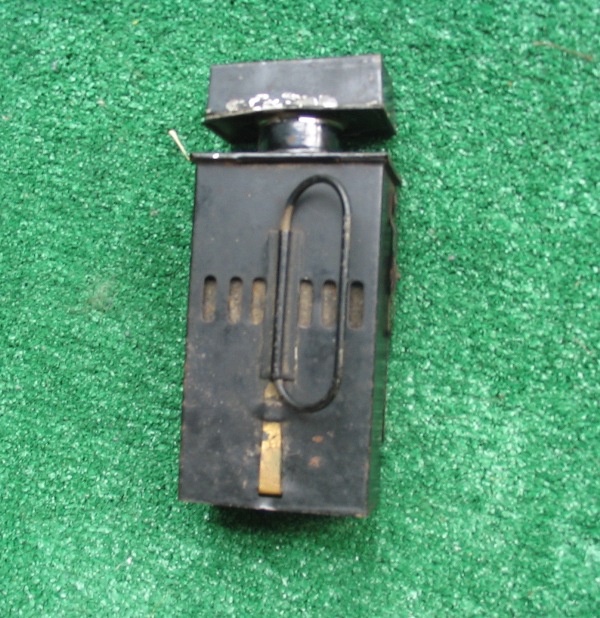
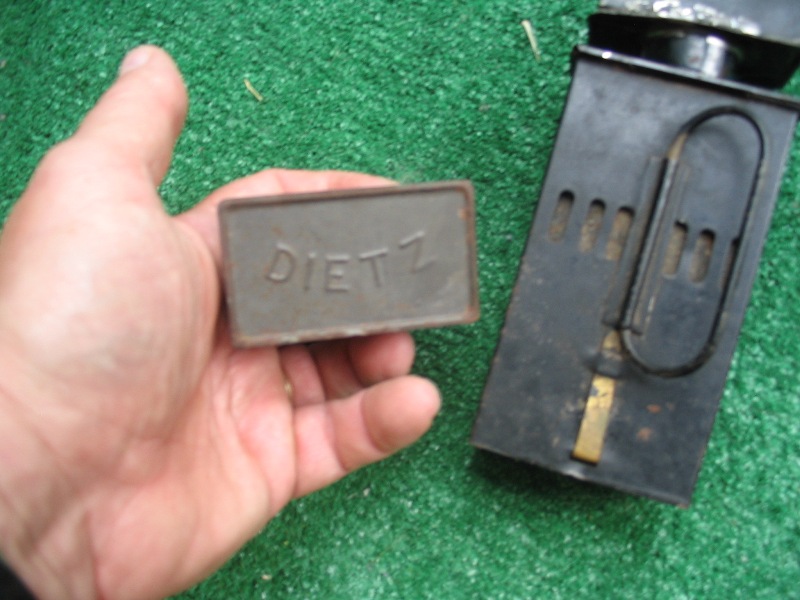
Image 103
Here's a great little item! This is a small all brass Album that contain 4 different photos. There are photos of a gentleman that I believe I have seen but I can't remember who he is as well as photos of Union General Rosecrans and Union General Tecumseh Sherman. On the reverese of the Sherman photo is a woman that I believe to be Mrs Sherman. All of the photos seem to be CDV type or Gem paper type. The album closed measures about 3/4 inch wide by 7/8 inch tall! Incredibly small! The album has a brass ring at the top which runs through a 1838 4 Pence English Coin! Again, this album is incredibly small and rare to find! $350.00 item photography 2
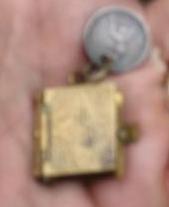
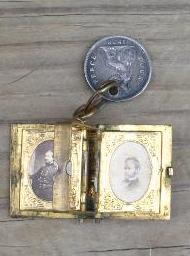
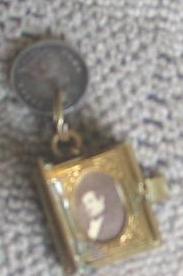
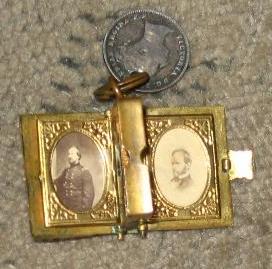
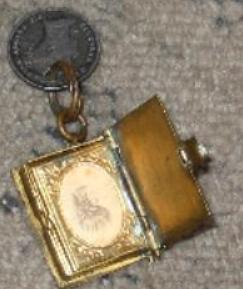
2
Image 102
Here's another stereo-optic card entitled ROCK OF AGES - THE RESCUE. This one is copyrighted 1895 by Littleton View Co. The above phrase ROCK OF AGES - THE RESCUE is on the back of the card in 6 different languages! Nice card! $3.00 item photography 3
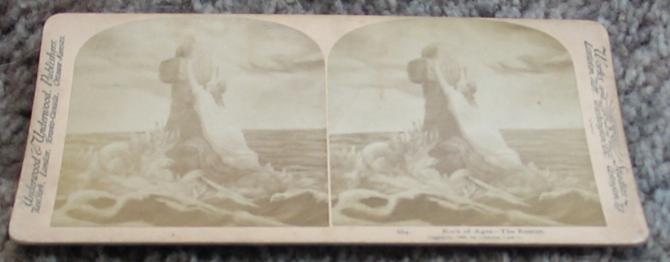
This next stereo-optic card tackles the Women's Suffrage Movement or rather is trying to scare men into controlling their wifes! This card is dated 1895. Here's some facts on Women's Sufferage:The term women's suffrage refers to the economic and political reform movement aimed at extending suffrage — the right to vote — to women. The movement's modern origins lie in France in the 18th century. Of currently existing independent countries, New Zealand was the first to give women the right to vote in 1893.[1] Similarly, the colony of South Australia enacted legislation giving women the vote in 1894. Places with similar status which granted women the vote include Wyoming Territory (1869). Other possible contenders for first "country" to grant female suffrage include the Corsican Republic, the Isle of Man (1881), the Pitcairn Islands, Franceville, and Tavolara, but some of these had brief existences as independent states and others were not clearly independent. Australia extended this right in 1901 to some women, and then in 1902 to all non-aboriginal women. A contestant for being the first independent nation to grant the right to vote for women would be Sweden, where some women were in fact allowed to vote during the age of liberty (1718-1771), although this right was far from applying to women in general. Voting rights for women were introduced into international law in 1948 when the UN adopted the Universal Declaration of Human Rights. As stated in Article 21 “(1) Everyone has the right to take part in the government of his country, directly or through freely chosen representatives. (3) The will of the people shall be the basis of the authority of government; this will shall be expressed in periodic and genuine elections which shall be by universal and equal suffrage and shall be held by secret vote or by equivalent free voting procedures.” Women’s suffrage is also explicitly stated as a right under the Convention on the Elimination of All Forms of Discrimination Against Women, adopted by the United Nations in 1979. 2
Image 101
This is an important card from an important period of Women's Sufferage. This shows a bossy lady (could be my wife!) pointing her bossy finger at her husband who is doing the laundry while 2 small children sit at his feet. I'm sure he's trying to take care of them too! My wife and I worked through this problem. She tells me what to do and I do it. Anyway, it works for her!
Nice Quality! $3.00 item photography 4
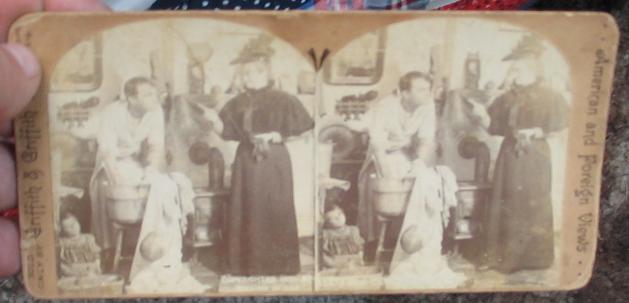
Image 100
Here we have 4 cabinet cards from about 1880 showing the railroad at Madison Indiana near the Ohio River. Two of the photos are looking at the J.M. & I. Railroad (don't know what the J.M & I stand for) at Madison Indiana. They each measure about 4 1/2 X 6 1/2 and have descriptions on the back. They are somewhat faded but better than what my pics show. Two pics are from the P.C.C. & St. L. R. R. (something and St. Lawrence Rail Road), $25.00 for all. item photography 5
Image 82
This is a nice movie poster featuring the movie Amistad, staring Morgan Freeman, Anthony Hopkins, Djmon Hounsou, Mathew McConaughey. Very good condition. Came out of large collection of movie posters that came from a video store in Richmond, Virginia. True story of a rebellion aboard the Slave Ship Amistad where the slaves arose and killed the Ships Captain Slavemaster and others. Riviting movie and a must see for the serious student of Civil War Era history. Nice Poster! $45.00 item photography 26
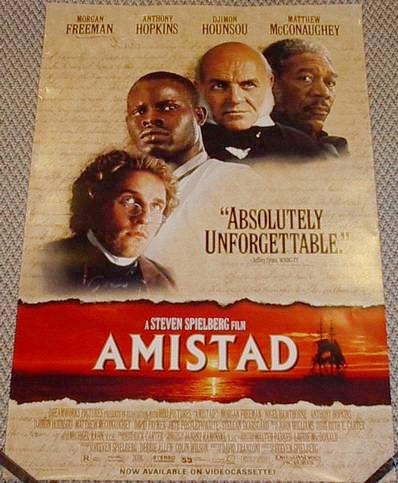
Image 80
This is a wonderful Civil War Era CDV of a horse and buggy that has 5 people in the buggy and one standing alongside. There is even a dog laying on the ground under the buggy. The backmark is in green ink and says AUGUSTINE H. FOLSOM PHOT. NO. 2 SOREN'S BLOCK ROXBURY. 118 WASH'N ST. BOSTON. Excellent Condition with wonderful content!!! Hard to find outdoor CDV's of the Civil War Era. $65.00 item photography 28
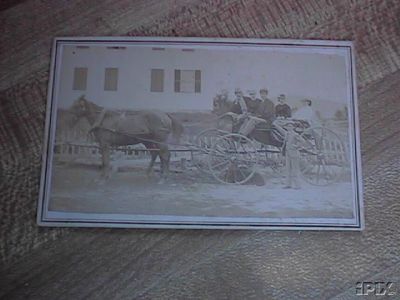
Image 78
This is a fairly large albumin photo of a Spanish American War Cavalryman on his horse. I believe they are in front of barracks of sort due to the door configuration. I really don't know where the photo was taken and there is no clue on the back as well. I picked up this photo about 30 miles from my home in central Indiana. The Horse is large and beautiful and you can see that he has a shoemaker bit in his mouth. The soldier wears the classic Spanish American War uniform with the felt hat. He sure sits tall in the saddle! The mount is 8 X 10 inches while the photo is 4 1/2 X 7 1/2 inches in size. The photo is more of a brown sepia tone than my pics show. Wonderful subject matter!!! $45.00 item photography 31
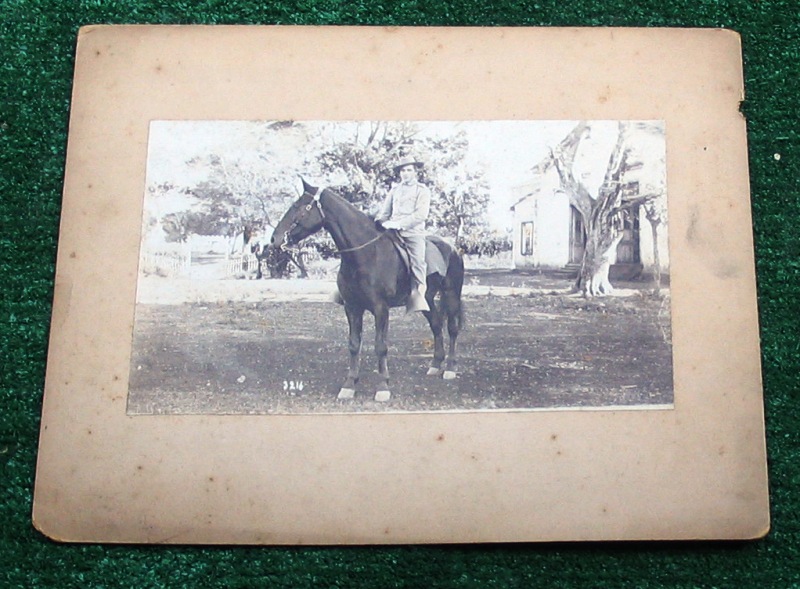
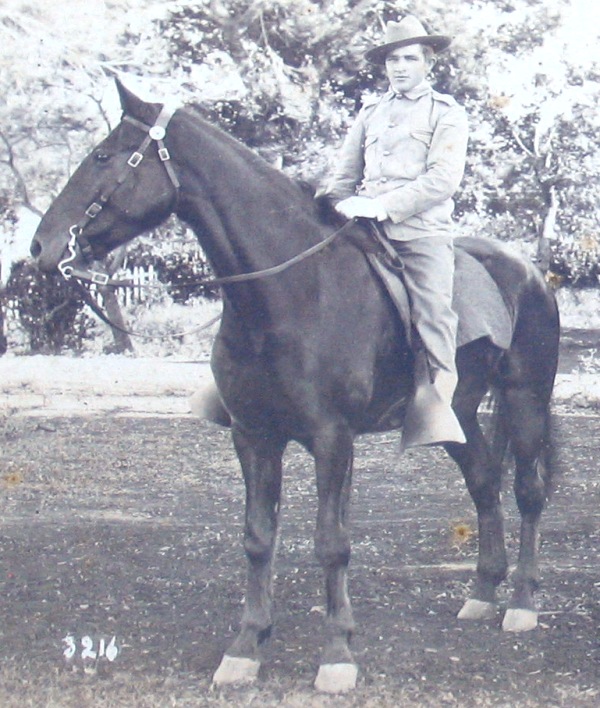
Image 77
The next 3 items are all found here in Indiana. These are 3 tintypes of Civil War Soldiers. The first tintype is a 1/4 plate tintype in full case of 2 Civil War Union Soldiers sitting side by side. One of them is a corporal and the other a private. This tintype is extremely clear and sharp! This is one nice quarter plate. No id accompanies this piece. This one can be yours for $395.00 item photography 32
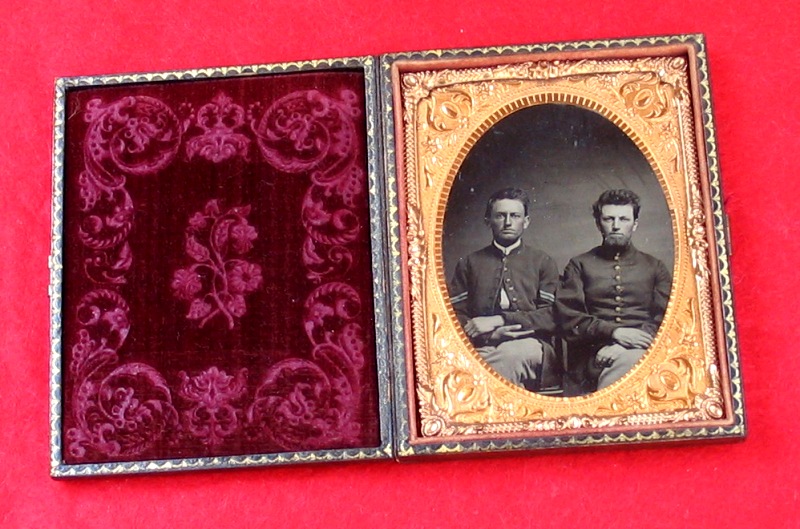
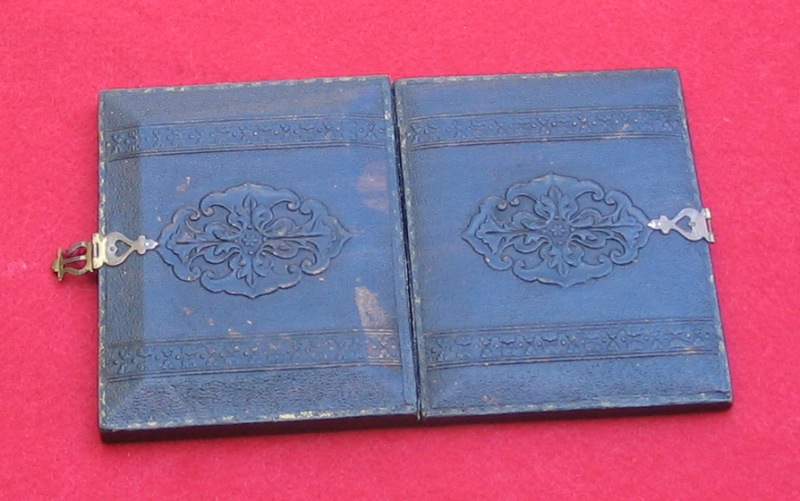
<
Image 75
Here is something that I have had a long time and decided to let it go. this is an original CDV of Indiana's wonderful Govenor Oliver Perry Morton. He was well loved by his soldiers and he did everything he could to outfit them, even paying for some of it himself! The CDV has on the reverse C.W.Mangrum's Photographs Gallery, West Jefferson Street, Franklin, Ind.
UNITED STATES GOVERNORS FROM WAYNE COUNTY, INDIANA. These accomplished individuals were born and/or resided in Wayne County. #1; The 4th Governor of Indiana, James Brown Ray. 2-19-1794 ~ 8-4-1848 RAY WAS INDIANA’S YOUNGEST GOVERNOR AT AGE 31 Resided in Centerville, Indiana Wayne County Indiana Prosecutor in 1819 Practiced law in Centerville, Indiana- when Centerville was the County Seat of Wayne County Resided in Connersville, Indiana for short time and was Fayette County Deputy Clerk Acting Governor of Indiana from 1822 until 1825 Lt. Governor from 1824 until 1825 Was the Elected Governor of Indiana from 1825 until 1831, during which time the State’s population grew by 55% Promoted the growth of Indiana Railroads Died at age 54 from Cholera James B. Ray, for whom Raysville (Henry County, Indiana) was named, was the fourth Governor of the State of Indiana, serving as such for nearly seven years. His predecessor, Governor William Hendricks, having been elected a United States Senator, resigned as Governor, February 12, 1825, when he was succeeded by Ray, then the President of the State Senate. Ray was elected Governor at the August election, 1825, and served two full terms of three years each. Source; Hazzards History of Henry County, Indiana; 1906 *** Hon. James B. Ray, Governor of Indiana from 1825 to 1831, and the youngest man (age 31) that ever occupied the gubernatorial chair up to that time, lived in Centreville from 1837 to 1840 and practiced law. He was a brilliant speaker, a zealous lawyer and very popular. He died comparatively young. His brother, Martin M. Ray, resided in Centreville many years. Martin M. Ray was an early and prominent lawyer, who served several years as Circuit Prosecutor. We are indebted to Hon. Jacob B. Julian, who was his law partner for several years, for the following particulars concerning him: ¯ He was a native of Kentucky and came to Indiana at a very early day, perhaps as early as 1817, settling at Brookville. He was a cabinet-maker by trade, and was successively a mercbant and a banker. At the age of thirty he engaged in the practice of law, first at Connersville, and in 1829 at Centreville, where he continued in active practice until 1845. He then retired, from practice and removed to Indianapolis, where he died in 1869. He was an excellent lawyer, and during the years of his practice at Centreville he ranked among the best in the profession at the time. He was a worthy man and a good citizen.¯ Source; History of Wayne County, Indiana; Inter-State Publishers; 1884 *** The 14th Governor of Indiana, Oliver P. Morton. August 4, 1823 ~ November 1, 1877 INDIANA’S CIVIL WAR GOVERNOR O.P. Morton was born in Salisbury, Wayne County, Indiana August 4, 1823 He later resided and practiced law in Centerville, Indiana Was also a U.S. Senator Died November 1, 1877, & buried in Indianapolis, Indiana
The document below is outstanding! This is signed on the back in bold black ink O.P.Morton, Gov. of Inda' in the Governors old hand! The front is a Military pass and is from the Adjutant General's Office and states Indianapolis, Mar 10th, 1864. The Steamer Jenl. Buel will pas Genl. Mansfield from Madison to Jeffersonville & return - Business Military by order of the Bovenor. Laz. Noble, Adj't Gen'l. Outstanding quality! General John Mansfield (1822 - 1896)
John Mansfield (1822 - 1896) Born: Mendon, Monroe County, NY Died: 05/06/1896 in Los Angeles, CA Promotions Date To Rank Full/Brevet Army/Vol Comments 06/11/61 Captain Full Vol 2nd WI Infantry 01/26/63 Major Full Vol 09/01/63 Lt Colonel Full Vol (resigned 08/26/64) 12/03/64 Colonel Full Vol 12th Veteran Reserve Corps 03/13/65 Brig-Gen Brevet Vol
These pieces were placed in a 'floating' frame for display so you could see both front and back. $450.00 item photography 46
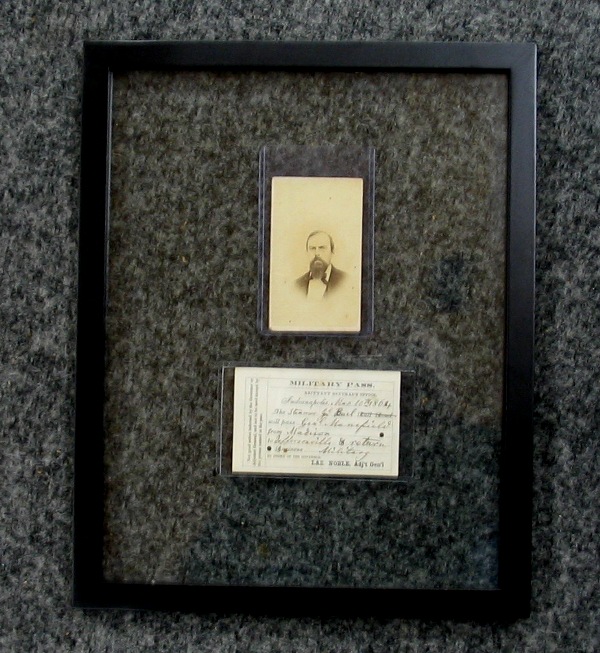
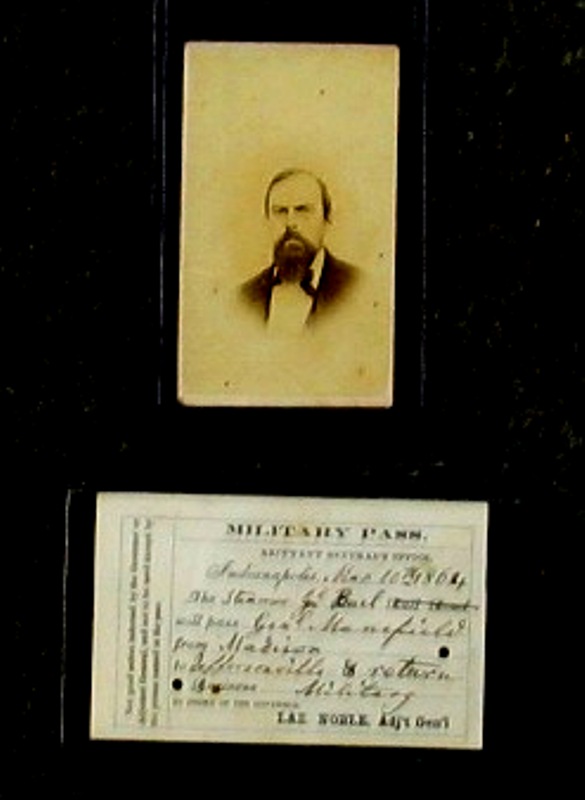
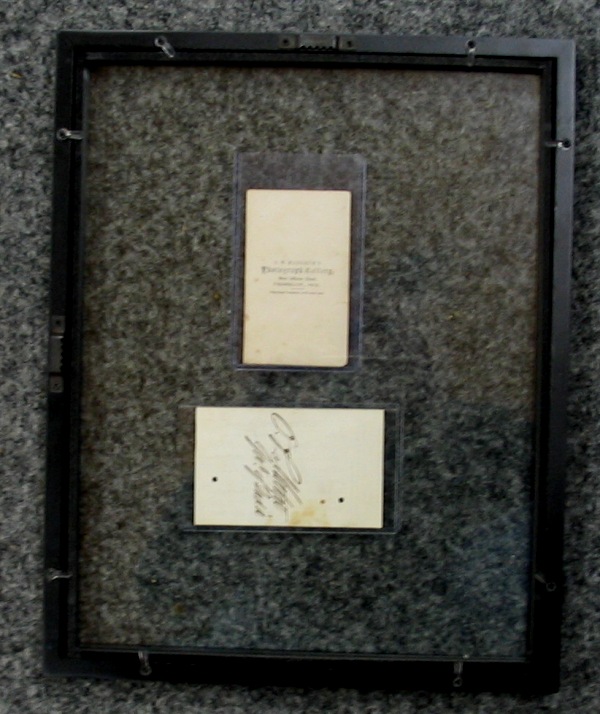
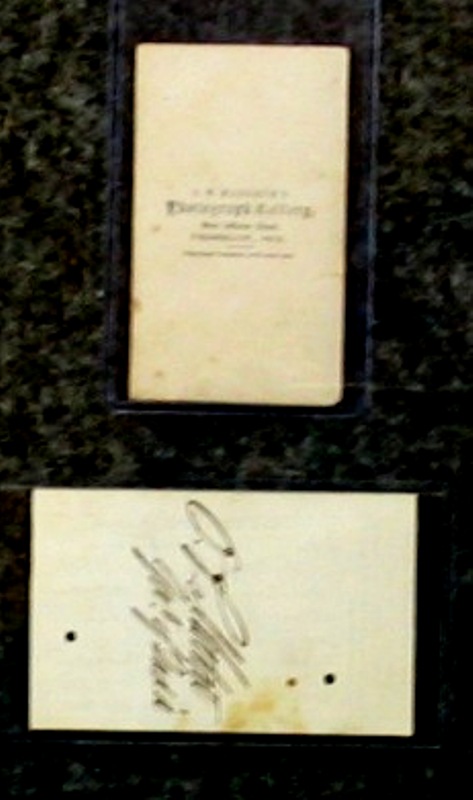
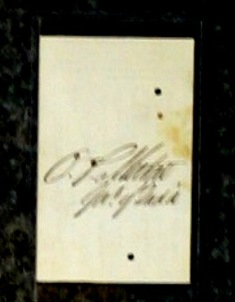
Image 73
Here's a fairly large photo of General Winfield Scott otherwise known as 'Old Fuss and Feathers' because of his disposition. He was much too old to be on active duty during the Civil War but he started out in a very important position anyway. Born near Petersburg, Va. on June 13, 1786, having already served as the country's general-in-chief for two decades, America's preeminent military figure-perhaps the most celebrated since George Washington, Scott was nearly 75 when he commanded the Union armies at the start of the Civil War. By that time, Scott, a Virginia native who refused to join the Confederacy, was clearly nearing the end of his brilliant career. Hero of the War of 1812 and Black Hawk War, commander of U.S. forces in the Mexican War, unsuccessful Whig presidential candidate in 1852, Scott, called "Old Fuss and Feathers" because of his devotion to military pomp and protocol, now suffered from gout and vertigo, weighed more than 300 pounds, and could no longer ride his horse. Because of his infirmities, he required a field commander and urged Lincoln to appoint his fellow Virginian Robert E. Lee to the position. George B. McClellan, who got the post after Lee turned down the Union commander's personal appeal, soon began to resent Scott and took to contradicting him in staff meetings and snubbing him in public. By then, however, the general-in-chief was being amply ridiculed elsewhere as well. Blamed for the Union's dismal showing in the first months of the war, Scott received sharp criticism for his "Anaconda Plan," in which he recommended a naval blockade to press the Confederacy while the Union gradually developed its armed forces for what he anticipated to be a long struggle. Although Scott was more clearheaded on the subject than the majority of military and political figures-Union and Confederate alike-who believed the war would conclude quickly, many suspected Old Fuss and Feathers was growing senile. On November 1, 1861, after another Union battlefield defeat at Ball's Bluff, Lincoln accepted Scott's standing offer to resign. Succeeded the same day by McClellan, he retired to write his two-volume memoirs, travel through Europe, and see the essential elements of his Anaconda Plan ultimately prove effective in the waging of the war. Scott lived to see the Confederates defeated, dying in West Point, N.Y., May 29, 1866. Though he was buried at West Point, he never attended there. Now back to the photo. This photo appears to be an albumin photo due to the satin finish when holding the photo sideways. The card measures about 4 inches by 6 inches while the print is 2 X 3 3/4 inches in size. The card is marked with the photographer info below the photo. The mat is original and from Richmond, Indiana. This photo, as it is, is a fake- made to deceive. You can see where the original photo was removed and this one was glued in it's place. If you look at the photo under magnification you will see matrix dots. The magazine type photos from the early 20th century on has the same type of dots. However, this photo looks great and is very useful as a teaching tool. It also looks great on the wall. If you never magnified it you would never know the difference. Knowledge is power! Check it out. Remember, it's a fake! $30.00 item photography 49
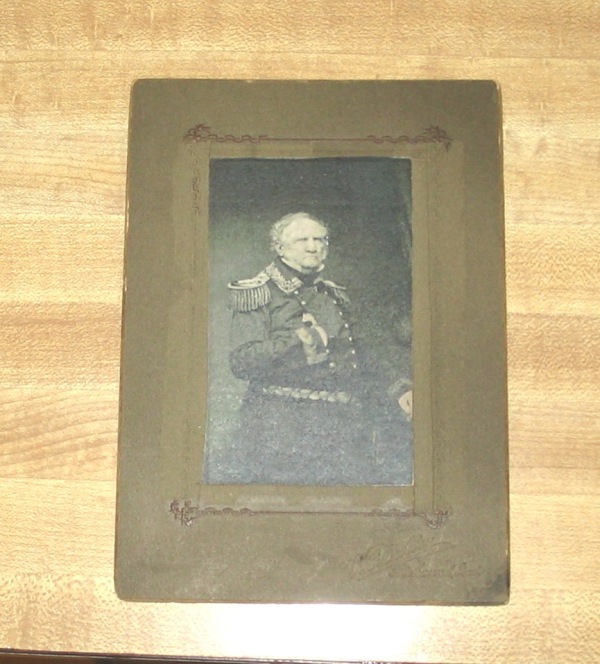
Image 72
This next photo is an excellent fake as well. It's made just like the General Winfield Scott photo and looks like an albumin photo made with egg whites but it is not. This is made from an original photo somewhere and shows 5 Plains type Native Americans holding up weapons. This photo is obviously made the same and probably from the same faker. The photo card is 7 1/2 X 4 inches with the photo being 2 3/4 X 3 3/4 inches. Excellent content but crudely put together. Again, knowledge is power! Use this as a teaching tool. Again, you couldn't tell this was not an old photo unless you magnified it for clarity. $30.00 item photography 50
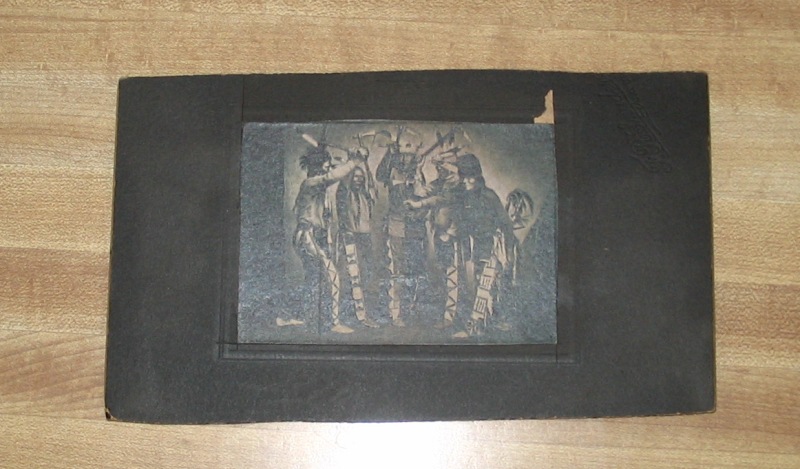
Image 71
Here's a nice photograph of a Spanish American Era Sailor holding a Krag Rifle with Bayonet. His tally on his cap says U.S.S. TENNESSEE ! GEORGE LOW a Seaman, U.S. Navy on board the USS Tennessee, won the Navy Medal of Honor at New Orleans, La., 15 February 1881. This particular sailor is id'd on back of the photograph as Walter H. White. It's light and in pencil but guaranteed to be there!
History Of The U.S.S. Tennessee
Six ships of the United States Navy have been named USS Tennessee in honor of the 16th state. •(1862 The first USS Tennessee was a paddlewheel steamer captured from the Confederacy at New Orleans on April 2, 1862. •(1864) The second USS Tennessee was a Confederate ironclad captured from the Confederacy in the Battle of Mobile Bay on February 16, 1864. •(1869} The third USS Tennessee was a wooden screw frigate originally built and named as Madawaska. •(1904) The fourth USS Tennessee (ACR-10) was the lead ship of her class of armored cruiser. •(1919) The fifth USS Tennessee (BB-43) was the lead ship of her class of battleship. •(1986) The sixth USS Tennessee (SSBN-734) is an Ohio-class submarine. I suppose this photo is probably the one built in 1904 but I don't know for sure. The photo is a little dirty but you can still clearly see everything of importance. It's still nice! $35.00 item photography 51
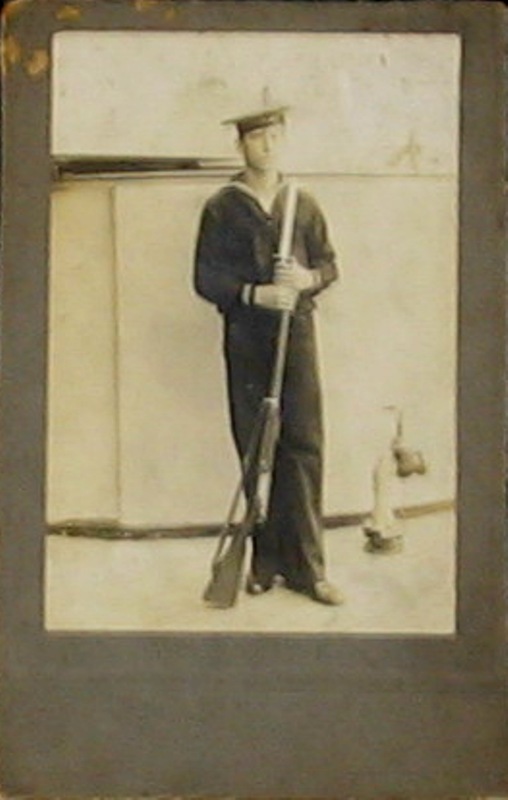
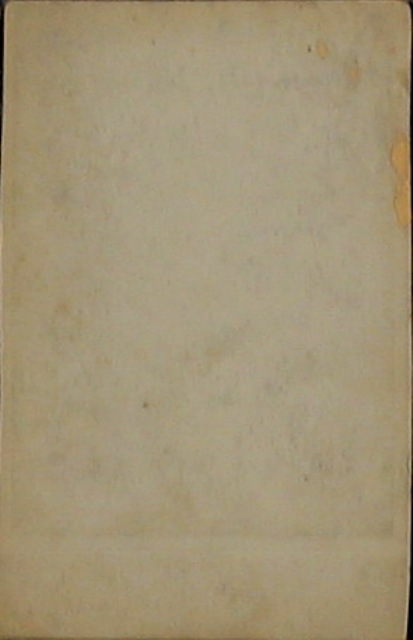
Image 69
Here's something you don't find empty very often. This is an original Civil War era Photo Album with latch. The leather cover is in good condition with a little wear and breakage on the back album cover hinge. The only major thing wrong with the outside is that the front cover is missing one of the little porcelin buttons. The inside spline is separated some in the front but can be easily repaired. There's room for 48 photos back to back in the CDV sized album. The album pages are gilted on the edges. It's a little stiff but probably hasn't been opened for years. Still a fairly good album that would be great for you to place your CDV's in. $65.00 item photography 53
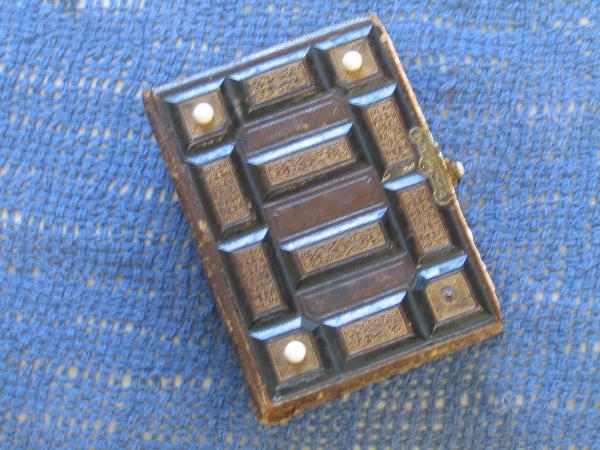
Image 64
Here's 2 tintypes that I picked up with a soldier tintype. These are out of cases or an album. The first one is a 1/9th plate that kind of looks like a young Abraham Lincoln but he's much better looking that 'Ole Abe'. He's wearing the same kind of suit and cravat. The second tintype is a striking pose of a hugh man with very masculine features. He kind of looks familiar to me but I just can't put my finger on it. This one is about tintype size and came out of an album. If you have any info on this man or if he looks familiar to you as well, let me know. Thanks for looking. item photography 58
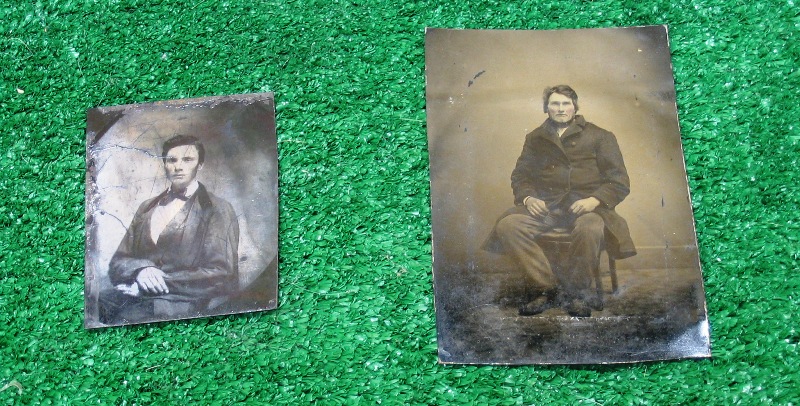
Image 63
Here's a nice example of an 1850's photograph referred to as a Daguerrotype. Looking at it from certain angles makes it look like a mirror. It was a poisonious occupation that used mercury in the photographic process on a copper plate so photographers turned to ambrotypes and tintypes for safety. This photo is in the 6th plate size and is very clear with some spotting to the plate on the lower left hand side. The case is in good condition with tape on the spline. Still clear and definitely a look into the past. This young man was probably 18 or 19 in this photograph and definitely old enough to participate in the Civil War some 10 years or so later. $45.00 item photography 59
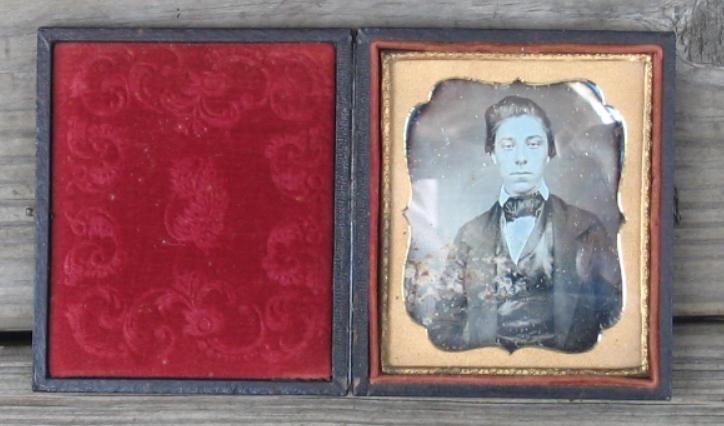
Image 48
Here are 3 CDV's of lads that are Military Academy students. Two of the CDV's are of the same boy and he is identified as Richard M. Bowen age 10 years and is dated 1863. The other boy holds a kepi by his side. They are both wearing shell jackets and the same dark pants. The backmarks are E.B.Carpenter, Photographer, successor to Frank Rowell, Providence, R.I. Nice images! The one little fellow doesn't look too happy. For the 3 - $120.00 item photography 75
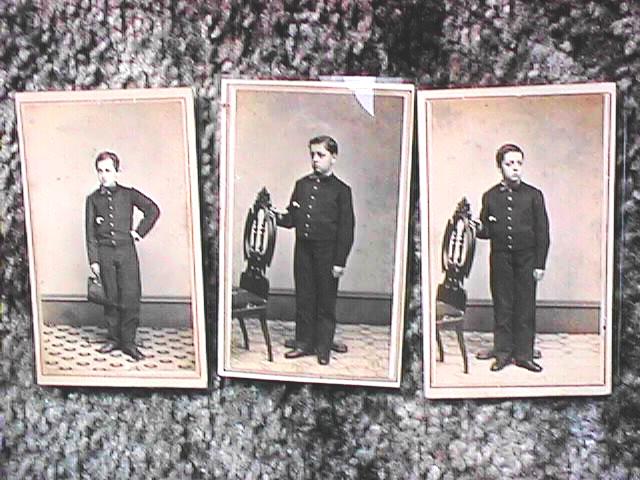
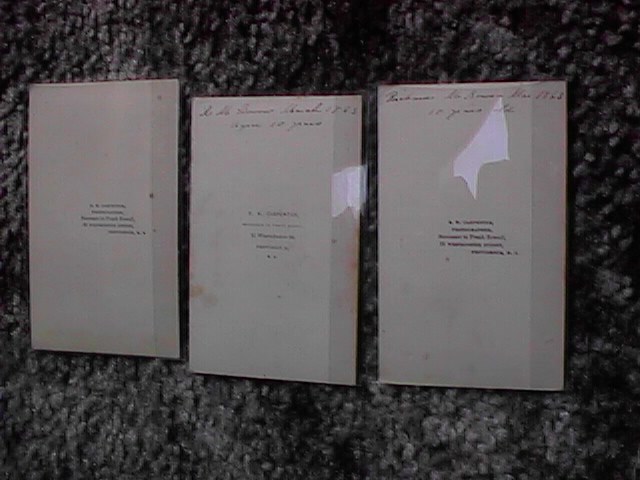
Image 46
Here's an excellent condition CDV of 3 young Acrobats! This card dates to about 1870 or so and is backmarked C. Henkel, Photographer, 1288 Broadway, N.Y. $45.00 item photography 78
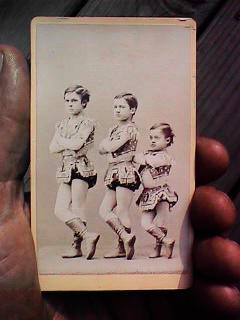
Image 45
This is a nice unmounted full plate tinted tintype of a young gentleman of the 1850's and the 1860's. The look on his face is great. Very sharp for a large tintype! $95.00 item photography 80
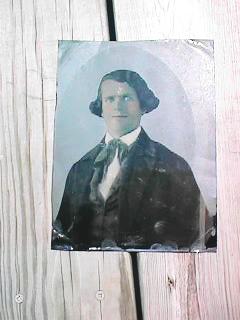
Image 44
This is an old 1/6th plate thermoplastic case showing different fireman scenes on the front. Check out the pics! The case has a few cracks in it on the inside that you can't see on the outside and it's somewhat warped from heat. It also needs a pad on the inside cover but it would look great with an old firefighter photograph in it. The paper inside has the following info on it: Littlefield, Parsons & Col, Manufacturers of Daguerrotype Cases. L.P. & Co. are the sold proprietors and only legal manufacturers of UNION CASES with the embracing Rivited Hinges . Patented October 14, 1856, and April 21, 1857. The Hinges are a little loose o n this case as well. Nice old displayable antique piece! $145.00 item photography 81
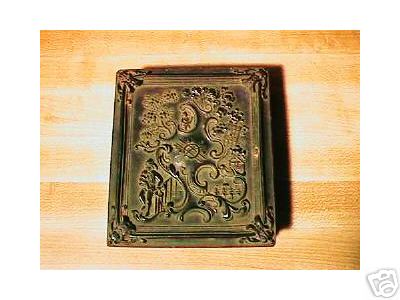
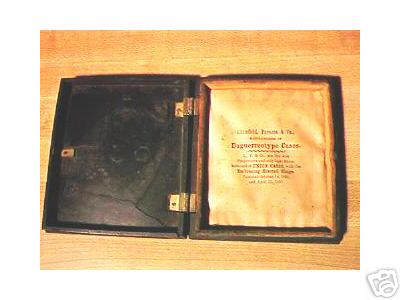
Image 43
Here is a great rare Cabinet Photograph find. This one is real nice. Check out the man standing at his cabinet doors with his beautiful hunting dog and percussion shotgun. This 1800s Rifle man Hunter Dog Gun Photo has great detail with minor edge wear. Overall condition is good for this neat old item. Just an great Photo !! $45.00 item photography 82
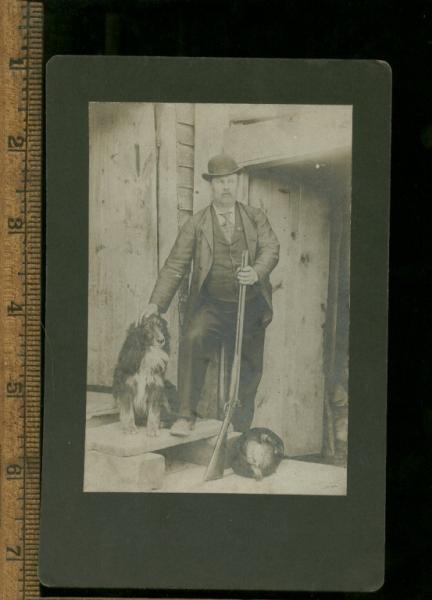
Image 3
38
The next two cdv's are of Lincoln's Vice President Andrew Johnson PRESIDENT JOHNSON CDV SOLD! who took over as president when Abraham Lincoln was assassinated. This is a photoengravure with Andrew Johnson on the bottom. No backmark on this one. The other cdv is an engraving of General Grant and wife. Engravings look just like that while photoengravures look more like photographs. The Johnson CDV is $35 while the Grants cdv is $25.00 item photography 88

Image 37
This is a 13 X 17 inch photo in frame of Lt. General Nelson A. Miles attending a banquet given by the Illinois State Court of the Guarding of Liberty and is dated June 13, 1916. The old general is standing under the large flag at the top of the photo. General Miles was a Medal of Honor Winner! Here's his bio:
One of the most colorful soldiers ever to serve in the United States Army. Although the Indian Wars were over, he would rise still higher, to the top command in the U.S. Army.
It was an impressive ascent from youthful beginnings as a clerk in a Boston crockery store, but still not as high as his ambition dictated. His future career, like his past, would be marred by controversy and endless discord with associates. For in him vanity and ambition powered a fierce competitiveness that drove his to revel tastelessly in his own genuine abilities and successes while minimizing or denying those of others. "Brave peacock," Theodore Roosevelt would call him, not inaccurately.
Unfortunately for his place in history, the image obscured a record of notable achievement. He came to the frontier army in 1866 without West Point credentials but with an extraordinary Civil War record.
Self-education had prepared him for the war. While clerking in Boston, he had attended night school, read deeply in military history, mastered military principals nd techniques, and even paid an old French veteran to teach him to drill. He marched off in 1861 as a First Lieutenant of Massachusetts Volunteers. Courage, leadership, professional knowledge, hard work and ambition brought the young officer to notice of his superiors, and he rose swiftly. By Appomattox, he had made himself a popular hero, four times wounded, veteran of every major battle of the Army of the Potomac except Gettysburg, successful regimental, brigade, division and (briefly) corps commander.
Promotion to Major General of Volunteers came in October 1865 and three brevet promotions covered him with further honors. Not only was he a genuine hero, he looked like one. Tall, muscular, broad-shouldered, well-proportioned, with intense blue eyes and a jaunty mustache, he made a dashing figure in his blue and gold uniform with starred shoulder straps and chest full of brass buttons.
He was 26 years old. He had found his calling. He wanted to be a career soldier and his record in the Volunteer Service assured him a commission in the post-war regular army. He sought a brigadier's star, a presumptuous goal in the shrunken peacetime army, even for one of his conspicuous attainments. The colonel's eagles that he accepted with bad grace represented a higher rank than others with even greater distinction and seniority could win. Even this distinction cam not solely in recognition of his wartime services. He had learned one of the truths of his times: ability helped, but high-level influence was vital. He enlisted the support of an imposing roster of military and political luminaries in behalf of his candidacy, and his colonel's commission owed as much to this as to his war record. He would become one of the army's most ardent practitioners of influence peddling. Marriage appeared to enhance his possibilities, although it is unlikely that cynicism formed part of that motivation.
On June 30, 1868, he married Mary Hoyt Sherman, whose uncles were Ohio Senator John Sherman and Army Major General William Tecumseh Sherman. Less than a year later, with the inauguration of Ulysses S. Grant as President of the United States, Sherman became General-in-Chief of the Army. At once, Miles began to importune his wife's uncle for official favors. Until 1883, when he stepped down as leader of the Army, Sherman stubbornly fended off these efforts.
As early as 1888, California interests had advanced Miles' name for the presidency, and throughout the 1890s he doubtless had no more difficulty visualizing himself as President than he had in 1876, a frontier Colonel, as Secretary of War. In truth, neither major party ever seriously considered him a serious nominee. In 1895, he did attain the top command of the Army, successor to Washington, Scott, Grant, Sherman and Sheridan, but his term was filled with frustration.
In the Spanish-American War, William McKinley denied him any real authority and relegated him to command an almost unnoticed expedition against Puerto Rico. Instead of glory, he gained uncomplimentary notice from a bitter public quarrel with the Secretary of War and a ruthless, unjust attack on the Commissary General of the Army in the scandal over "embalmed beef."
Even his elevation in 1901 to the newly restored grade of Lieutenant General brought only small satisfaction. Almost at once he earned the displeasure of Theodore Roosevelt by taking sides in a feud between admirals and by criticizing U.S. policy in the Philippines. He also opposed the long-overdue reform of the War Department, which called for converting the Commanding General to a Chief of Staff. Finally, when he reached the mandatory retirement age of 64 in 1903 and stepped down as the last Commanding General in the Army's history, the President declined to send the customary congratulatory message, and the Secretary of War did not attend the retirement ceremonies.
He lived out his remaining years quietly in Washington, D.C. World War I brought persistent application for active duty, but they were politely turned aside. No longer a center of controversy, he became a venerable figure out of the past, a reminder of the war to save the Union, out of the old army, and of the frontier West that he played such a glorious part in opening to settlement.
The end, at the age of 85, could not have been more fitting. In the spring of 1925, he took his grandchildren to the circus. The band played the National Anthem. Standing erectly at attention, rendering the military salute to the flag, he collapsed with a heart attack. The burial at Arlington National Cemetery featured the impressive ceremonial homage he would have considered his due. He might have also felt a small sense of vindication in the gravesite attendance of President Calvin Coolidge. He is buried in Section 3 in one of only two mausoleums in Arlington National Cemetery (the other in Section 1 belongs to General Thomas Crook Sullivan). Another connection with Arlington was that Miles was the Grand Marshall at the dedication of the Memorial Amphitheater, which was held in 1920.
He was born on August 8, 1839 near Westminister, Massachusetts. He was commissioned as Captain of the 22nd Massachusetts Volunteer Infantry at the outbreak of the Civil War. His baptism of fire came while serving in General Oliver O. Howard's staff at Fair Oaks (Seven Pines), May 31, 1862, after which his bravery earned him promotion to Lieutenant Colonel. He was promoted to Colonel after assuming command of his regiment in the midst of the battle of Antietam (Sharpsburg), September 17, 1862. Distinguished himself and was himself seriously wounded at Fredericksburg, December 13, 1862, again at Chancellorsville, May 2-4, 1863. For his actions at the latter he won, as of March 1867, Brevet to Brigadier General and even later, in 1892, the Medal of Honor. He was present at nearly every major engagement of the Army of the Potomac.
Appointed Brigadier General of Volunteers in May 1864 and commanded a Division in the final campaign at Petersburg, Virginia. In October 1865, at the age of 26, was named Major General of Volunteers in command of II Corps. As commandant of Fort Monroe, Virginia, after the war, he became the custodian of Jefferson Davis, and for keeping him shackled in his cell, was the target of severe public criticism, even in the North. In July 1866 was appointed Colonel in the regular army and in March 1869 was commander of the 5th U.S. Infantry. His subsequent service on the Western frontier was dedicated and courageous during recurring hostilities with the Indians. Achieved victories against Cheyenne, Comanche, Kiowa and Arapaho on the Staked Plains of Texas in 1874-75, notably the victory of Colonel Ranald S. MacKenzie at Palo Duro Canyon, September 24, 1874, and later was instrumental in driving the Sioux under Sitting Bull into Canada nd pacifying those under Crazy Horse. He captured Chief Joseph in 1877 after the Nez Perces incredible march toward sanctuary in Canada, and the following year pacified the Bannocks under Chief Elk Horn near Yellowstone. Promoted to Brigadier General in December 1880, he commanded the Department of the Columbia until 1885 and the Department of the Missouri in 1885-86, and in April 1886 succeeded General George Crook as the commander of the Department of Arizona, where he succeeded in September in finally capturing the elusive Apache leader, Geronimo. He commanded the Department of the Pacific at San Francisco in 1888-90, receiving promotion to Major General in April 1890. In the last uprising of the Sioux in South Dakota in late 1890, during which Sitting Bull was killed, he restored U.S. control over the Indians, but his reputation was permanently tarnished by the massacre of some 200 Sioux, including women and children, by troops under the command of Colonel James W. Forsyth (7th U.S. Cavalry) at Wounded Knee, South Dakota, on December 29, 1890. In 1894, while commanding the Department of the Missouri, was responsible for the Federal troops employed in the suppression of the Pullman strike disorders in Chicago. Was placed in command of the Department of the East, with headquarters at Governors Island, New York in 1894, and on the retirement of John M. Schofield be became on October 5, 1895 the Army's Comander-in-Chief. His role in the Spanish-American War was mostly administrative, although the did conduct an expedition to Puerto Rico, landing on July 25, 1898, and campaigning until August 13. In February 1901 he was promoted to Lieutenant General. Late in that year he was reprimanded for having commented publicly on Admiral George Dewey's report on charges against Winfield Scott Schley. In 1902, on his return from an inspection trip in the Philippines, he aroused controversy with his criticism of the conduct of certain U.S. officers there. Author of "Personal Recollections and Observations of General Nelson A. Miles," in 1896, and "Serving the Republic," in 1911.
MEDAL OF HONOR WINNER
--------------------------------------------------------------------------------
MILES, NELSON A.
Rank and organization: Colonel, 61st New York Infantry. Place and date: At Chancellorsville, Virginia, 2_3 May 1863. Entered service at: Roxbury, Massachusetts. Birth: Westminster, Massachusetts. Date of issue: 23 July 1892.
Citation:
Distinguished gallantry while holding with his command an advanced position against repeated assaults by a strong force of the enemy; was severely wounded.
--------------------------------------------------------------------------------
This photo and frame of the Famous General is complete and in very good condition. $85.00
item photography 90
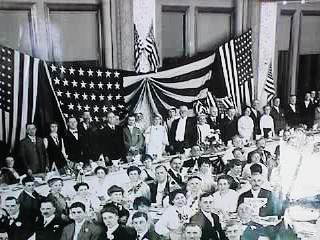
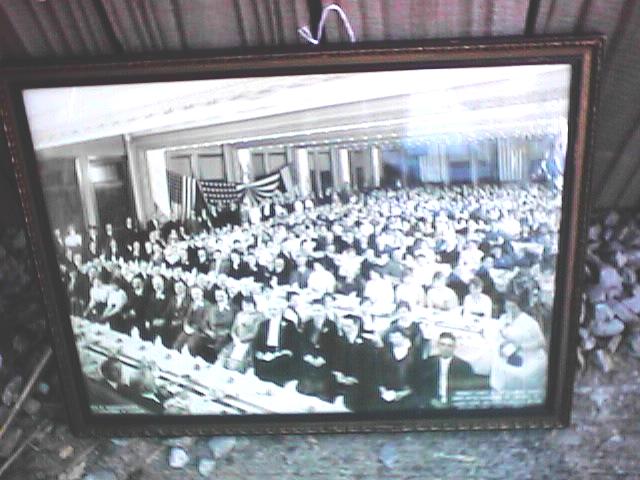
Image 36
sold
Nice cabinet card image of a young Indian wars soldier or Spanish American War soldier. He's in full uniform and holding his 45/70 rifle w/bayonet on. He's also shown with his US Hagner belt place on. It's somewhat faded with age but not bad at all. The photographer is noted on the the bottom of the front as "O.M. Harness, Sheridan, Ind." The back is blank. Nice Indiana Image! $45.00 item photography 91
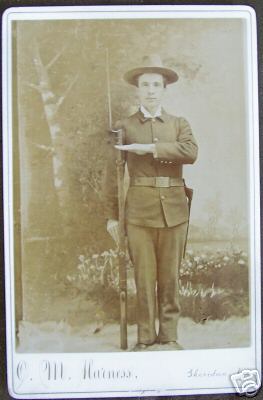
Image 35
This is a very nice studio photo of 5 soldiers. They are Indian War era soldiers. One is tipping up a bottle of whatever (probably whiskey!) to pour into a glass. Nice subject! Clear! Housed in a album page. $125.00 item photography 92
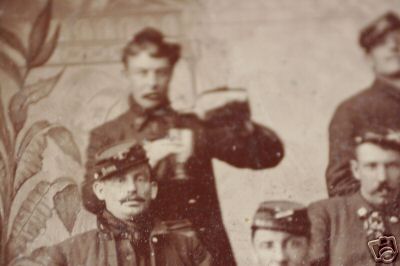
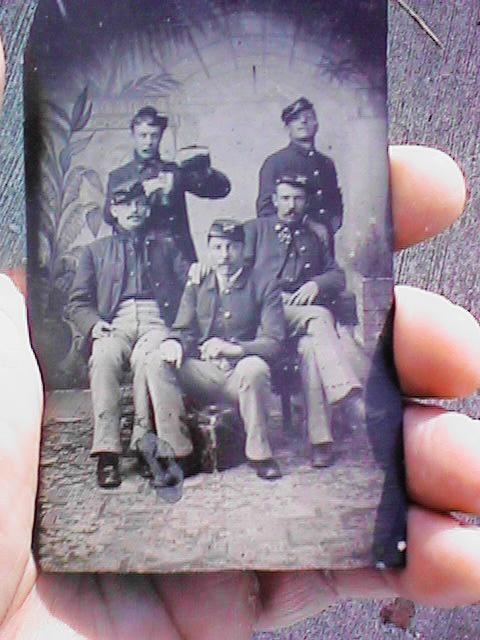
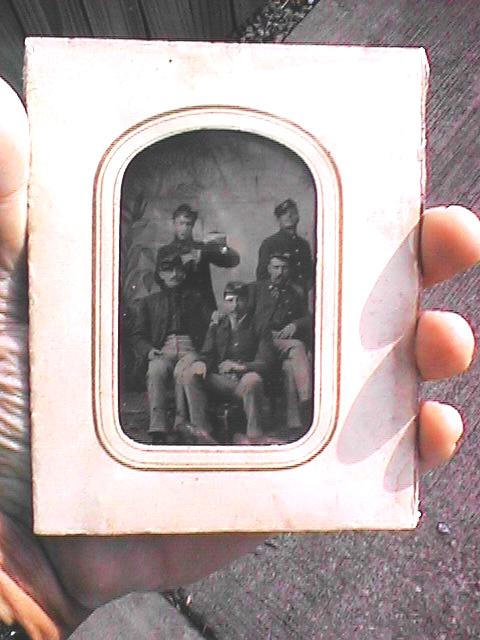
Image 34
This is a very nice 1850's gutta percha daguerrotype case with an ambrotype inside of a young girl. The photo is best seen in the light but is pretty nice and the ornate brown case is in excellent condition measuring 2 1/2 X 3 inches. Inside the case is written 'Presented to Eugene Jones by his cousin Maria Myers Lancaster Ohio March the 12th, 1858'. Nice and early!!! $125.00
item photography 93
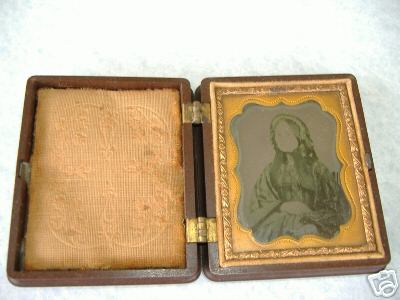
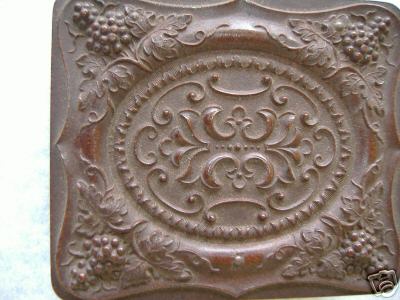
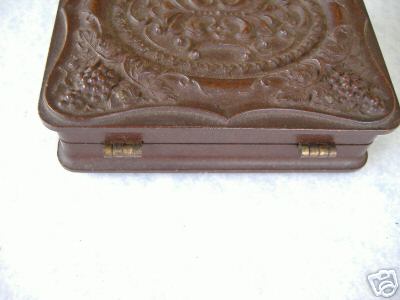
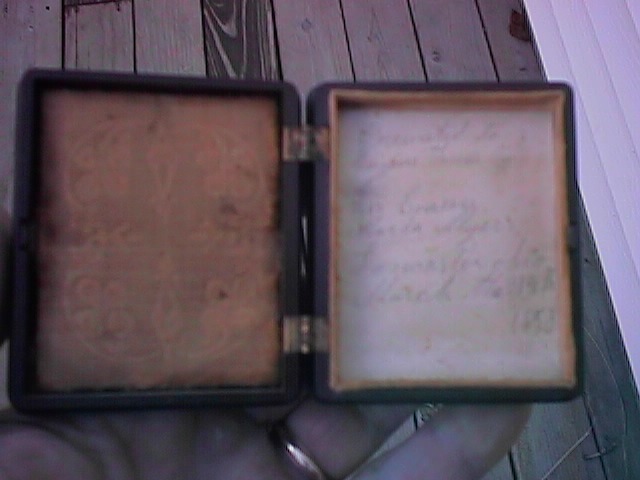
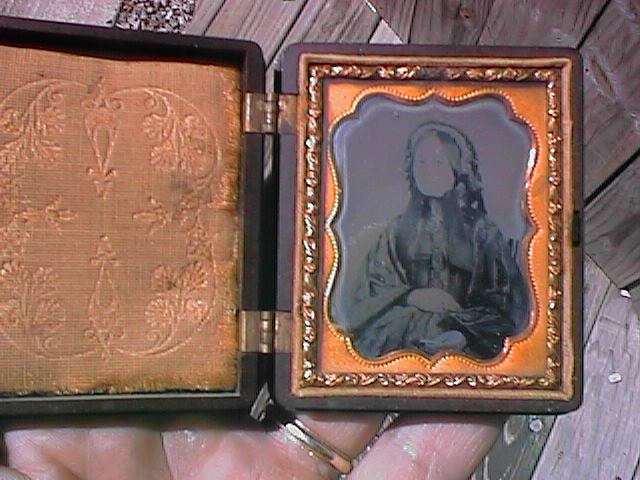
Image 32
This is an outstanding tintype from the Gettysburg area of Civil War Police Officers or possibly Provost Marshals. They are wearing Uniforms and could be either. This is a 1/6th plate size tintype with the usual bends. Very nice image! $165.00 item photography 95
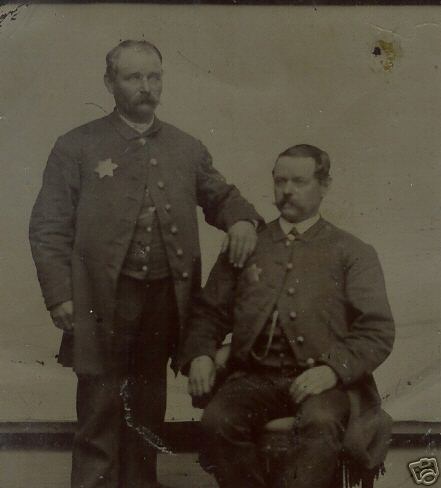
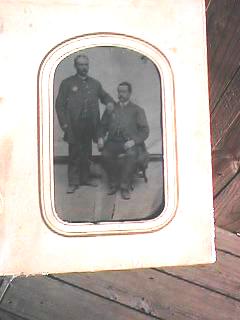
Image 31
This image from Gettysburg is a very unusal image but I've not been able to tie it in to Gettysburg.. The image is a 1/6th plate tintype showing a shoe shop! You know fighting reportedly started at Gettysburg because Confederate Soldiers were going to town to raid a shoe shop! The image has on the top of the building 'SAMONS' ' BOOT AND SHOE SHOP' ! The image looks much better than my camera can pick up. The image is kind of silver in nature but it is a tintype. There are 2 guys standing on the porch of the shoeshop and a lady standing out front to the left. Hard to find image! $425.00 item photography 97
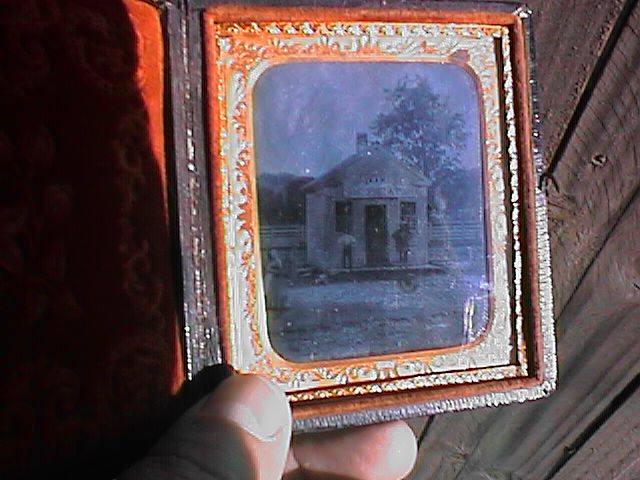
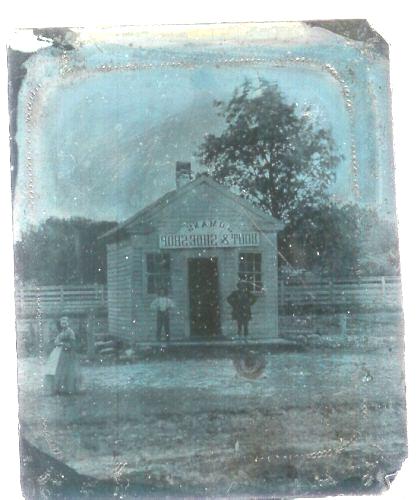
Image 30
This 1/6th plate ambrotype on glass is from the Thorntown, Indiana area. This is an excellent image of a young woman that is fairly so attractive. She wears a bonnet and sits in a chair. Inside the case is written 'Ambrotype of Sarah E. Blanchard taken march the first 1860 - aged 22 yrs. Comes in a full case with repaired spline. Excellent quality! $85.00 item photography 98
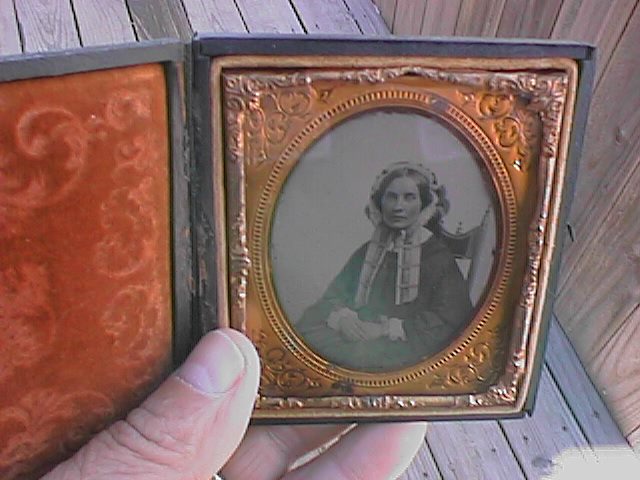
We have picked up several very nice stereo-optic cards from the late 1800's thru early 1900's. Each card is $3 unless otherwise noted. Thanks!
Image 29
Here's a great stereo card with just a little damage to the outside left of the image on the left. This one is entitled 'Worshippers before an image in the exqauisitely carved Temple of Vimala Sah, Mount Abu, India. Copyright 1902 by Underwood and Underwood. The reverse of the card has all the information on this temple. Nice! item photography 99
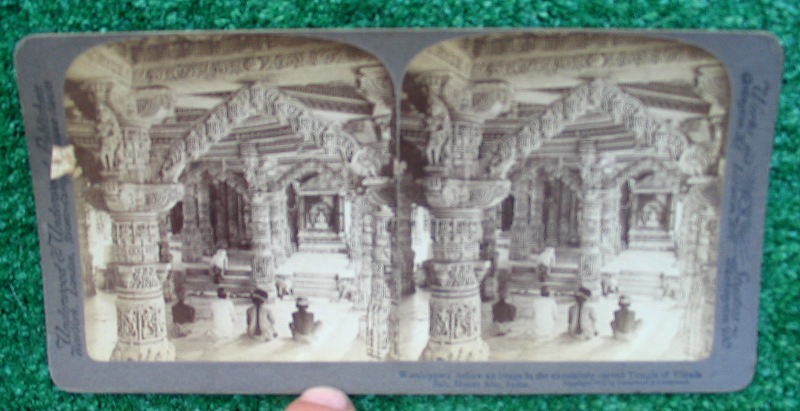
Image 28
Trente et Quarente Salon, Monte Carlo, Monaco, Copyrifht 1897 by Underwood and Underwood. Titles on the back in several languages. Good Condition! item photography 100
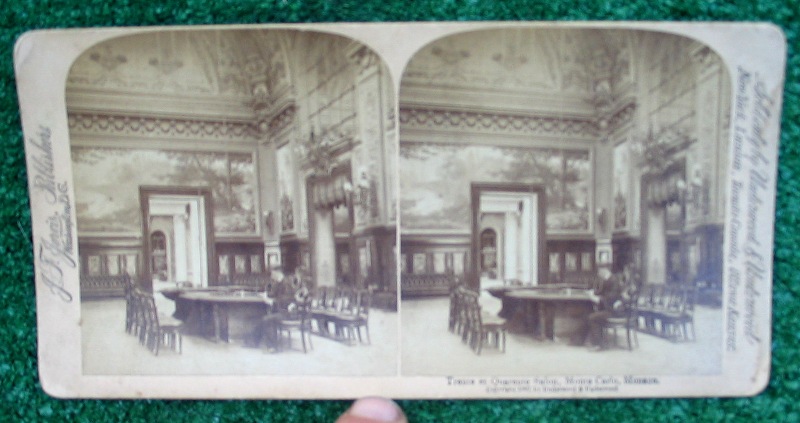
Image 27
Rock of Ages-The Rescue, copyright 1895 by Littleton View Co. with the title on the back in several languages. item photography 101
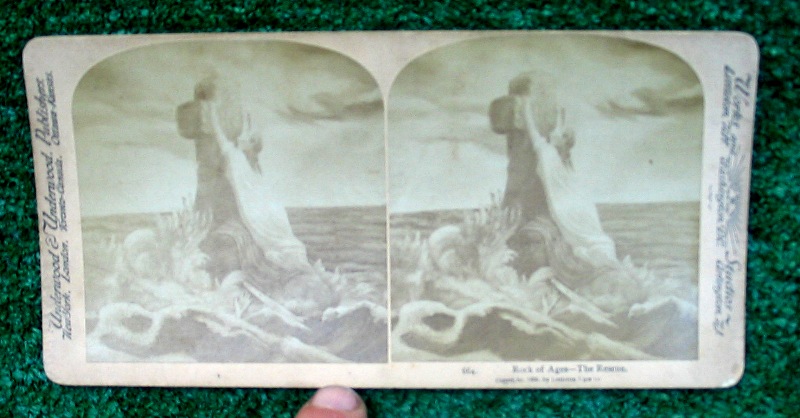
Image 26
Here are 2 cards for one money that I like to call 'mean women!'. One of them has an old repair and is damaged. The other is fine. There is a date in pencil on the back of one that is 1897. Looks like one woman knocked the man out of a chair! Meany! Sold by Griffith & Griffith but no other explanation on them. item photography 102
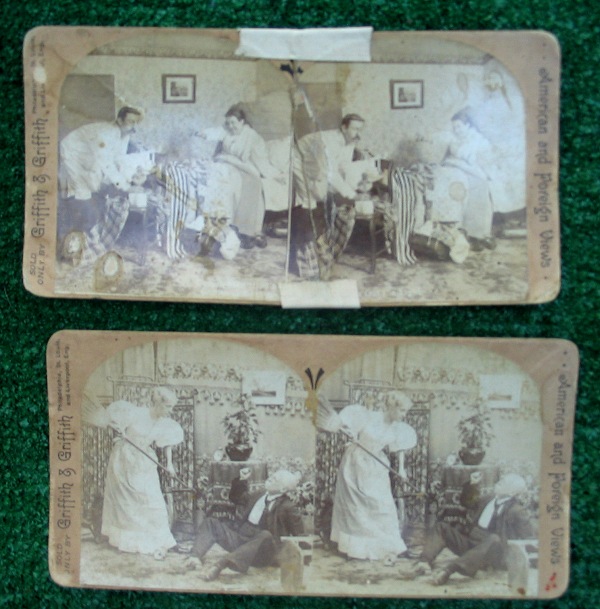
Image 25
This card is entitled 'This parting gives me pain, dear.' copyright 1899 by Strohmeyer & Wyman. Good Card. item photography 103
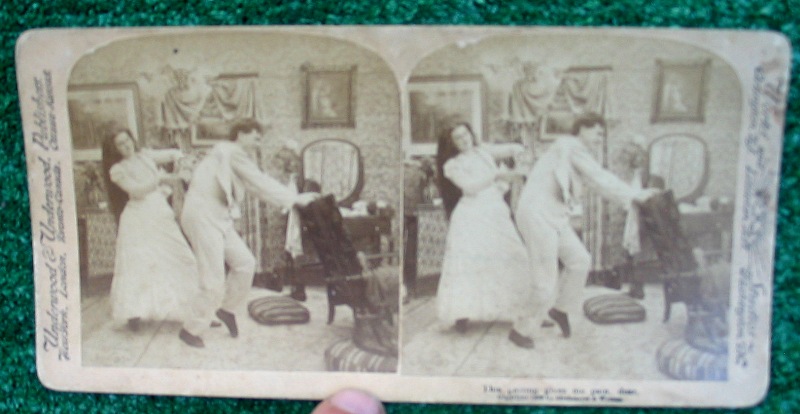
Image 24
This card is entitled 'The Victorial Saloon, Royal Palace, Stockholm, Sweden.' copyright 1897 by Underwood and Underwood. The title is on the reverse in several languages. Nice. item photography 104
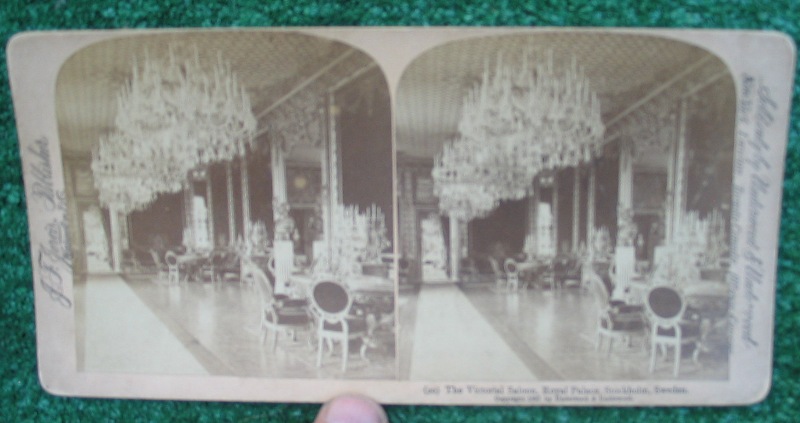
Image 23
This card is entitled 'Gossip-At every Sip a Reputation Dies'. Copyright 1899 by Strohmeyer & Wyman. Nice one. item photography 105
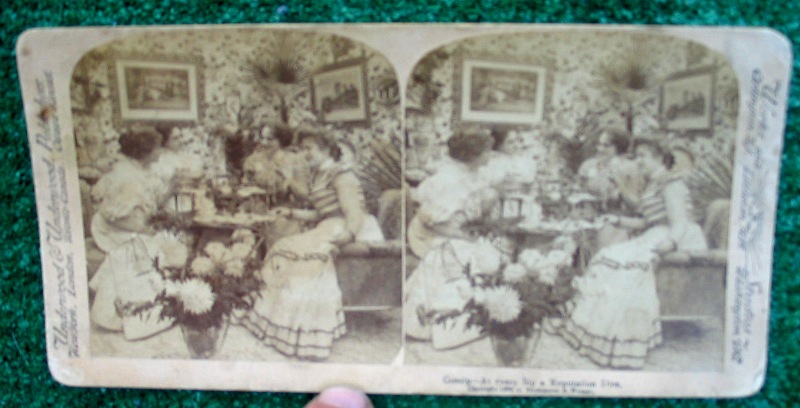
Image 22
This card is entitled 'Broad Street, north to the Stock Exchange, U.S. Sub-Treasure and Wall Street, New Yorkk. Copyright 1903 by Underwood and Underwood. Nice! item photography 106
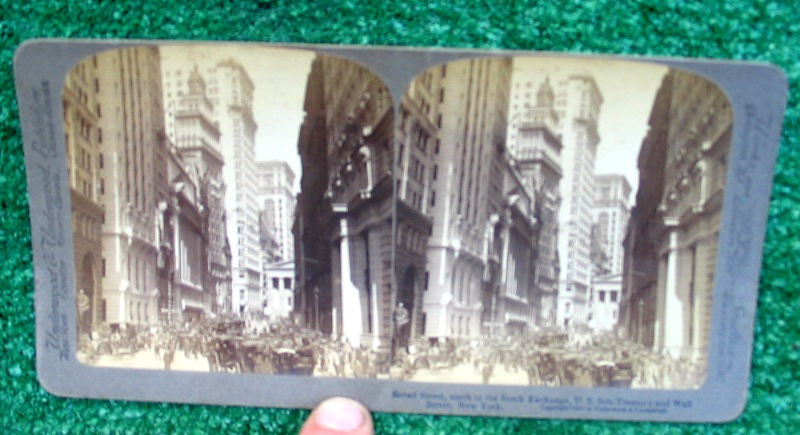
Image 21
Here's another good one entitled 'The Fountains from Peterhof Palace, The Summer Residence of the Czar of Russia,. Copyright 1897 by Underwood and Underwood. Title is in several different languages on the reverse. item photography 107
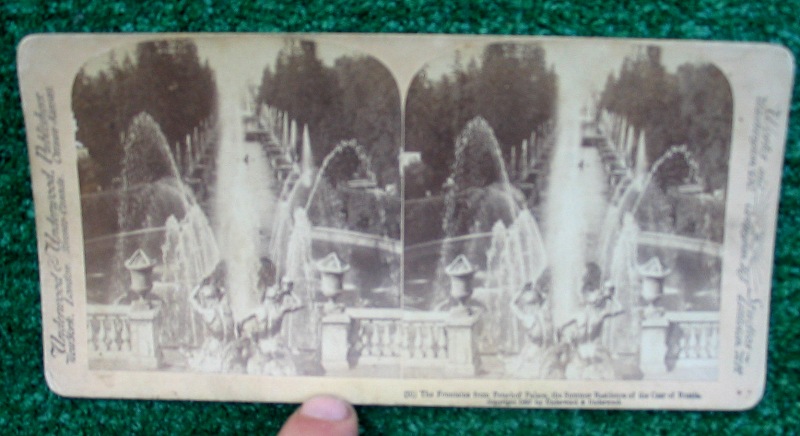
Image 20
This one has a corner broke off it but the subject material is great! Shows a dog with his hunter master and shotgun surrounded by several Grouse! This card is entitled 'A Morning with Rover and the Grouse. Copyright 1893 by Geo. Barker. The break doesn't touch the image. Titles on back item photography 108
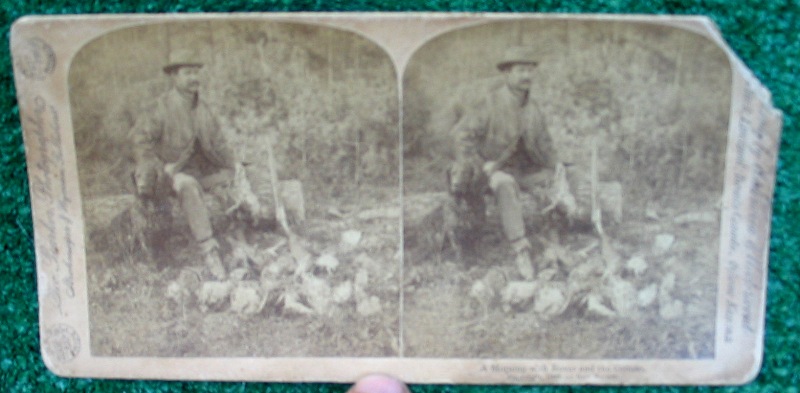
Image 19
This next card is a great one entitled 'In the Great Union Stock Yards, Chicago, U.S.A. Copyright 1893 by Underwood and Underwood. Titles on back. Very nice! item photography 109
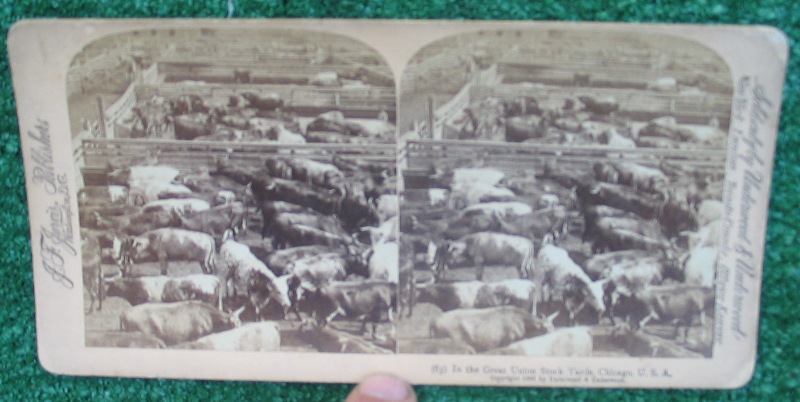
Image 18
Here's one entitled 'Looking through Eiffel Tower to Chateau d'Eau from Trocadero Palace, Exposition 1900, Paris France. Copyright 1900 by Underwood & Underwood. This is a nice card with a couple of smaller waterspots not affecting the image. I can see a Ferris Wheel in the background! item photography 110
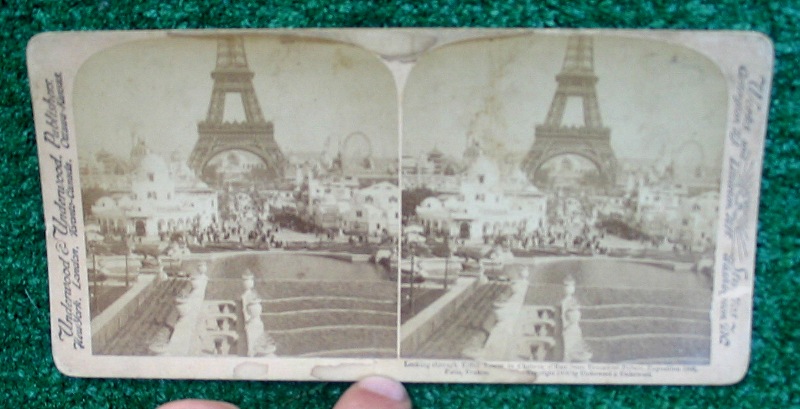
Image 17
This is a nice card entitled 'Lock Katrine, Scotland'-"The spot an Angel deigned to grace." Copyright 1899 by Strohmeyer and Wyman. Shows a Steamship passing by. item photography 111
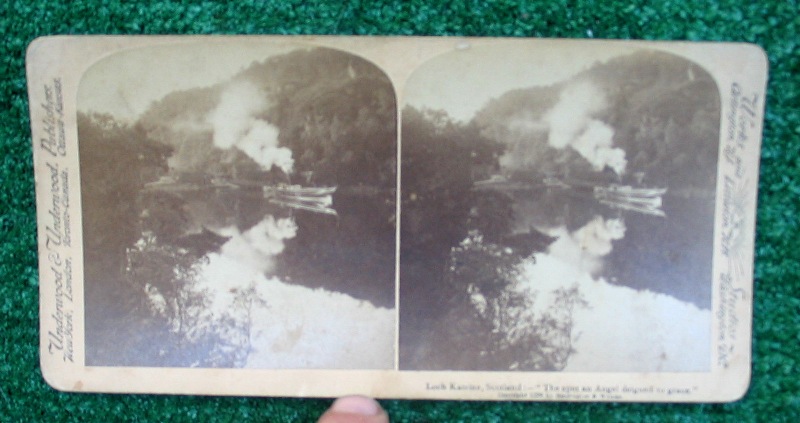
Image 16
Here's a funny card entitled 'He Don't Like His Pants.' Copyright 1891, by Littleton View Co. Titles on back. The little girl is grinding down his pants for him! Lots of nice toops and a boot in the photograph. Slightly light. 112
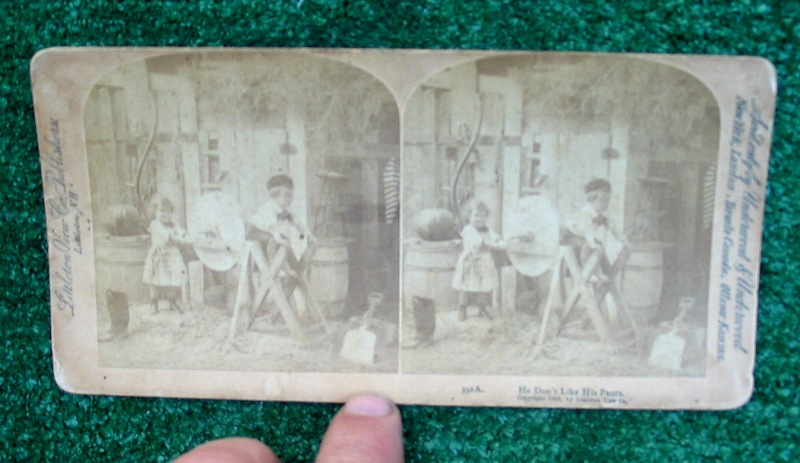
Image 15
Here's a card entitled 'They all do it. Diversos entretenimientos.' Looks like 2 folks in black face sitting below 2 kids looking down from above. Nice but soiled. item photography 113
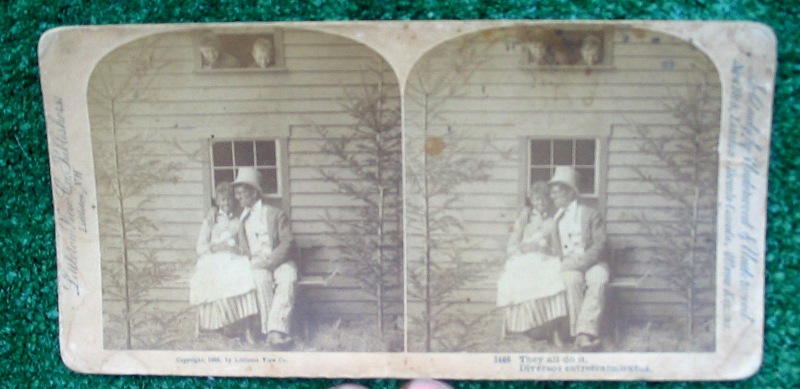
Here's an excellent card entitled 'At Oxford University, Britain's most famous seat of learning-showing Mary Magdalen College, Oxford, England.' Copyright 1902 by Underwood and Underwood. item photography 114
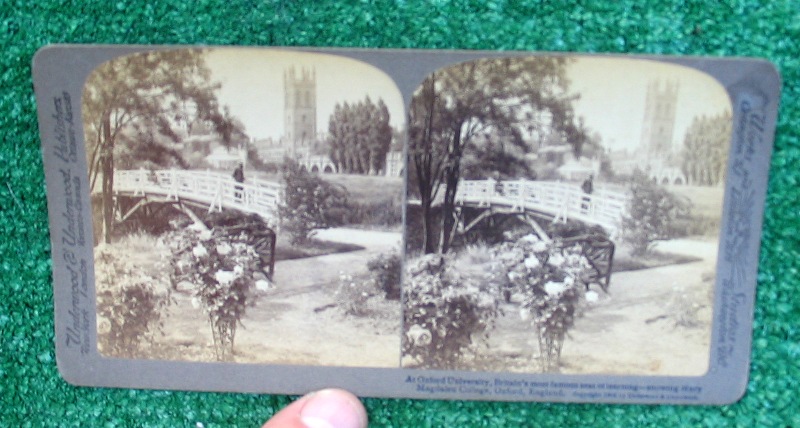
Image 14
Here's another excellent card entitled 'Cliff House and Seal Rocks from the Beach-showing the tide coming in, San Francisco, Cal'. Copyright 1902 by Underwood & Underwood. This excellent card shows a team of horses on the beach and of course, the famous Cliff House! item photography 115
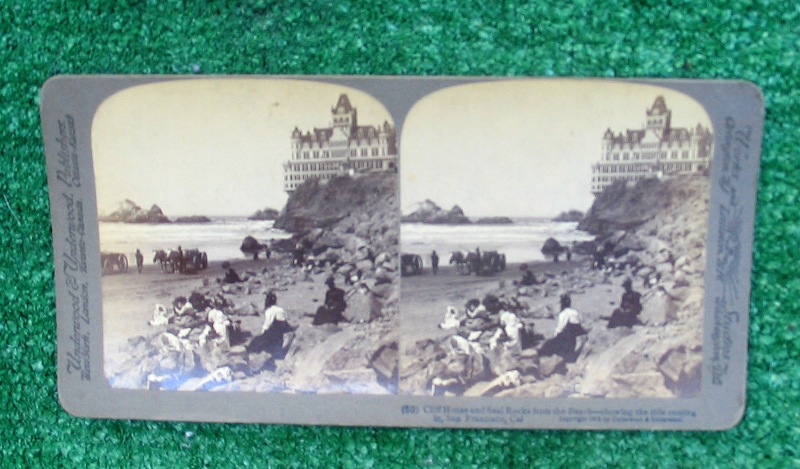
Image 13
Here's a Women's Liberation Movement card that shows a man washing clothes and tending to the children while his wife is dress up for going out and is pointing her finger at him, probably giving him some last minute directions. Obviously 'Laying Down the Law!" Some things don't change! Copyrighted 1895. item photography 116
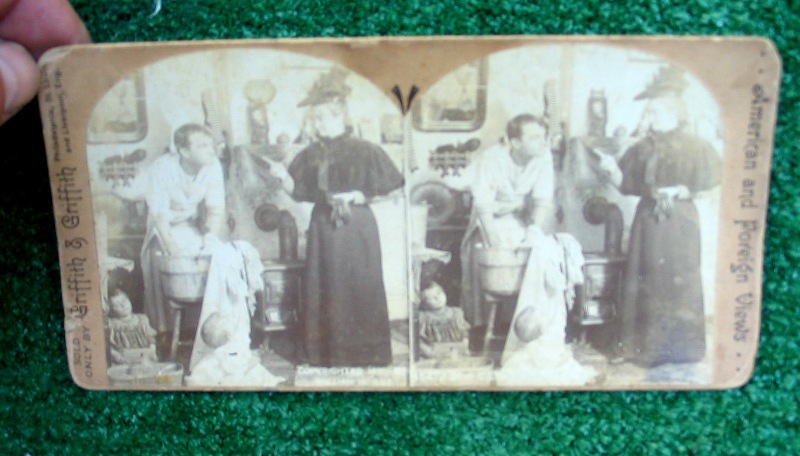
Image 12
Here's a great one here. This is a card of the Liberty Bell. This one is titled 'Independence Bell, which first proclaimed Freedom, as "government by the people,"-Philadelphia. Copyrighted 1902 by Underwood & Underwood. Nice! You can even see the crack! item photography 117
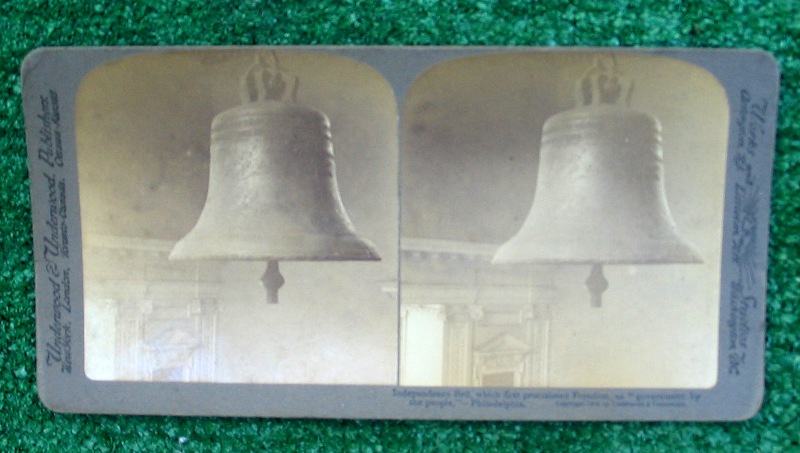
Image 11
This is an outstanding card entitled 'The Pets'-on a western stock farm, Kansas, Copyright 1903 by Underwood & Underwood. Little girl sitting on a steer holding her kitten. Warm and Wonderful! item photography 118
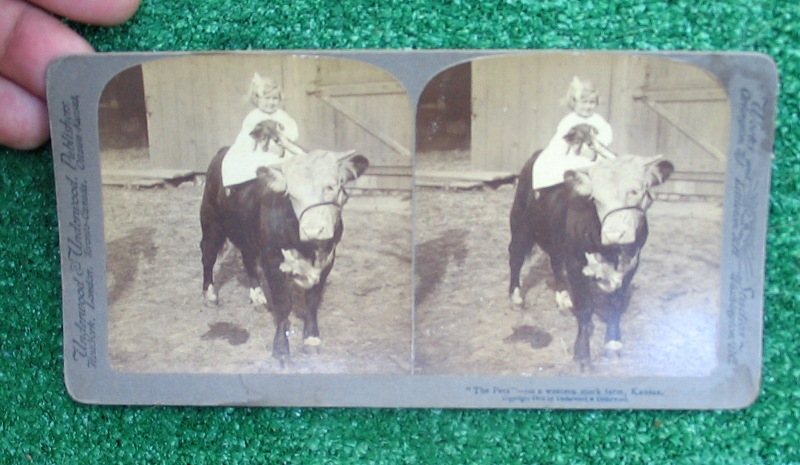
Image 10
Here's 2 cards that need to stay together and I'll take $5 for the pair. These cards are copyright 1896 by Griffith & Griffith and are entitled 1. Love on a Tub and 2. Love in a Tub Early humor! In card 2. you can see the tub is on a wooden box entitled 'Pettijohn's California Breakfast Food' 'Minneapolis, Minn'. I'd like to have that box! item photography 119
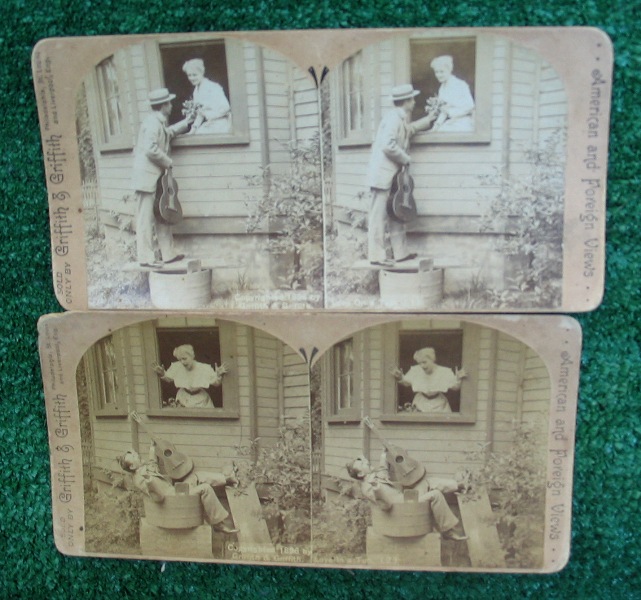
Image 9
Heres something I found of interest. This is a stereoptic card copyright 1900 showing a Pontoon Bridge built by Royal Engineers across the Modder in South Africa. What is so interesting is that it's very similiar to what the Corps of Engineers did during the Civil War. This is a nice card being somewhat light but still easily seen. by Underwood and Underwood. $10.00 item photography 110
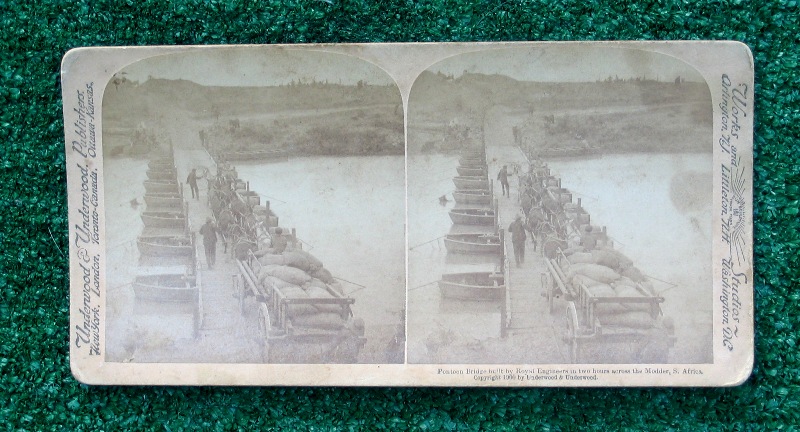
Image 8
Here's another stereo card that is in outstanding condition. This is a battle scene from the Spanish American War showing American troops firing their firearms! The caption is entitled 'Heroic Washington Volunteers advancing-Fillipinos 800 yards in fron-Taguig, Philippines'. Copyright 1899 by Underwood and Underwood. The back of the card is filled with information about the photos on the front. A little of it is:'This is an old rice field near Taguig, about ten miles S.E. of the city of Manila. You are seeing a moment of actual fighting-not any mere tableau, but serious business-the real thing as it was going on March 20, 1899.' The rest of the back is filled with interesting facts! Very nice card! $35.00 item photography 111
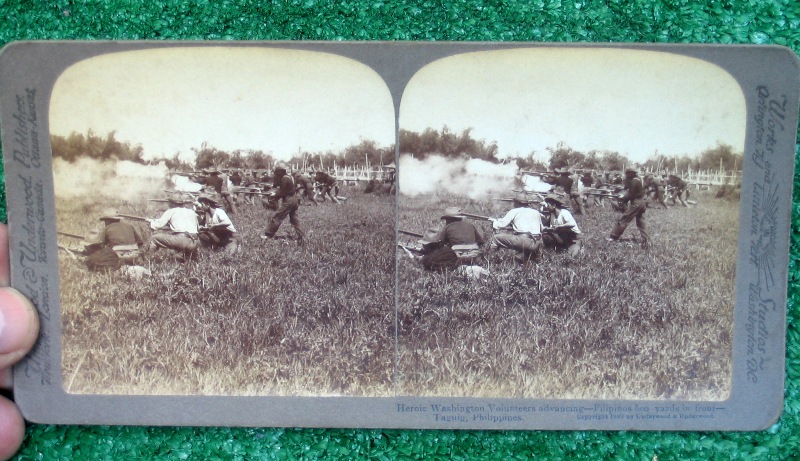
Image 7
These next 3 cards and book are all one lot and definitely belong together. These all have to do with President McKinley, the last Civil War Veteran to be President of the United States, and are titled as such:
1. President McKinley at his desk in the White House. Washington, U.S.A. - copyright 1898 by Strohmeyer and Wrman. Good Condition
2.Inaugural Parade, Mar. 4, 1897 by Griffith & Griffith, Philadelphia. This one is iin good condition showing troops marching down the street with rifle muskets over their shoulders. They are wearing their spiked Army helmets and uniforms. Outstanding!
3. Mrs. McKinley in the Conservatory of the Executive Mansion, Washington, U.S.A. Copyright 1900 by Underwood and Underwood. Very nice card.
William McKinley, Jr. (January 29, 1843 – September 14, 1901) was the 25th President of the United States, and the last veteran of the American Civil War to be elected to the office. He was the last president to serve in the 19th century and the first to serve in the 20th. The President McKinley grouping includes a book entitled MEMORIAL LIFE OF WILLIAM McKINLEY-OUR MARTYRED PRESIDENT and 3 stereo optic cards of the period. The book is in good condition with some spline separation and loads of photos! This book was written after his assassination in 1901 by Col. G.W. Townsend and is a first edition. This book is loaded with tons of photos and engravings of even the Funeral proceedings. 512 pages. No foxing. Also included is stereo optic cards of President McKinley at his desk in the White House copyright 1898 , the Inaugural Parade March 4th, 1897 showing many soldiers in parade formation. and lastly, Mrs. McKinley in the Conversatoryof the Executive Mansion, Washington D.C.copyright 1898. These cards are in excellent condition. Here's the Presidents Bio: WILLIAM MCKINLEY 1897-1901 At the 1896 Republican Convention, in time of depression, the wealthy Cleveland businessman Marcus Alonzo Hanna ensured the nomination of his friend William McKinley as "the advance agent of prosperity." The Democrats, advocating the "free and unlimited coinage of both silver and gold"--which would have mildly inflated the currency--nominated William Jennings Bryan. While Hanna used large contributions from eastern Republicans frightened by Bryan's views on silver, McKinley met delegations on his front porch in Canton, Ohio. He won by the largest majority of popular votes since 1872. Born in Niles, Ohio, in 1843, McKinley briefly attended Allegheny College, and was teaching in a country school when the Civil War broke out. Enlisting as a private in the Union Army, he was mustered out at the end of the war as a brevet major of volunteers. He studied law, opened an office in Canton, Ohio, and married Ida Saxton, daughter of a local banker. At 34, McKinley won a seat in Congress. His attractive personality, exemplary character, and quick intelligence enabled him to rise rapidly. He was appointed to the powerful Ways and Means Committee. Robert M. La Follette, Sr., who served with him, recalled that he generally "represented the newer view," and "on the great new questions .. was generally on the side of the public and against private interests." During his 14 years in the House, he became the leading Republican tariff expert, giving his name to the measure enacted in 1890. The next year he was elected Governor of Ohio, serving two terms. When McKinley became President, the depression of 1893 had almost run its course and with it the extreme agitation over silver. Deferring action on the money question, he called Congress into special session to enact the highest tariff in history. In the friendly atmosphere of the McKinley Administration, industrial combinations developed at an unprecedented pace. Newspapers caricatured McKinley as a little boy led around by "Nursie" Hanna, the representative of the trusts. However, McKinley was not dominated by Hanna; he condemned the trusts as "dangerous conspiracies against the public good." Not prosperity, but foreign policy, dominated McKinley's Administration. Reporting the stalemate between Spanish forces and revolutionaries in Cuba, newspapers screamed that a quarter of the population was dead and the rest suffering acutely. Public indignation brought pressure upon the President for war. Unable to restrain Congress or the American people, McKinley delivered his message of neutral intervention in April 1898. Congress thereupon voted three resolutions tantamount to a declaration of war for the liberation and independence of Cuba. In the 100-day war, the United States destroyed the Spanish fleet outside Santiago harbor in Cuba, seized Manila in the Philippines, and occupied Puerto Rico. "Uncle Joe" Cannon, later Speaker of the House, once said that McKinley kept his ear so close to the ground that it was full of grasshoppers. When McKinley was undecided what to do about Spanish possessions other than Cuba, he toured the country and detected an imperialist sentiment. Thus the United States annexed the Philippines, Guam, and Puerto Rico. In 1900, McKinley again campaigned against Bryan. While Bryan inveighed against imperialism, McKinley quietly stood for "the full dinner pail." His second term, which had begun auspiciously, came to a tragic end in September 1901. He was standing in a receiving line at the Buffalo Pan-American Exposition when a deranged anarchist shot him twice. He died eight days later.
For Everything $95.00 item photography 112
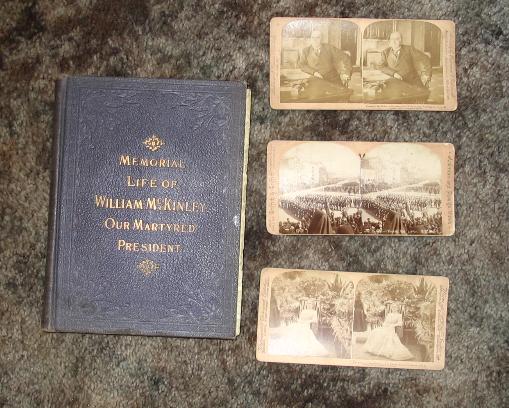
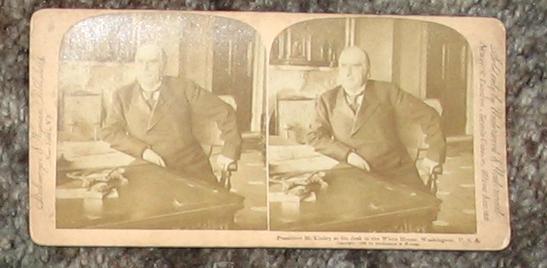
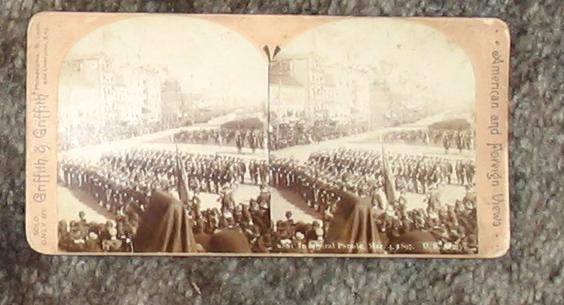
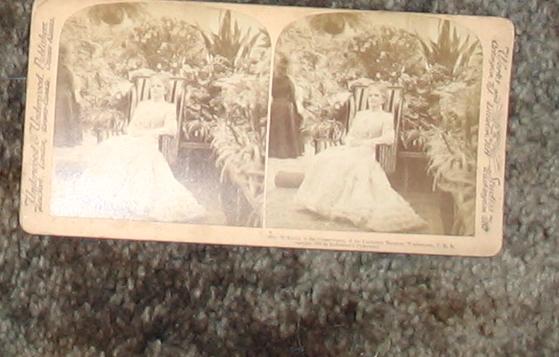
Image 5
This is an original 1925 movie poster promoting a film Commemorating the 50th Anniversary of the Battle at Light Big Horn! The poster states: COMING!! THE MIGHTY EPIC SPECTACLE OF THE OLD-TIME WEST CUSER'S LAST FIGHT COMMEMORATING THE 50TH ANNIVERSARY OF THE BATTLE AT LITTLE BIG HORN - A THOMAS H. INCE SPECIAL PRODUCTION - THE GREATEST INDIAN FRONTIER SPECTACLE EVER SHOWN - DEDICATED TO THE SPIRIT OF THE AMERICAN PIONEER - FAMOUS INDIAN UPRISING IN 1876 UNDER THE BLOODTHIRSTY SITTING BULL - TAKEN IN THE BLACK HILLS. OVER A YEAR IN THE MAKING (COPYRIGHT 1925) WILL BE SHOWN AT" The date space is blank as this poster was never used. At the bottom of the poster is "Hurd of Harvey in Iowa, Show Printer". There is a little crinkling at the bottom of the poster that will be covered up when matted. The entire poster measures a whopping 14 X 22 inches and will look outstanding framed and hanging on your wall! This would be a great addition to either a General George Custer collection or to a movie poster collection! Guaranteed Original! $250.00 item photography 115
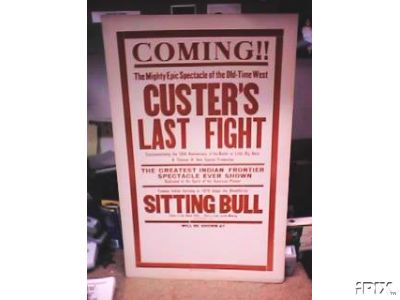
Image 4
This is a stereoscope card featuring William Jennings Bryan and his wife. This one is copyrighted 1897 by B.L.Lingley. William Jennings Bryan had quite a history! Here's his bio:
William Jennings Bryan (March 19, 1860 – July 26, 1925) was an American politician in the late-19th and early-20th centuries. He was a dominant force in the liberal wing of the Democratic Party, standing three times as its candidate for President of the United States (1896, 1900 and 1908). He lost, each time by a bigger margin. He served in Congress briefly as a representative from Nebraska and was the 41st United States Secretary of State under President Woodrow Wilson, 1913-1916. Bryan was a devout Presbyterian, a supporter of popular democracy, an enemy of gold, banks and railroads, a leader of the silverite movement in the 1890s, a peace advocate, a prohibitionist, and an opponent of Darwinism on religious grounds. With his deep, commanding voice and wide travels, he was one of the best known orators and lecturers of the era. Because of his faith in the goodness and rightness of the common people, he was called "The Great Commoner." In the intensely fought 1896 and 1900 elections, he was defeated by William McKinley but retained control of the Democratic Party. With over 500 speeches in 1896, Bryan invented the national stumping tour, in an era when other presidential candidates stayed home. In his three presidential bids, he promoted Free Silver in 1896, anti-imperialism in 1900, and trust-busting in 1908, calling on Democrats to fight the trusts (big corporations) and big banks, and embrace anti-elitist ideals of republicanism. President Wilson appointed him Secretary of State in 1913, but Wilson's strong demands on Germany after the Lusitania was torpedoed in 1915 caused Bryan to resign in protest. After 1920 he was a strong supporter of Prohibition and energetically attacked Darwinism and evolution, most famously at the Scopes Trial in 1925. Five days after winning the case, he died in his sleep
Great Card! $15.00 item photography 116
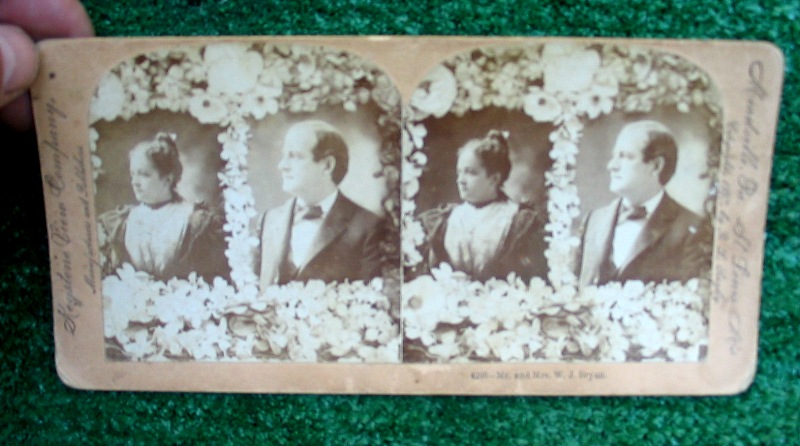
Image 3
Here's an outstanding small grouping that I received from the Great great grandson of this Zouave Soldier. This soldier was a member of the 34th Ohio Infantry. The 34th Ohio Volunteer Infantry Regiment (or 34th OVI) was an infantry regiment that served in the Union Army during the American Civil War. It primarily served in the Eastern Theater in what is now West Virginia and in Virginia's Shenandoah Valley region. They are well known for wearing an americanized zouave uniform which consisted of: A dark blue jacket with red trimming, a pair of sky blue baggy trousers with two stripes of red tape going down vertically, a pair of tan gaiters, and a red ottoman styled fez with a blue tassel. They are known as Piatts Zouaves. The 34th Ohio was raised at Camp Lucas near Toledo on September 1, 1861. Most of the recruits came from the northwestern part of the state. After training and drilling, the new regiment moved to Camp Dennison on September 1, and then entrained for the front lines, arriving on September 20 at Camp Enyart on the Kanawha River in western Virginia. It initially served in the forces under George B. McClellan, and then under a variety of generals for the next two years while engaging in several raids and operations in the region. When the regiment's term of enlistment expired late in 1863, the men voted to re-enlist on December 23. They were part of Crook's Expedition against the Virginia & Tennessee Railroad in early May and fought in the Battle of Cloyd's Mountain on May 9 and later in the Battle of Cove Mountain and in other smaller engagements in the region. The 34th OVI was re-mustered as a veteran regiment on January 19, 1864, and participated in many of the battles of the Valley Campaigns of 1864, including the Battle of Opequon near Winchester, Virginia.[1] The 34th Ohio suffered 10 Officers and 120 enlisted men killed in battle or died from wounds, and 130 enlisted men dead from disease for a total of 260 fatalities.[2] The much depleted regiment was amalgamated with the 36th Ohio Infantry on February 22, 1865.
This soldier of the 34th Ohio is George Sheckler and here is his stats:
George Sheckler Residence was not listed; 23 years old. Enlisted on 8/1/1861 as a Private. On 8/15/1861 he mustered into "E" Co. OH 34th Infantry He was Mustered Out on 9/13/1864 at Columbus, OH Sources used by Historical Data Systems, Inc.: - Official Roster of the Soldiers of the State of Ohio (c) Historical Data Systems, Inc. @ www.civilwardata.com
This watercolor is outstanding showing Pvt. Sheckler standing holding a colt revolver in his right hand and a knife in his left. The colors are still vivid and this image is historically accurate to the Zouave uniform and the man. The image is 16 by 20 inches. Look at the detail in his face! This image is housed in a walnut frame with gesso sculpted inserts. There is some gesso loss but not bad at all and doesn't detract from the image. The frame measures 26 X 30 inches and has a single slat back. This image was probably duplicated from a photograph. OUTSTANDING!!!
The next piece is Pvt. Sheckler's Record of the service. This is entitled 1861-1865 WAR FOR THE UNION- RECORD OF THE SERVICE OF GEORGE SHECKLER. It goes on to list when he enlisted into Company E of the 34th Ohio Volunteers as a private and when and why he was discharged. The outside of the image shows all the Corps badges as well as the various badges from Hancock's First Veterans, Wilson's Cavalry, Sheridan's Cavalry, Signal Corps, and so forth! Outstanding color and quality. The document also lists the Battles and Skirmishes Pvt. Sheckler participated in. This document is part printed and part hand written. The bottom lists this document as a SOLDIER'S RECORD and was designed, Copyrighted and Published 1895 by J.P.Calvert, Mooresville, Ind. The back of the document frame has an old wood slat with the name of H. Snyder & Son, Columbia City, Ind and some printing on the bottom. This frame is also a gesso covered frame with more loss than the frame above. The document is 16 X 20 inches and the frame is 22 X 26 inches overall.
I was told by the grandson that Pvt. Sheckler settled in Indiana after the war. The grandson also furnished me with some copies of original documents that include his obituary and an invitation to their daughters wedding. These documents are copies of the original documents and not the originals. This is an outstanding pair of framed articles pertaining to the man who served in a Zouave unit during the Civil War. Great! $1,150.00 for both. Take a look at the pics!!! item photography 117
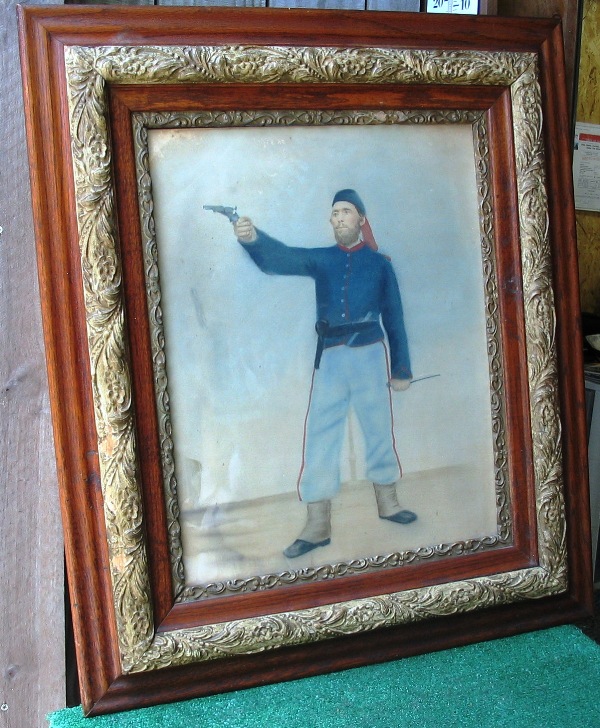
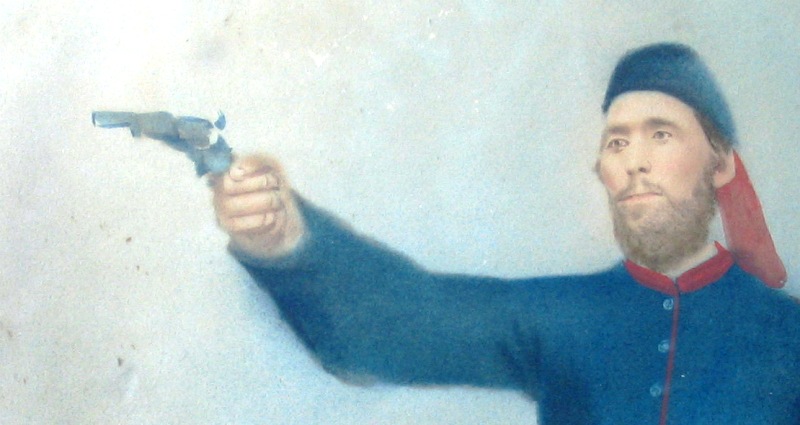
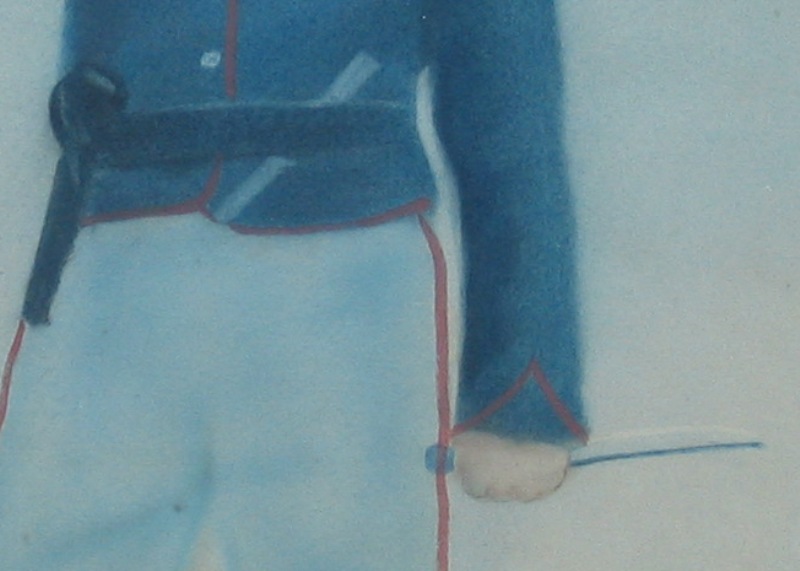
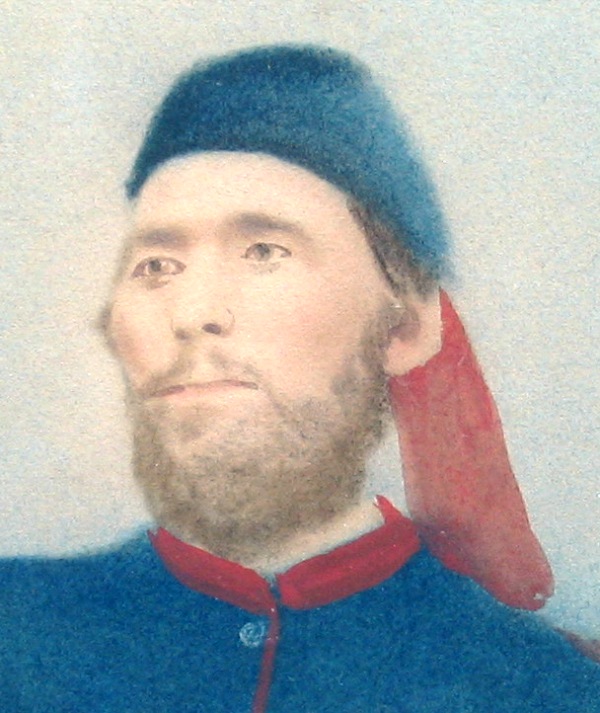
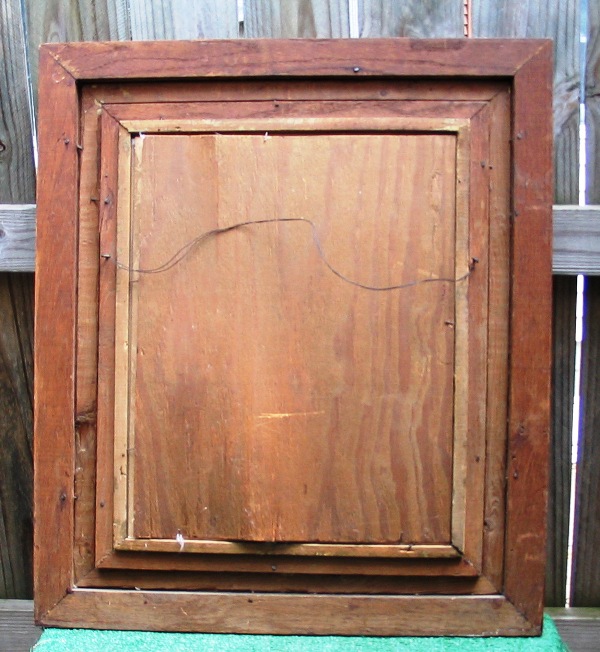
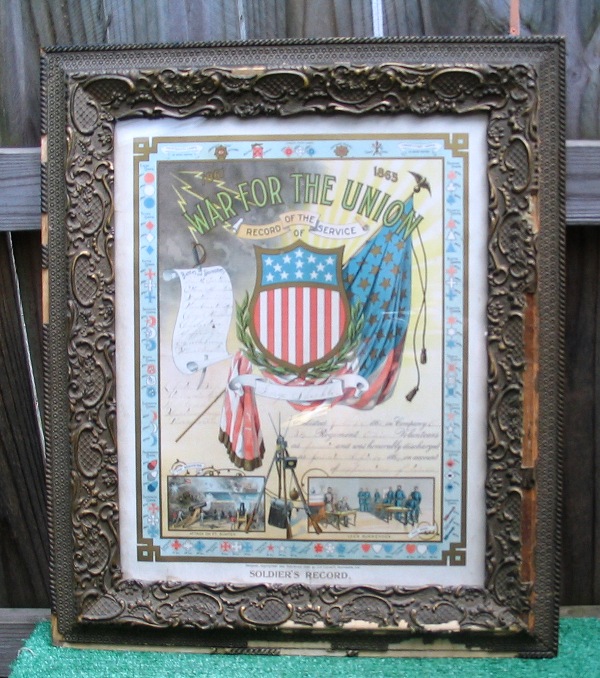
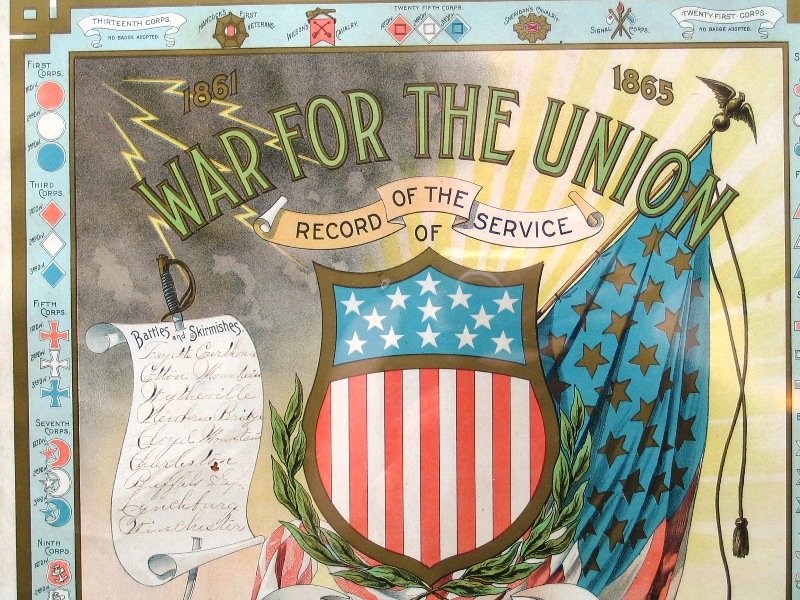
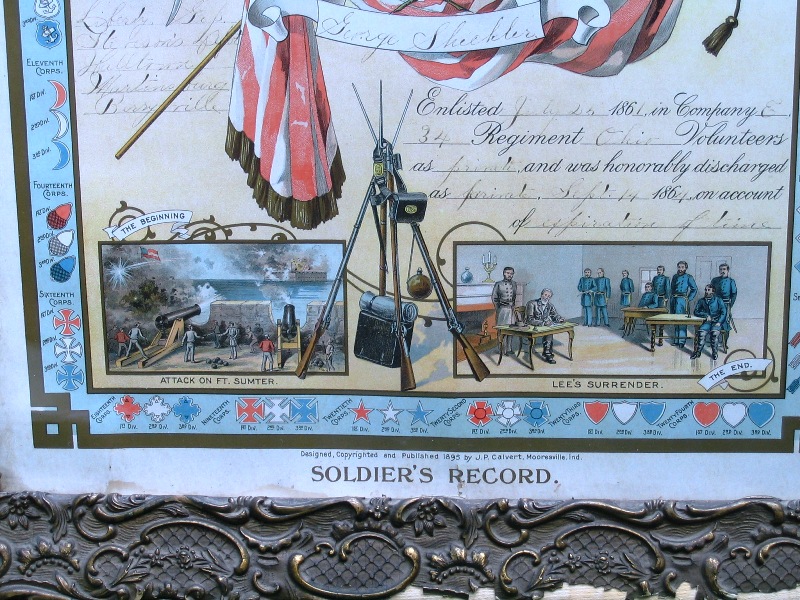
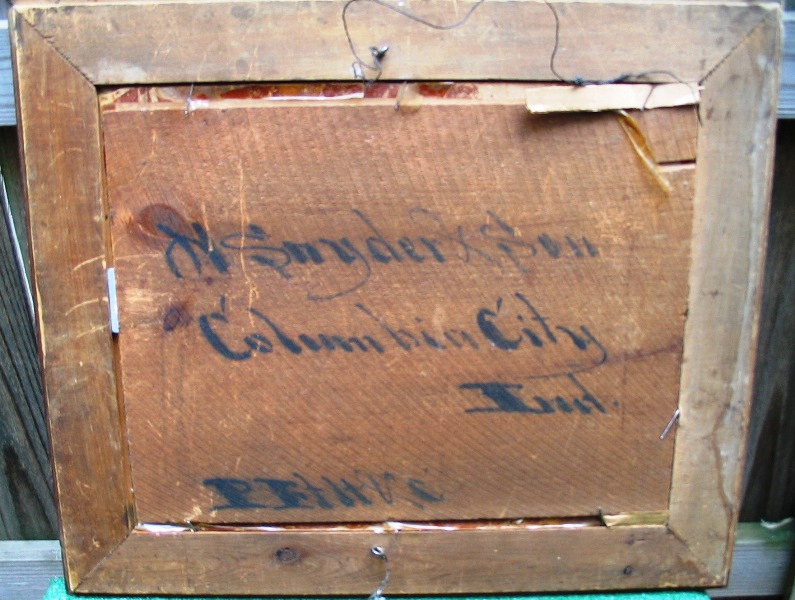
Image 2
Here's an outstanding collection of ORIGINAL oil paintings of 5 prominent Civil War Generals. All of these Generals were present at Gettysburg. These original oil paintings were painted by Noel Y. Pantig. Three of the paintings are signed NY Pantig and two of them are simply signed NOEL. These paintings are fantastic and are mounted in their original frames. The canvas in stretchers measure about 20 X 24 inches while the overall frame measures about 25 X 29 inches. Each painting has the name of the general mounted on the frame. Outstanding quality! Here is Noel's bio:
Noel Y. Pantig
Noel Y. Pantig, a skilled craftsman, teacher, mentor, and Studio owner, specializes in oil portraits on canvas. What sets him apart is his uncommon ability to capture the personality and essence of every image he brings to life. Aside from his obvious artistic abilities, Noel has developed a reputation as one of the foremost international artist, which makes his works of art cherished and treasured by all. Noel grew up near Clark Air Base in the Philippines. As a young boy he often sat and watched the active base with amazement, as the planes flew in and out. Knowing a little about World War II from his parents stories of their relatives fighting as young Philippine service men along side American soldiers, made a lasting impression on him. Blessed at an early age with a talent for drawing, Noel often sat for hours upon hours sketching faces of his family and friends. It wasn’t until his teen years that he started working in oils and soon became recognized for his talents. In the early 80’s, Noel fine-tuned his skills while working for local art galleries as well as an international export organization, painting portraits from photographs as well as recreations of famous paintings. Today, Noel, with a penchant for American History, due in part to his childhood recollections, continues to paint but on a very exclusive basis. His exceptional hand- painted works of art can be found in such places as: VMI, The New Market Battlefield Military Museum, Port Columbus Civil War Naval Museum, along with other prominent institutions, Corporate offices and collectors walls. Noel is also a proud owner of a international art studio, where he develops the talents of artists who are aspiring to greater heights. He is truly a gifted artist!!!
The 5 different generals are:
General George Custer U.S.A.
General Winfield Hancock U.S.A.
General Lewis A. Armistead C.S.A.
General John Buford U.S.A.
and General George E. Pickett C.S.A.
As perviously stated the quality of these original oils is outstanding!!! These are not prints but originals. Check out the pics! These paintings will go up in value. For the lot. $2,250.00 item photography 118
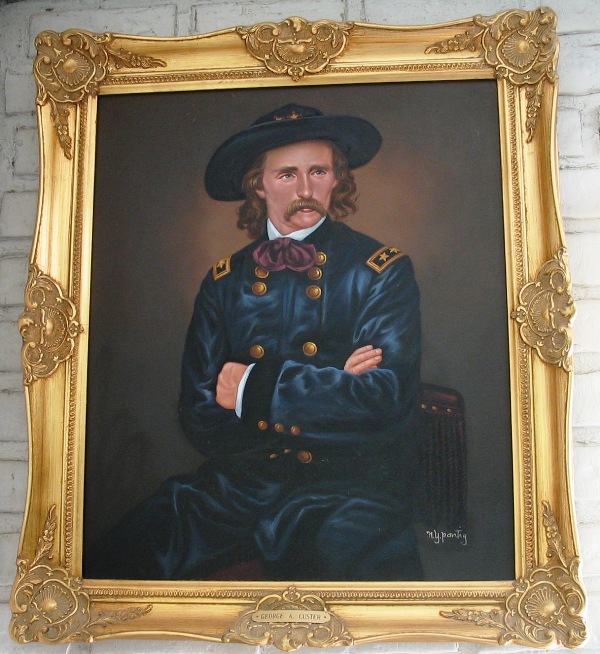
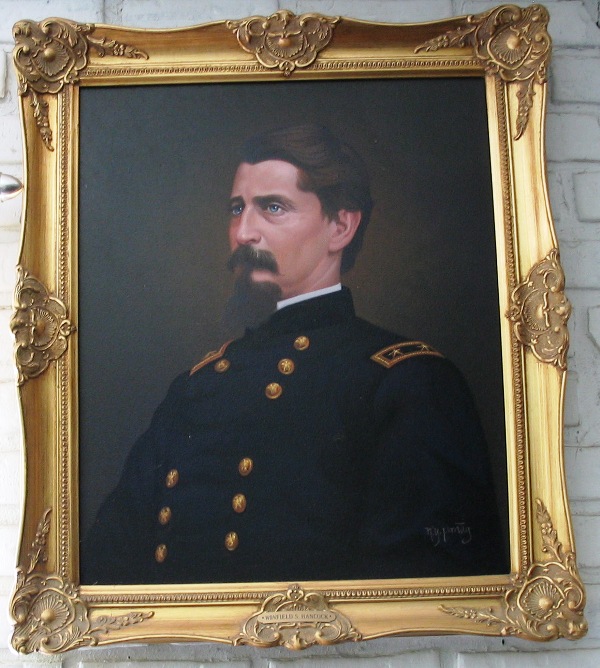
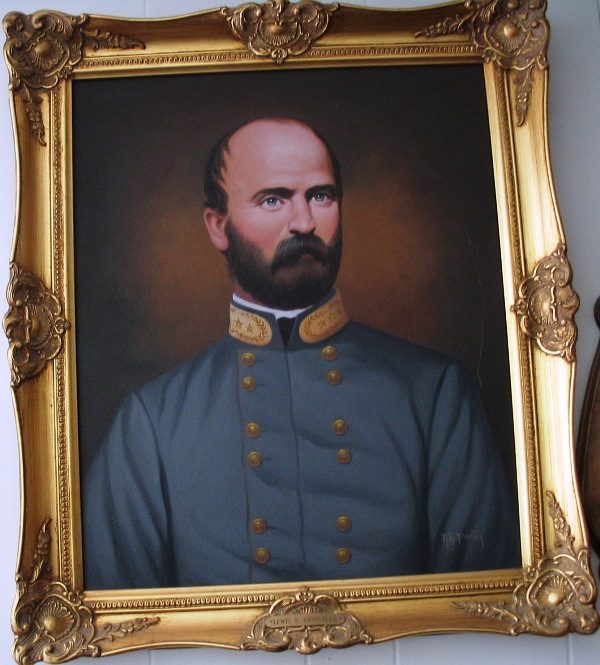
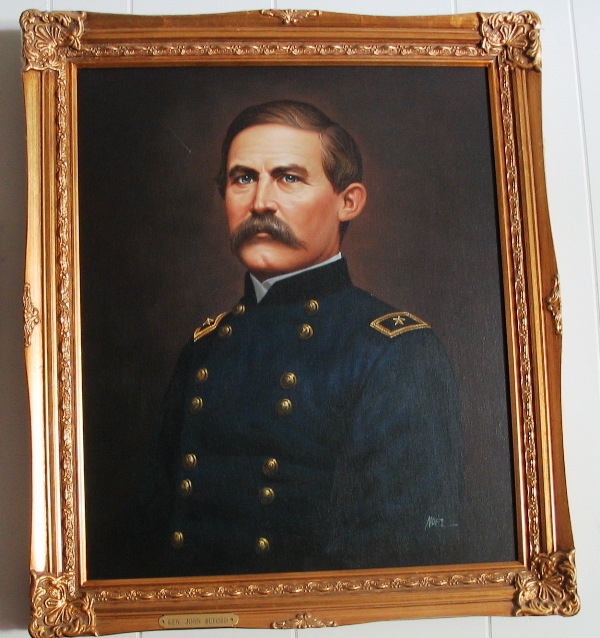
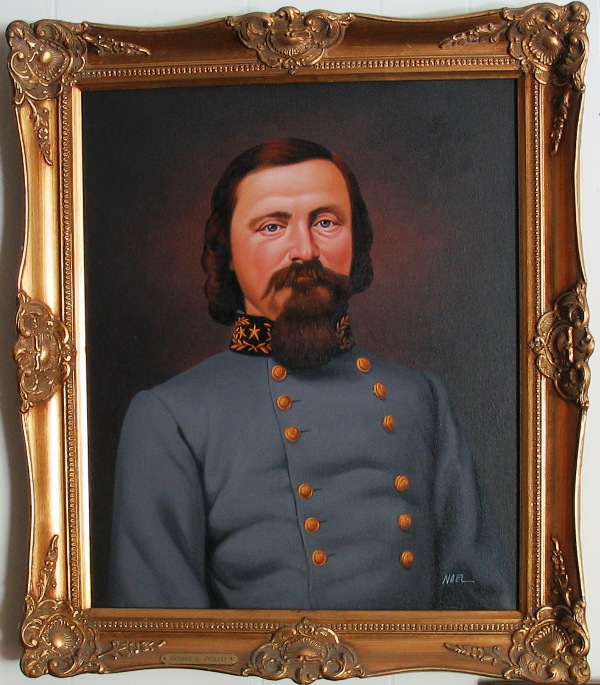
Image 1
This is a nice old orignal CDV of French conjoined sisters as marked on the front of the CDV. There is no backmark. This is a very nice conditioned CDV and the image is sharp! $45.00
item photography 119
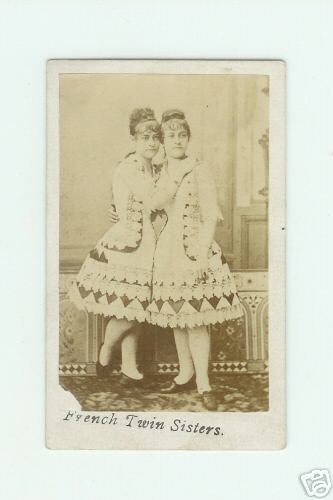
Here we have a ton of original prints that were taken from FRANK LESLIE'S SCENES AND PORTRAITS OF THE CIVIL WAR. These were done in 1865 I believe and although I would never take apart a book to sell the prints I found these prints already separated from the book. So here they are. I've shown several of the prints which are on both sides of the paper but different images. The pages are 16 inches by 11 inches and the prints are still vivid. Take a look at the pics. I did not take photos of all of them but the subject matter is quite varied and shows battle scenes from Gettysburg as well as down south. Riverboats and ironclads are present as well as battlemaps and Generals from the Civil War. Take a look and if there's anything you would like or want me to check for let me know at tc1861@yahoo.com Each print is $9. One of the prints is a double sheet. Thanks for looking! item photography 120
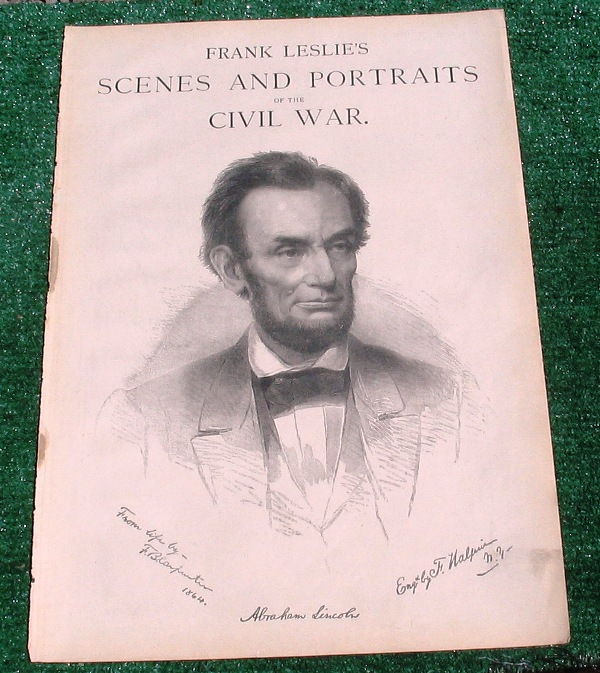
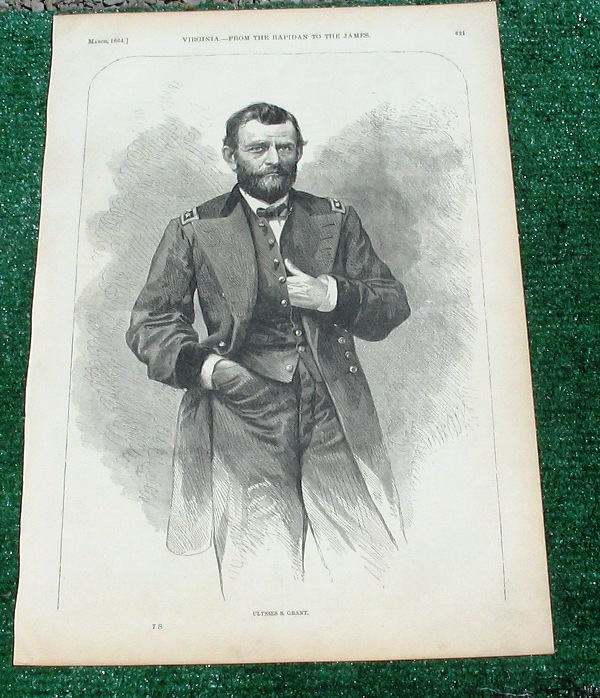
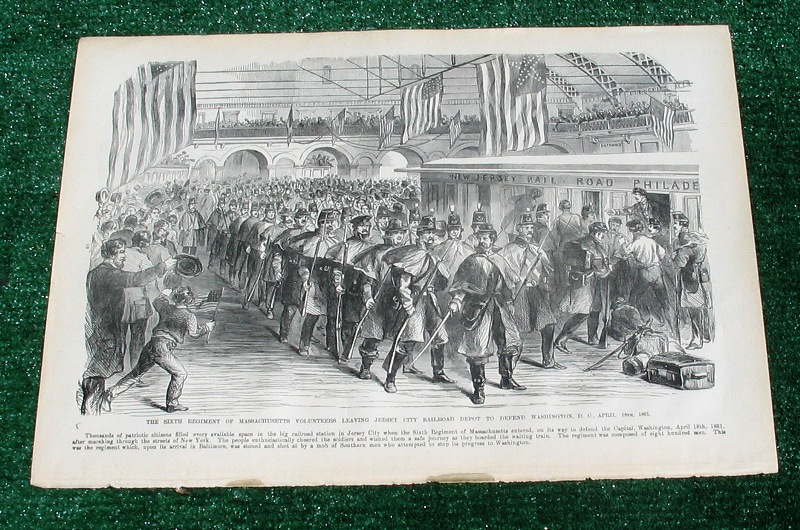
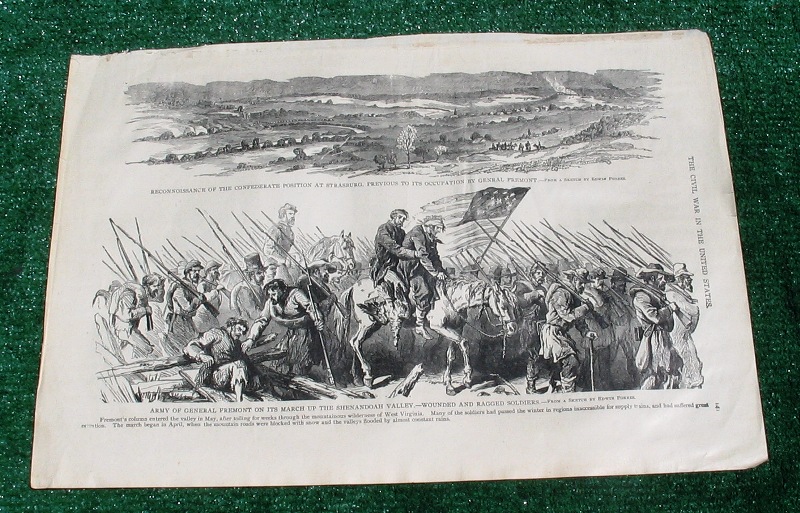
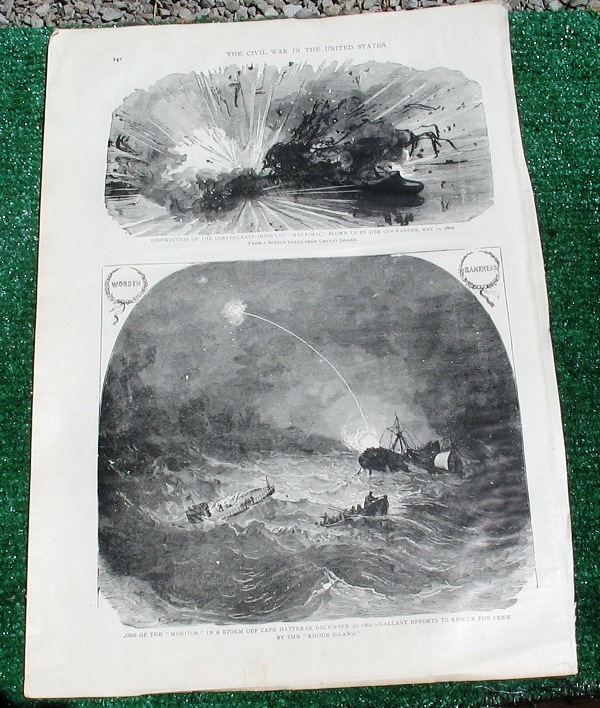
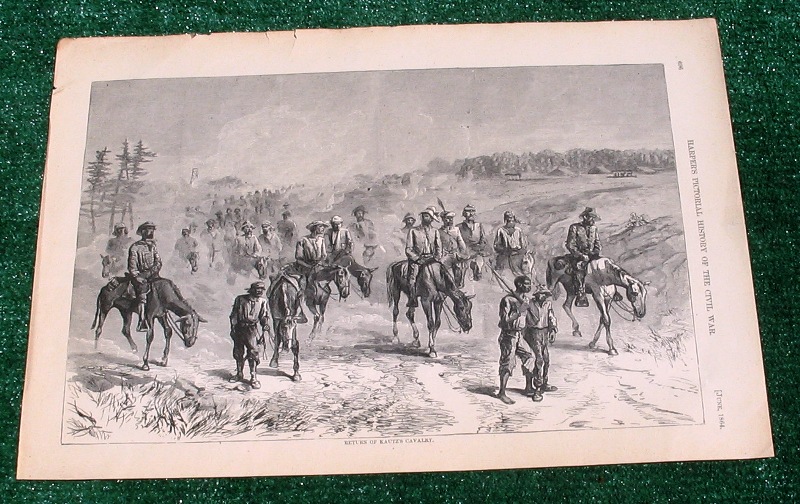
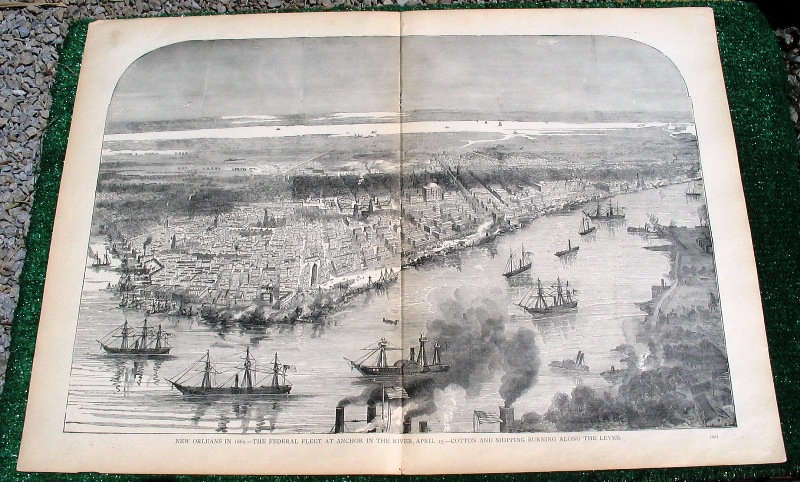
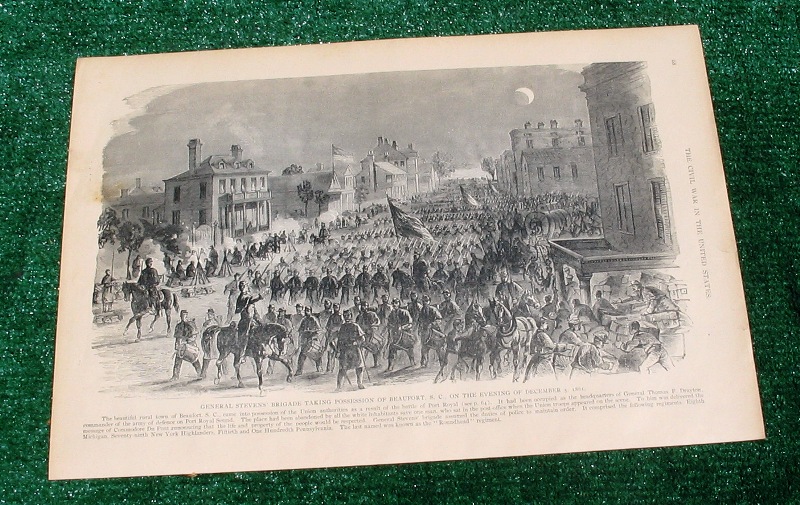
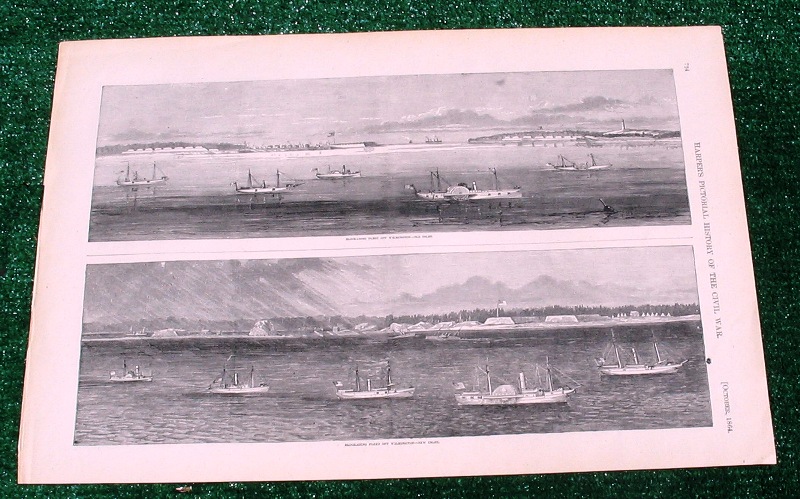
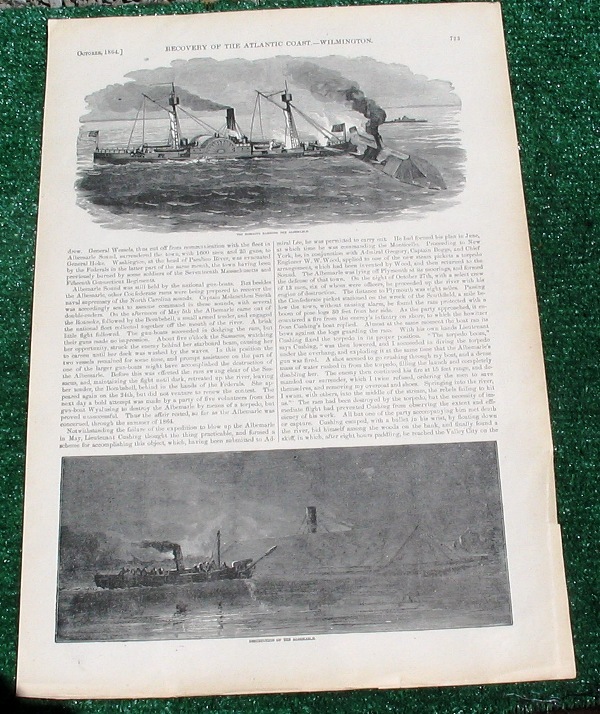
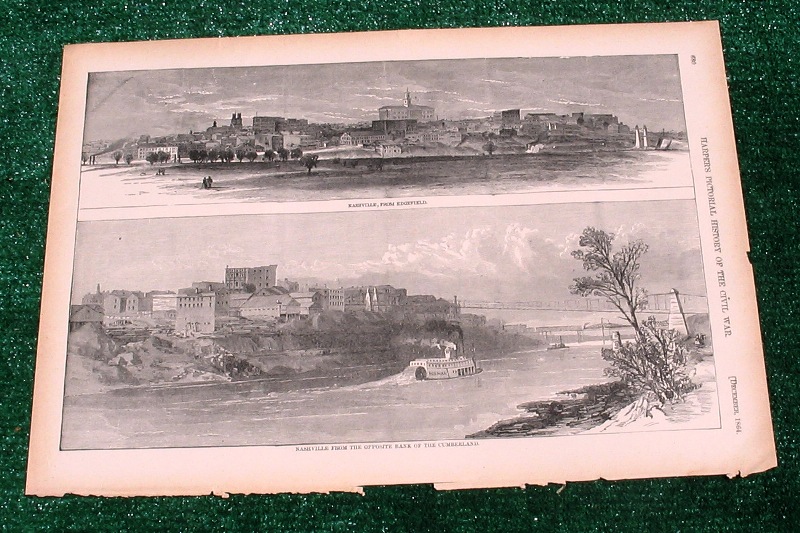
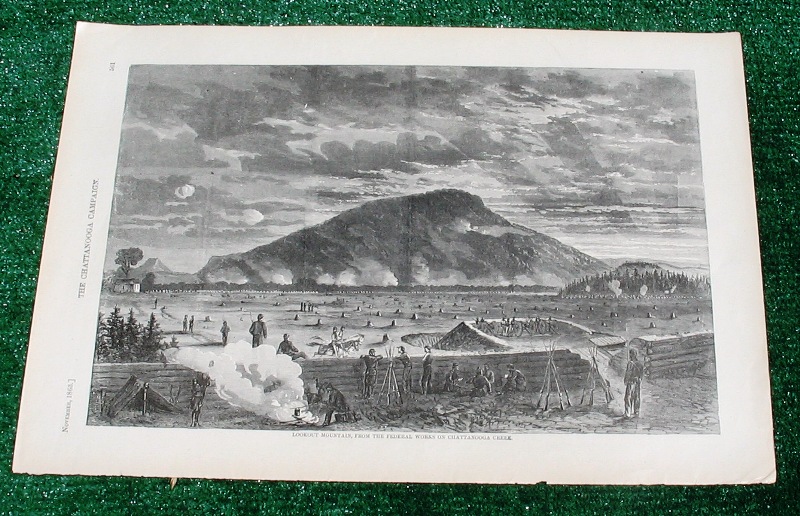
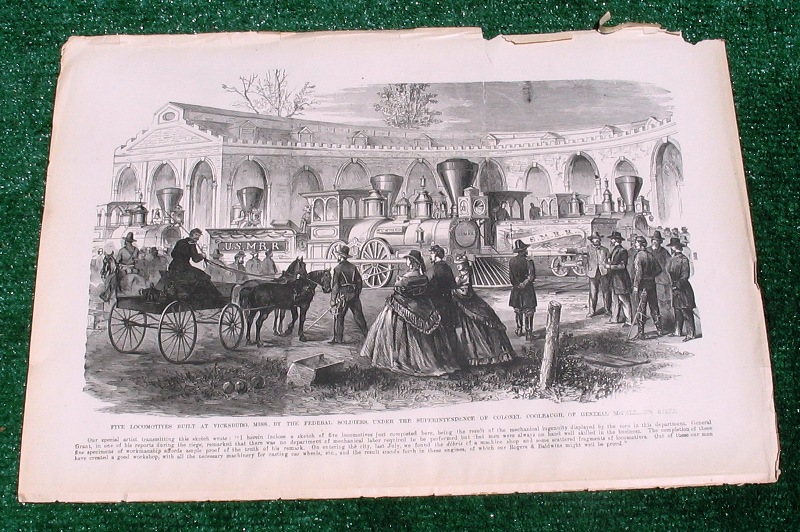
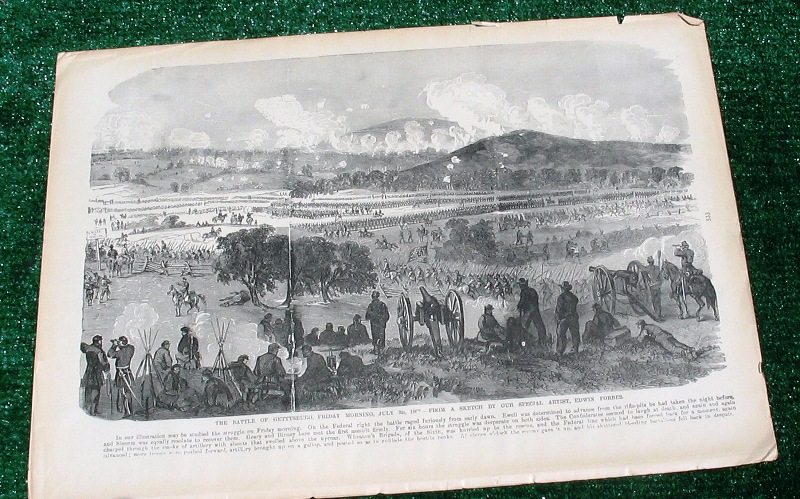
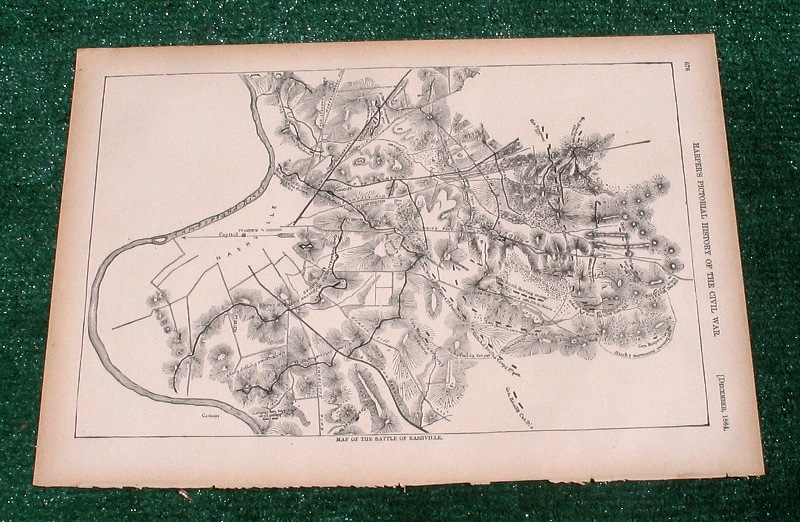
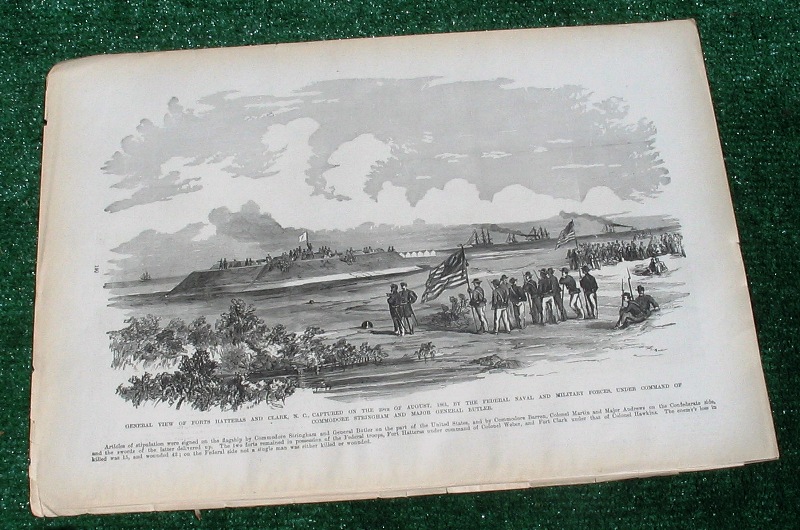
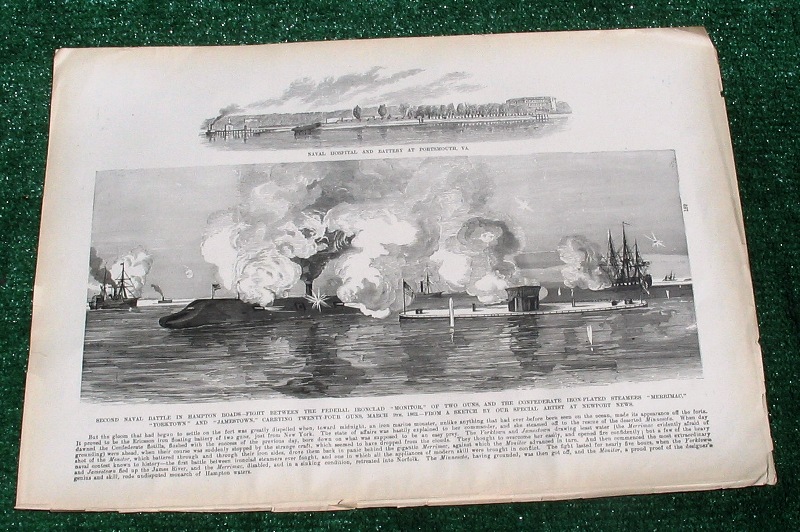
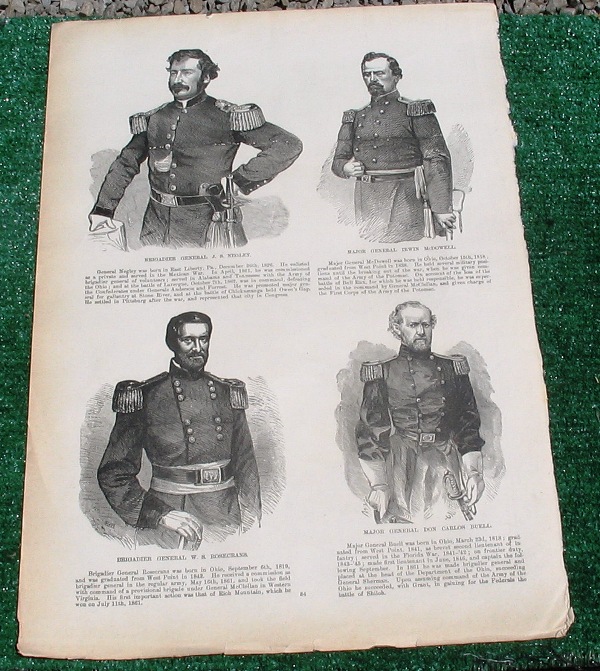
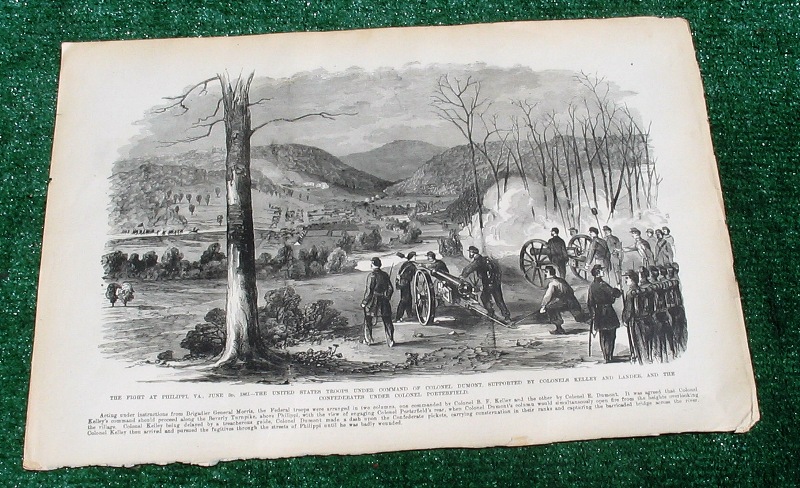
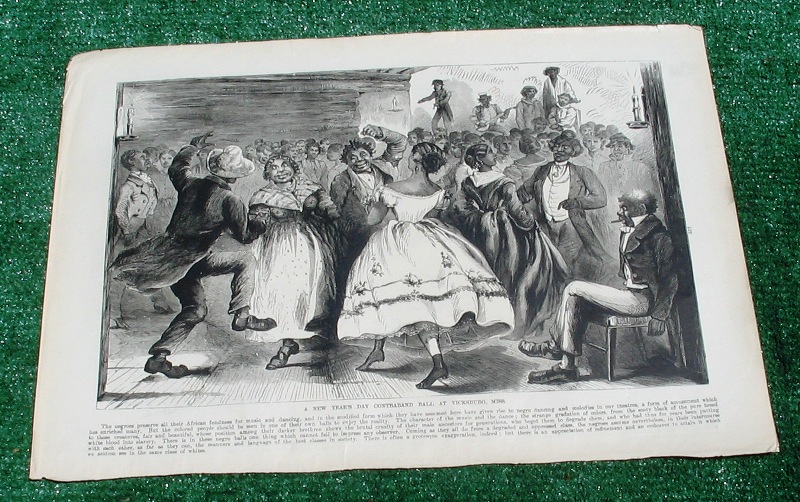
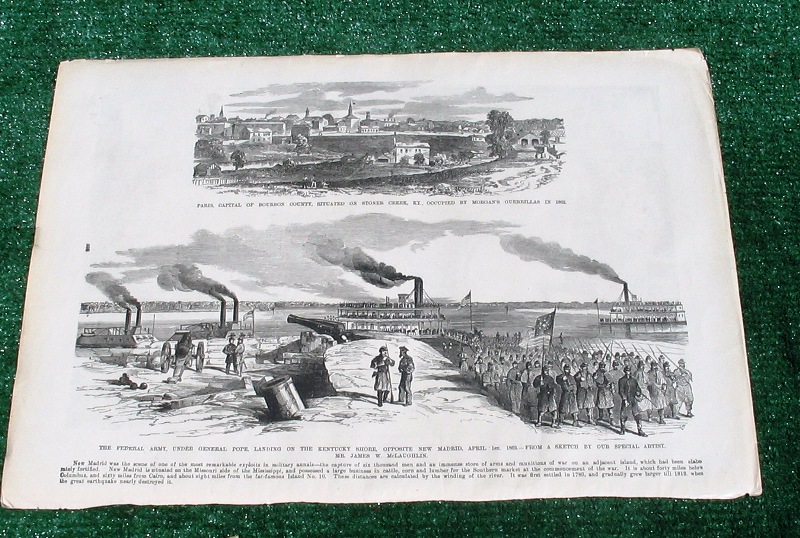
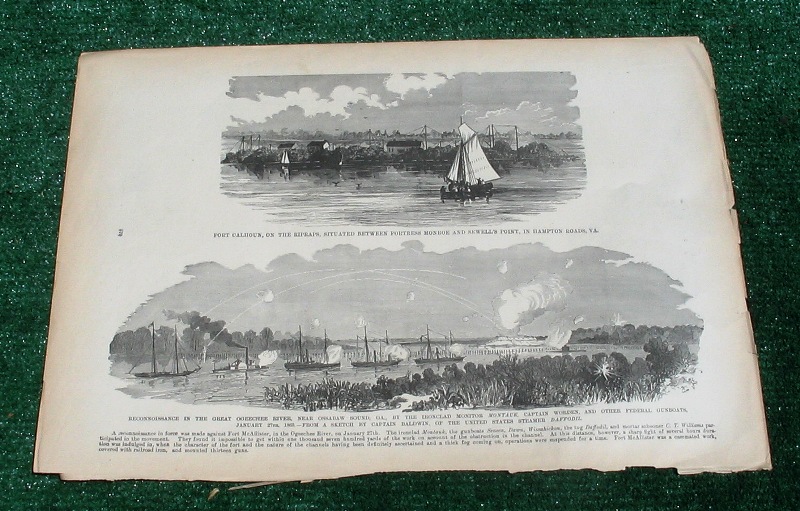
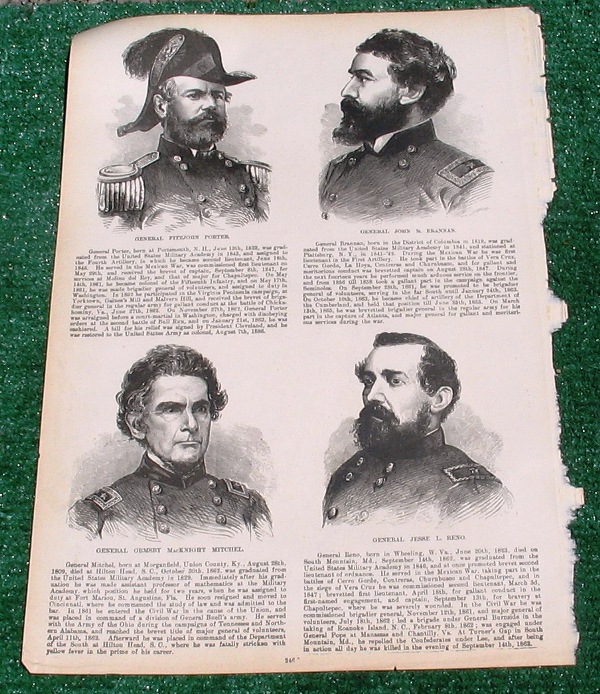
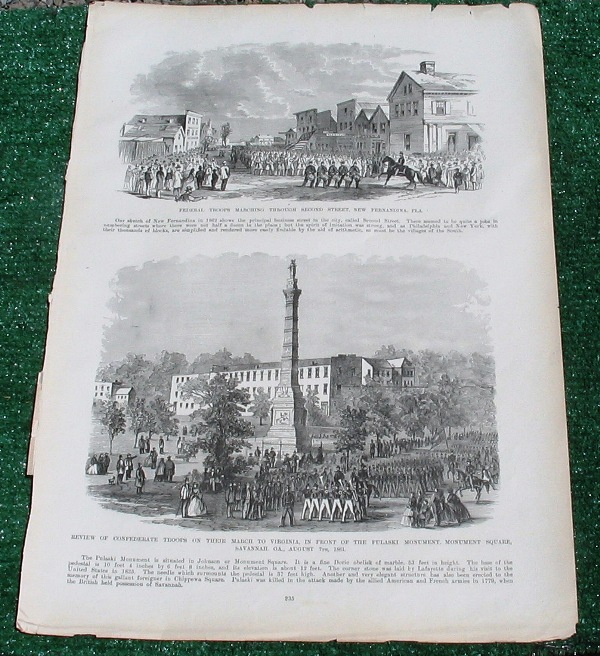
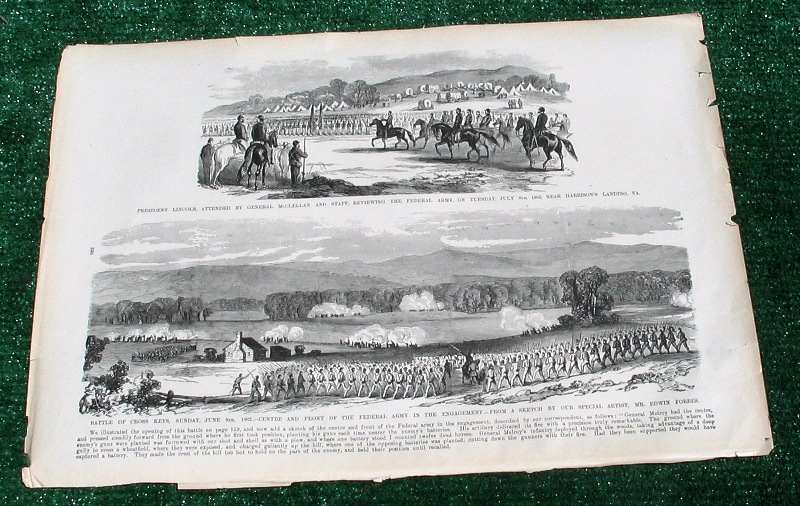
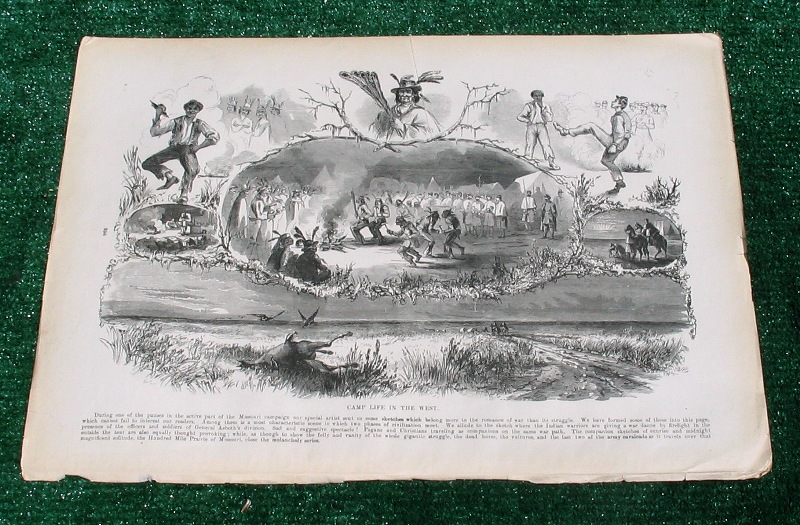
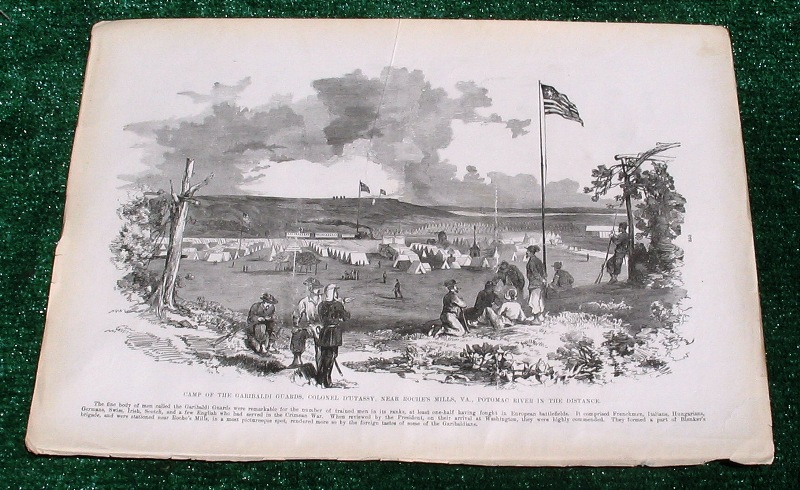
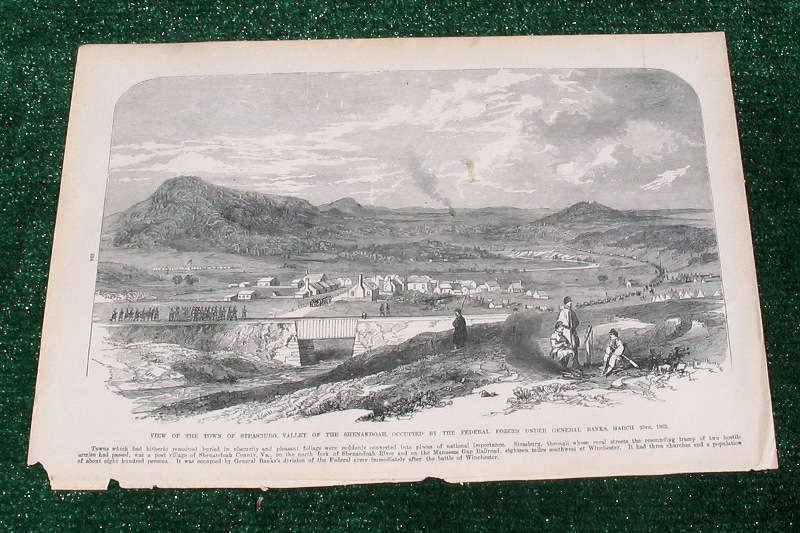
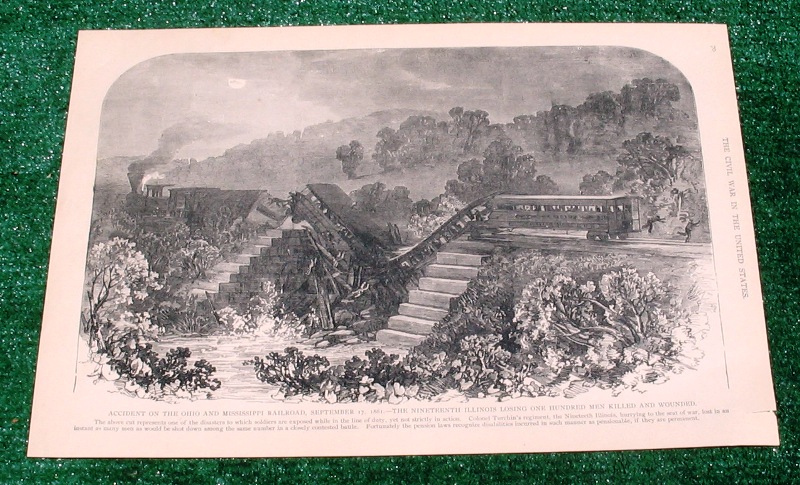
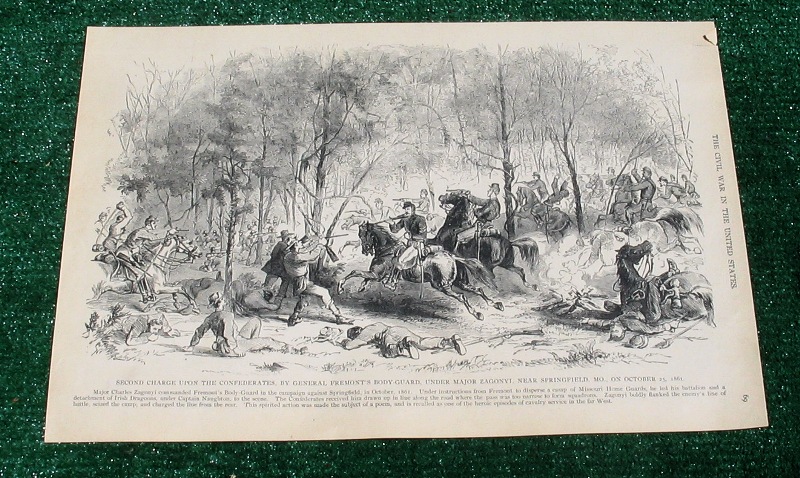
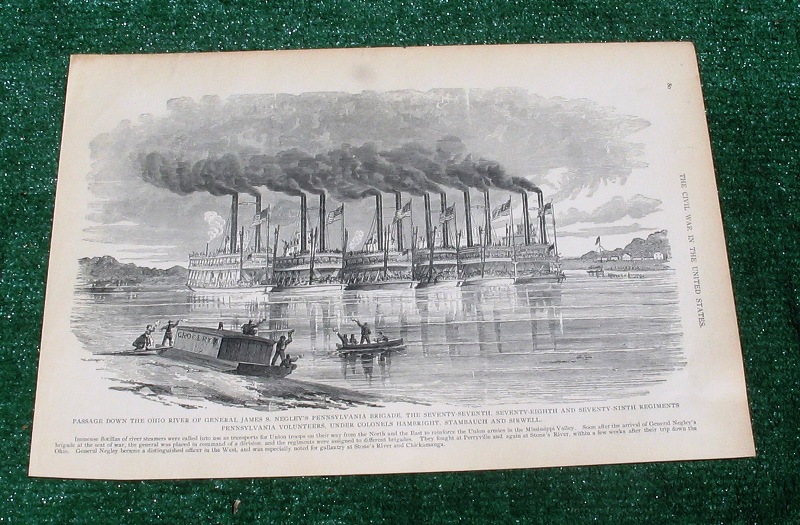
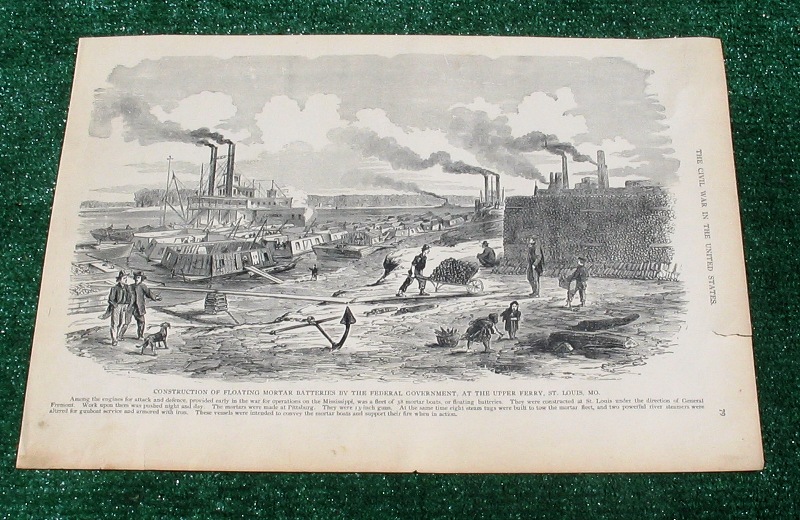
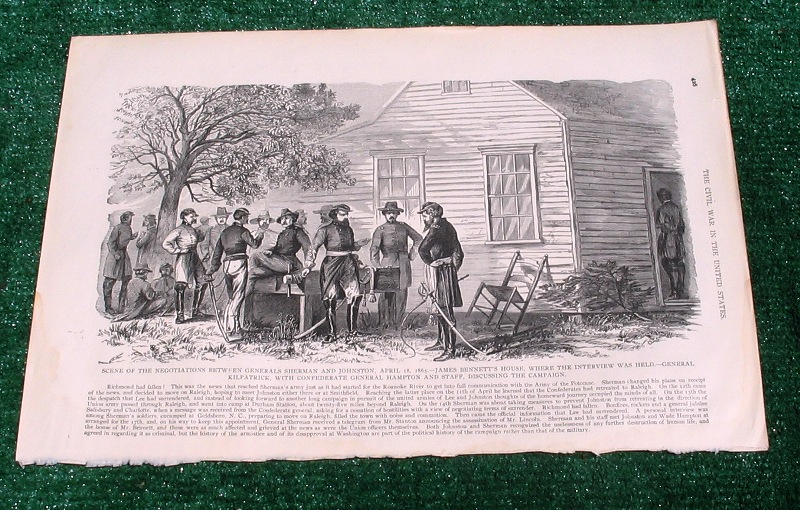
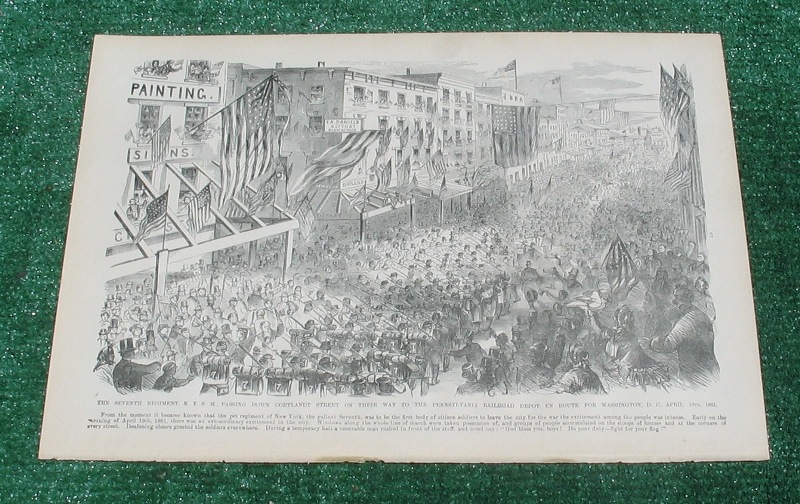
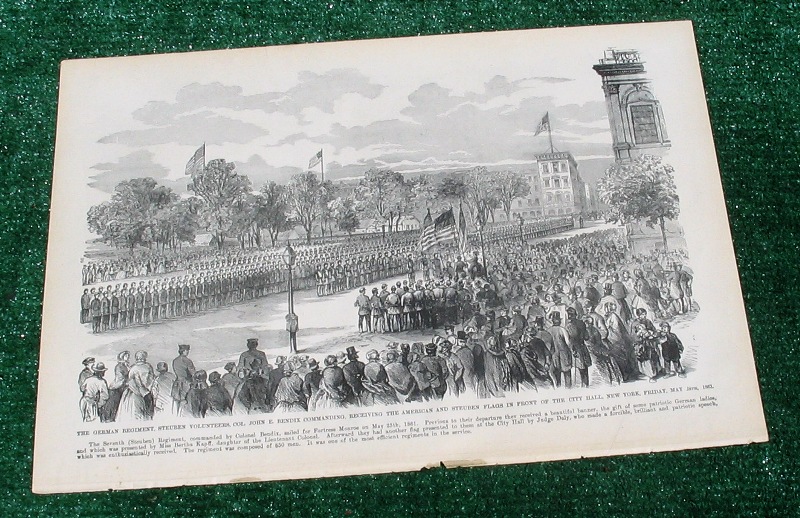
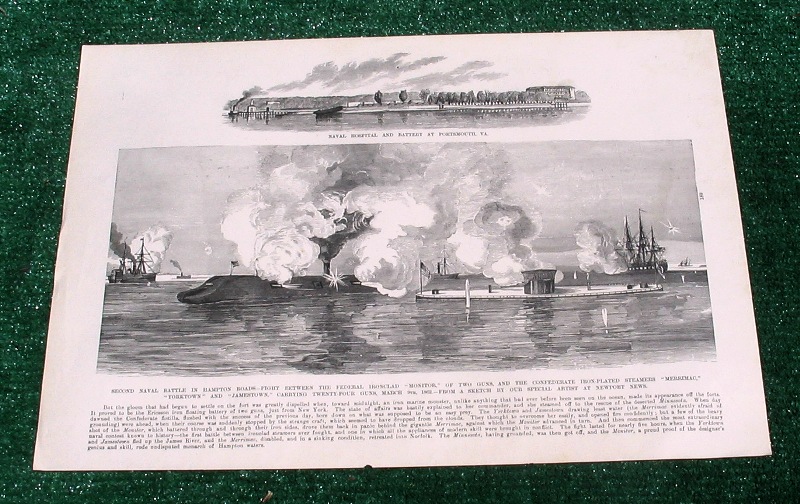
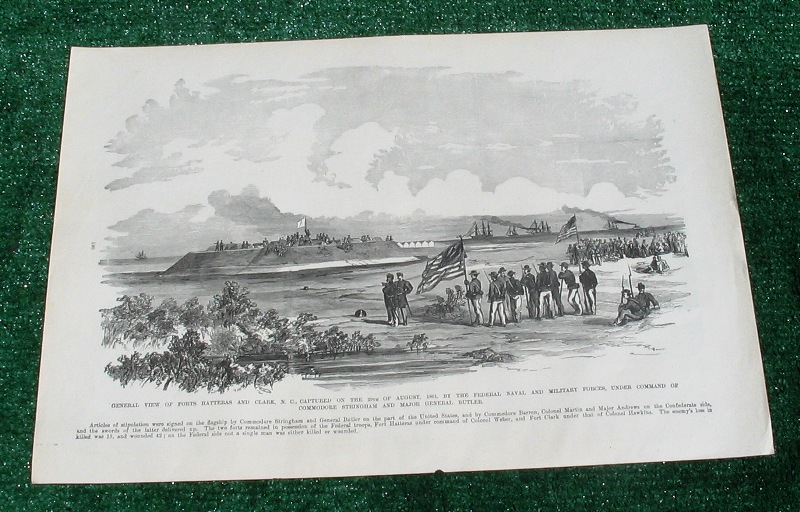
Here we have some half sheet prints for $6 each. They average about 11 1/2 by 12 inches. Check out the pics!
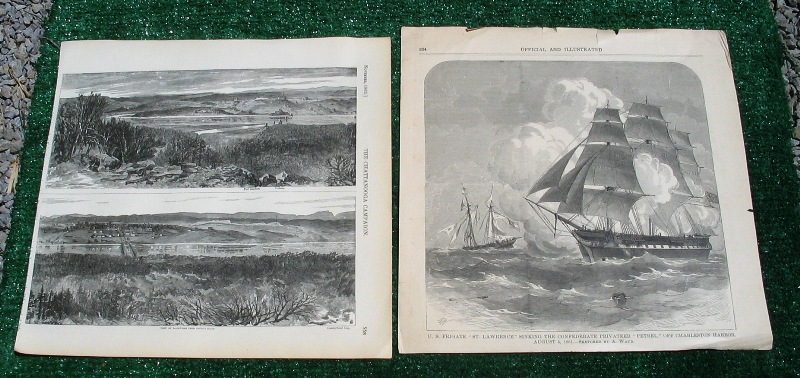
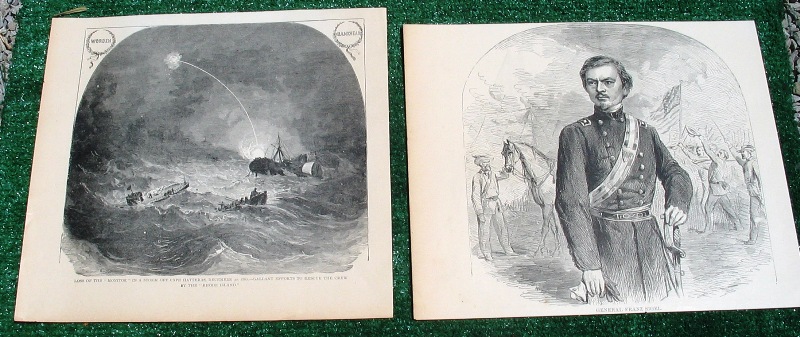
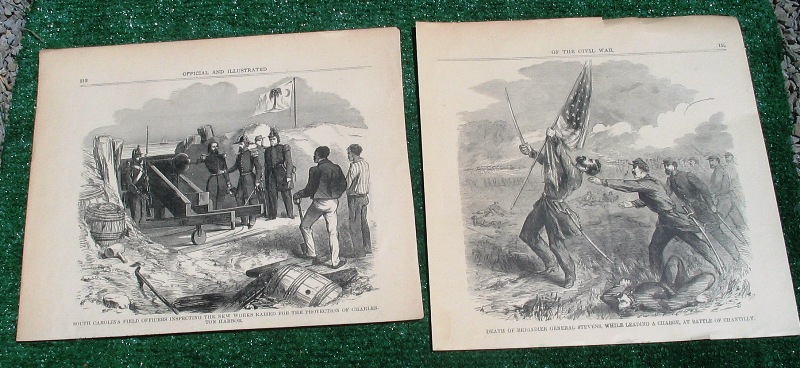
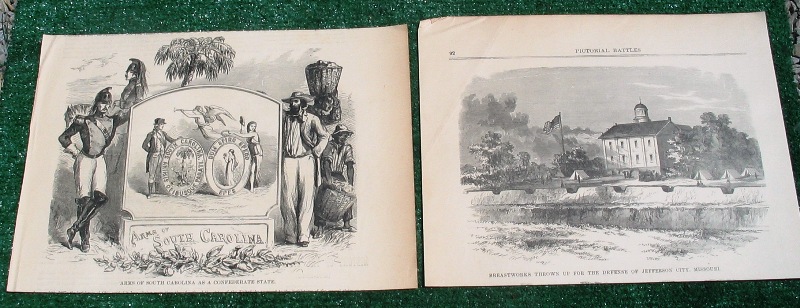
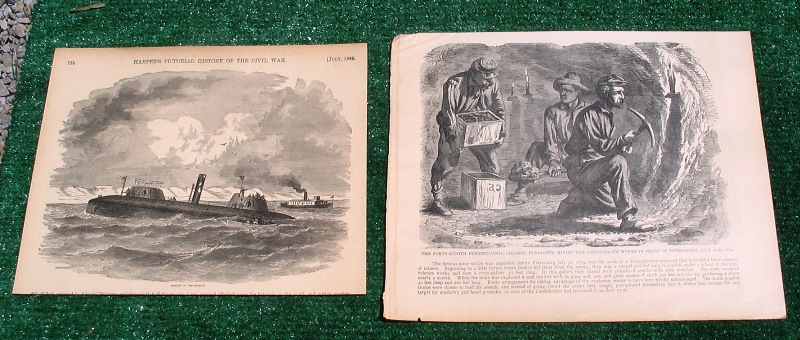
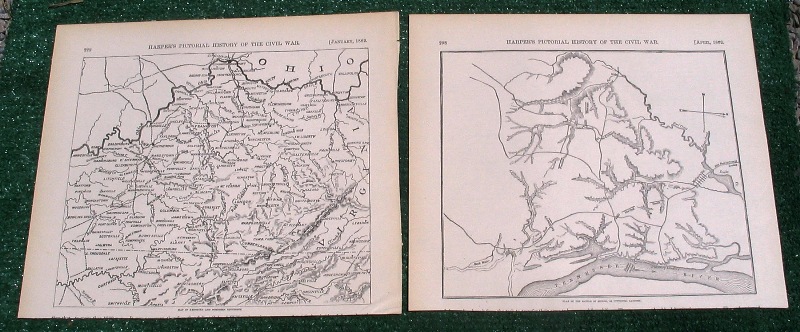
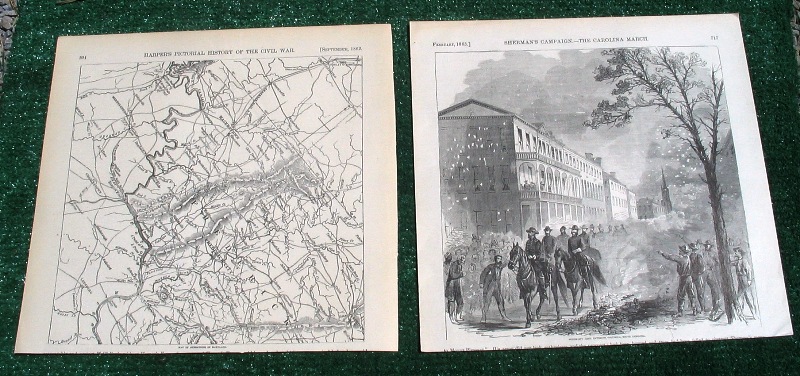
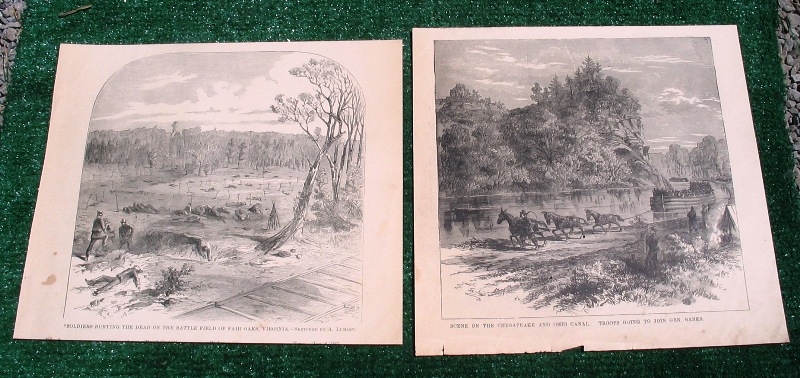
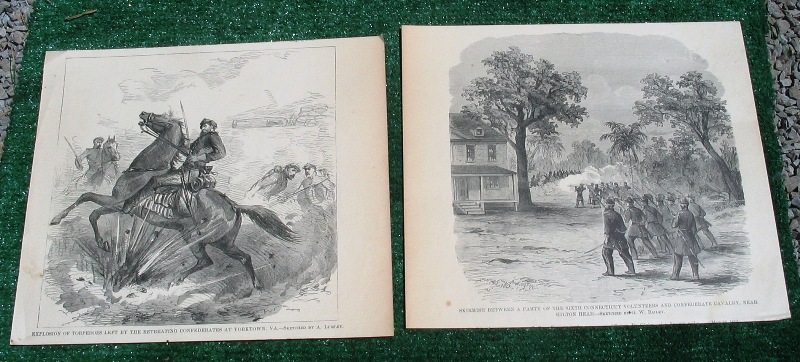
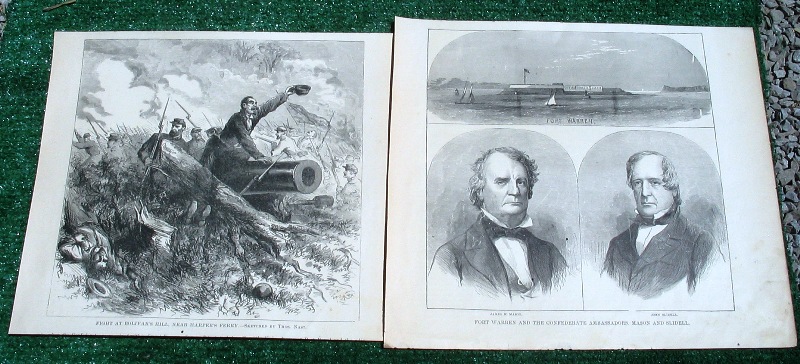
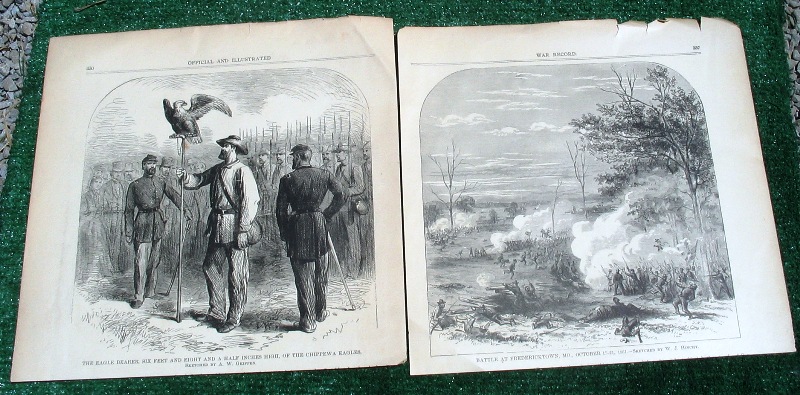
and here is what I call some quarter sized sheets. They vary in size but an average size is 7 1/2 X 12 inches. Check out the pics!
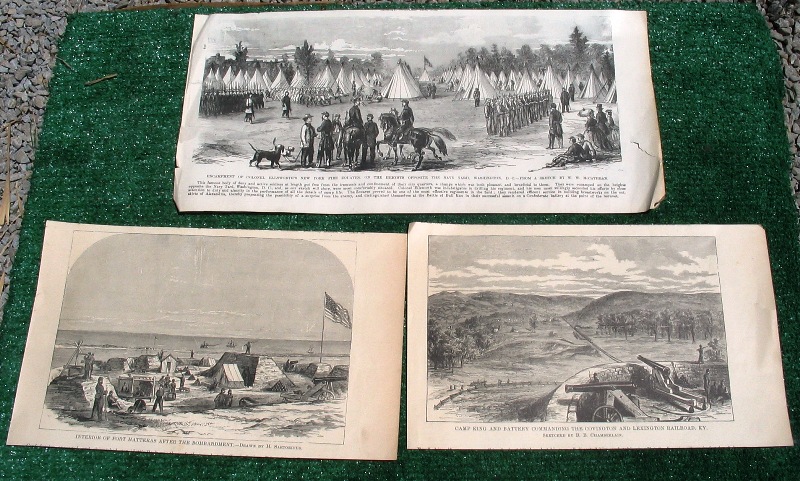
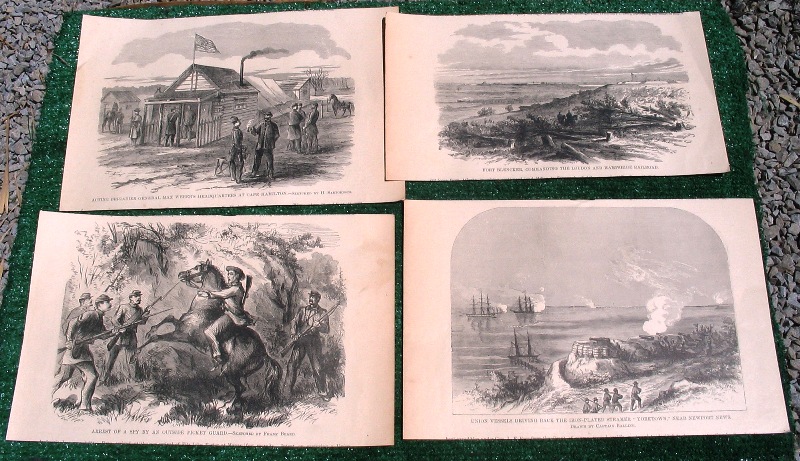
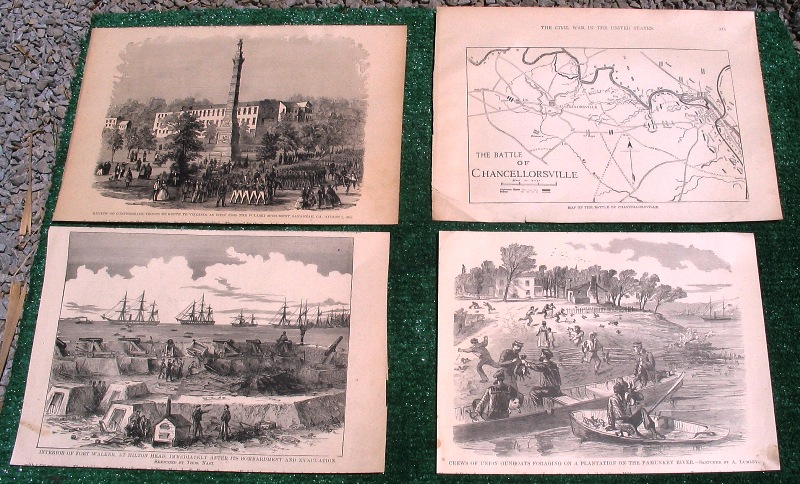
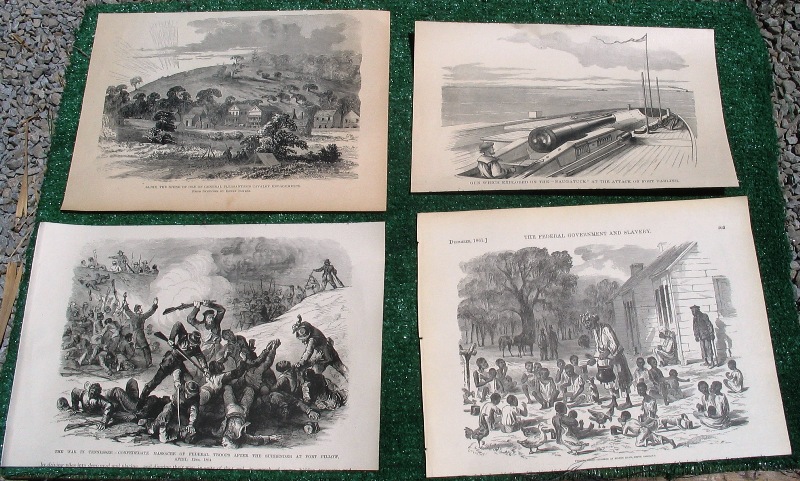
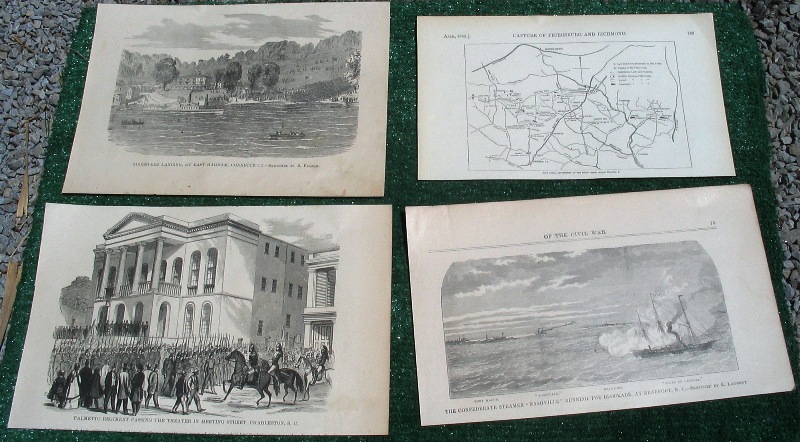
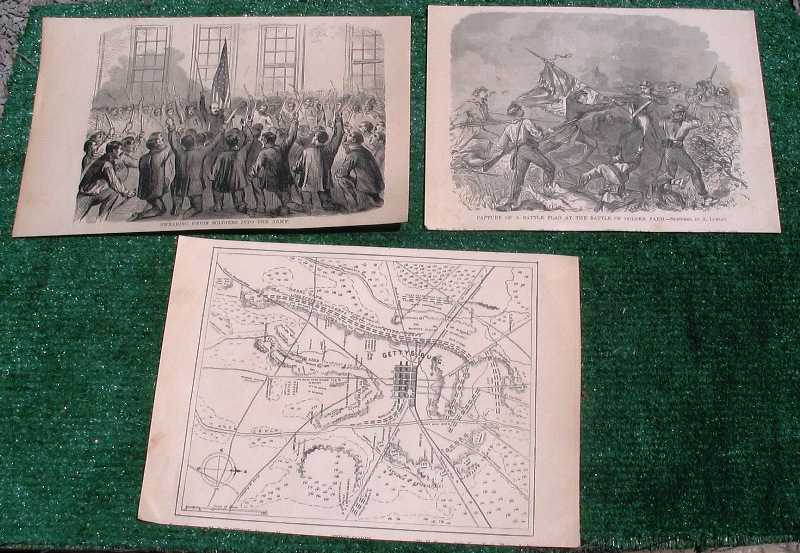
TC paper 78
Here we have two modern prints of original photographs of General Nathan Bedford Forrest and General James Longstreet. Each is in a 4 X 6 inch format. Ready to hang on the wall or place on your desk. Each $5.00
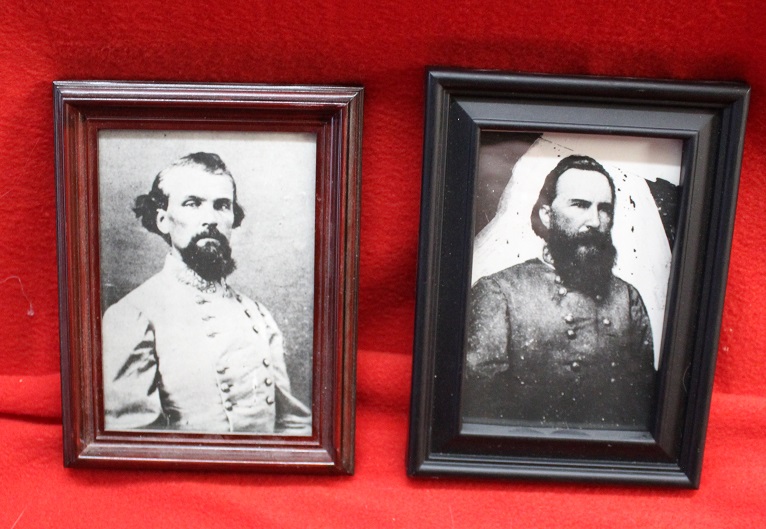
TC paper 77
Here we have two modern prints. The one on the left is entitled THE GATLING GUNS by Charles Johnson Post and commemorates 1898, The Spanish American War. The one the right shows Civil War CS Soldiers on a train. Each is in a 4 X 6 inch format. Ready to hang on the wall or place on your desk. Each $2.50.
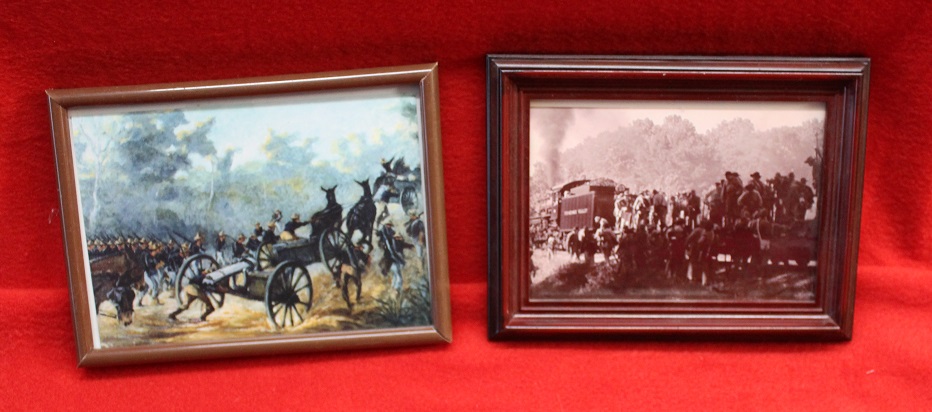
TC paper 76
Here we have three modern prints of original CW photos. Here we have Admiral David Farragut in the center flanked on the left by General Tecumseh Sherman and flanked on the right by General John Buford Jr. of the Union Army. All in 4 X 6 format. Would look great on the wall or desk. Each $5.00
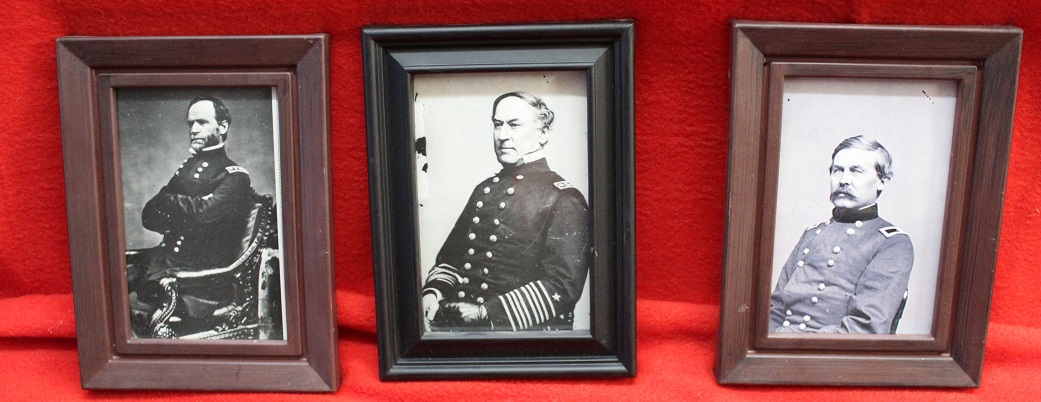
TC paper 75
Here we have three modern photo prints of original CW photos/print. We have Abraham Lincoln in the center flanked by CS General Albert S. Johnson in his West Point Uniform on the left and General Ambrose Burnside of the Union Army on the Right. All in 4 X 6 format. The Lincoln Photo is $10 while the Johnson and Burnside photos are $5.00
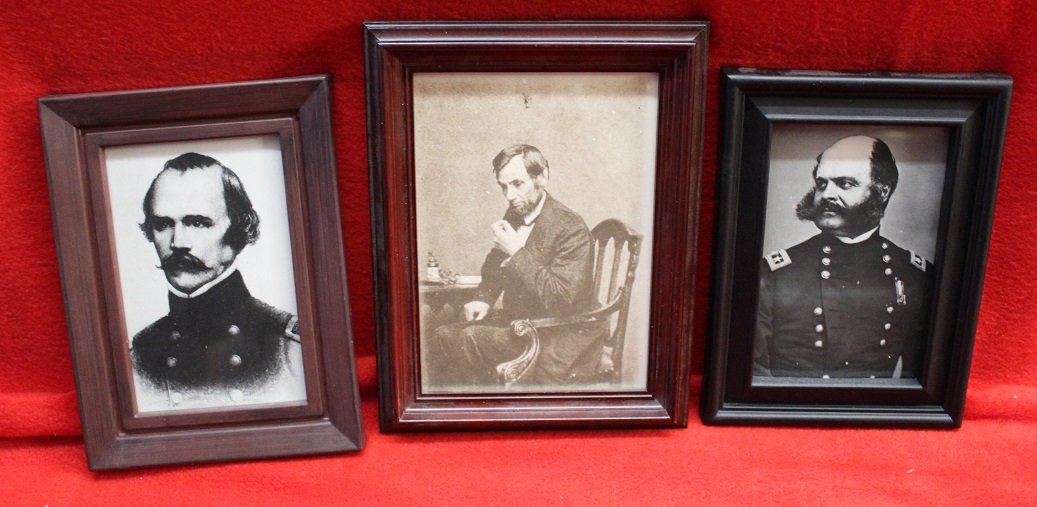
TC paper 74
Here are three more collectible prints/photo. The one in the center is an oval of President Lincoln 7 3/8 X 5 3/5 inches and is under glass. The item to the left is a small3 3/8 X 2 3/4 image of Abraham Lincoln on wood while the image on the right is a photo of Ford's theatre where the Preside was shot. For the Oval $5, for the small image on wood $2 and for the image of Fords Theatre $2.50 These would look great in your collection and won't break the bank!
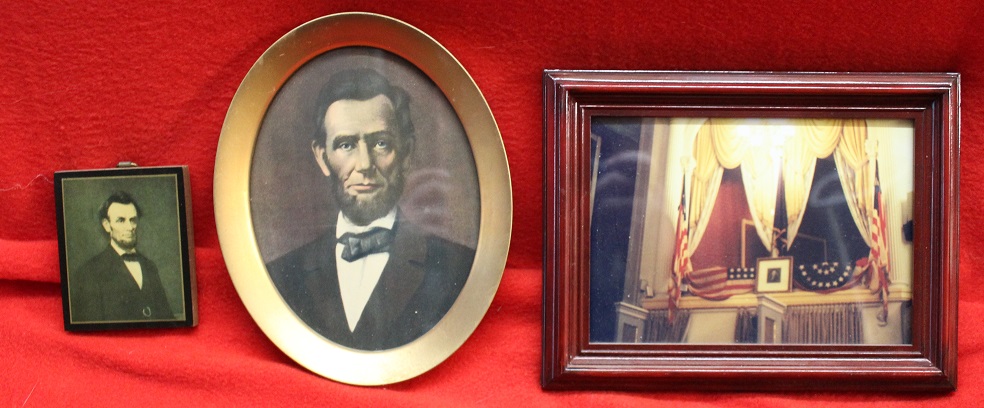
TC paper 73
Here we have 3 modern photo reprints of original Civil War Photos with all being the 4 X 6" format. The one in the center is The Great General Robert E. Lee and he is flanked on the left by the only Confederate States of American President Jefferson Davis and on the right by the C.S.S. Alabama Commander Rafael Semmes. Great grouping of CS Photographs! All Framed up and would look great on the wall or on the desk. $5 each.
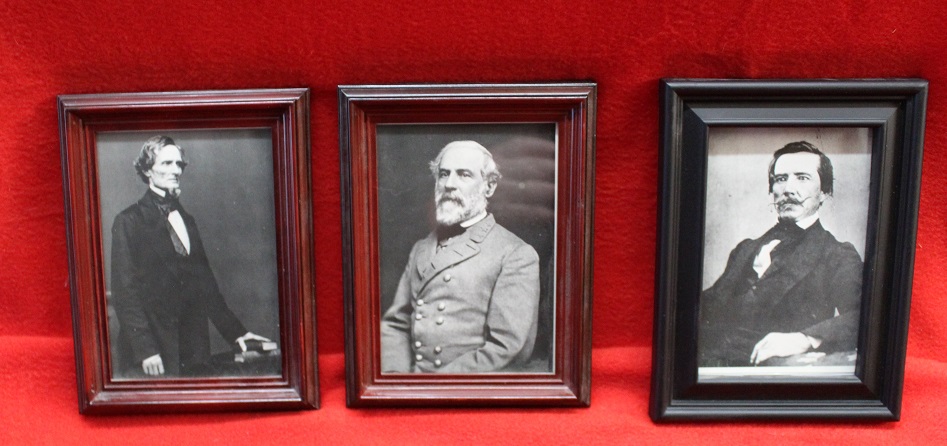
TC paper 72
Here we have a Civil War Print and a copy photograph of an origina CW photo of General George McClellan. This photo is in a 4 X 6 format. The print is in a 5 X 7 inch format and shows a Young Drummer Boy in color. These are great items and would look great displayed in your Den or Relic Room! Each $5.00
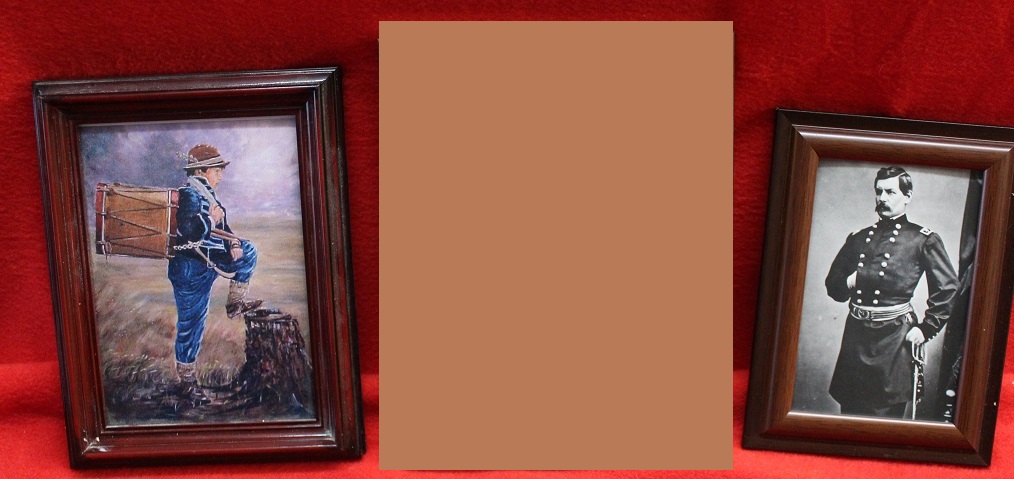
TC paper 71
Here we have an original pastel on pasteboard of a Union Soldier holding his musket and his Remington Revolver across his chest. The piece measures 15 3/4 inches long by 10 inches wide and it does have few chips around the edges and a tear on the bottom, much of which would be hidden by a frame. This took one of those 'bubble' oval frames that you see from the Civil War and Victoria ages. This is unique, colorized and very old! Don't know who it is but came from Central Indiana. $125.00
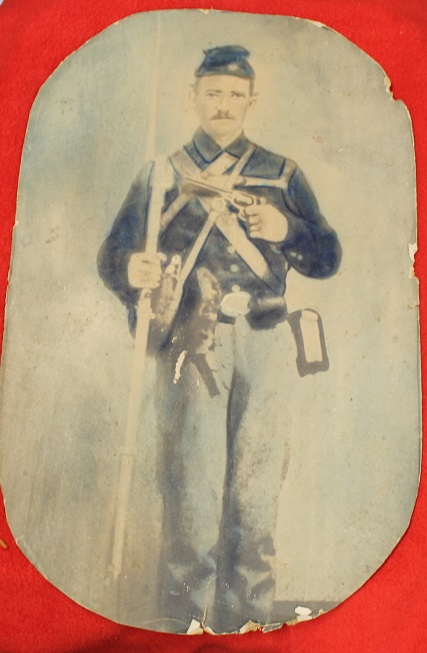
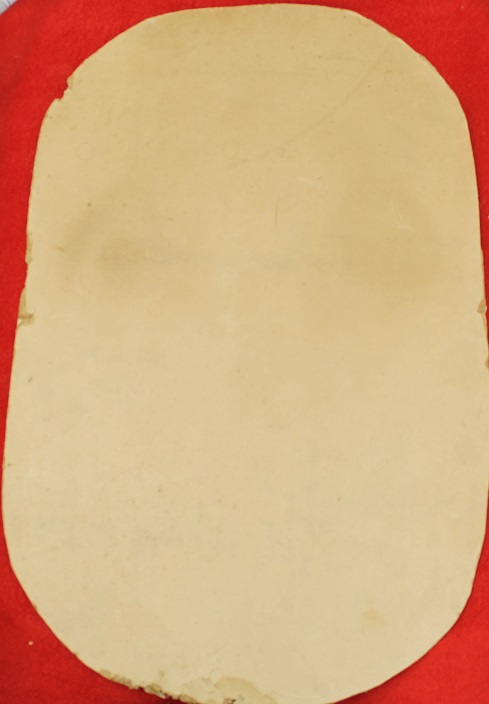
p>TC paper 70
Here we have a souvenir A. Lincoln 1809 1865 image on board. This board came from the Lincoln Board of Philately in Frankfort, Indiana. Nice! $10.00
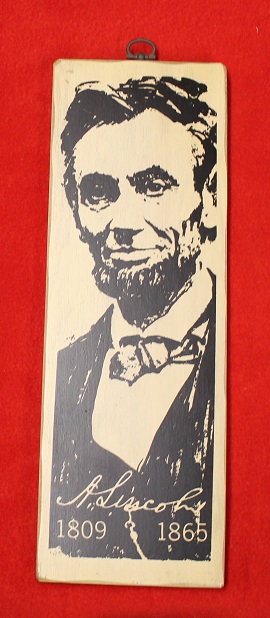
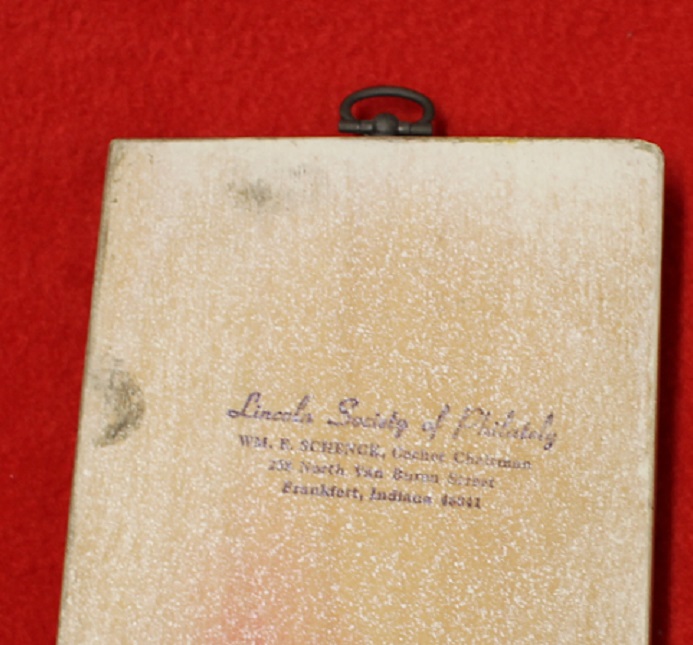
TC paper 69
Here we have 4 colorized prints from Parker Historic Prints! These are a set of 4 unframed prints that show The 2nd Rhode Island infantry 1861, the 14th Wisconsin Volunteer Infantry,1862, The 6th New York Cavalry and a Captain of the U.S. Light Artillery, 1864. All are in excellent conditon and ready to be framed. One frame is included with the set. Each print is 7 by 5 inches and has the description sheet included. All for $10.00
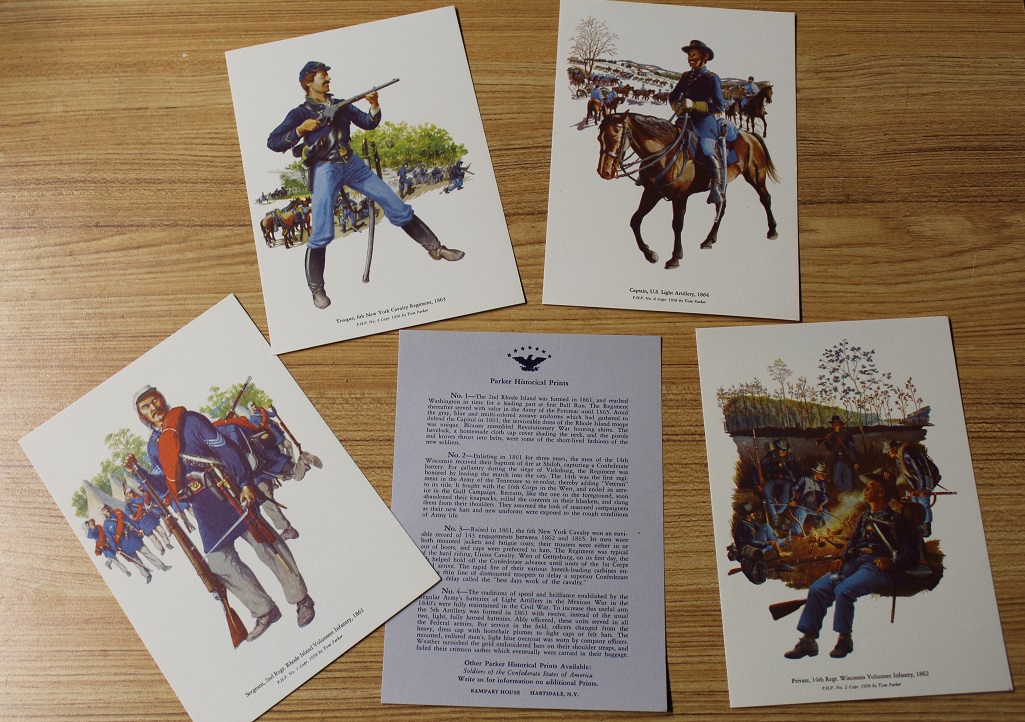
TC paper 68
Here we have a reenactors tintype in large format. The tintype measures 8 x 8 inches and is very clear. $25.00
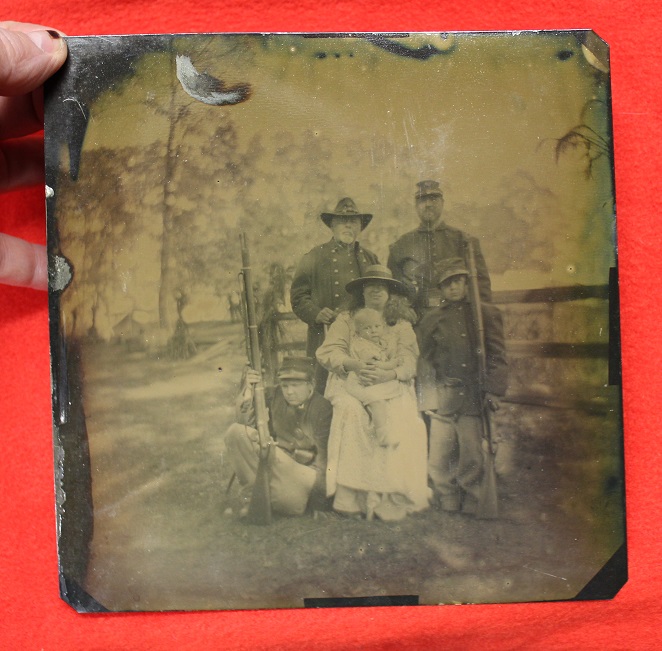
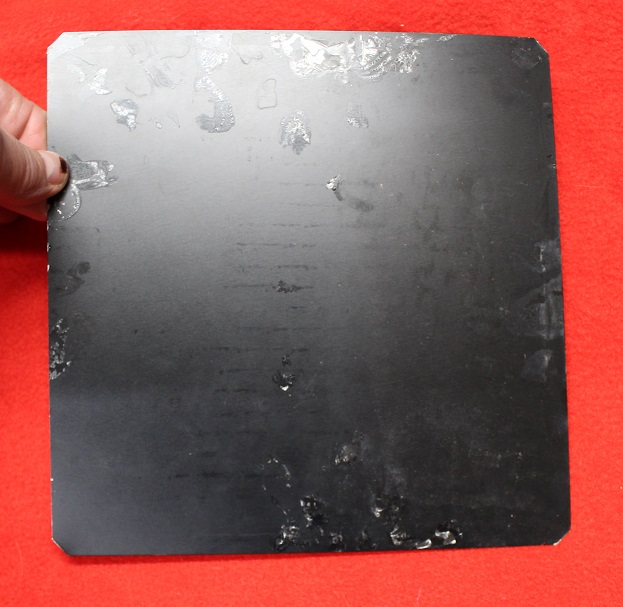
TCpaper 67
Here is a large print of an original Benjamin Harrison image who was president from (1889-1893). President Harrison was born in North Bend, Ohio in 1833 and Died in Indianapolis, Indiana in 1901. There is one small tear on the left side of the image but framed up I doubt if you will ever see it or it will not be noticeable. The image measures 15 X nearly 11 inches on heavy glossy photo paper. $5.00
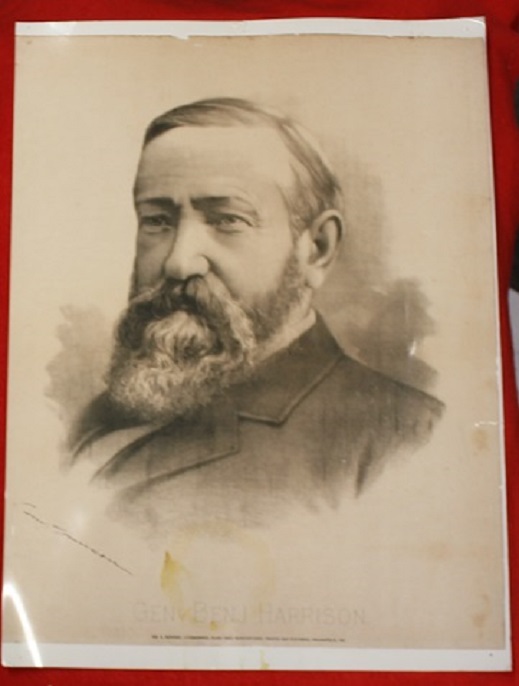
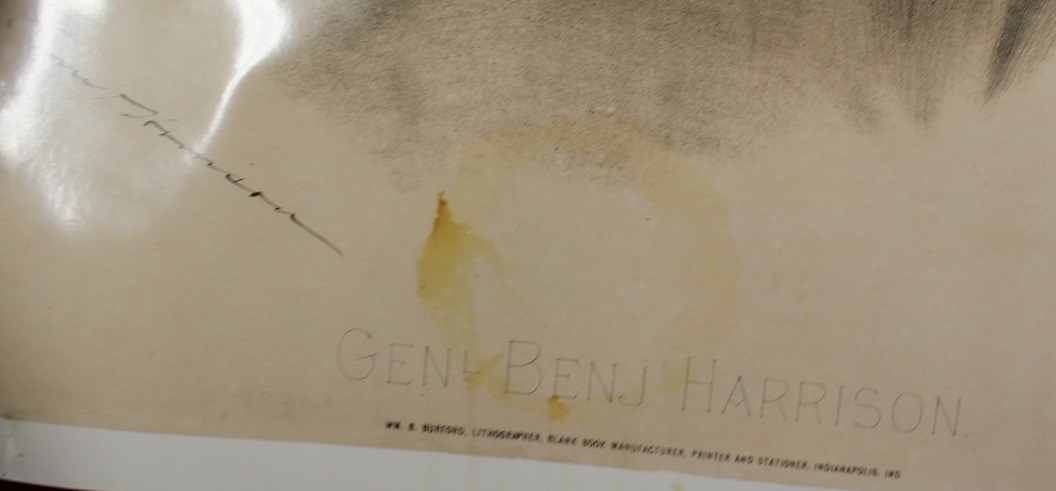
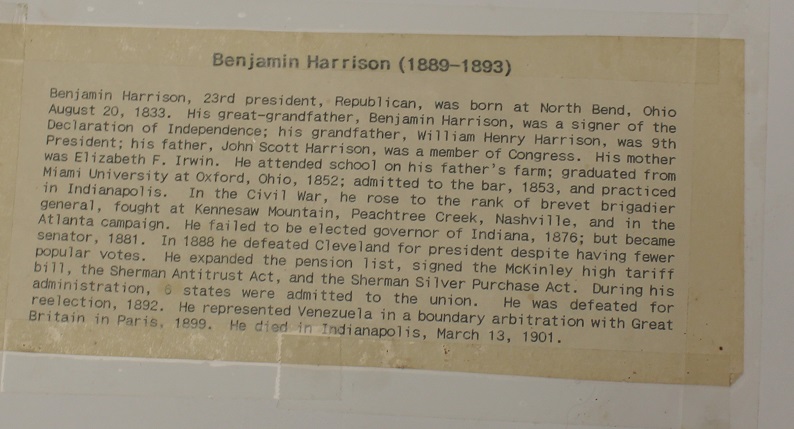
TC paper 66
Color Print in frame of Civil War reenactors. Don't know who they are but they look great! 4 X 6 format. $2.00
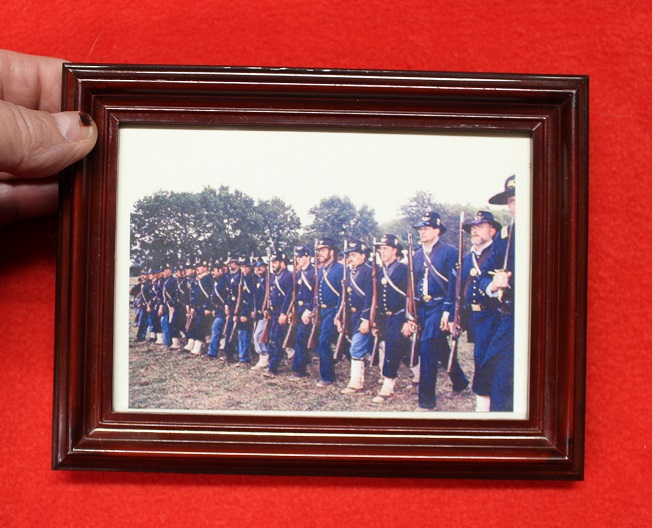
TC paper 65
Here is an original Civil War book plate entitle President and Cabinet showing President Lincoln and his war time cabinet. I believe this one is from 1864. The plate itself measures 6 X 9 inches. $45 Framed
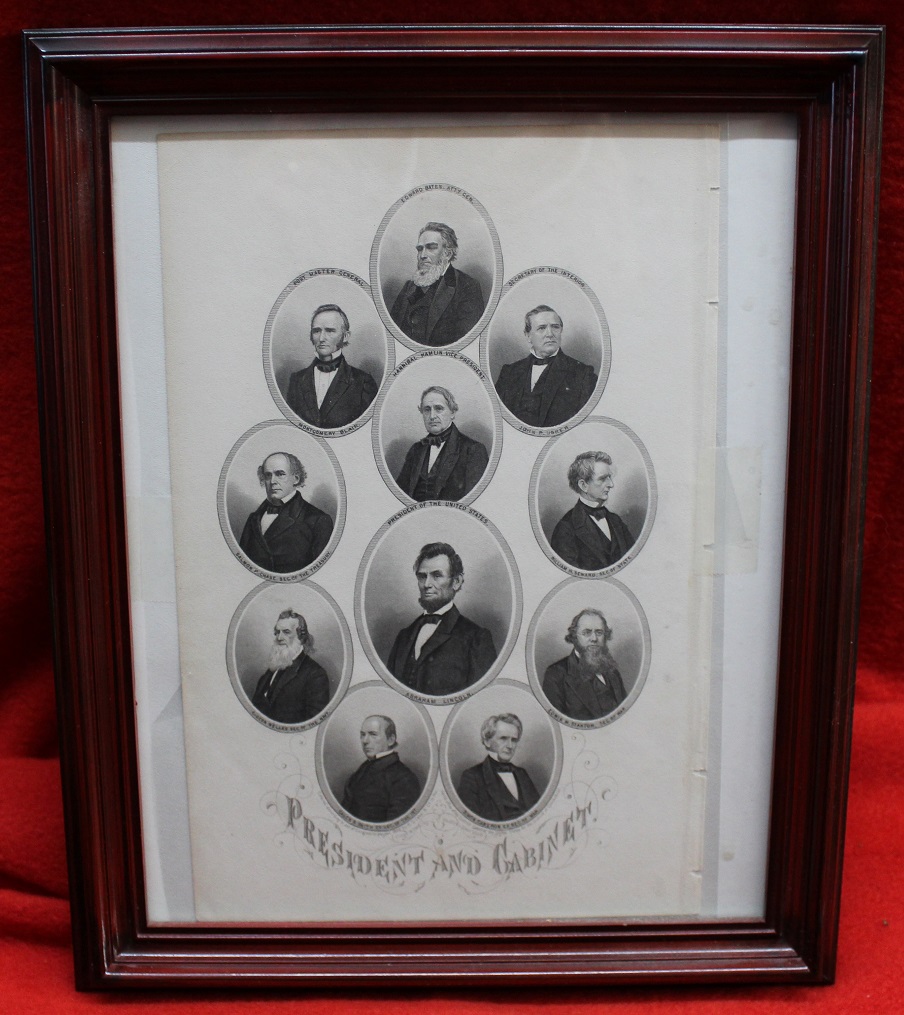
TC paper 64
Here we have a matted and framed general order from the Civil War. This is General Order No. 217 which deals with Covington, KY and the area around it being added to the Northern Department under the command of Major General Heintzelman. $65.00
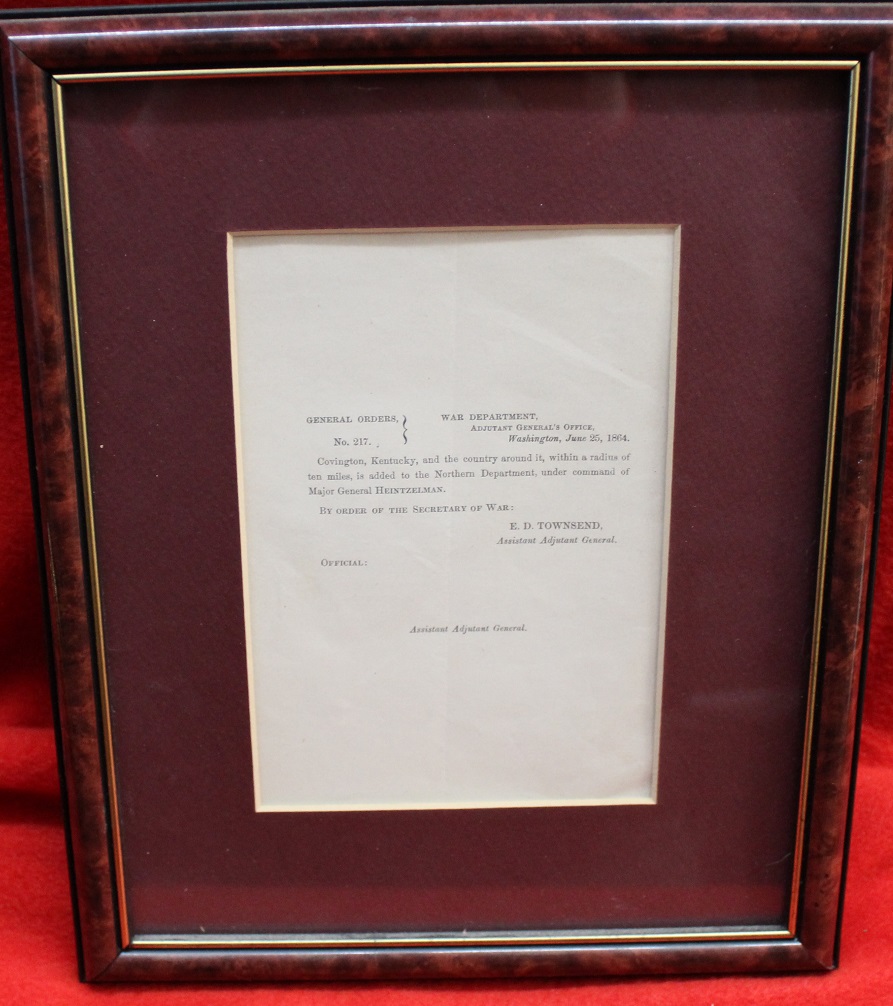
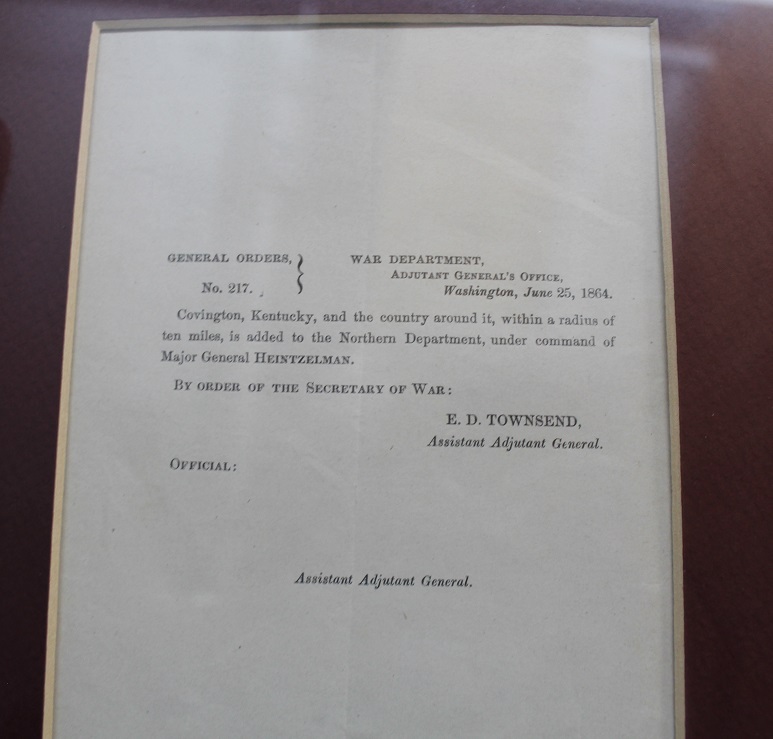
TC paper 63
Here we have a framed Form No. 5 concerning the discharge soldier, Thomas G. Johanson of C company 16th Regiment of Mass. Volunteers. The document fills up the frame measuring 8 X 10 inches. The document is in pretty good condition. $45.00
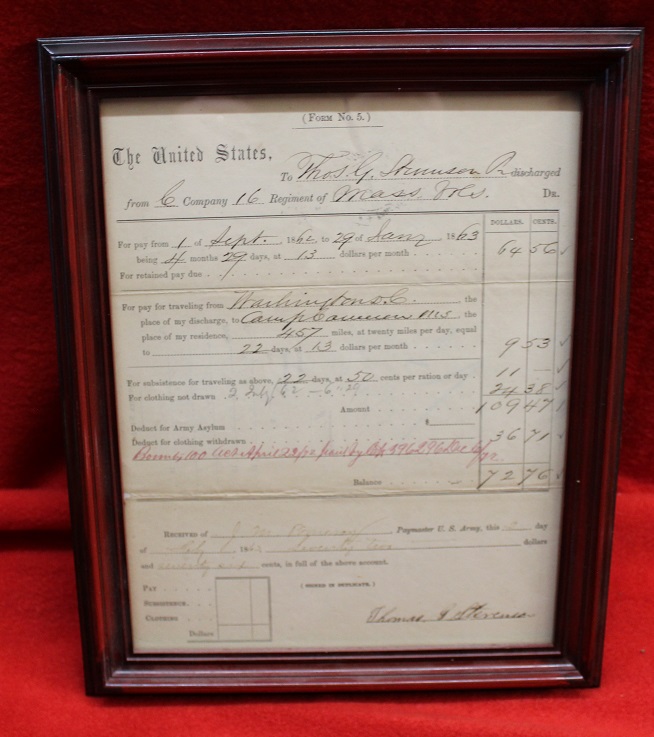
TC paper 62
October, 1865 Monthy Return of Quartermaster's Stores for a Surgical USA unit. Folded and Framed for display. Soiled but still in pretty good condition. $45.00
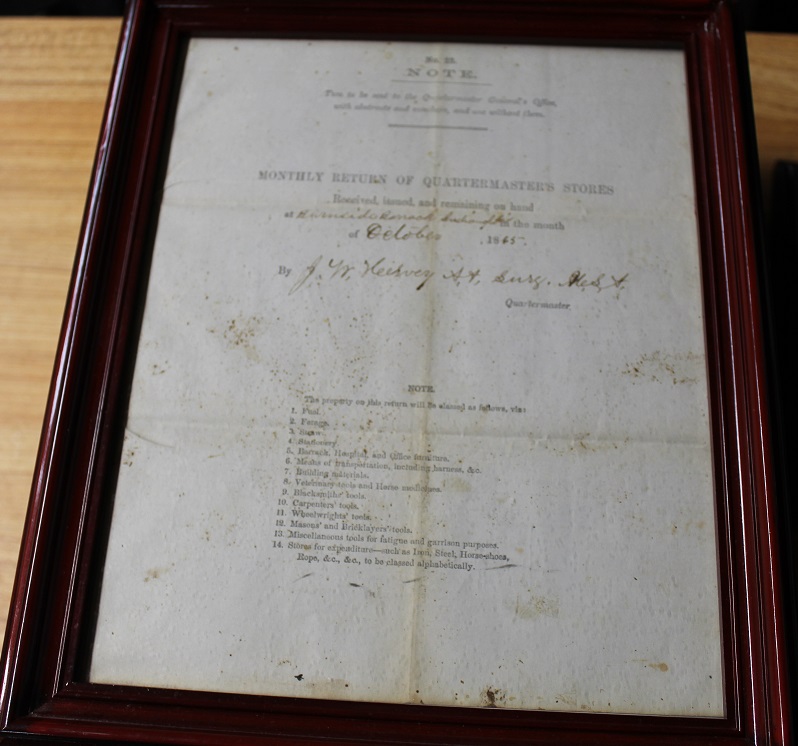
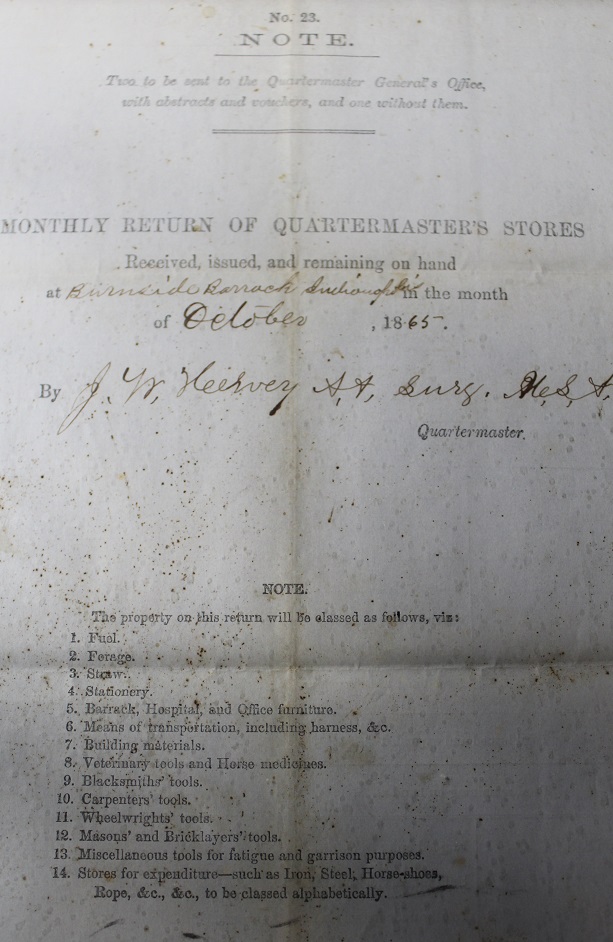
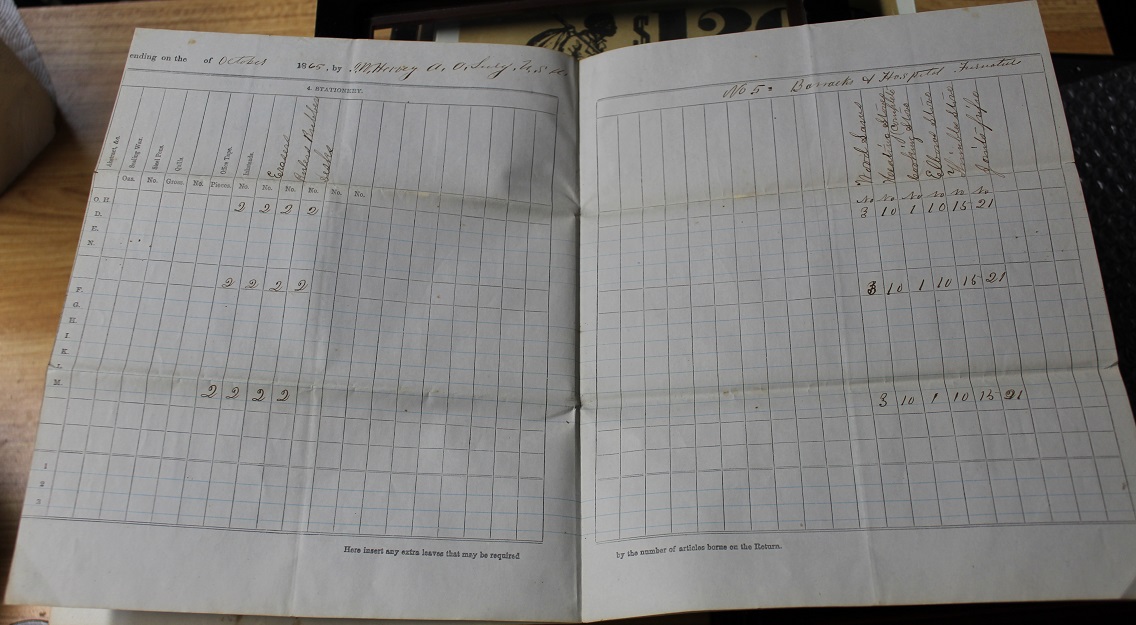

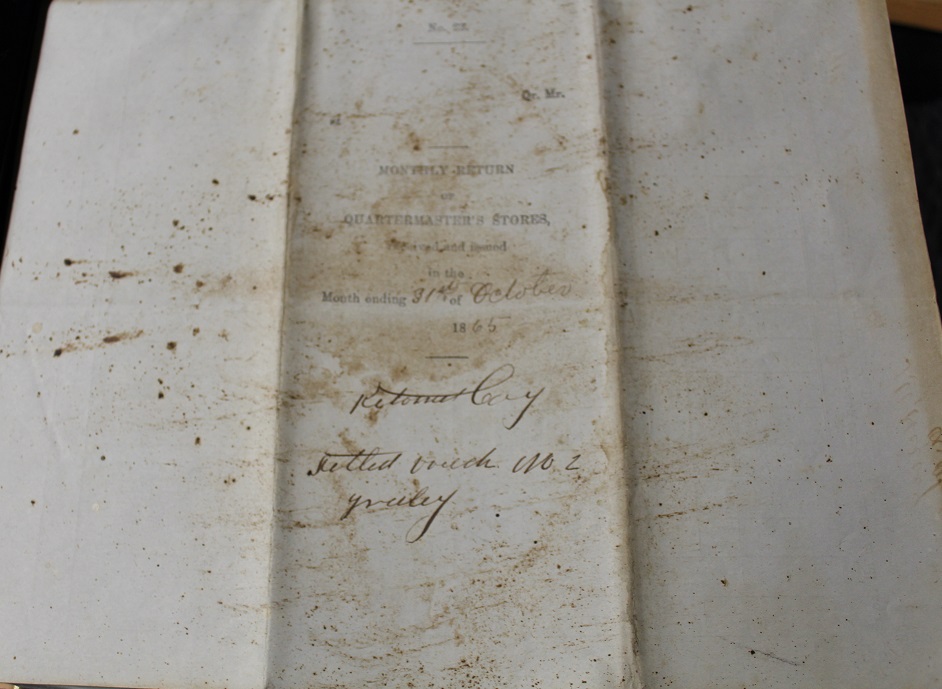
TC paper 61
Here we have reproduction add wanting to purchase Negro's. It's framed and ready to hang on the wall. Don't forget our history! We don't want to repeat it! $10.00
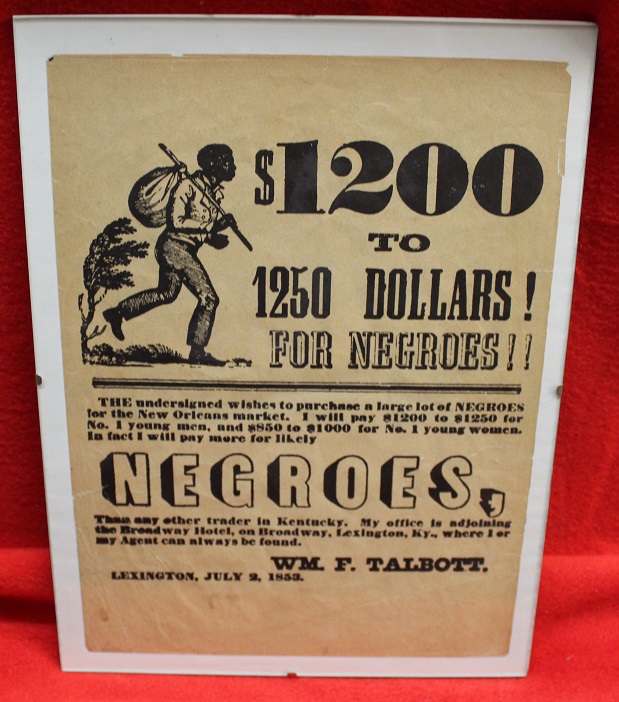
TC paper 60
Here we have a Civil War Commemorative Wall hanging that includes original/real Postage Stamps and a reproduction Medal. Distributed by A.H.S. 1996, and numbered #1463. There are seven stamps (date of issue listed): Battle of Gettysburg - 1963 Battle of the Wilderness - 1964 Grand Army of the Republic - 1949 Battle of Fort Sumter - 1961 Battle of Shiloh - 1962 United Confederate Veterans - 1951 A certificate of Authenticity for the stamps is included. It states: "This certifies that the Postage Stamps contained herein have been examined by the American Historic Society and declared to be genuine U.S. Postage. The medal is a recreation of the original. Housed in a 9 X 11 sealed frame. Nice! $25.00
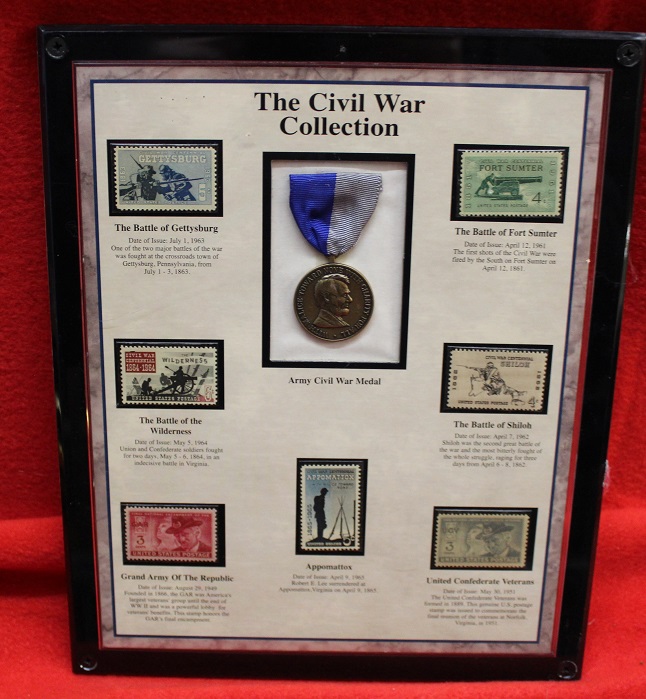
TC paper 59
Here we have a colorized print of General U.S.Grant with an Appomattox 5c commemorative stamp mounted below. The glass is broken but I will try to replace it. $8 with the broken glass or $10 fixed.
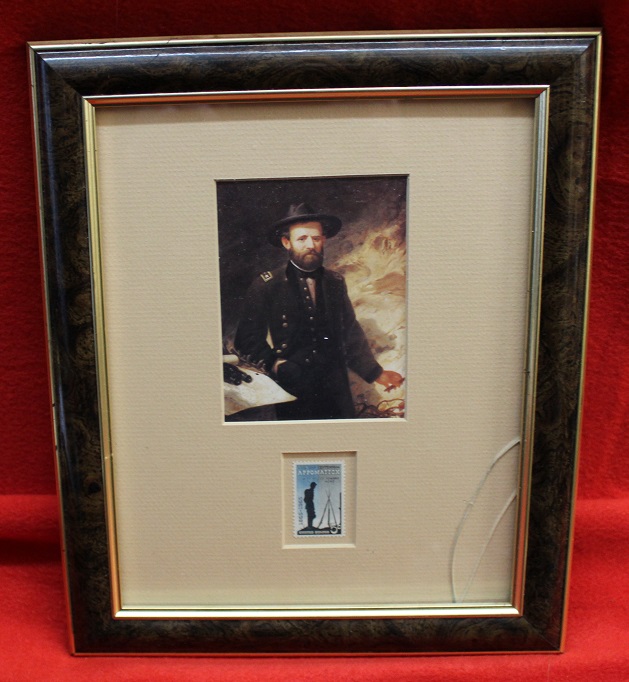
TC paper 58
Here we have an 8 X 10 reprint of an original Civil War photo entitled Freedericksburg VA Confederate Dead Sunken road at the foot of Marye's Heights. (chancellorville campaign) #409 LEIB Image Archives, York, PA 1863. Nice in a frame. $10.00
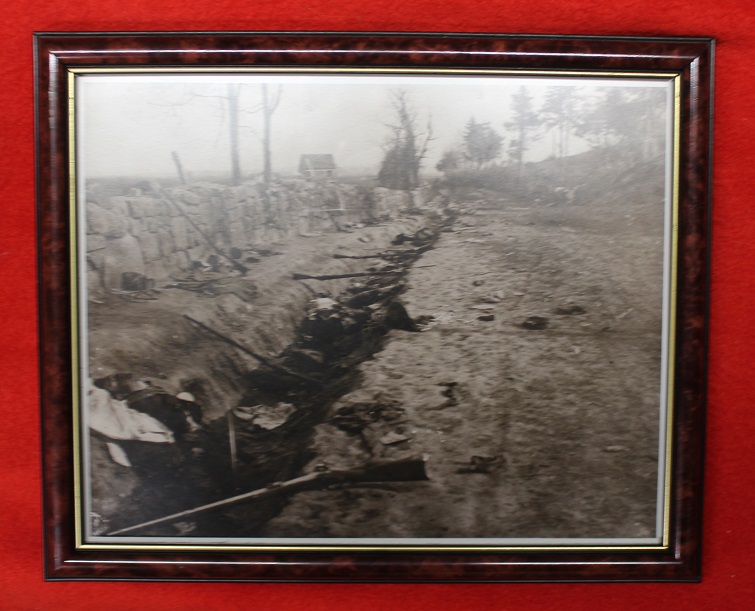
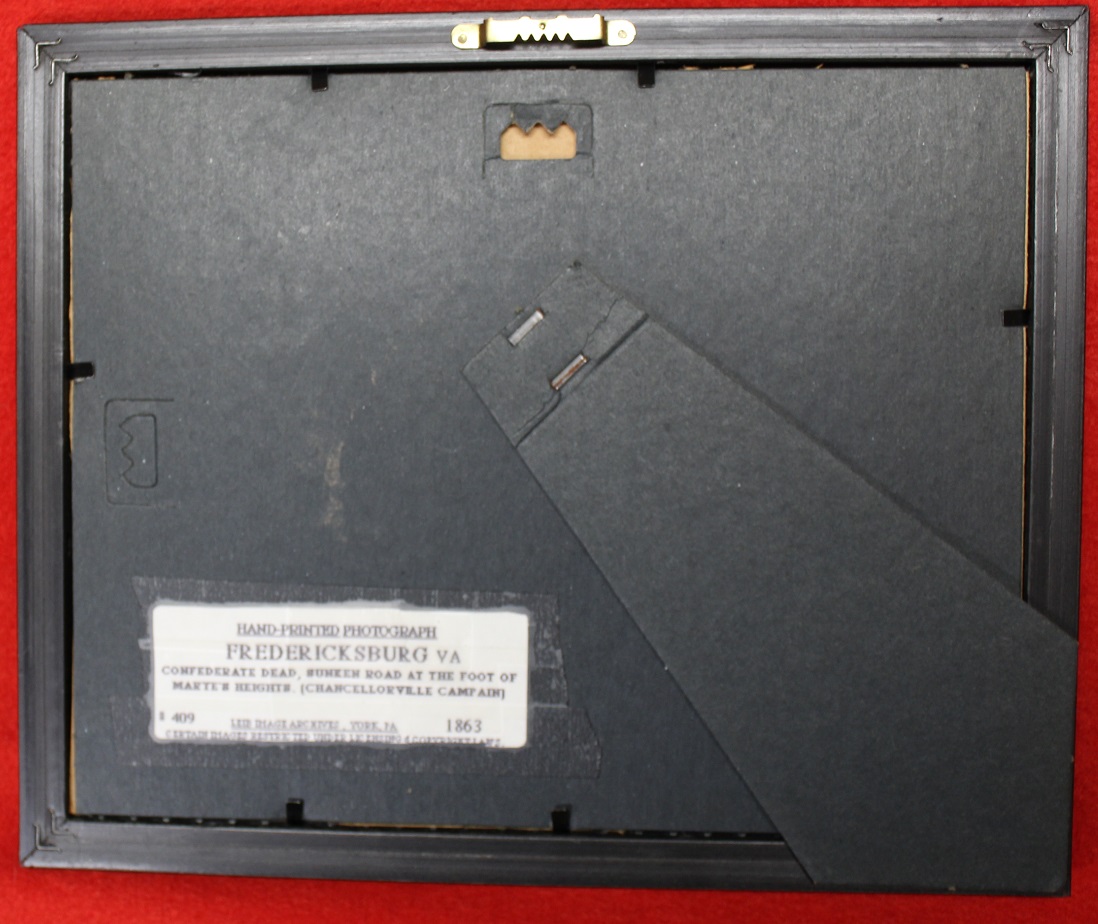
TC paper 57
Here we have a standing nearly knees up image of President Abraham Lincoln in 8 X 10 format. Nice reprint of an original image in frame. Nice! $10.00
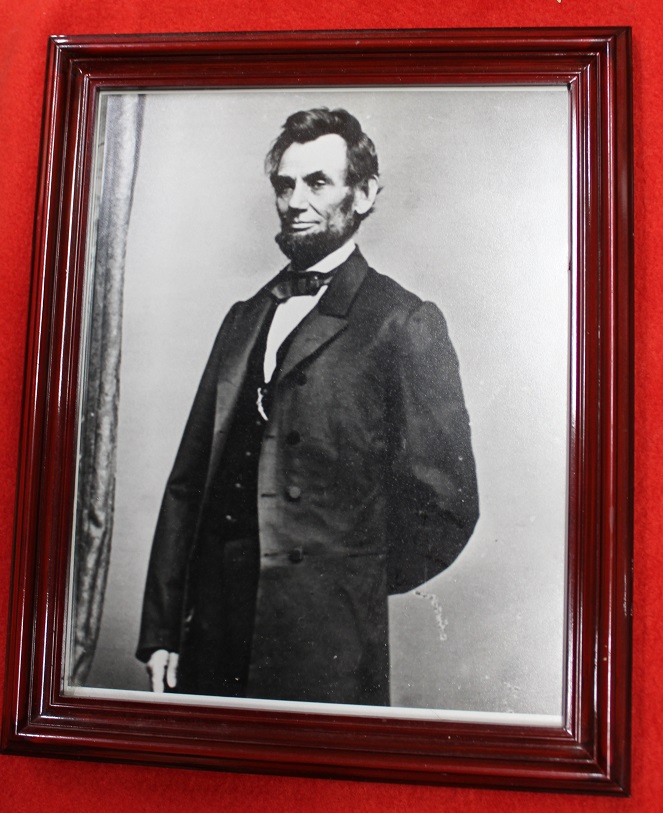
TC paper 56
Here we have President Lincoln's National Thanksgiving Proclamation, 1863 in Frame over his image. 8 X 10 inch format. Nice! $10.00
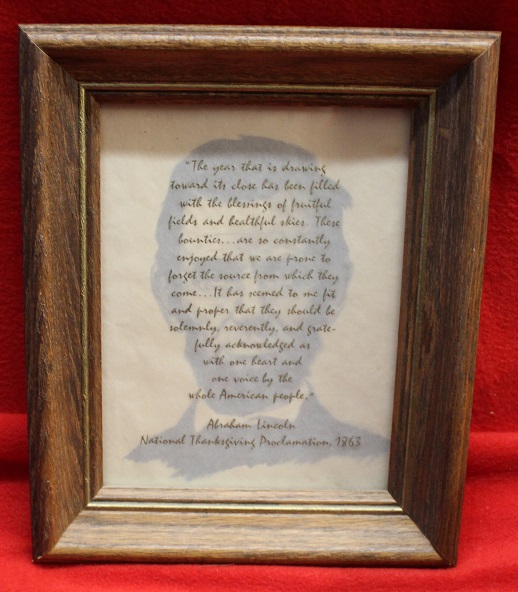
TC paper 55
Here we have an old homestead black and white photo that I have no idea where it was taken and there is nothing written on the back. This is not an old photo but I believe it was copied from an old photo. Nicely framed! $8.00
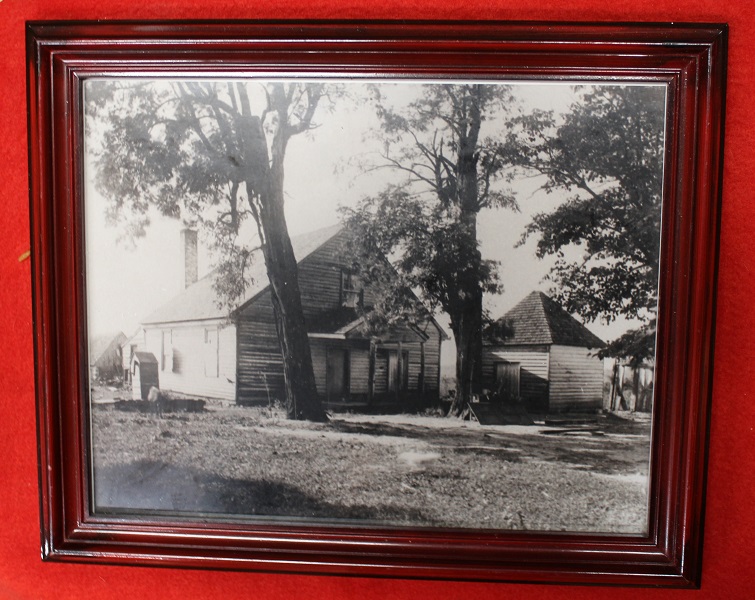
TC paper 54
Here we have 3 documents that was given US and CS Reenactors for appreciation in their participation in Indiana Reenactments. One is dated Sept 14 & 15, 2002 in Mooresville, Indiana, one is dated September 16 & 17 2000 in Mooresville, Indiana and the last one is dated September 18 & 19, 2004 in Mooresville, IN. All were done in Pioneer Park in that community. For the 3 framed pieces $15.00
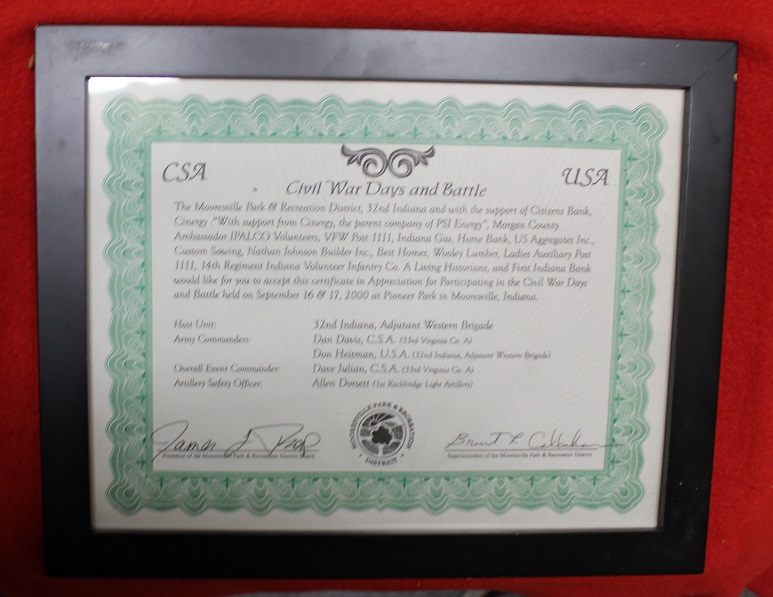
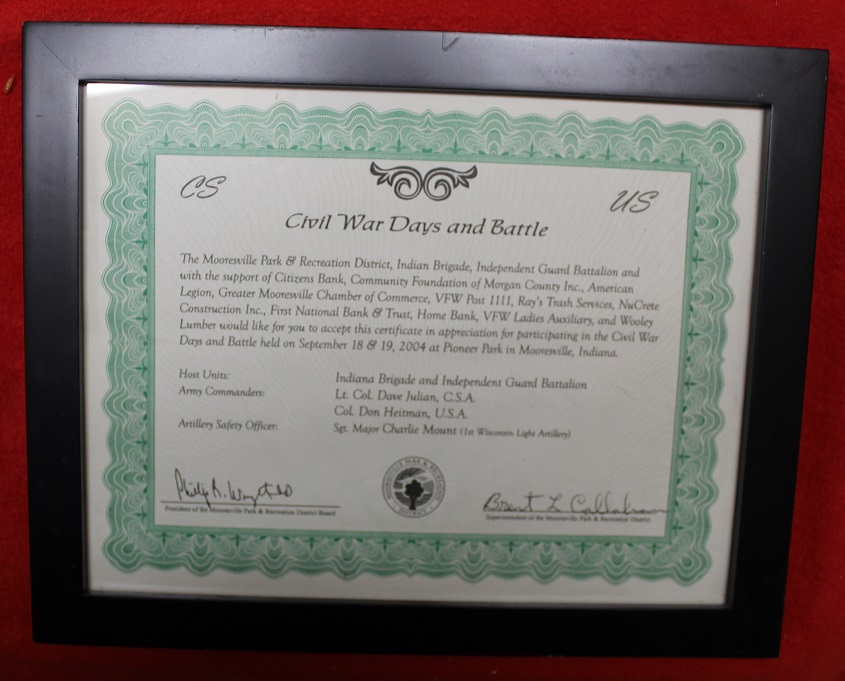
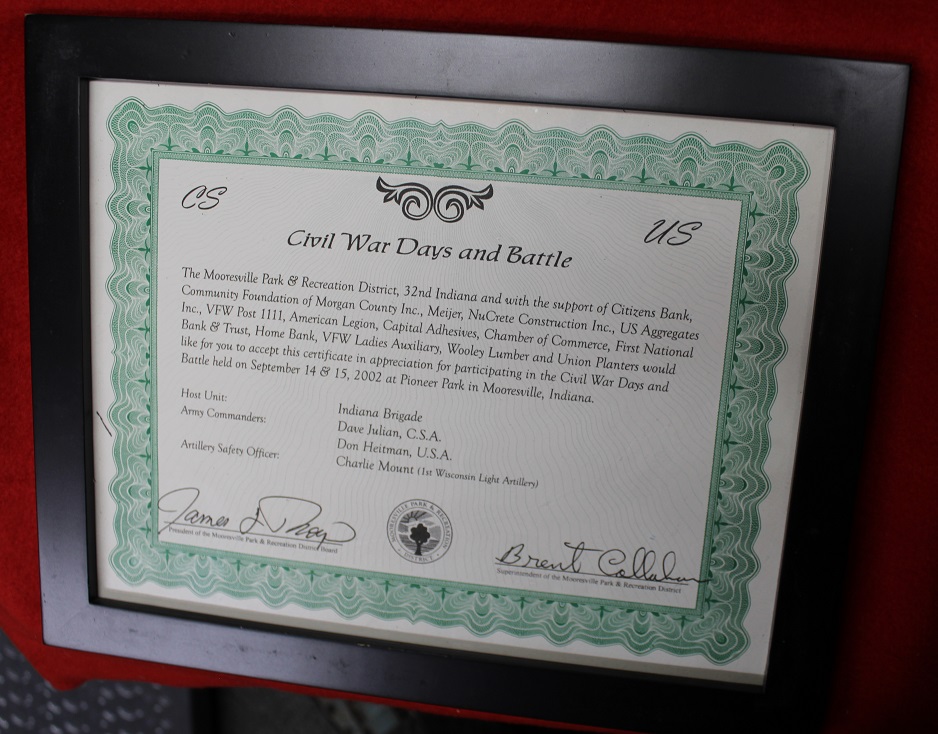
TC paper 53
Here we have a colorized Gettysburg Battlefield Position Map dated July 2nd (1863) that was printed on 12/24/02 and placed in this nice frame. The image is 8 1/2 X 11 inches and just beautiful! Nice! $12.95
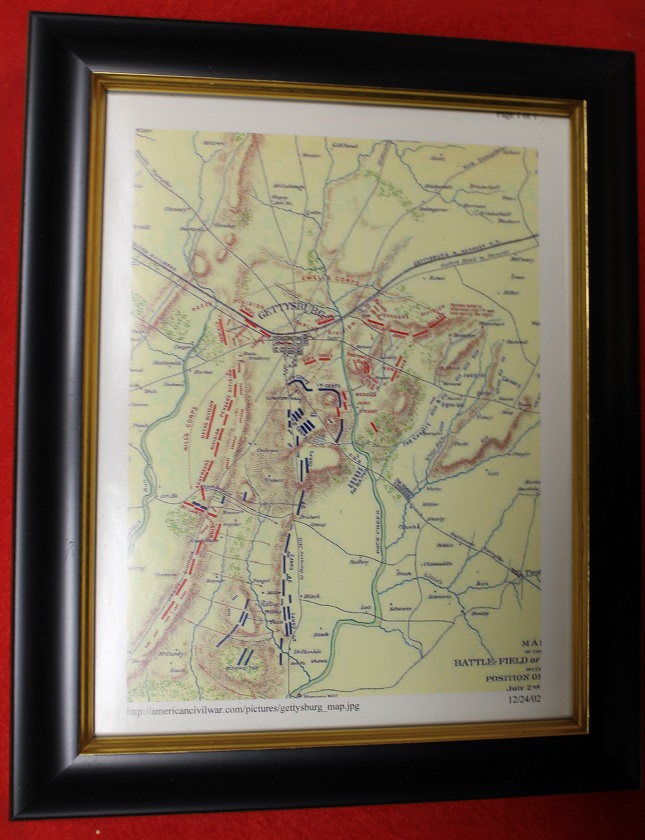
TC paper 52
Here we have 2 modern postcard photographs of original General Joshua Chamberlain photos when he was Colonel double matted and framed in a 11 X 14 frame. It looks just beautiful and would look great on the wall or desk in your Den or Relic Room! 20th Maine at Gettysburg!!! $15.00
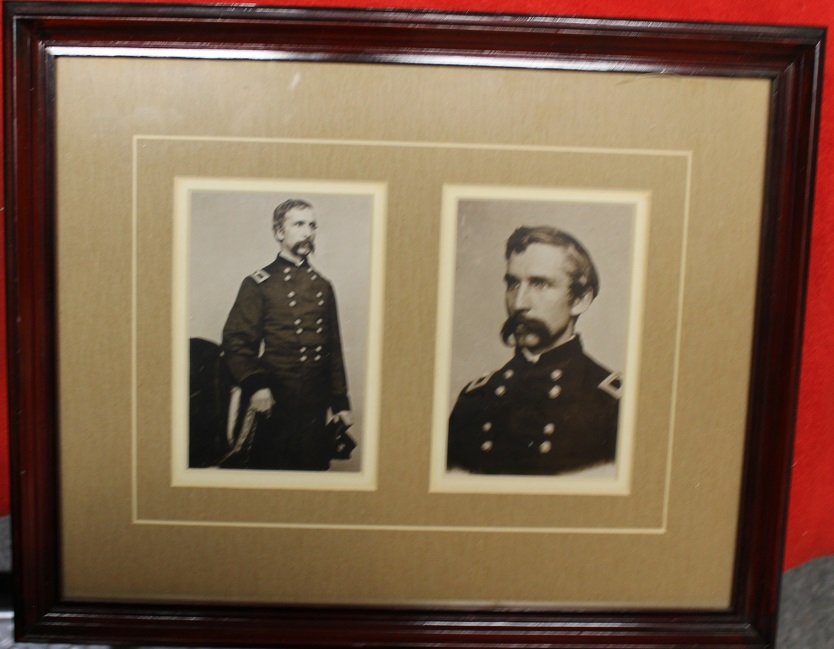
TC paper 51
Here we have a double matted copy image of an original taken in 1864 by Matthew Brady in Washington,D.C. This piece was given out by the Lincoln National Life Insurance Company and has a cancelled stamp of President Lincoln mounted to it. The cancellation is for Jun 20, 1967 from Fort Wayne, Indiana where the Insurance company is located. Nice piece in a 8 X 10 inch format. For this piece $10.00
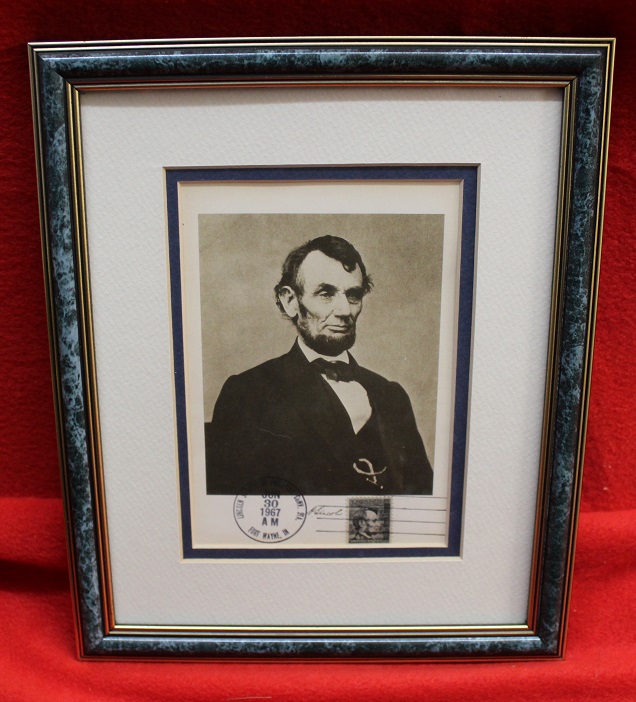
TC paper 50
Here we have a framed Civil War Artillery scene about a Gettysburg Stamp marked 1864-1963 so it's for the 100th year anniversary of the battle! This piece is from Stamp Works Postal Art.
$29.95
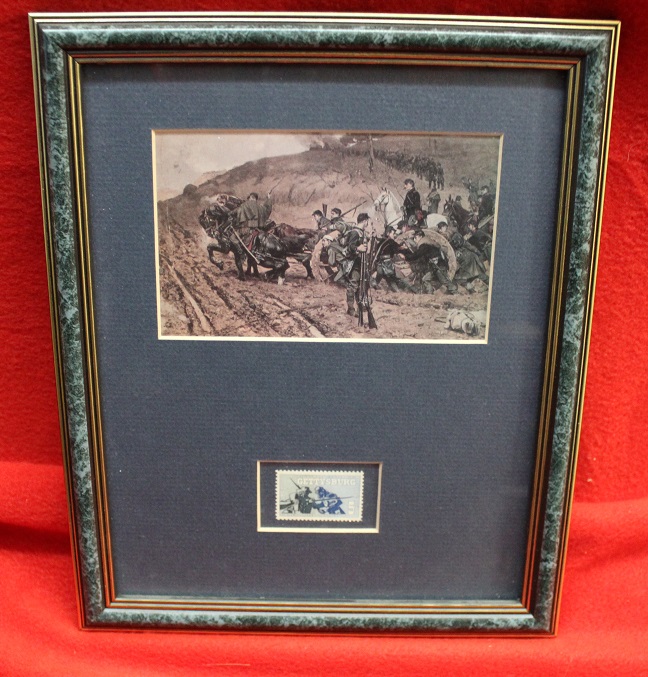
TC paper 49
Here we have a framed Stamp Works Postal Art image of CSA General James Longstreet framed along with 1864-1964 100 year anniversary stamp of the Wilderness! This is in a 8 X 10 format. Excellent! 8 X 10 format $29.95
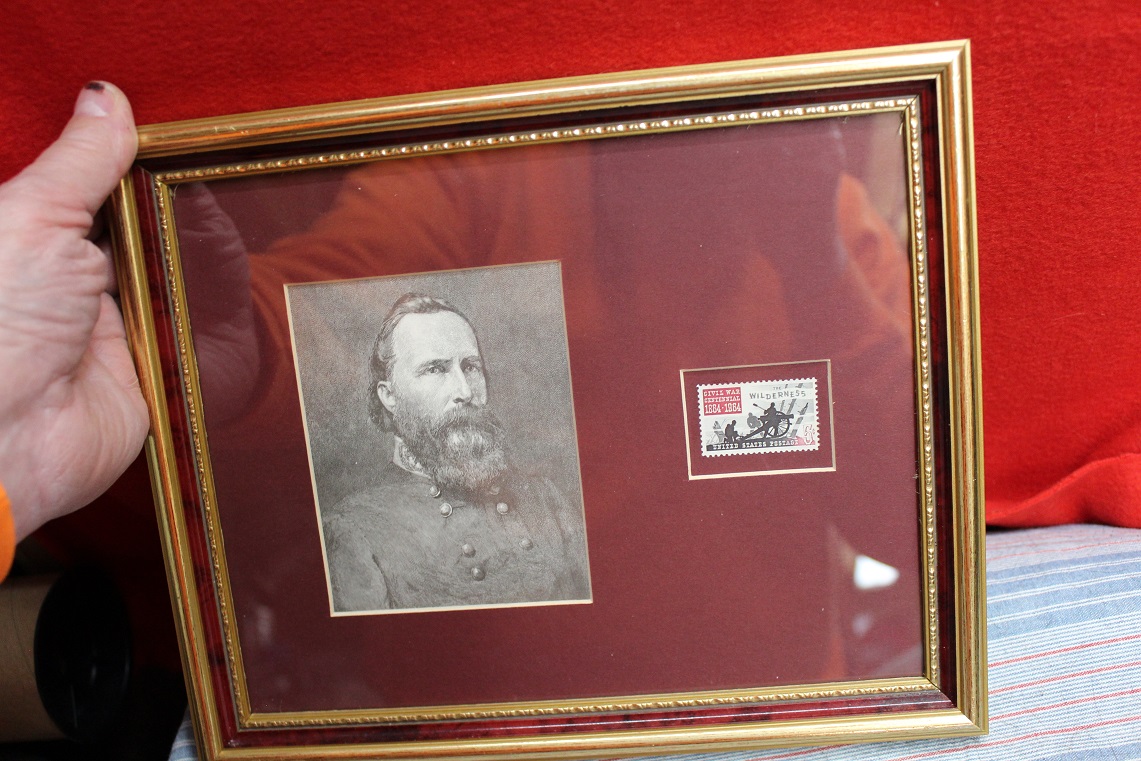
TC paper 48
Here we have a Framed Stamp Works Postal art image of pre president Abraham Lincoln alone with a large 1 cent stamp. Really nice! 8 X 10 inch format. $29.95
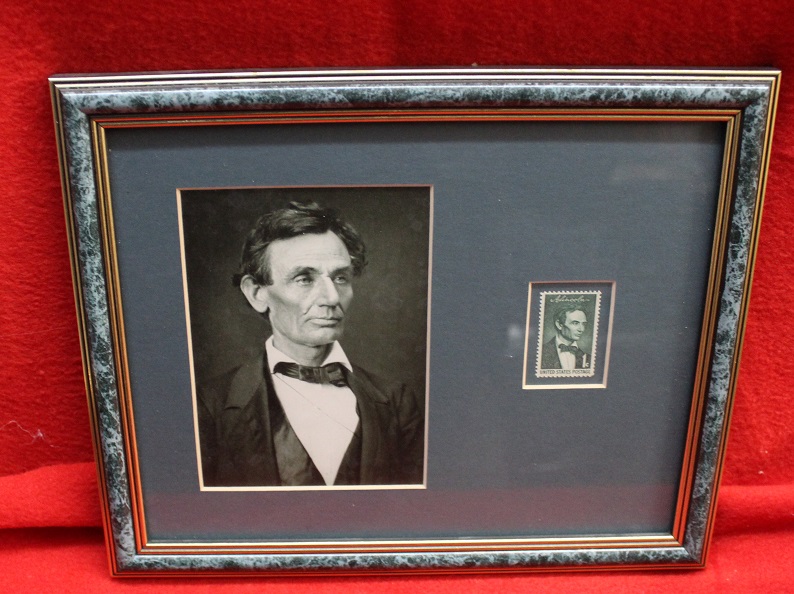
TC paper 47
Here we have a Framed Stamp Works Postal art image of Fort Sumter under fire with a Fort Sumter 4 cent 1861-1961 stamp mounted underneath the image. This is where the Civil War Started! Perfect condition! $29.95
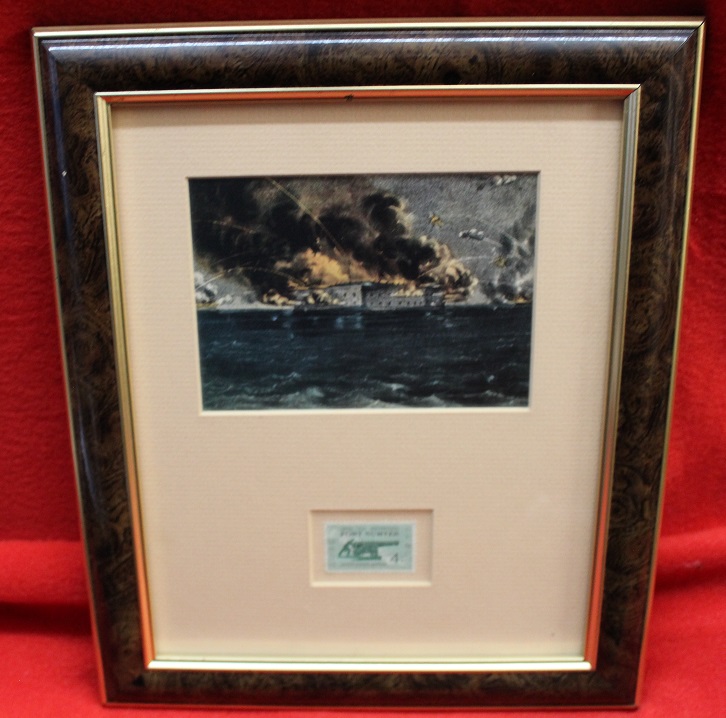
TC paper 46
Here we have a Framed Stamp Works Postal art image of CSA General Robert E. Lee mounted alongside a R.E.Lee 30 cent stamp. This is in a 8 X 10 inch format and just perfect! Ready to hang or place on your desk! $29.96
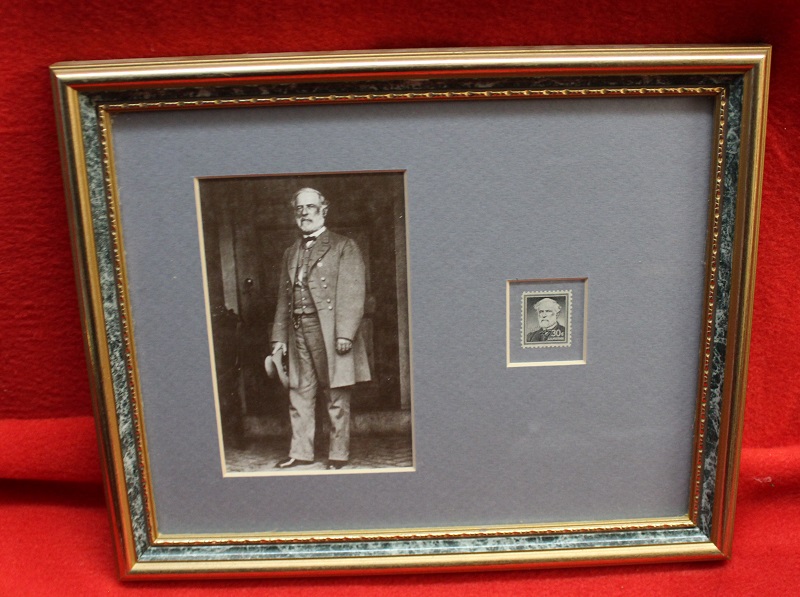
TC paper 45
Here we have a framed Civil War Artillery scene about a Gettysburg Stamp marked 1864-1963 so it's for the 100th year anniversary of the battle! This piece is from Stamp Works Postal Art.
$29.95

TCpaper 44
Here we have a framed Stamp Works Postal Art image of CSA General James Longstreet framed along with 1864-1964 100 year anniversary stamp of the Wilderness! This is in a 8 X 10 format. Excellent! 8 X 10 format $29.95

TC paper 43
Here we have a Framed Stamp Works Postal art image of pre president Abraham Lincoln alone with a large 1 cent stamp. Really nice! 8 X 10 inch format. $29.95

TC paper 42
Here we have a Framed Stamp Works Postal art image of Fort Sumter under fire with a Fort Sumter 4 cent 1861-1961 stamp mounted underneath the image. This is where the Civil War Started! Perfect condition! $29.95

TC paper 41
Here we have a Framed Stamp Works Postal art image of CSA General Robert E. Lee mounted alongside a R.E.Lee 30 cent stamp. This is in a 8 X 10 inch format and just perfect! Ready to hang or place on your desk! $29.96

TC paper 40
Here we have a Framed Stamp Works Postal art image of the battle at Gettysburg along with 2 stamps. The 5 cent stamp on the left signifies the battle of Gettysburg dating it 1863-1963 while the other stampe is a 3 cent stamp designating the Grand Army of the Republic. This is in the 8 X 10 inch format. Excellent $29.95
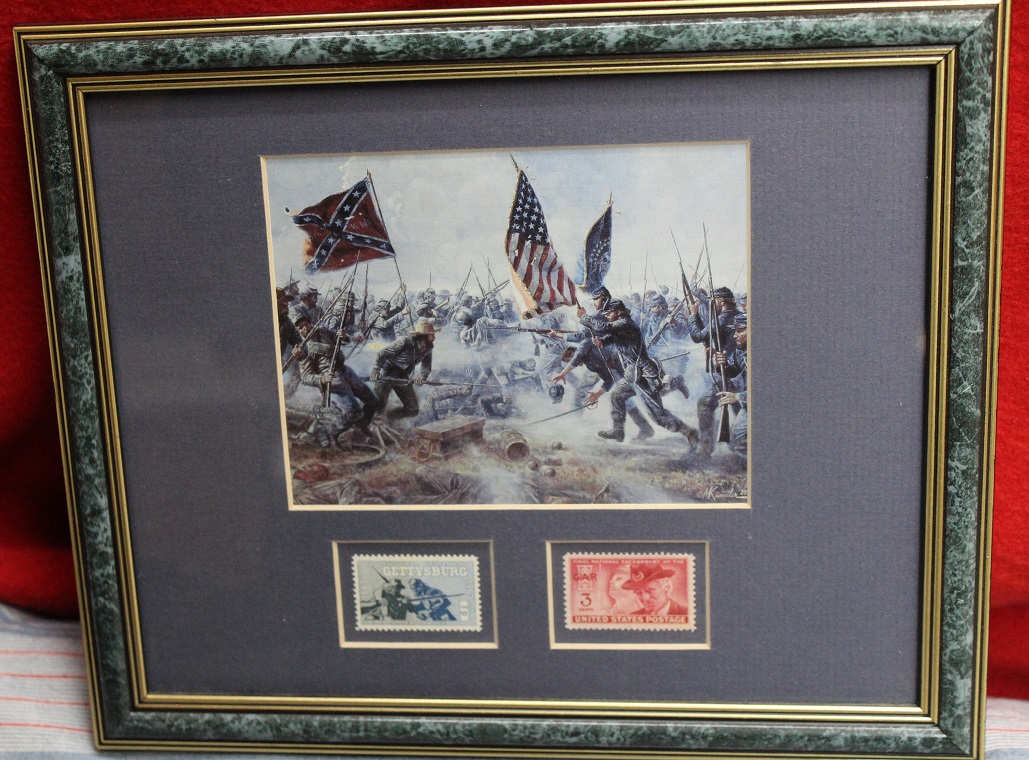
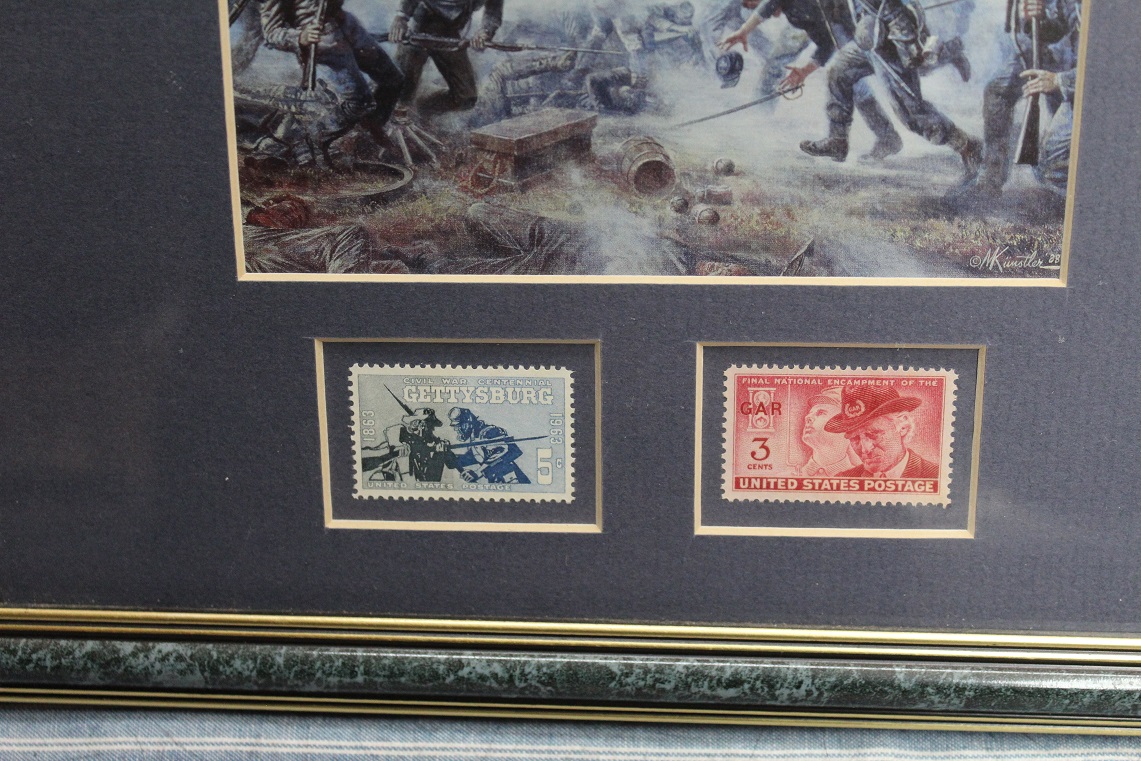
TC paper 39
Here we have a double matted copy image of an original taken in 1864 by Matthew Brady in Washington,D.C. This piece was given out by the Lincoln National Life Insurance Company and has a cancelled stamp of President Lincoln mounted to it. The cancellation is for Jun 20, 1967 from Fort Wayne, Indiana where the Insurance company is located. Nice piece in a 8 X 10 inch format. For this piece $10.00

TC paper 38
Here we have a framed Civil War Artillery scene about a Gettysburg Stamp marked 1864-1963 so it's for the 100th year anniversary of the battle! This piece is from Stamp Works Postal Art.
$29.95

TC paper 37
Here we have a framed Stamp Works Postal Art image of CSA General James Longstreet framed along with 1864-1964 100 year anniversary stamp of the Wilderness! This is in a 8 X 10 format. Excellent! 8 X 10 format $29.95
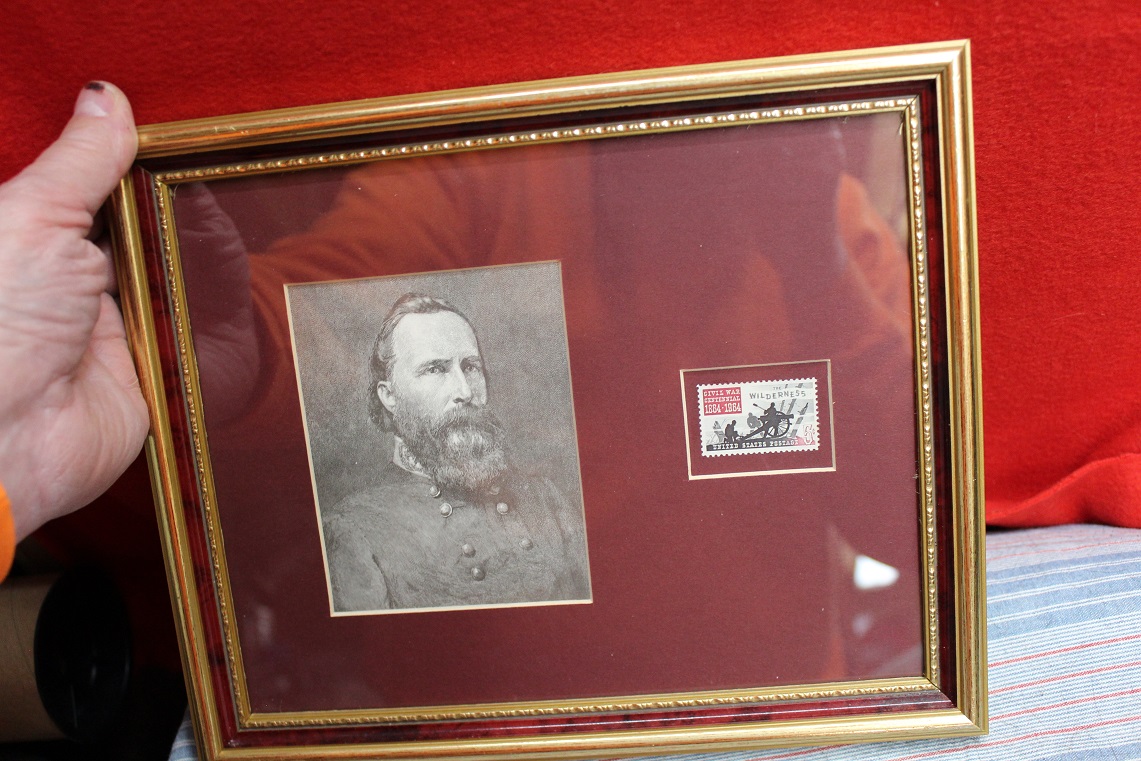
TC paper 36
Here we have a Framed Stamp Works Postal art image of pre president Abraham Lincoln alone with a large 1 cent stamp. Really nice! 8 X 10 inch format. $29.95

TC paper 35
Here we have a Framed Stamp Works Postal art image of Fort Sumter under fire with a Fort Sumter 4 cent 1861-1961 stamp mounted underneath the image. This is where the Civil War Started! Perfect condition! $29.95

TCpaper 34
Here we have a Framed Stamp Works Postal art image of CSA General Robert E. Lee mounted alongside a R.E.Lee 30 cent stamp. This is in a 8 X 10 inch format and just perfect! Ready to hang or place on your desk! $29.96

TC paper 33
Here we have a Framed Stamp Works Postal art image of the battle at Gettysburg along with 2 stamps. The 5 cent stamp on the left signifies the battle of Gettysburg dating it 1863-1963 while the other stampe is a 3 cent stamp designating the Grand Army of the Republic. This is in the 8 X 10 inch format. Excellent $29.95
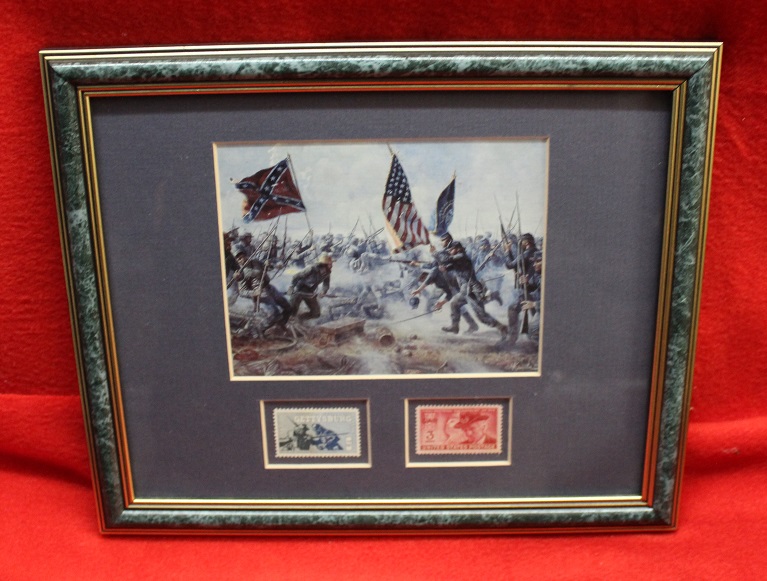
TCpaper 32
Here we have another Framed Stamp Works Postal art image of the battle at Gettysburg along with 1- 32 cent stamp. Take a look at the pic! This piece is outstanding! $29.95
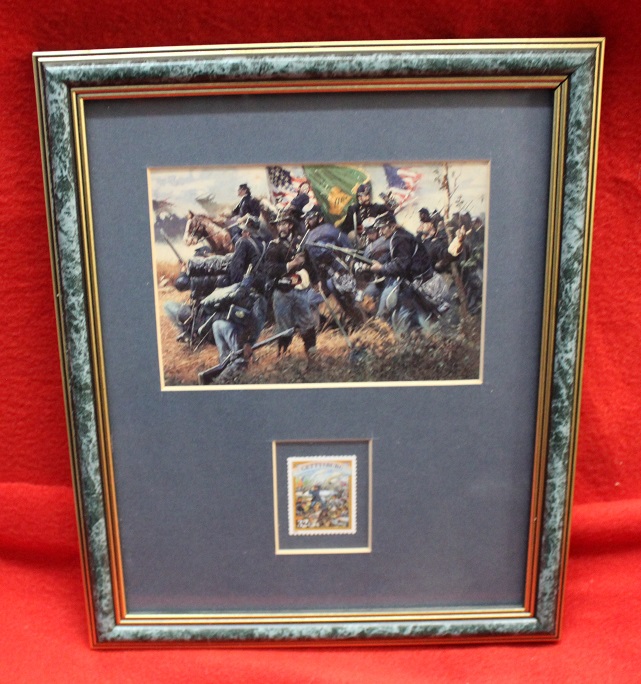
TC paper 31
Here wehave an 8 1/2 X 11 inch reprint of a sketch by AlfredR. Waud, Special correspondent to Harper's Weekly entitled Confederate Prisoners. All framed up and ready to hang. $10.00
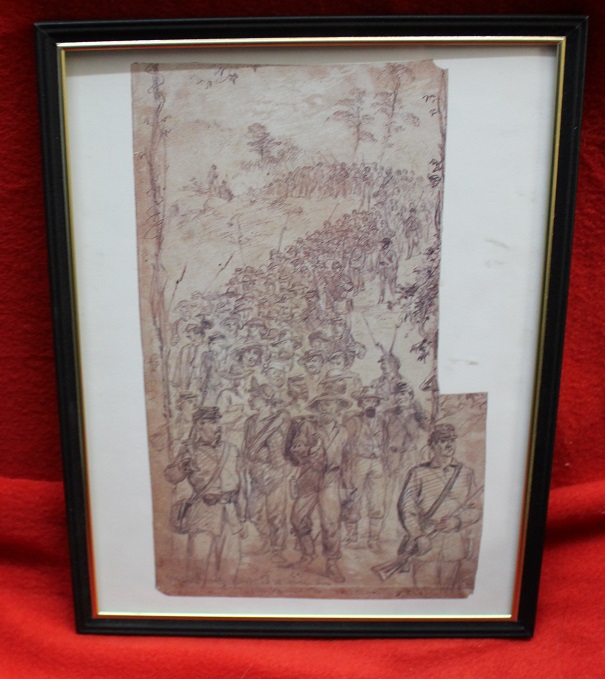
TC paper 30
Here we have a copy print of a drawing done by Charles Reed showing Lt Christopher Erickson of Bigelow's Battery shouting directions to one of his gun crews as he is bleeding profusely from a lung wound. Moments later Erickson fell dead from a head wound. 8 1/2 X 11 inch format. $10.00
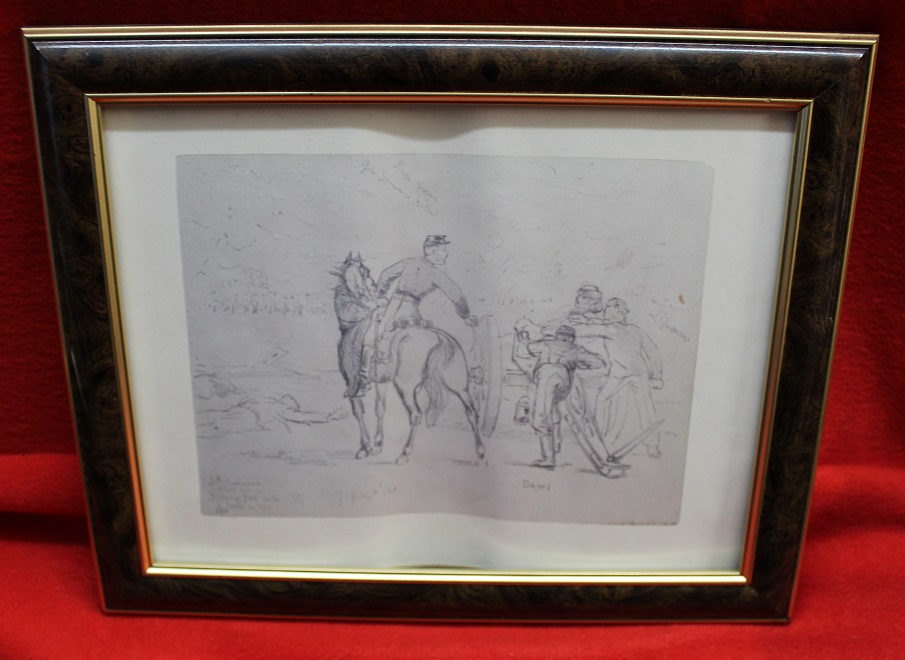
TC paper 29
Here we have an 8 1/2 X 11 inch image of Thomas Jefferson with his quote "Every difference of opinion is not a difference of principal". Already framed and ready to go on the wall. $10.00
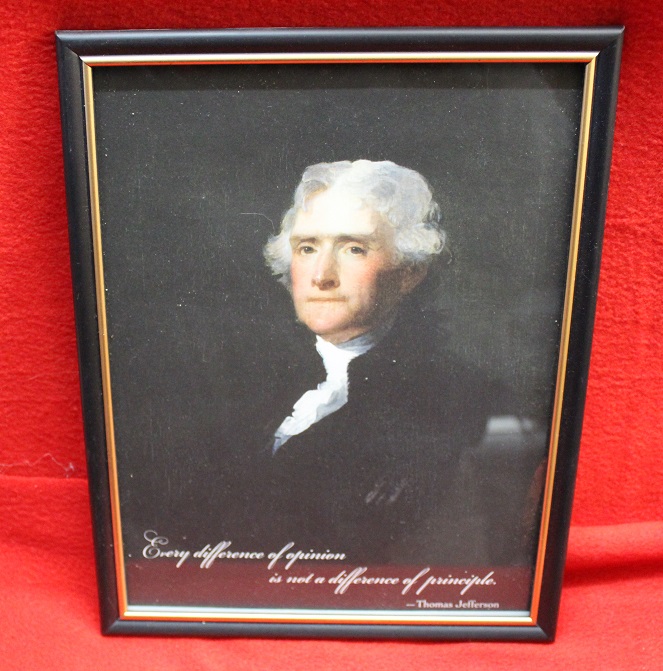
TC paper 28
Here we have a surgical colorized #245d:Engraving of a lower leg removal civil war surgical practice. This is a reprint of the original plate in 8 X 10 frame that is ready to hang or just put on your desk. $10.00
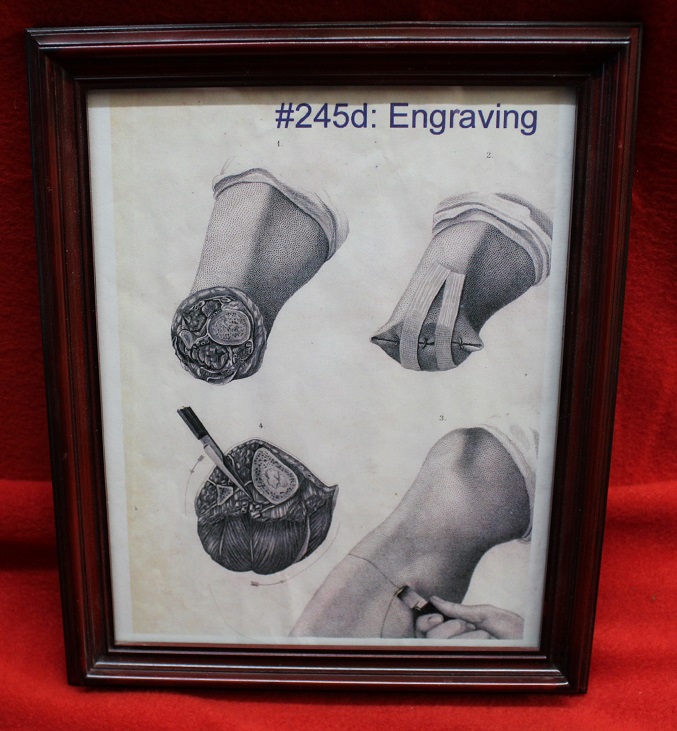
TC paper 27
Here we have a copy of a pencil sketch by Alfred R. Waud, special correspondent to Harper's Weekly. This is on July 2nd in the fading light of the day from a knoll facing the eastern slope of Cemetery Hill. The Main's Battery's six Napoleons poured over a ton of searing metla into the left flak of the North Carolina Brigade as it pressed forward in a gallant, but costly advance up the hill. Framed in a 8 1/2 X 11 inch frame and ready to hang on the wall. $10.00
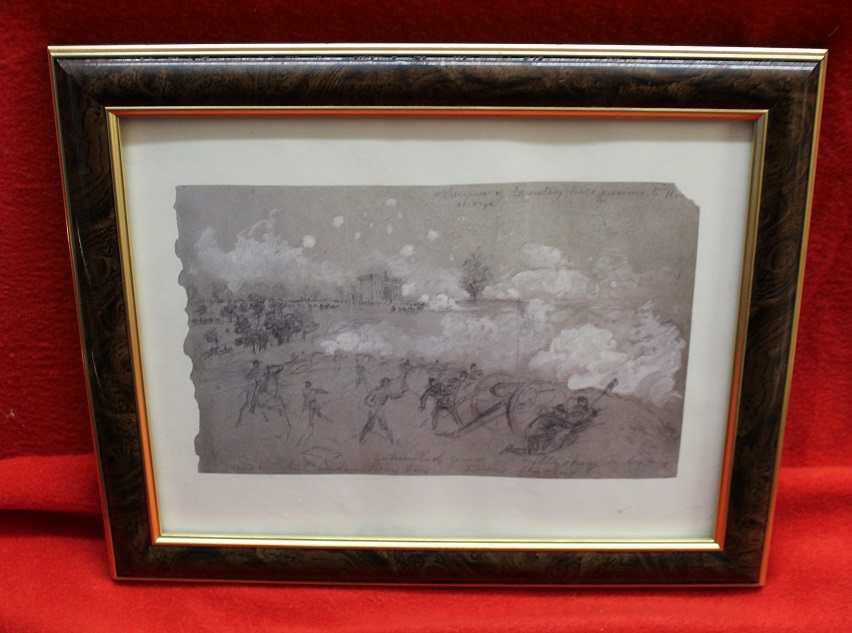
TC paper 26
Here we have a State of Indiana and the War Memorials Foundation certificate honoring the living historians who helped convey Indiana's Civil War history and it's dated 11th of May 2002. The document is signed by R.W.Sweeny, Colonel (Ret.) U.S.A. Executive Director Indiana War Memorials. $10.00
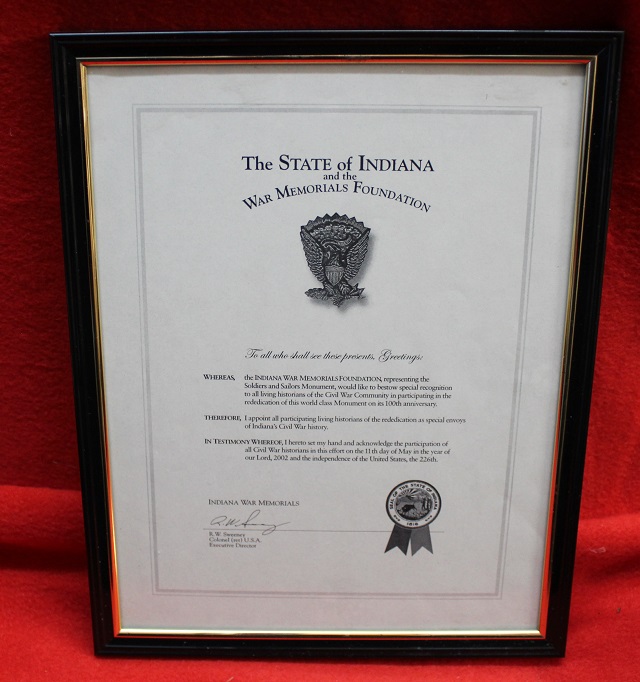
TC paper 25
Here we have a copy of an early photo that was engraved in 1860 before Abraham Lincoln went to Washington as President. The original photo was taken by Hesler of Chicago and the engraving was done by T. Johnson from the original negative owed by George B. Ayres of Philadelphia. The image is 9 X 6 1/2 and it's matted into a 11 X 14 inch frame. Nice! $15.00
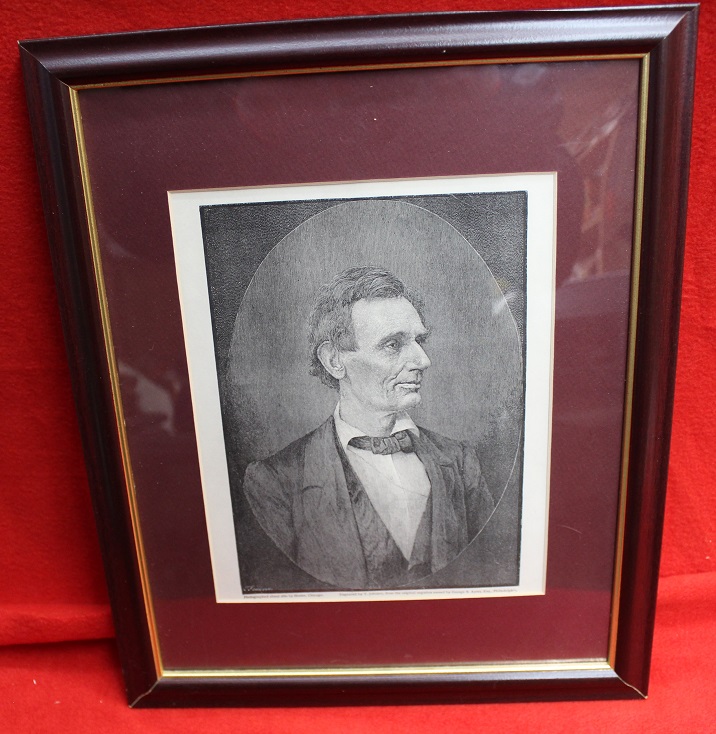
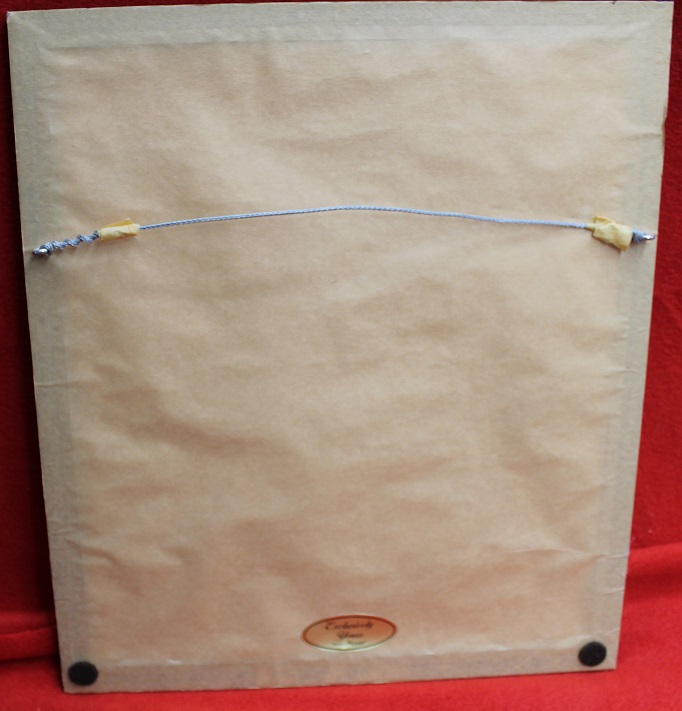
TC paper 24
Here we have an original document entitled Special Order 51 , 1862. Units are ordered to report without delay to Brig. Genl. N.J. Jackson Commd at Harts Island, NY harbor. Hart Island, sometimes referred to as Hart's Island, is located at the western end of Long Island Sound, in the northeastern Bronx in New York City. It's a small island and I have been told that bones still wash up there. The order was signed by the Major who was the commander of the 20th NY. This piece looks great in a double matted 13 X 15 overall sized frame, being professionally framed and ready to hang on the wall. Nice piece! $85.00
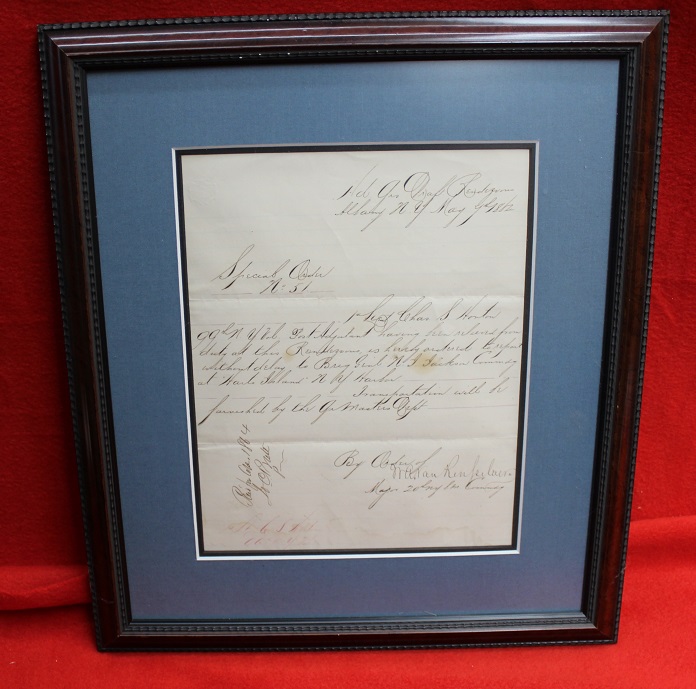
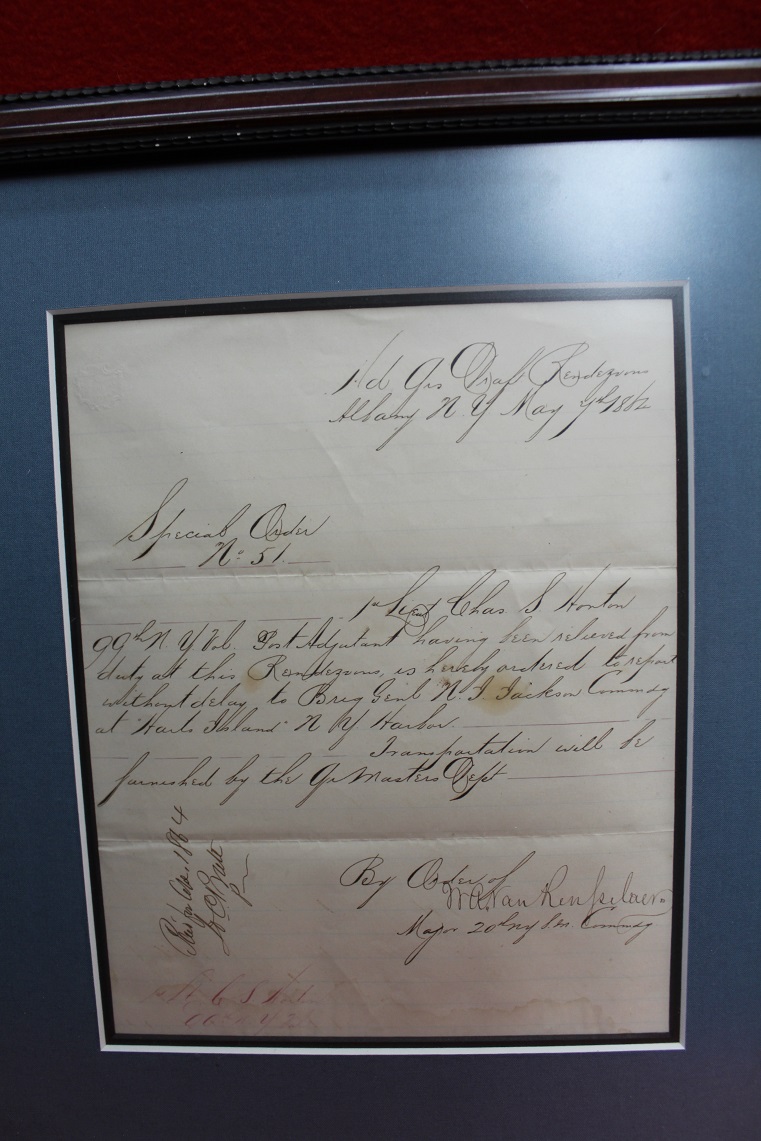
TC paper 23
Here we have an original Robert E. Lee Bookplate with facsimile signature below the image. This piece is matted and in a shadow box type tripple frame. The entire piece measures 14 5/8 X 12 3/4 inches. This piece looks just great! $45.00
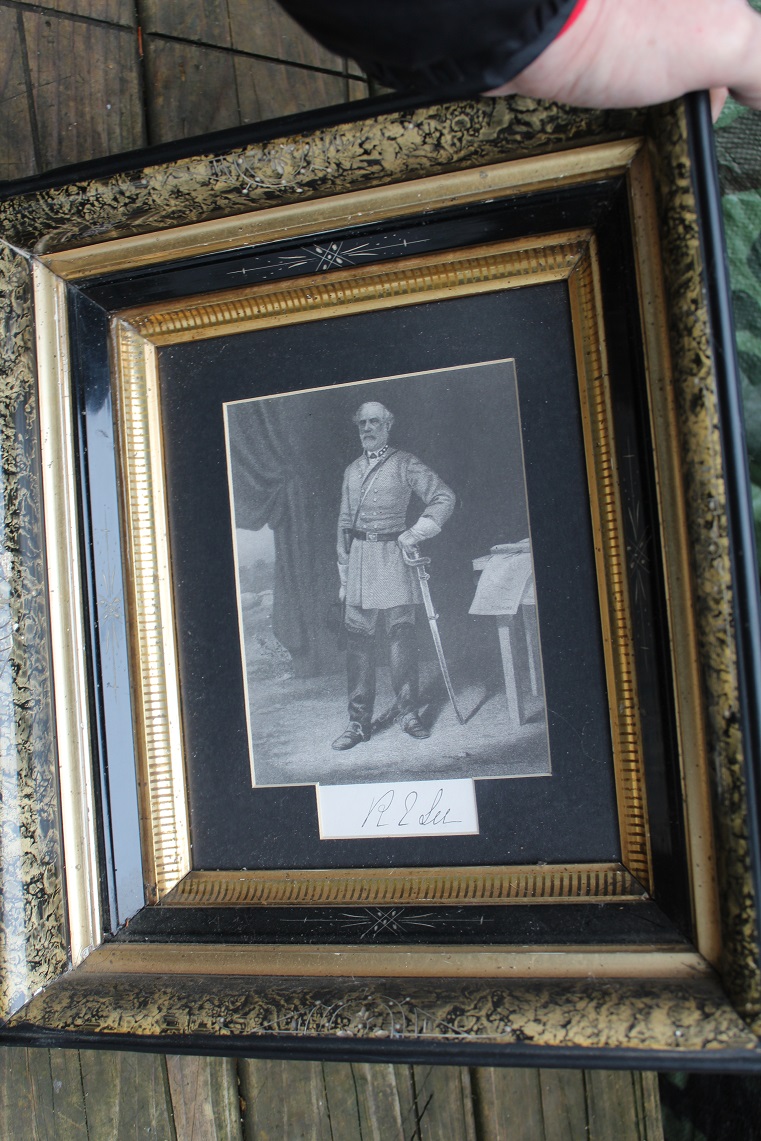
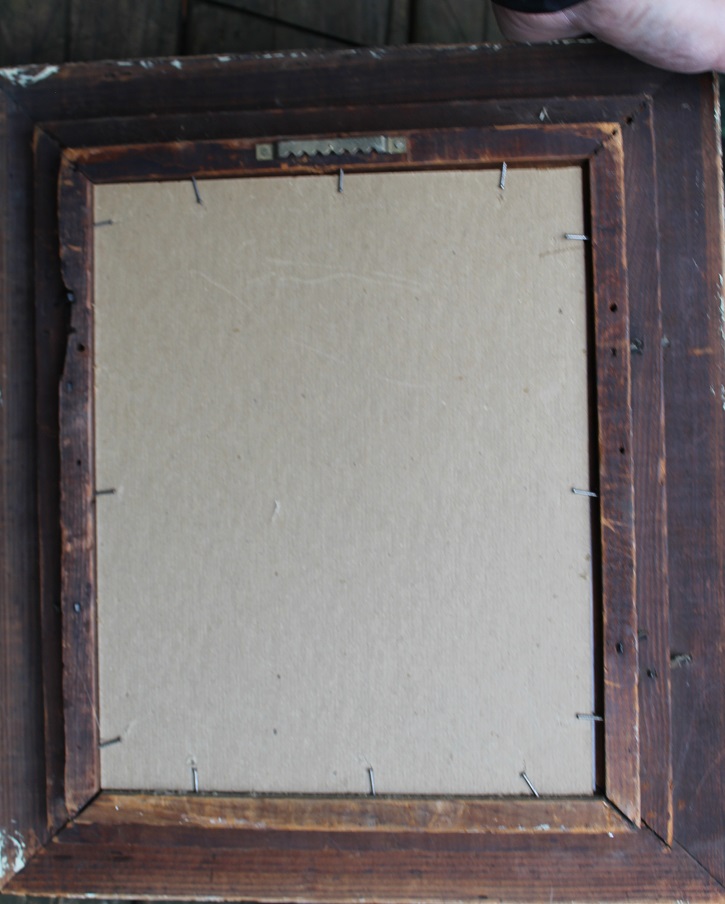
TC paper 22
Here we have an 8 X 10 inch format of a colorized President Lincoln image in oval. This image is taken from an original oil done by Peter Baumgras in the Spring of 1864. Very nice! In a gold frame which measures 13 X 15 inches overall. This image would look great on your wall !!! $45.00
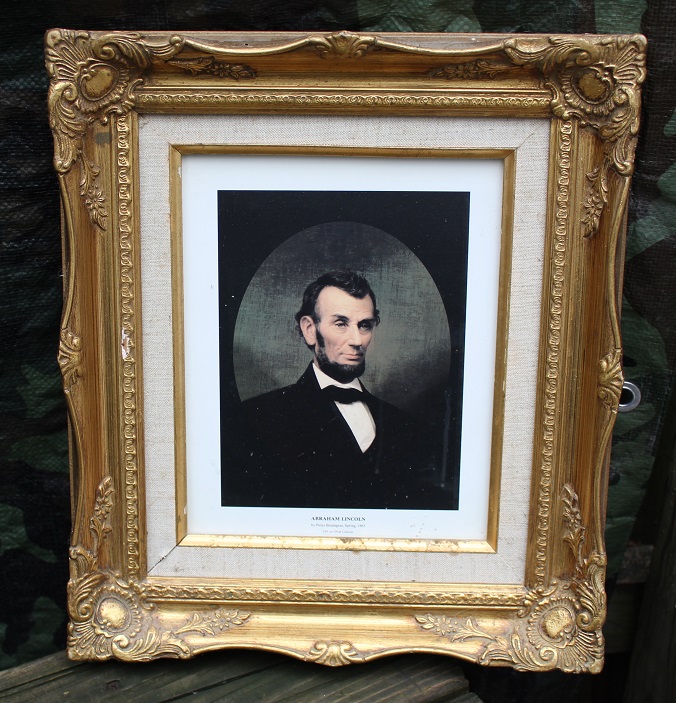
TC paper 21
Here we have an excellent print by Mort Kunstler made in 1995 and matted/framed with 3 collectors stamps. The overall size of the frame is 22 X 17 inches and was professionally frames. This piece is outstanding and the condition is outstanding as well! $125.00
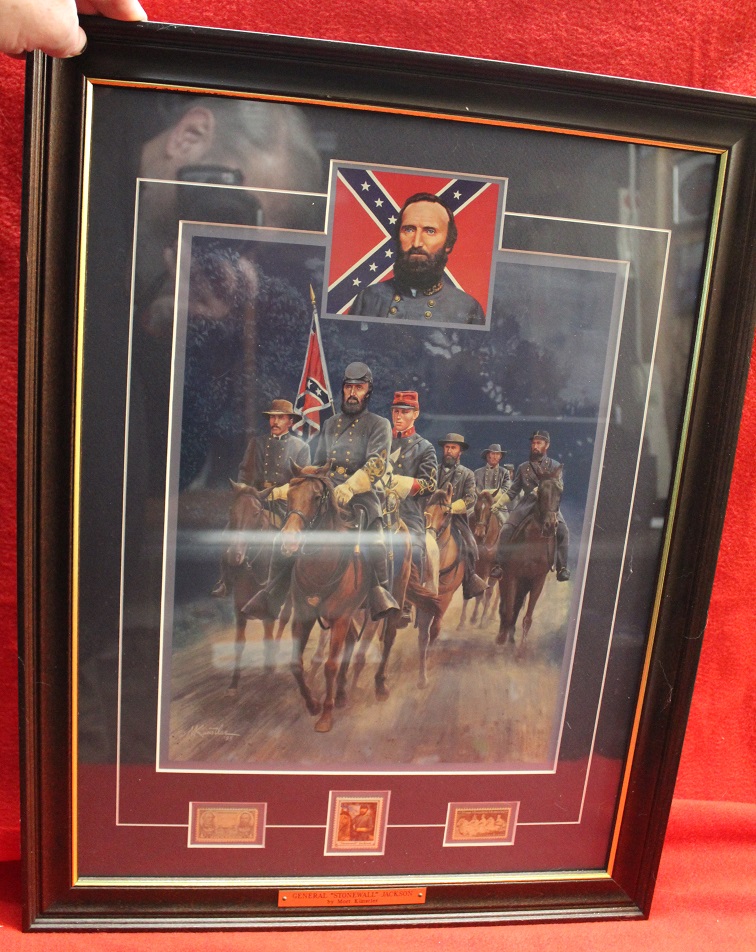
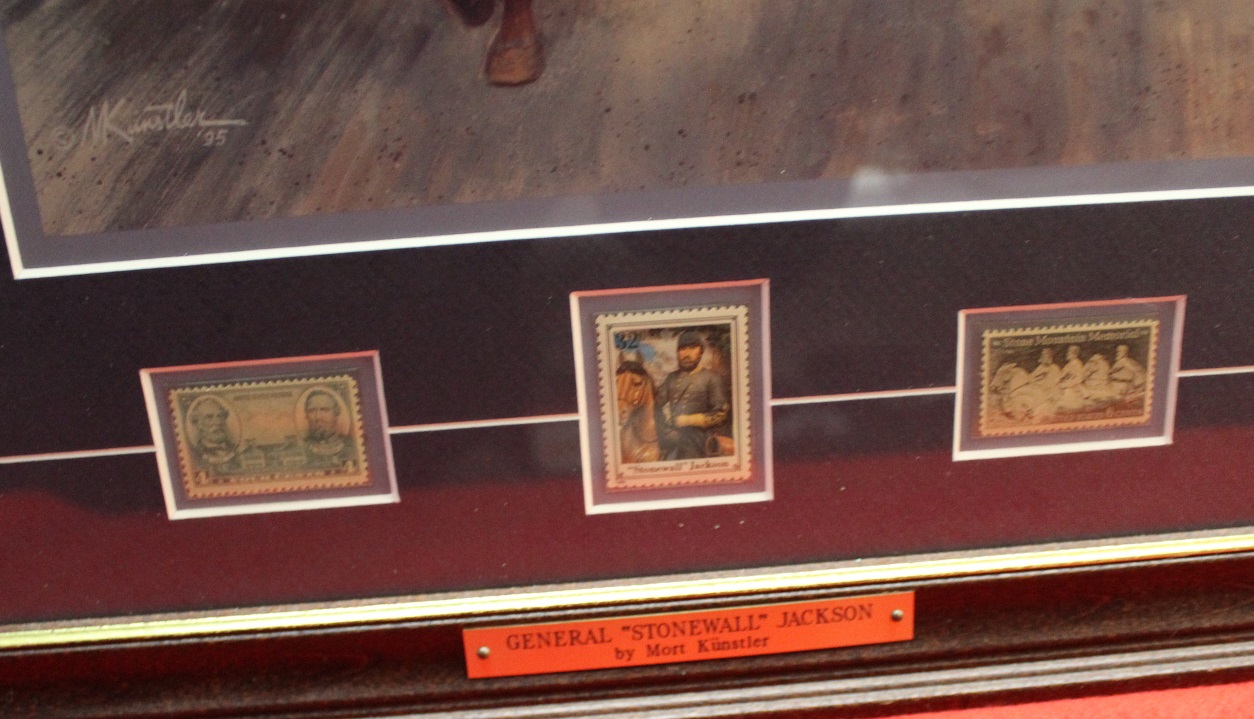
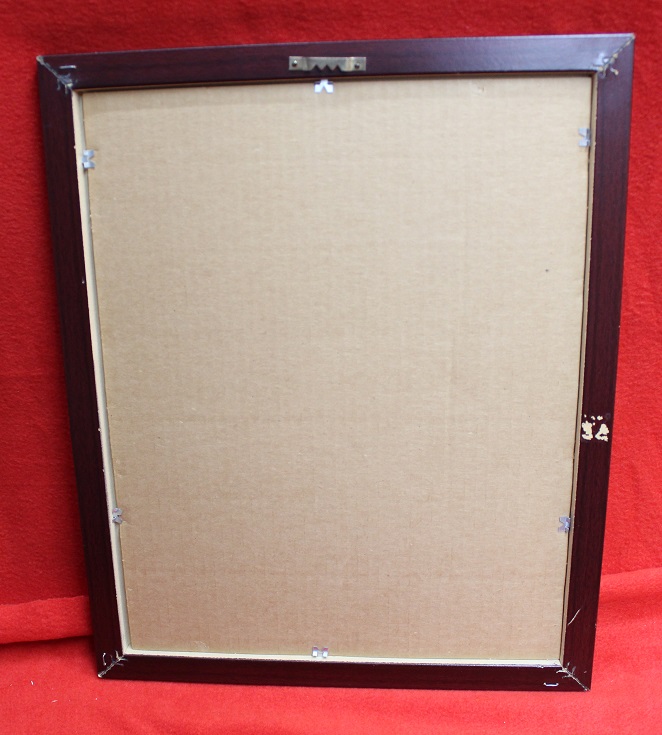
TC paper 20
Here we have a copy of the 2nd draft of the Gettysburg Address by President Abraham Lincoln matted and framed. The overall size of the frame is 24 1/2 X 19 1/2 inches and the document has been aged to look old. This piece was produced and professionally matted and framed by the Easton Press. Looks great! $95.00
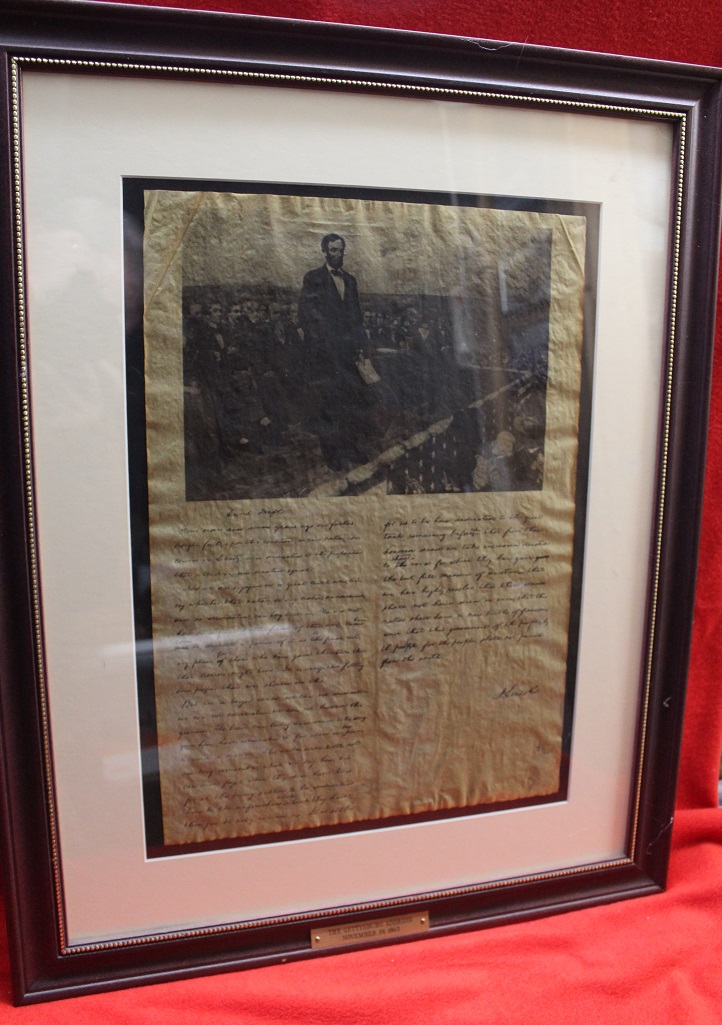
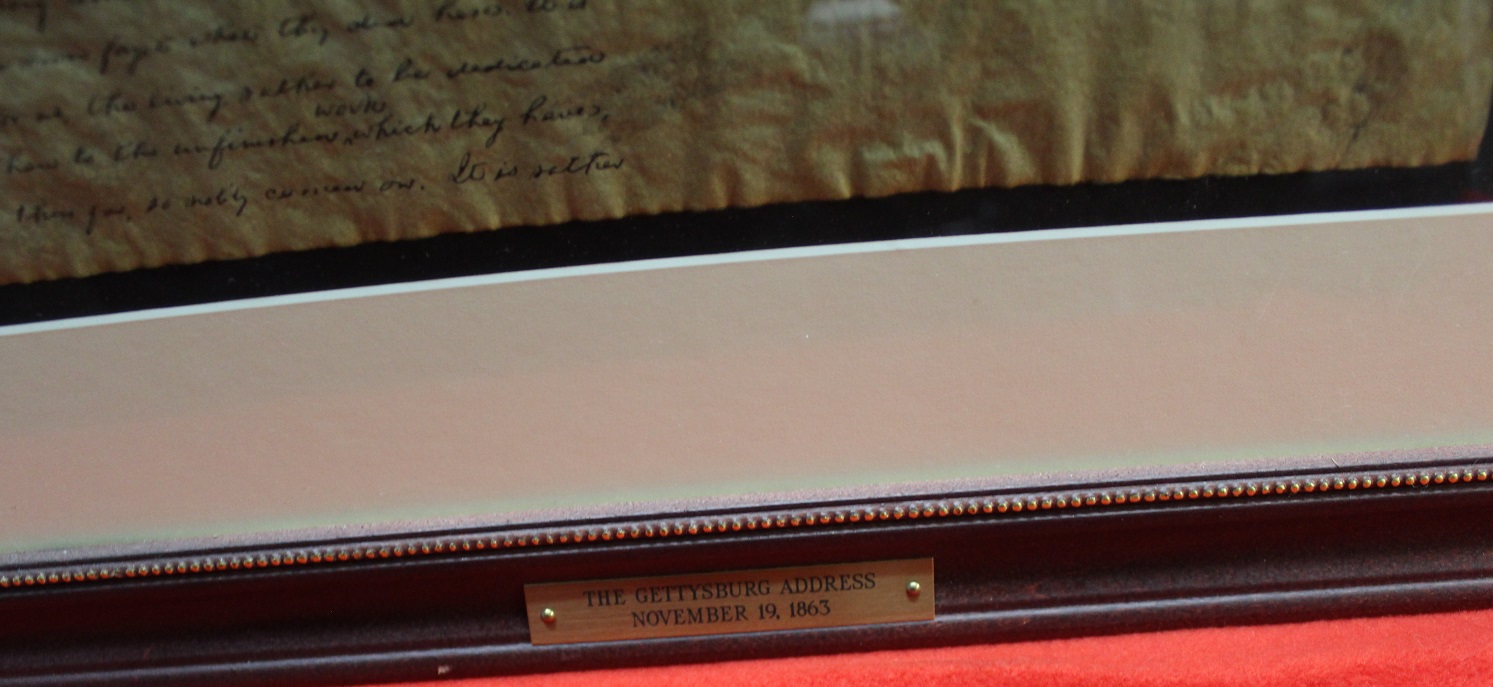
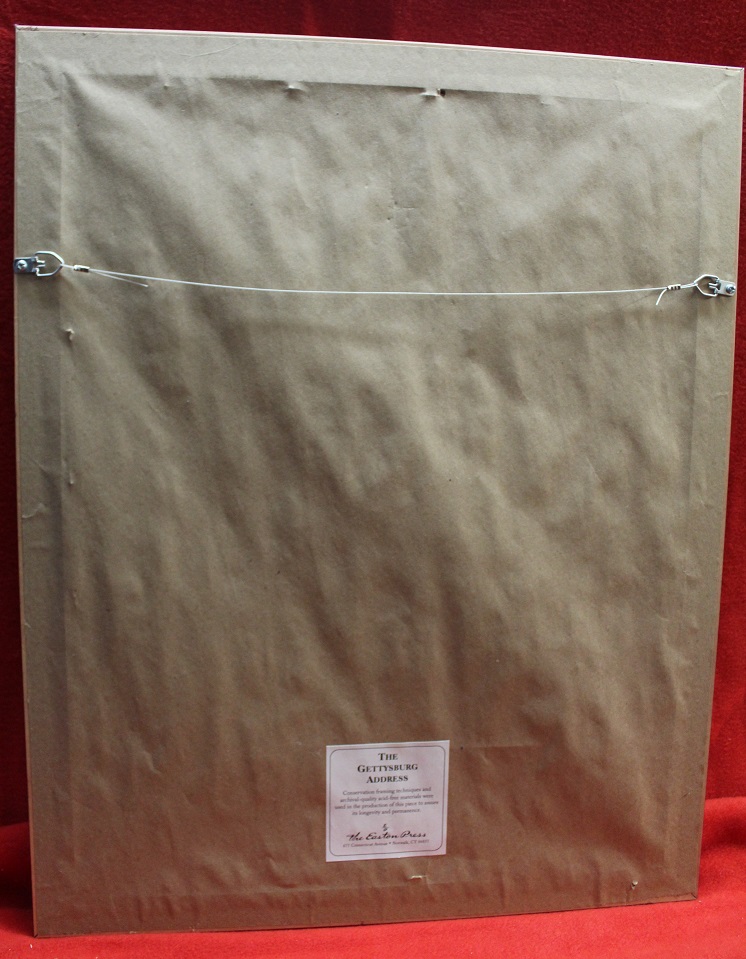
TC paper 19
Here we have a great Mort Kunstler print showing Jackson and Lee -Legends in Gray! Measures 22 1/2 X 22 1/2 and comes matted with a $5 CS note! This piece is excellent! $140.00
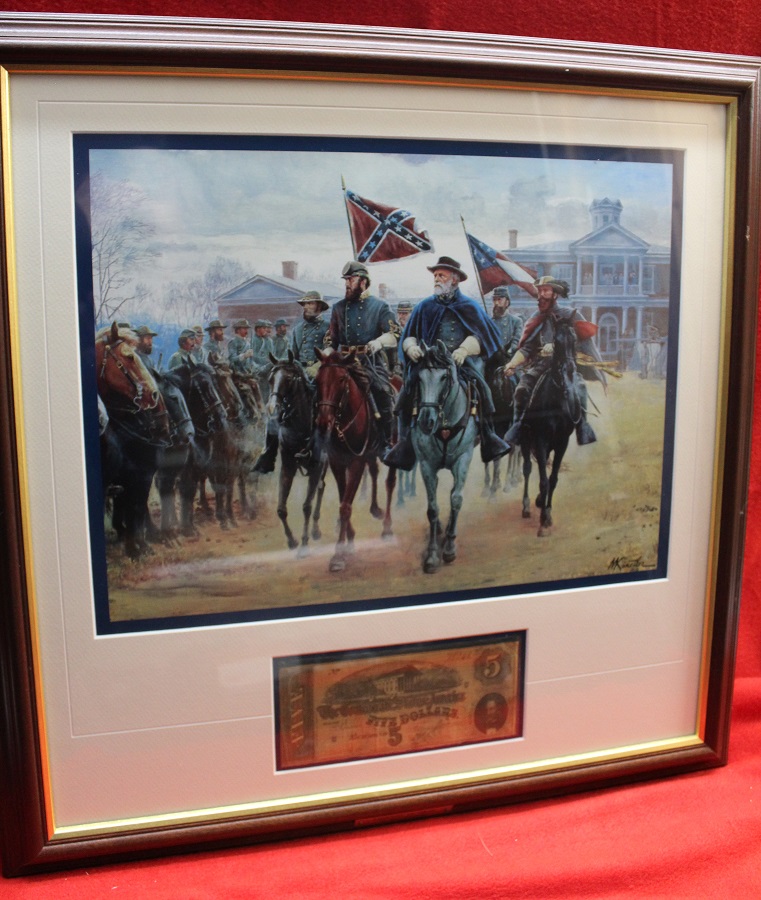
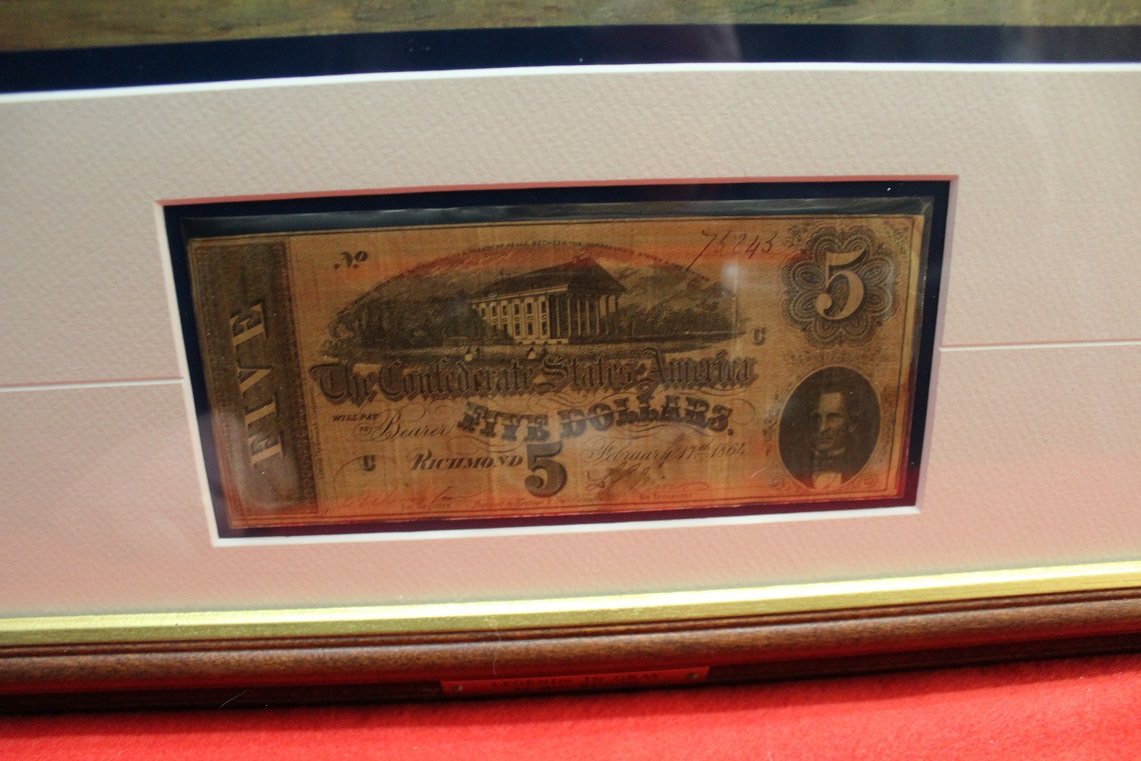
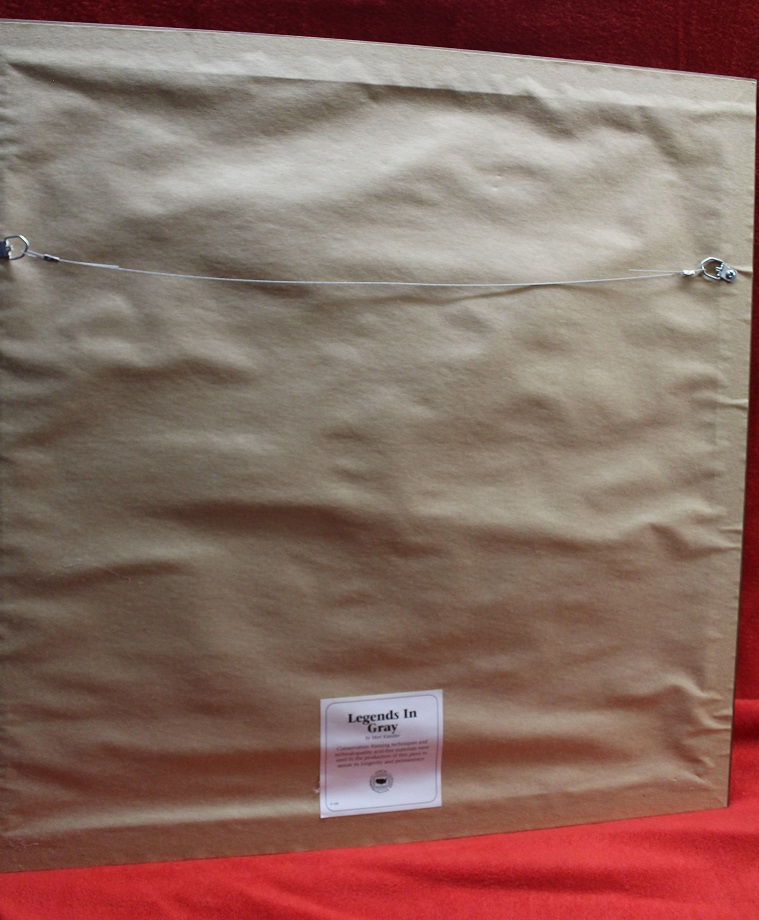
TC paper 18
Here we have a great Mort Kunstler print showing Legends in Gray - Jackson and Lee! Measures 22 1/2 X 22 1/2 and comes matted with a $20 CS note! This piece is excellent! $140.00
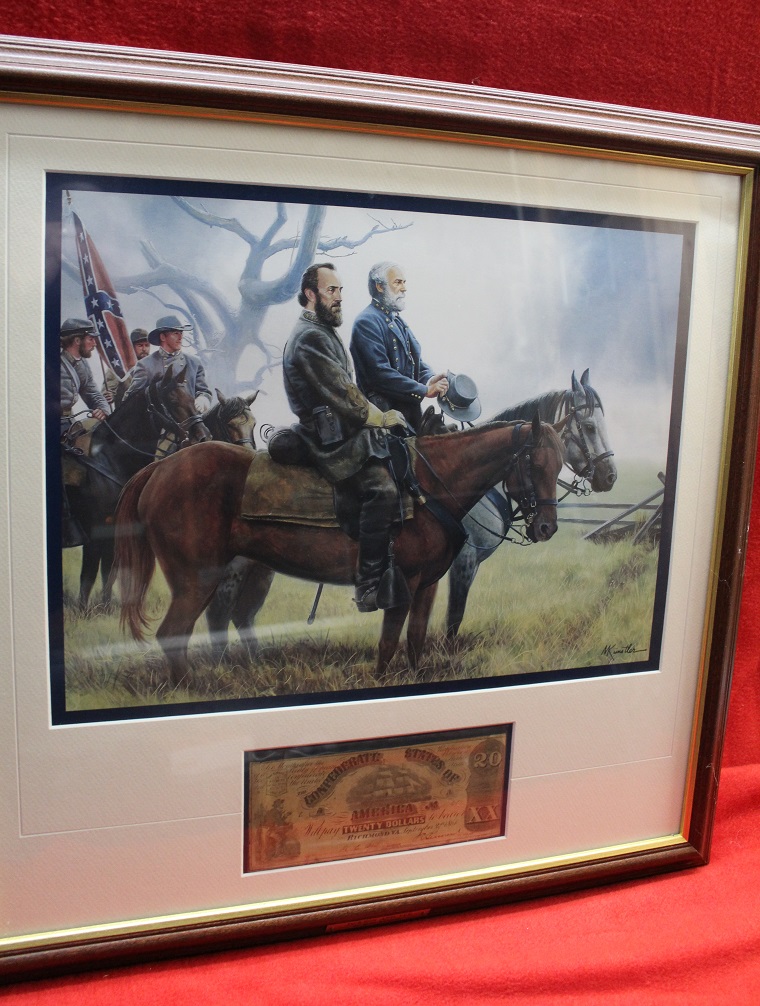
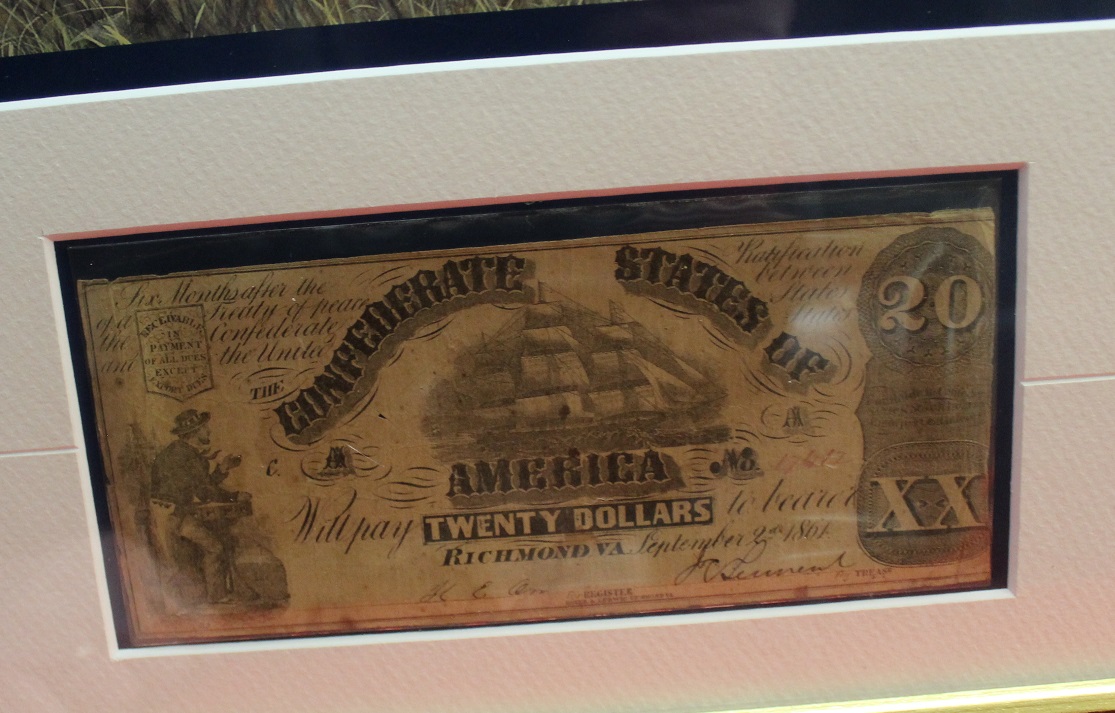
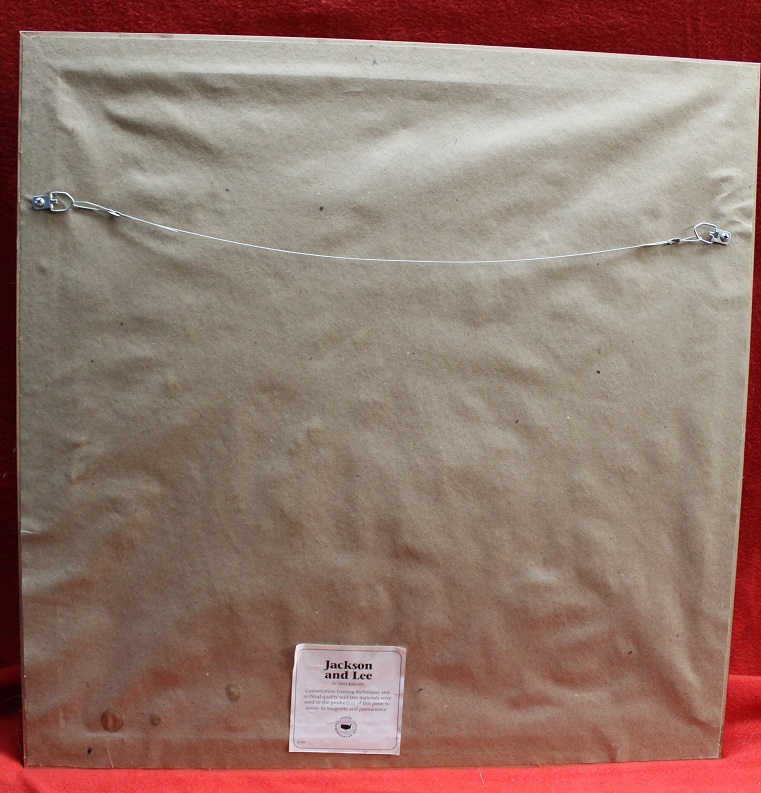
TC paper 17
Here we have a professionally matted and framed Robert E. Lee Map of Gettysburg July 2, 1863 along with an engraving of the battle and an actual 3 ring minie ball used during the Civil War! This piece is really nice and measures 24 X 18 inches overall. This one was put out by the Easton Press. Nice! $140.00
